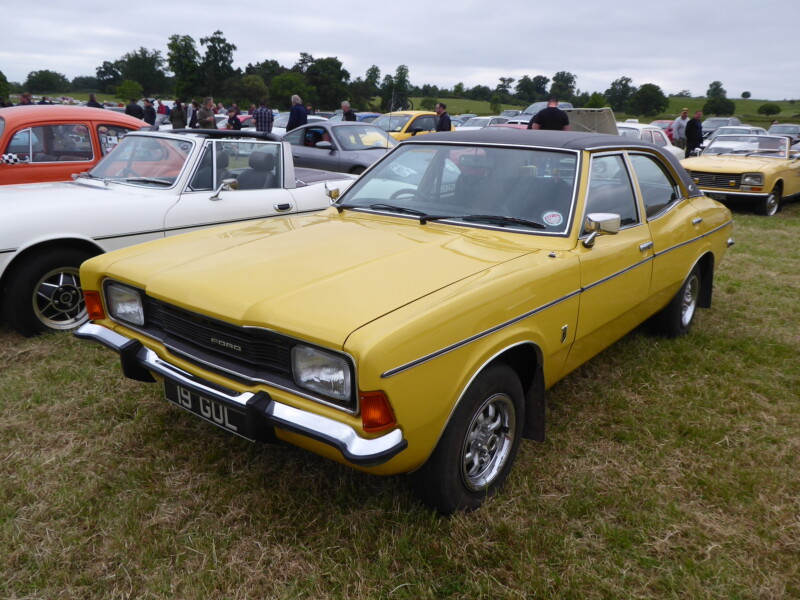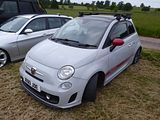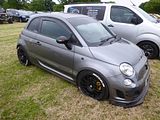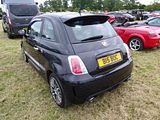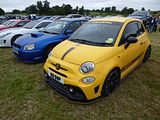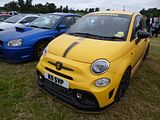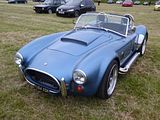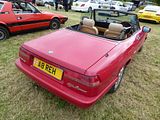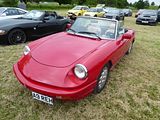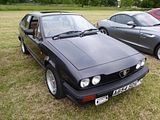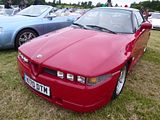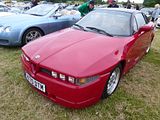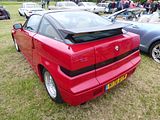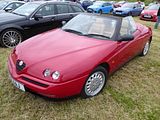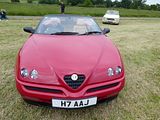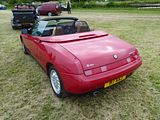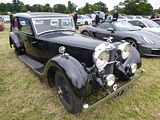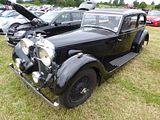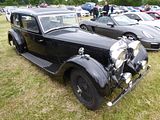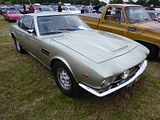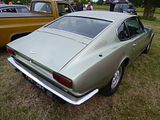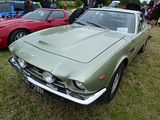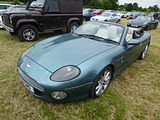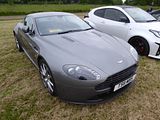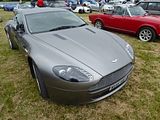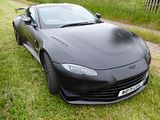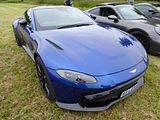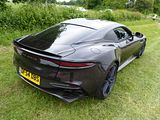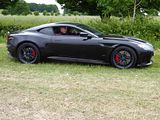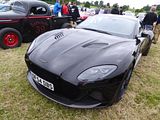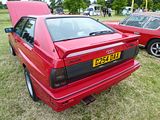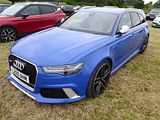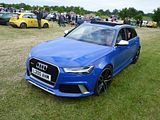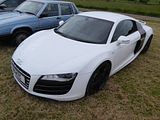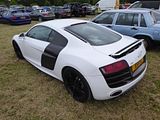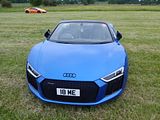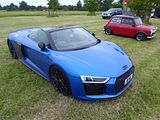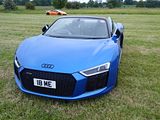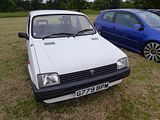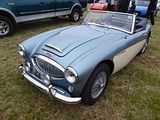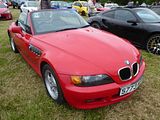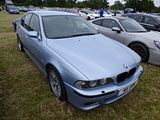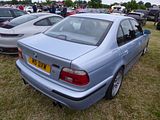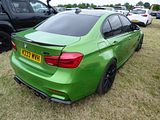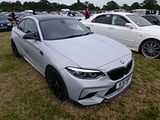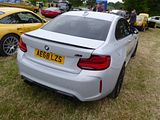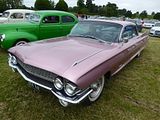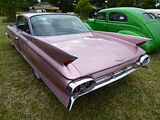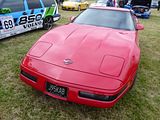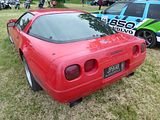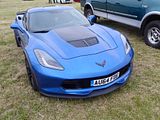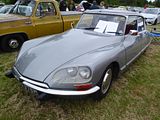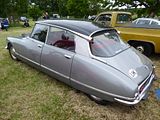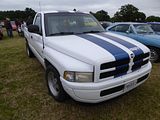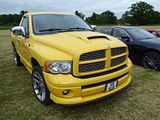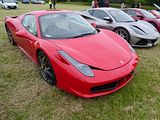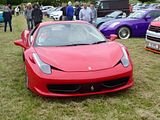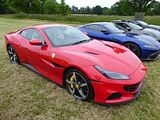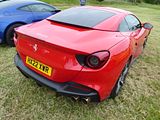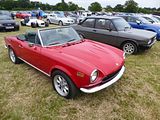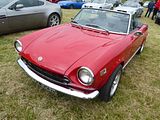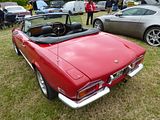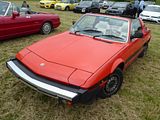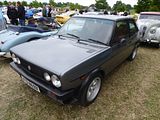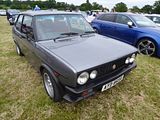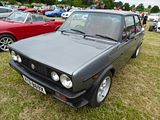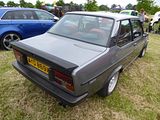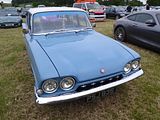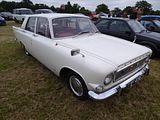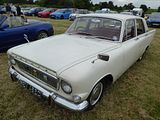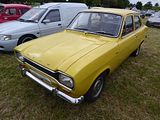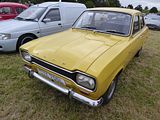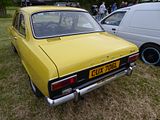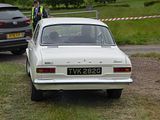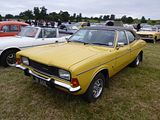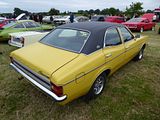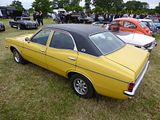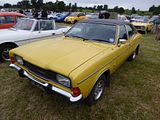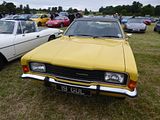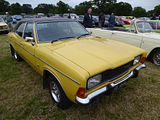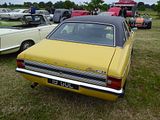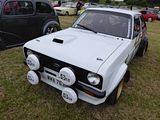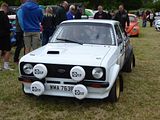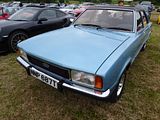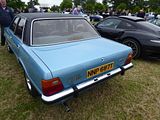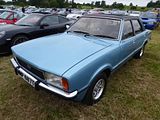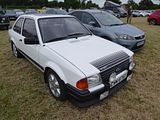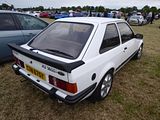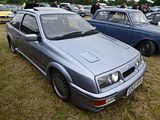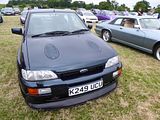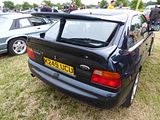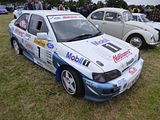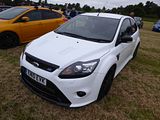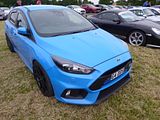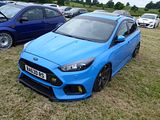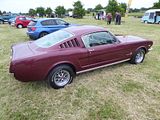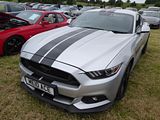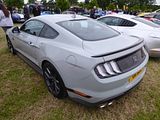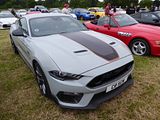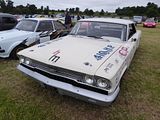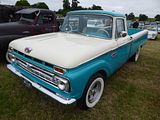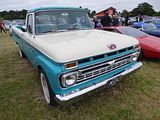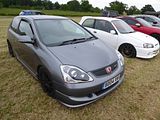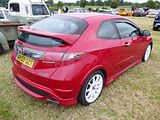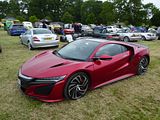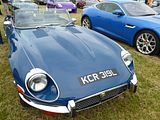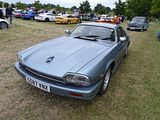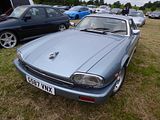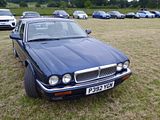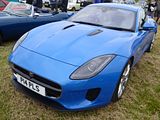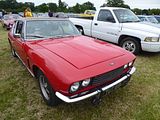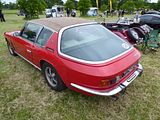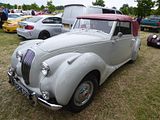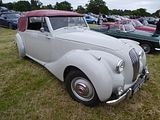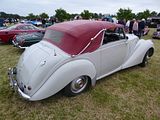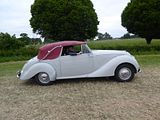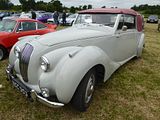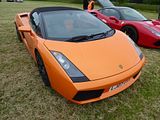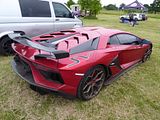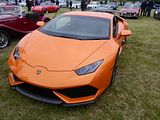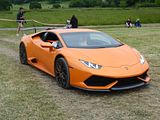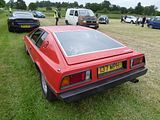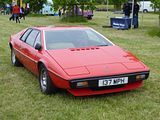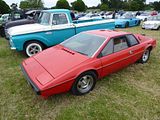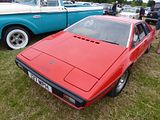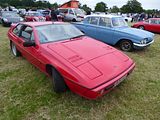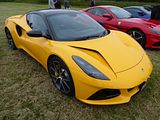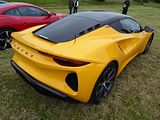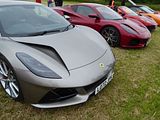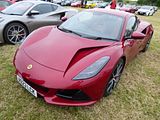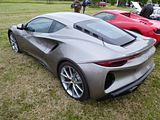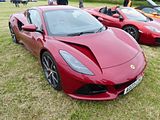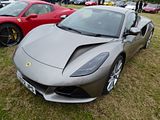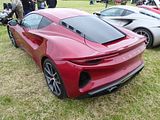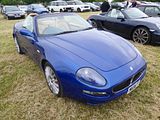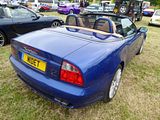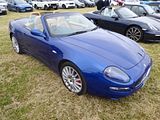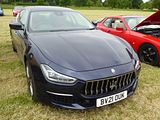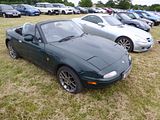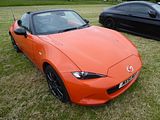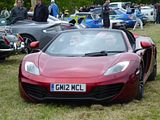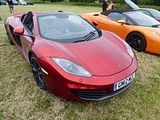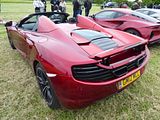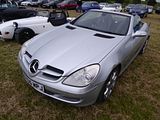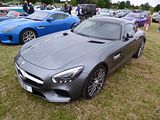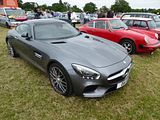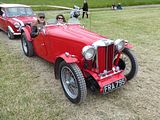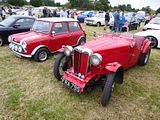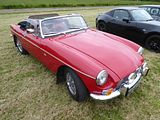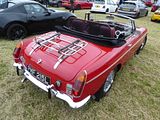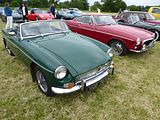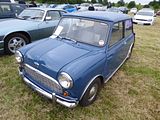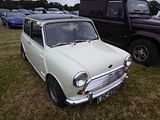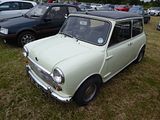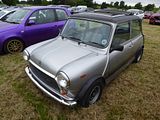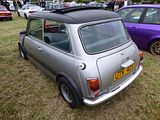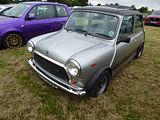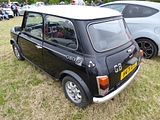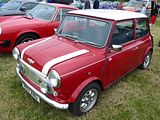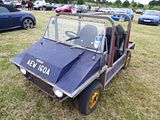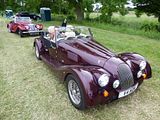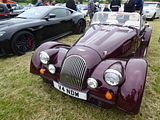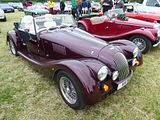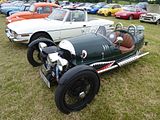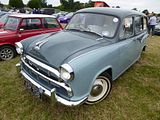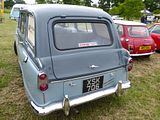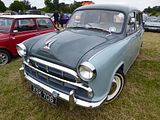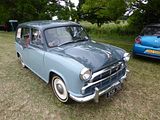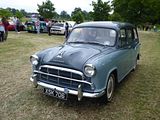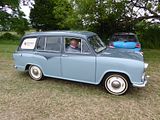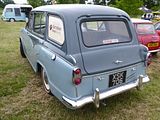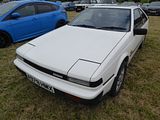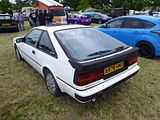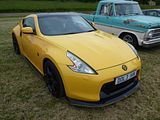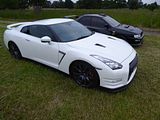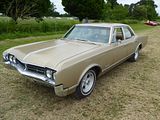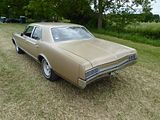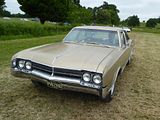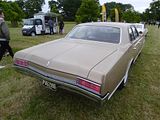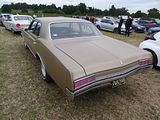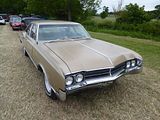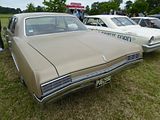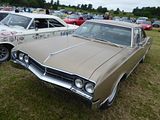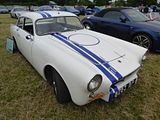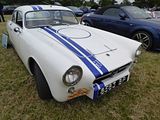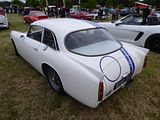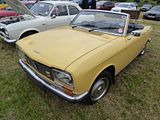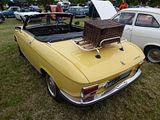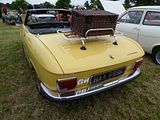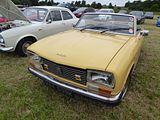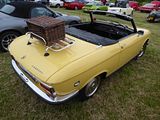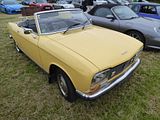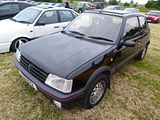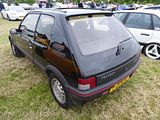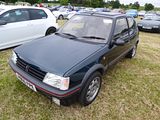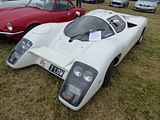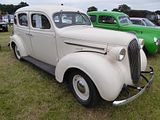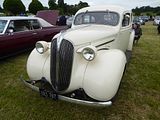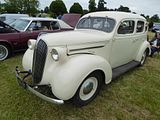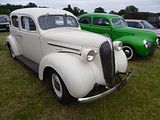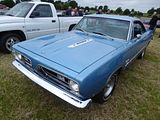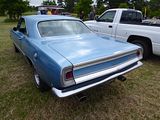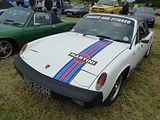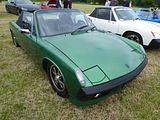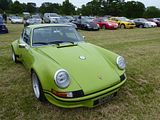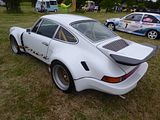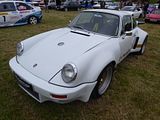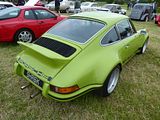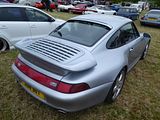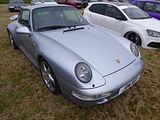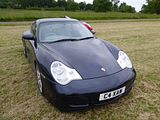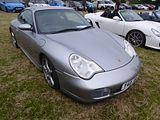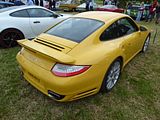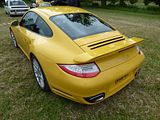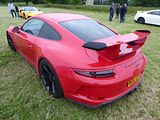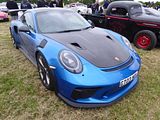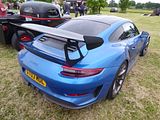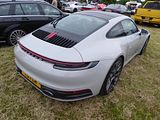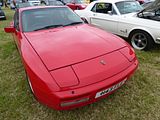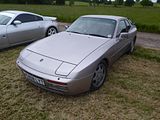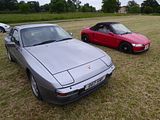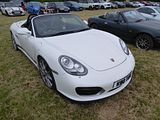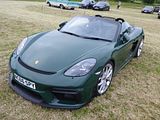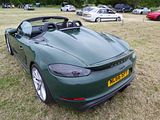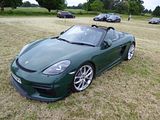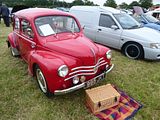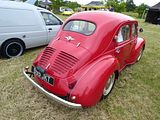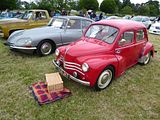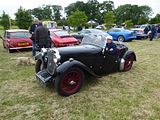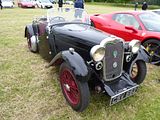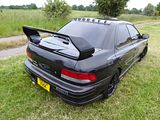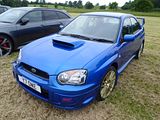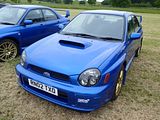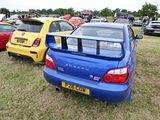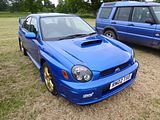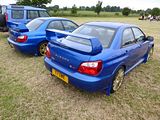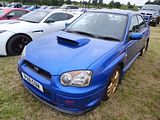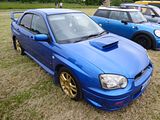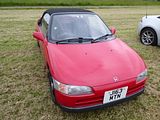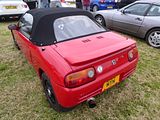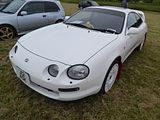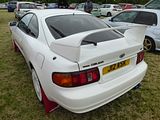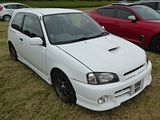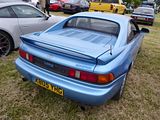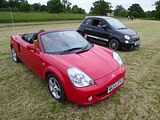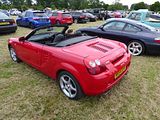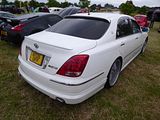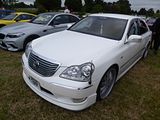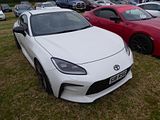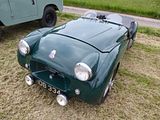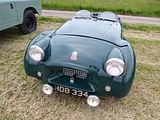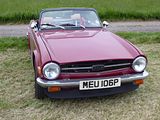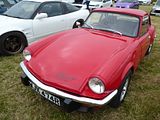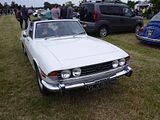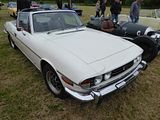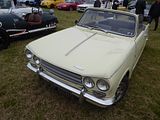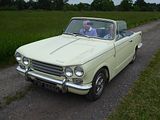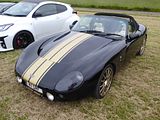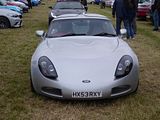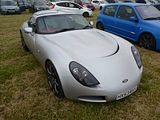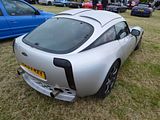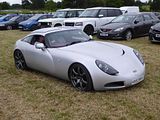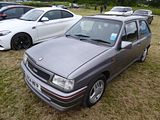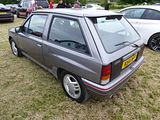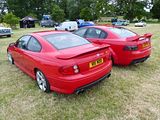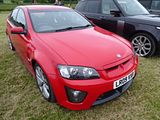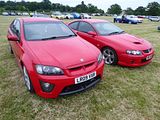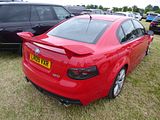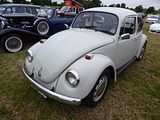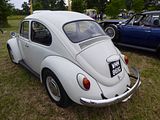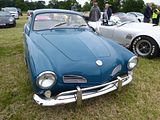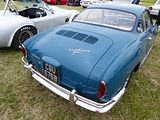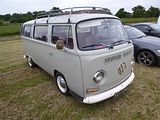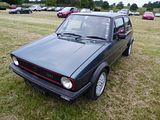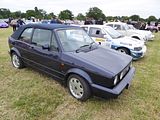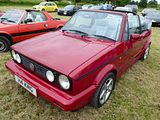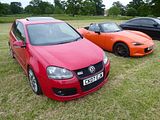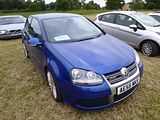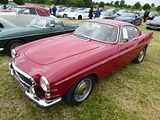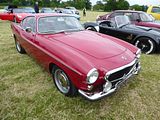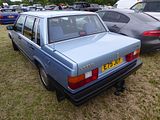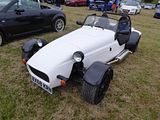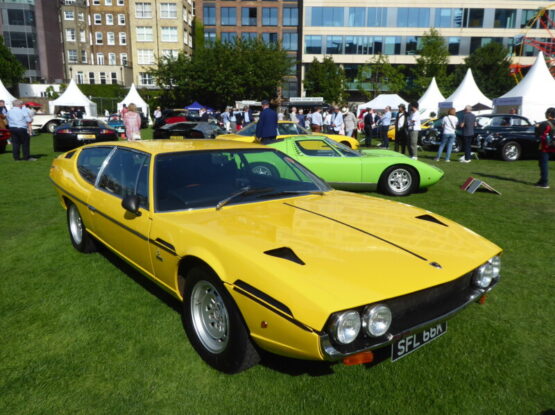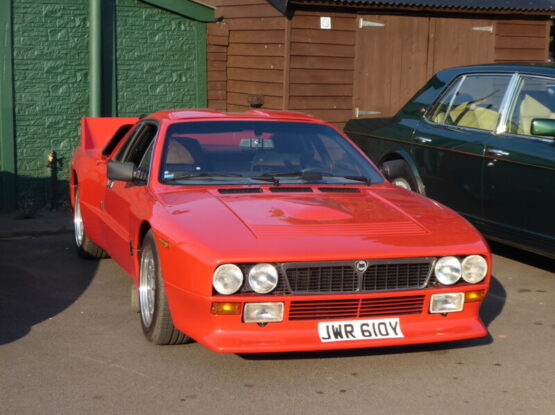Any event organiser in the UK will tell you that the British weather does from time to time do its absolute worst and the outcome is a last-minute cancellation. Over the course of a single season there are typically only two or three events that are so blighted, but I really do feel for Robin Webb who organises the popular Wheels on Wednesday event, as he has had to cancel three successive editions of this event, thanks to weather issues either on the day or ones that left the ground at Spetchley Park, just outside Worcester, where the event takes place, just too soggy and waterlogged to be able to ahead. So the event being covered here, which took place on 31st May 2023 is actually the first event he has managed to hold in the season. This time the weather gods were on side, and there was an absolutely incredible turn-out, probably the biggest there has ever been. It was as if everyone wanted to make up for those cancelled events, so they all came to this one. A couple of hours after I arrived, the queues to get in seemed as long as ever. Whilst this was great for the spectator, with so much to see, it did challenge the food vendors (who ran out!) and the marshalls who were kept bust for a lot longer than usual. There was a really varied mix of cars here, some of them even regulars but plenty were ones I’d not seen here before. I certainly did not manage to capture everything but presented here are 339 photos of cars that attracted my camera and which were not challenged with open bonnets and crowds around them. Enjoy!
ABARTH
All four of the Abarths that were here were the 500-based models which have been on sale now since the end of 2008, following a launch at the Paris Show that year. Since that time there have been a number of detailed changes to the standard cars and a lot of limited editions. Those who really know the marque can spot most of them, but some are so subtle that unless there is a badge you can see, you will not be quite sure which version you are looking at. It used to be relatively easy, when the model was first launched, as there was only one version as shipped ex works called the 500. It had a 135 bhp 1.4 litre turbo-charged engine coupled to a five speed manual gearbox, with 16″ alloys as standard, and the option of 17″ wheels, and a colour palette comprising of two whites (BossaNova White, the standard colour, or the pearlescent Funk White), Red (Pasadoble), Pale Grey (Campovolo) or Black. If you wanted more power – 160 bhp – then you could order an Esseesse kit, which came in a large wooden crate, containing new wheels, springs, an ECU upgrade, the Monza exhaust system and badging. It was dealer fitted and could be applied at any time within the first 12 months or 10,000 miles from registration. Needless to say, it proved popular. As were many of the optional extras, with stickers for the sides, a large scorpion for the bonnet and even a chequered pattern for the roof among the personalisation options offered.
Having used the legendary 695 badging from the 1960s on the Tributo cars, at the 2012 Geneva Show, Abarth dusted off the 595 name that had been used on the less powerful of the Nuova 500 based cars of the same generation, and created two new versions which we should think of as Series 2 cars, the 595 Turismo and Competizione, both of which could be bought in either closed or open top C guise, with either the 5 speed manual or robotised automated gearshifts. Both models had the 160 bhp engine as standard. Effectively they were a replacement for the Esseesse kit, and it meant that the cars were produced complete at the factory, rather than needing the dealer to undertake the upgrade (and the associated paperwork), though Abarth did not withdraw the Esseesse kits from the market for some while. Turismo, as the name suggests was aimed slightly less extreme in intent, featuring standard leather upholstery, upgraded dampers and climate control, Xenon headlights and Alutex interior details. The sportier Abarth 595 Competizione replaced the leather seats with Sabelt cloth sport seats and Alutex with aluminium, while adding p-cross-drilled brakes and the Record Monza dual-mode exhaust.
The Series 4 version of the familiar 595 first reached the markets in the middle of 2016. After rumours had circulated all winter following the launch of the facelifted Fiat 500 in 2015, Abarth finally unveiled the Series 4 at the end of May 2016. Initially, we were told that the cars would not be available in the UK until September, but that came forward somewhat, with dealers all receiving demo cars in June, and the first customers taking delivery in July. Three regular production versions of both the closed car and the open-topped C were initially available, all badged 595, and called Custom, Turismo and Competizione, as before, though numerous limited edition models have since appeared and in most case disappeared. The most significant changes with the Series 4 are visual, with a couple of new colours, including the much asked for Modena Yellow and a different red, called Abarth Red, which replaces both the non-metallic Officina and – slightly surprisingly – the tri-coat pearlescent Cordolo Red. as well as styling changes front and rear. The jury is still out on these, with many, me included, remaining to be convinced. At the front, the new air intake does apparently allow around 15 – 20 % more air in and out, which will be welcome, as these cars do generate quite a lot of heat under the bonnet. Competizione models for the UK retain the old style headlights, as they have Xenon lights as standard, whereas the Custom and Turismo cars have reshaped units. At the back, there are new light clusters and a new rear bumper and diffuser. Inside, the most notable change is the replacement of the Blue & Me system with a more modern uConnect Audio set up, which brings a new colour screen to the dash. Mechanically, there is an additional 5 bhp on the Custom (now 145) and Turismo (now 165 bhp) and the option of a Limited Slip Diff for the Competizione, which is likely to prove a popular option. Details of the interior trim have changed, with a filled-in glovebox like the US market cars have always had, and electric windows switches that are like the US ones, as well as a part Alcantara trim to the steering wheel in Competizione cars.
AC
Original Cobra cars are few and far between, but there have been countless replica and recreation as well as continuation cars and this is one of those. It is a Dax Tojeiro. Dax is one of the most recognised producers of replica Cobras. The company, based in North Weald, Essex, began building fibreglass mouldings for cars in 1968. In 1975 the AC Ace’s designer, John Tojeiro, became a director of the company and that’s when the Cobra replica became known as the Dax Tojeiro. Dax is still going, under the current stewardship of John Kox, who took control in 2017. The Tojeiro is still part of its catalogue, albeit it’s now called the Dax 427. The cars are built on a steel ladder frame chassis, and these days with bonded and riveted front and rear sections to add stiffness. The basic setup of the front and rear axles, suspension and brakes is based around donor items from the Jaguar XJ40, but with bespoke geometry, Spax adjustable coil overs, front anti-roll bar and steering rack.
ALFA ROMEO
The S4, the final major change to the long running Spider came in 1990, and mechanically, the biggest different was the use of Bosch Motronic electronic fuel injection with an electric fan. Externally, the Spider lost its front under-bumper spoiler and the rather ungainly rear boot spoiler of the S3, and picked up 164-style rear lights stretching across the width of the car as well as plastic bumpers the same colour as the car. This also marked the first generation of the car with automatic transmission, as well as on-board diagnostics capabilities. The car had remained in production largely thanks to continued demand in North America, though this market had to wait until 1991 for the changes to appear on their cars. European markets were offered a car with a 1600cc engine and carburettors as well as the 2 litre injected unit. Production finally ended in 1993, with an all new model, the 916 Series Spider appearing a year later. The S4 car was not officially sold in the UK, but plenty have found their way to our shores since then.
As was still the practice in the 1970s, Alfa followed up the launch of the Alfetta Berlina with a very pretty coupe. Styled by Giugiaro, this car, initially called the GT, and premiered in the autumn of 1974, looked completely unlike the saloon on which it was based. The first cars had 1.8 litre four cylinder engines and there was one of those on show. In 1976 the range was expanded both up and down with a 1.6 and a 2.0 model, the latter adopting the legendary GTV name. A rare SE model from this period was part of the display, complete with period vinyl roof (look closely), and although the pain does appear a bit like a lot of older Alfa reds, having gone rather pink, this was the actual shade when the car was new. In 1981, with the 2.5 litre V6 engine that had been developed for the ill-fated Alfa 6 luxury saloon available, Alfa was able to create a true rival for the 2.8 litre Capri with the GTV6. A facelift modernised the look of the car with plastic bumpers front and rear and a new interior looked rather better as well as being more ergonomically logical. There was a good mix of the earlier chrome bumpered and later plastic bumpered models, the last with 2.0 and 2.5 GTV6 versions both represented. There was also a car sporting 3.0 badging and right hand drive. This is a South African car. From 1974 South African Alfetta’s were manufactured at Alfa Romeo’s own Brits plant. South Africa was one of two markets to have a turbocharged GTV6, with a Garrett turbocharger and a NACA intake. An estimated 750 were assembled before all production ceased in 1986. The South African range included a 3.0 litre GTV-6, predating the international debut of the factory’s 3.0 litre engine in 1987 (for the Alfa 75). and 212 of these were built in South Africa for racing homologation. The last 6 GTV-6 3.0’s were fuel injected. To this day, the GTV-6 remains the quintessential Alfa Romeo for South Africans.
It was more than 10 years after the Montreal had ceased production before Alfa offered another high-end and costly Coupe model, and the result, seen for the first time in 1989, could hardly have been more different than its forebear. That car had been praised for its looks, whereas this one, the SZ, and cruelly nicknamed “Il Mostro”, was almost wilfully, well, “different”. First seen at the 1989 Geneva Show, the car was also first shown simply as a concept, called the ES-30, for Experimental Sports car 3 litre. It was produced by Zagato. Robert Opron of the Fiat design studio was responsible for the initial sketches while Antonio Castellana was largely responsible for the final styling details and interior. Only the ‘Z’ logo of Zagato was kept. The car possessed unusual headlights positioned in a trio on each side – a styling used more subtly on later Alfa Romeos in the 2000s. Mechanically and engine-wise, the car was based on the Alfa 75, production being carried out by Zagato at Terrazzano di Rho near the Alfa factory in Arese. The thermoplastic injection moulded composite body panels were produced by Italian company Carplast and French company Stratime Cappelo Systems. The suspension was taken from the Alfa 75 Group A/IMSA car, and modified by Giorgio Pianta, engineer and team manager of the Lancia and Fiat rally works team. A hydraulic damper system was made by Koni. The SZ was originally equipped with Pirelli P Zero tyres (front 205/55 ZR 16, rear 225/50 ZR 16) and is able to sustain over 1.1 G in cornering, some drivers have measured a cornering force of 1.4 G, which remains an excellent performance figure. Low volume production got underway late in 1989, and over the next three years, 1036 were built, slightly more than planned. With the exception of a black car made for Zagato, all of them were red. Subsequently a convertible version, the RZ (for Roadster Zagato), was produced from 1992 until December 1994. Although almost identical to look at the two cars had completely different body panels save for the front wings and boot. The RZ had a revised bumper and door sills to give better ground clearance and the bonnet no longer featured the aggressive ridges. Three colours were available as standard: black, yellow and red, with black and yellow being the more popular choices. Yellow and red cars got a black leather interior and black cars burgundy. Although the interior layout was almost unchanged from the SZ, the RZ had a painted central console that swept up between the seats to conceal the convertible roof storage area. 350 units were planned but production was halted after 252 units when the Zagato factory producing the cars for Alfa Romeo went in to receivership, a further 32 cars were then completed under the control of the receivers before production finished at 284 units. Of those final three were painted silver with burgundy interior and another pearlescent white.
The 916 Series GTV and Spider were conceived to replace two very different models in the Alfa range. First of these was the open topped 105 Series Spider which had been in production since 1966 and by the 1990s was long overdue a replacement. Alfa decided to combine a follow on to the Alfetta GTV, long out of production, with a new Spider model, and first work started in the late 1980s. The task was handed to Pininfarina, and Enrico Fumia’s initial renderings were produced in September 1987, with the first clay models to complete 1:1 scale model made in July 1988. Fumia produced something rather special. Clearly an Italian design, with the Alfa Romeo grille with dual round headlights, recalling the Audi-based Pininfarina Quartz, another design produced by Enrico Fumia back in 1981, the proposal was for a car that was low-slung, wedge-shaped with a low nose and high kicked up tail. The back of the car is “cut-off” with a “Kamm tail” giving improved aerodynamics. The Spider would share these traits with the GTV except that the rear is rounded, and would feature a folding soft-top with five hoop frame, which would completely disappear from sight under a flush fitting cover. An electric folding mechanism would be fitted as an option. Details included a one-piece rear lamp/foglamp/indicator strip across the rear of the body, the minor instruments in the centre console angled towards the driver. The exterior design was finished in July 1988. After Vittorio Ghidella, Fiat’s CEO, accepted the design, Alfa Romeo Centro Stile under Walter de Silva was made responsible for the completion of the detail work and also for the design of the interiors, as Pininfarina’s proposal was not accepted. The Spider and GTV were to be based on the then-current Fiat Group platform, called Tipo Due, in this case a heavily modified version with an all new multilink rear suspension. The front suspension and drivetrain was based on the 1992 Alfa Romeo 155 saloon. Chief engineer at that time was Bruno Cena. Drag coefficient was 0.33 for the GTV and 0.38 for the Spider. Production began in late 1993 with four cars, all 3.0 V6 Spiders, assembled at the Alfa Romeo Arese Plant in Milan. In early 1994 the first GTV was produced, with 2.0 Twin Spark engine. The first premiere was then held at the Paris Motor Show in 1994. The GTV and Spider were officially launched at the Geneva Motor Show in March 1995 and sales began the same year. The cars were well received. At launch, many journalists commented that Alfa had improved overall build quality considerably and that it came very close to equalling its German rivals. I can vouch for that, as I owned an early GTV for eighteen months, and it was a well built and reliable car. In 1997 a new engine, a 24-valve 3.0 litre V6, was available for the GTV along with bigger, 12.0 inch brakes and red four-pot calipers from Brembo. The console knobs were changed from round central to rectangle ones and to a three-spoke steering wheel. Some versions were upgraded with different front bumper mesh to bring the wind noise down to 74 dBA. In May 1998 the cars were revamped for the first time, creating the Phase 2 models. Most of the alterations were inside. The interior was changed with new centre console, painted letters on skirt seals, changed controls and switches arrangement and different instrument cluster. Outside, the main changes included chrome frame around the grille and colour-coded side skirts and bumpers. A new engine was introduced, the 142 hp 1.8 Twin Spark, and others were changed: the 2.0 Twin Spark was updated with a modular intake manifold with different length intakes and a different plastic cover. Power output of the 2.0 TS was raised to 153 hp. Engines changed engine management units and have a nomenclature of CF2. The dashboard was available in two new colours in addition to the standard black: Red Style and Blue Style, and with it new colour-coded upholstery and carpets. The 3.0 24V got a six-speed manual gearbox as standard and the 2.0 V6 TB engine was now also available for the Spider. August 2000 saw the revamp of engines to comply with new emission regulations, Euro3. The new engines were slightly detuned, and have a new identification code: CF3. 3.0 V6 12V was discontinued for the Spider and replaced with 24V Euro3 version from the GTV. 2.0 V6 Turbo and 1.8 T.Spark were discontinued as they did not comply with Euro3 emissions. By the 2001-2002 model year, only 2 engines were left, the 2.0 Twin.Spark and 3.0 V6 24V, until the Phase 3 engine range arrived. The Arese plant, where the cars had been built, was closing and, in October 2000, the production of GTV/Spider was transferred to Pininfarina Plant in San Giorgio Canavese in Turin. In 2003 there was another and final revamp, creating the Phase 3, also designed in Pininfarina but not by Enrico Fumia. The main changes were focused on the front with new 147-style grille and different front bumpers with offset numberplate holder. Change to the interior was minimal with different centre console and upholstery pattern and colours available. Instrument illumination colour was changed from green to red. Main specification change is an ASR traction control, not available for 2.0 TS Base model. New engines were introduced: 163 hp 2.0 JTS with direct petrol injection and 237 hp 3.2 V6 24V allowing a 158 mph top speed. Production ceased in late 2004, though some cars were still available for purchase till 2006. A total of 80,747 cars were made, and sales of the GTV and Spider were roughly equal. More V6 engined GTVs than Spiders were made, but in 2.0 guise, it was the other way round with the open model proving marginally more popular.
ALVIS
This is a 1936 Speed 20, perhaps the epitome of pre-war sporting elegance. Beautifully made and bristling with technical innovations such as independent front suspension, all-synchro gearbox and servo-assisted brakes, the car went through four versions, SA to SD, between 1932 and 1936 before being replaced by the Speed 25 in 1937. Engine size grew from 2.5 to 2.7 litres, culminating in the 3.5-litre unit in the Speed 25, capable of a smooth and silent 100mph and widely regarded as the best Alvis ever built. The SD model came out in 1936 and had the SC’s larger 2.7-litre engine (good for an easy 90mph) improved steering and suspension, stiffened chassis and twin electric fuel pumps plus slightly wider bodywork. The low-slung chassis endowed the car with tremendous handling and grip for its day: “’When cornering it is not only free from rolling – the low build sees to that – but the layout is such that it clings to the intended path at quite unexpected speeds, and when centrifugal force does eventually produce a skid, it is of the rear wheels only and easily controlled,” observed Motor Sport’s tester. Motor magazine was equally enthusiastic: “The new Alvis Speed 20 is the type of car which looks right, feels right and is right. From the driver’s point of view, the controls are all just where they are required and the power, speed and acceleration provided by the silky six-cylinder engine are a real eye-opener to anyone accustomed to driving about in more ordinary motor cars.” Although the car was available in rolling chassis form to receive a coachbuilt body of the owner’s choosing, the majority of customers plumped for the handsome Charlesworth Saloon bodywork. By the time production came to an end in late 1936, just 1,165 Speed 20’s of all types had been built and all are increasingly sought-after today.
ASTON MARTIN
By the mid 1960s, Aston Martin’s customers had been clamouring for an eight-cylinder car, so Aston Martin designed a larger car. The engine was not ready, however, so in 1967 the company released the DBS with the straight-six Vantage engine from the DB6. Two years later, Tadek Marek’s V8 was ready, and Aston released the DBS V8. Though the body and name was shared with the six-cylinder DBS, the V8 sold for much more. The body was a modern reinterpretation of the traditional Aston Martin look, with a squared-off grille and four headlights (though some consider the styling derivative of the early Ford Mustang). Distinguishing features of the V8 model are the larger front air dam and lack of wire wheels, though some six-cylinder DBS cars also used the V8’s alloy wheels. The tail lights were taken from the Hillman Hunter. A road test report of the time noted that the car had gained 250 lb in weight with the fitting of the V8 in place of the previously used six-cylinder unit, despite the manufacturer’s assurance that the engine weighed only 30 lb more than the older straight-six. Other contributions to the weight gain included heavier ventilated brake discs, air conditioning, fatter tyres, a new and stronger ZF gearbox as well as some extra bodywork beneath the front bumper. Marek’s V8 engine displaced 5,340 cc and used Bosch fuel injection. Output was not officially released, but estimates centre around 315 hp. The DBS V8 could hit 60 mph in 5.9 seconds and had a top speed of nearly 160 mph. 402 DBS V8s were built. In April 1972, the DBS V8 became just the Aston Martin V8 as the six-cylinder DBS was dropped, leaving just this car and the six-cylinder Vantage in production. The V8 became known as the AM V8, a model retroactively referred to as the Series 2 V8 to separate it from later models. Visual differences included twin quartz headlights and a mesh grille, a front design which was to last until the end of production in 1989. AM V8 cars, produced from May 1972 through July 1973, used a similar engine to the DBS V8, albeit with Bosch fuel injection rather than the earlier carburettors. Just 288 Series 2 cars were built. Although David Brown had left the company, he had overseen development of this model. The first 34 cars still carried leftover “DBS V8” badging. The car switched back to Weber carburettors for the Series 3 in 1973, ostensibly to help the car pass new stricter emissions standards in California but most likely because Aston Martin was unable to make the Bosch fuel injection system work correctly. These cars are distinguished by a taller bonnet scoop to accommodate four twin-choke (two-barrel) Weber carbs. The car produced 310 hp and could reach 60 mph in 6.1 seconds with an automatic transmission or 5.7 with a manual. Performance suffered with emissions regulations, falling to 288 hp in 1976. The next year, a more powerful “Stage 1” engine with new camshafts and exhaust brought it up to 305 hp. Production of Series 3 cars lasted from 1973 through October 1978, but was halted for all of 1975. 967 examples were produced in this time. While earlier V8 cars have louvers cut into the little panel mounted beneath the rear windshield, the Series 3 and later cars instead have a small lip at the bottom of this panel, just ahead of the leading edge of the bootlid. The “Oscar India” specification was introduced in October 1978 at the Birmingham International Motor Show. Visually, the former scoop on the bonnet gave way to a closed “power bulge”, while a spoiler was integrated into the tail. Most Oscar India cars were equipped with a Chrysler “Torqueflite” three-speed automatic transmission, with wood trim fitted for the first time since the DB2/4 of the 1950s. Just 352 Oscar India models were built from 1978 through 1985. The power of the now de-smogged engines kept dropping on American market cars, down to a low of 245 hp in the early eighties. The convertible “Volante” was introduced in June 1978, but featured the Series 4 bonnet a few months before the coupé received the Oscar India update. The Volante Series 1 weighs 70 kg (155 lb) more than the coupé, due to the necessity of reinforcing the frame. US market cars received much larger bumpers beginning with the 1980 model year, adding weight and somewhat marring the car’s lines. Owners of US-specified cars often modify them to have the slimmer European bumpers. By 1981, the success of the Volante meant that the coupé model was only built on individual demand. The fuel-injected Series 5 cars were introduced in January 1986 at the New York International Auto Show. The compact Weber/Marelli system no longer needed the space of the previous carburettors, so the bonnet bulge was virtually eliminated. 405 Series 5 cars were built before production ceased in 1989. The Volante Series 2 received the same changes; 216 were built.
With the DB7, produced from September 1994 to December 2004, Aston Martin made more cars from a single model than all Astons previously made, with over 7000 built. Known internally as the NPX project, the DB7 was made mostly with resources from Jaguar and had the financial backing of the Ford Motor Company, owner of Aston Martin from 1988 to 2007. The DB7’s platform was an evolution of the Jaguar XJS’s, though with many changes. The styling started life as the still-born Jaguar F type (XJ41 – coupe / XJ42 – convertible) designed by Keith Helfet. Ford cancelled this car and the general design was grafted onto an XJS platform. The styling received modest changes by Ian Callum so that it looked like an Aston Martin. The first generation Jaguar XK-8 also uses an evolution of the XJ-S/DB7 platform and the cars share a family resemblance, though the Aston Martin was significantly more expensive and rare. The prototype was complete by November 1992, and debuted at the Geneva Motor Show in March, 1993, with the car positioned as an “entry-level” model below the hand-built V8 Virage introduced a few years earlier. With production of the Virage (soon rechristened “V8” following Vantage styling revisions) continuing at Newport Pagnell, a new factory was acquired at Bloxham, Oxfordshire that had previously been used to produce the Jaguar XJ220, where every DB7 would be built throughout its production run. The DB7 and its relatives were the only Aston Martins produced in Bloxham and the only ones with a steel unit construction inherited from Jaguar . Aston Martin had traditionally used aluminium for the bodies of their cars, and models introduced after the DB7 use aluminium for the chassis as well as for many major body parts. The convertible Volante version was unveiled at the North American International Auto Show in Detroit in 1996. Both versions have a supercharged straight-six engine that produced 335 bhp and 361 lb·ft of torque. The Works Service provided a special Driving Dynamics package, which greatly enhanced performance and handling for drivers who wanted more than what the standard configuration offered. In 1999, the more powerful DB7 V12 Vantage was introduced at the Geneva Motor Show. Its 5.9 litre, 48-valve, V12 engine produced 420 bhp and 400 lb/ft of torque. It has a compression ratio of 10.3:1. Transmissions were available with either a TREMEC T-56 six speed manual or a ZF 5HP30 five speed automatic gearbox. Aston Martin claimed it had a top speed of either 186 mph with the manual gearbox or 165 mph with the automatic gearbox, and would accelerate from 0–60 mph in 4.9 seconds. It is 4,692 mm long, 1,830 mm (72.0 in) wide, 1,243 mm (48.9 in) high, with a weight of 1,800 kg (3,968.3 lb). After the launch of the Vantage, sales of the supercharged straight-6 engine DB7 had reduced considerably and so production was ended by mid-1999. In 2002, a new variant was launched, named V12 GT or V12 GTA when equipped with an automatic transmission. It was essentially an improved version of the Vantage, its V12 engine producing 435 bhp and 410 lb/ft of torque for the manual GT, although the automatic GTA retained the 420 bhp and 400 lb/ft of torque of the standard DB7 Vantage. Additionally, the GT and GTA chassis had substantially updated suspension from the DB7 Vantage models. Aesthetically, compared to the Vantage it has a mesh front grille, vents in the bonnet, a boot spoiler, an aluminium gear lever, optional carbon fibre trim and new wheels. It also has 14.0 in front and 13.0 in rear vented disc brakes made by Brembo. When being tested by Jeremy Clarkson on Top Gear in 2003, he demonstrated the car’s ability to pull away in fourth gear and continue until it hit the rev limiter: the speedometer indicated 135 mph. Production of the GT and GTA was extremely limited, as only 190 GT’s and 112 GTA’s were produced worldwide with 17 of them shipped to the US market, for a total of 302 cars
Following the unveiling of the AMV8 Vantage concept car in 2003 at the North American International Auto Show designed by Henrik Fisker, the production version, known as the V8 Vantage was introduced at the Geneva Motor Show in 2005. The two seat, two-door coupé had a bonded aluminium structure for strength and lightness. The 172.5 inch (4.38 m) long car featured a hatchback-style tailgate for practicality, with a large luggage shelf behind the seats. In addition to the coupé, a convertible, known as the V8 Vantage Roadster, was introduced later in that year. The V8 Vantage was initially powered by a 4.3 litre quad-cam 32-valve V8 which produced 380 bhp at 7,300 rpm and 409 Nm (302 lb/ft) at 5,000 rpm. However, models produced after 2008 had a 4.7-litre V8 with 420 bhp and 470 Nm (347 lbft) of torque. Though based loosely on Jaguar’s AJ-V8 engine architecture, this engine was unique to Aston Martin and featured race-style dry-sump lubrication, which enabled it to be mounted low in the chassis for an improved centre of gravity. The cylinder block and heads, crankshaft, connecting rods, pistons, camshafts, inlet and exhaust manifolds, lubrication system and engine management were all designed in house by Aston Martin and the engine was assembled by hand at the AM facility in Cologne, Germany, which also built the V12 engine for the DB9 and Vanquish. The engine was front mid-mounted with a rear-mounted transaxle, giving a 49/51 front/rear weight distribution. Slotted Brembo brakes were also standard. The original V8 Vantage could accelerate from 0 to 60 mph in 4.8 seconds before topping out at 175 mph. In 2008, Aston Martin introduced an aftermarket dealer approved upgrade package for power and handling of the 4.3-litre variants that maintained the warranty with the company. The power upgrade was called the V8 Vantage Power Upgrade, creating a more potent version of the Aston Martin 4.3-litre V8 engine with an increase in peak power of 20 bhp to 400 bhp while peak torque increased by 10 Nm to 420 Nm (310 lb/ft). This consists of the fitting of the following revised components; manifold assembly (painted Crackle Black), valved air box, right and left hand side vacuum hose assemblies, engine bay fuse box link lead (ECU to fuse box), throttle body to manifold gasket, intake manifold gasket, fuel injector to manifold seal and a manifold badge. The V8 Vantage had a retail price of GB£79,000, US$110,000, or €104,000 in 2006, Aston Martin planned to build up to 3,000 per year. Included was a 6-speed manual transmission and leather-upholstery for the seats, dash board, steering-wheel, and shift-knob. A new 6-speed sequential manual transmission, similar to those produced by Ferrari and Lamborghini, called Sportshift was introduced later as an option. An open-topped model was added to the range in 2006 and then in the quest for more power a V12 Vantage joined the range not long after. There were no fewer than 18 different versions of the car produced over its model life
The latest and still current Aston Martin Vantage was unveiled on 21 November 2017 with production starting in June 2018, replacing the previous model which had been in production for 12 years. It introduced a new styling direction but this was not universally well received and the car had a hefty price increase over its predecessor. Muted press enthusiasm did not help and sales have been disappointing. Aston Martin have continued to develop the model with a number of new versions introduced, to try to improve demand. The Vantage AMR is a track-focused variant of the Vantage. The main highlight of the model is the replacement of the ZF 8-speed automatic transmission with a dog-leg Graziano Trasmissioni 7-speed manual transmission previously used on the V12 Vantage S. The AMR also comes with a driver-selectable AMSHIFT system which controls the throttle during gear shifting. A new limited-slip differential ensures linear delivery of power. The power-band of the engine is wider and the unit is designed to deliver 625 N⋅m (461 lb⋅ft) of torque from 2,000 rpm to 5,000 rpm. The use of a manual transmission and carbon-ceramic brakes reduce the weight by 95 kg (209 lb). New adaptive dampers with the section of Sport, Sport + and Track modes improve handling. Performance figures include a 0–97 km/h (60 mph) acceleration time of 3.9 seconds, half a second more than the standard Vantage while the top speed remains the same as the standard model. Visual changes include 20-inch forged wheels as available on the Rapide AMR, new carbon fibre side vents and cooling vents present on the hood a sports exhaust system with quad tailpipes and racing bucket seats. Production of the AMR will be limited to 200 units worldwide. Available exterior colours for the AMR include Sabiro Blue, Pnyx Black, China Grey and White Stone. The final 59 cars will be finished in a Sterling Green exterior colour with Lime accents and will pay homage to the 1959 24 Hours of LeMans victory of Aston Martin. Once the production of the AMR ceases, the 7-speed manual transmission will become available on the standard Vantage. The vehicle went on sale in May 2019, with delivery set to begin in Q4 2019. Revealed in February 2020, the Vantage Roadster is a convertible version of the V8 Coupe with a fabric roof. The roof claimed to be the fastest of any automotive automatic convertible system, takes 6.7 seconds to lower and 6.8 seconds to raise and can be operated at speeds of up to 50 km/h (31 mph). The Vantage Roadster has a dry weight of 1,628 kg (3,589 lb). The F1 Edition is a version of the V8 Coupe and V8 Roadster commemorating Aston Martin’s return to Formula One after 61 years. The car features a fixed rear wing at the back, increased engine power to 535 PS (528 bhp), a top speed of 314 km/h (195 mph), new 21-inch wheel rims, and a 0–100 km/h (0–62 mph) acceleration time of 3.5 seconds. The car is available in three colours: Aston Martin Racing Green, Jet Black, and Lunar White. A convertible version called the Roadster is also available. Delivery began in May 2021.
Also here was the current top of the regular production range, the DBS Superleggera.
AUDI
Still well-regarded over 40 years since its launch is the Quattro, a legend which transformed rallying and brought the idea of four wheel drive as a performance benefit to the market. The idea for a high-performance four-wheel-drive car was proposed by Audi’s chassis engineer, Jörg Bensinger, in 1977, when he found that the Volkswagen Iltis could outperform any other vehicle in snow, no matter how powerful. Bensinger’s idea was to start developing an Audi 80 variant in co-operation with Walter Treser, Director of Pre-Development.. Following an unveiling on 1st March 1980, Audi released the original Quattro to European customers in late 1980, with the car featuring Audi’s quattro permanent four-wheel drive system (hence its name), and the first to mate four-wheel drive with a turbocharged engine. The original engine was the 2,144 cc in-line-5-cylinder 10 valve SOHC, with a turbocharger and intercooler. It produced 197 bhp propelling the Quattro from 0 to 100 km/h in 7.1 seconds, and reaching a top speed of over 220 km/h (137 mph). The engine was eventually modified to a 2,226 cc inline-5 10 valve, still producing 197 bhp, but with peak torque lower in the rev-range. In 1989, it was then changed to a 2,226 cc inline-5 20v DOHC setup producing 217 bhp, now with a top speed of 230 km/h (143 mph) Audi Quattros are referred to among owners and enthusiasts by their engine codes, to differentiate between the earlier and later versions: the earliest 2144 cc 10v being the “WR” engine, the 2226 cc 10v being the “MB” engine, and the later 20v being the “RR” engine. Hence, Quattro models may be referred to as either the WR Quattro, MB Quattro, and RR or “20v” Quattro, respectively. Quattro car production was 11,452 vehicles over the period 1980–1991, and through this 11 year production span, despite some touch-ups, there were no major changes in the visual design of the vehicle. For the 1983 model year, the dash was switched from an analogue instrument cluster, to a green digital LCD electronic instrument cluster. This was later changed in 1988 to an orange LCD electronic instrument cluster. The interior was redesigned in 1984, and featured a whole new dash layout, new steering wheel design, and new centre console design, the switches around the instrument panel were also redesigned at this time. In 1985 the dash changed slightly with harder foam and lost a diagonal stripe, the dash switches were varied slightly and the diff lock pull knob gave way to a two-position turning knob with volt and oil temp digital readouts. External styling received very little modification during its production run. Originally, the car had a flat fronted grille featuring four separate headlamp lenses, one for each of the low and high beam units. This was altered for the 1983 model year, and replaced with combined units featuring a single lens, but housing twin reflectors. This was changed again, for the 1985 model year, in what has become known as the ‘facelift model’ and included such alterations as a new sloping front grille, headlights, and trim and badging changes. Max speed was 124 mph. The RR 20v Quattro also featured a new three spoke steering wheel design, leather covering for door arm rests, gloveboxes, centre console and door pockets. There was also a full length leather-wrapped centre console running all the way to the rear seats. The 20v was also the first Ur-Q to have “quattro” script interior with partial leather seats. The floor on the drivers side had a bulge due to dual catalytic exhaust setup. The different models may be distinguished by the emblems on their boot lids: the WR had a vinyl ‘quattro’ decal or a brushed aluminium effect plastic emblem, the MB had chrome plated ‘audi’, ‘audi rings’ and ‘quattro’ emblems, whilst the RR had only chrome plated ‘audi rings’. The rear suspension was altered early on with geometry changes and removal of the rear anti-roll bar to reduce a tendency for lift-off oversteer. For the 1984 facelift, the wheel size went from 6×15-inch with 205/60-15 tyres to 8×15-inch wheels with 215/50-15 tyres. At the same time the suspension was lowered 20 mm with slightly stiffer springs for improved handling. For 1987, the Torsen centre differential was used for the first time, replacing the manual centre differential lock. The last original Audi Quattro was produced on 17 May 1991, more than two years after the first models of the new Audi Coupe range (based on the 1986 Audi 80) had been produced.
There were plenty more Audi models, of course, of which this RS6 Avant was the one which attracted my camera.
The Audi R8, based on the Audi Le Mans quattro concept car (designed by Frank Lamberty and Julian Hoenig) first appeared at the 2003 International Geneva Motor Show and the 2003 Frankfurt International Motor Show. The R8 road car was officially launched at the Paris Auto Show on 30 September 2006. There was some confusion with the name, which the car shares with the 24 Hours of Le Mans winning R8 Le Mans Prototype (LMP). Initial models included the R8 4.2 FSI coupé (with a V8 engine) and R8 5.2 FSI coupé (with a V10 engine). Convertible models, called the Spyder by the manufacturer, were introduced in 2008, followed by the high-performance GT model introduced in 2011. The Motorsport variants of the R8 were also subsequently introduced from 2008 onwards. An all-electric version called the e-Tron started development but would only reach production stage when the second generation model would be introduced. 6-time 24 Hours of Le Mans winner Jacky Ickx described the R8 as “the best handling road car today” and the car was well received by everyone who drove it. The car received a facelift in 2012 and a new model called the V10 Plus was now added to the range. Production of the Type 42 ended in August 2015
This is a second generation R8. Launched at the 2015 Geneva Motor Show and is based on the Modular Sports System platform shared with the Lamborghini Huracan. The development of the Type 4S commenced in late 2013 and was completed in late 2014. Initial models included the all-electric e-Tron and the V10 5.2 FSI along with the V10 plus. Unlike its predecessor, there was no manual transmission available and the entry-level V8 trim was also dropped. In 2016, the convertible (Spyder) variant was added to the line up which was initially available in the base V10 trim. In mid-2017, the high performance V10 plus Spyder was added to the range. A rear-wheel-drive model called the R8 RWS was introduced. In 2018, the R8 received a mid-cycle refresh with mechanical and exterior changes. The newer and more aggressive design language carried over from famous Audi models of the past and it’s appearance is slightly more angular up front. Some of the aerodynamic features such as the front aeroblades are shared with the Lamborghini Huracàn. The refreshed model had substantial performance improvements over its predecessor. The base R8 got a power boost from 532 hp to 562 hp, while the V10 Plus was renamed V10 Performance Quattro and the engine saw a power increase by 10 hp, now up to 612 hp. It remains a current model.
AUSTIN
“A British car to beat the world”. So read the billboards when the Austin Metro was revealed in October 1980. We had waited a long time for this car. There were many false starts, with thoughts first turning to how to replace the Mini going back to the late 1960s, but for various reasons, every effort had been cancelled. Fortunately, that extended to the ADO88 prototype which got to quite an advanced state of development in 1978, but which received less than favourable feedback at customer clinics. A hasty redesign was conducted. Despite carrying over the A Series engines, albeit in modified A+ guise, as BL had nothing else suitable an no money to develop an alternative, and that meant the 4 speed in-sump gearbox came with it, the little Metro has an immediate hit. It looked good, with pert, modern looks, and with a large hatchback, and some innovative ideas on how to maximise the use of space, this was a roomy car that Britain could indeed be proud of. That a young lady who came to prominence in the months following launch, the future Princess Diana, could be seen driving around in one probably helped still further. Five models were available at launch: 1.0, 1.0L, the economy-oriented 1.0 HLE, 1.3S and 1.3 HLS, and the cars were available in a wide range of bright and attractive colours, including a greater percentage of metallic paints than were typically offered to buyers of cars in this class. My parents bought a 1.0L in the summer of 1983, as a replacement for our Mini, and the car was a massive improvement in just about every respect. Unlike previous BL cars, this model was not dogged with build quality and reliability issues, though, sadly it did have the same propensity to rust as they did, but it took several years before that would become obvious. Before that happened, the range was expanded with the introduction of cheaper City and City X models, a top spec Vanden Plas and then the sporting MG version. There was a lot of angst about this last one, as the purists all bemoaned the fact that it was not a “real” MG, as it was a family hatchback not a sports car (conveniently ignoring the MG 1100/1300 saloons of the 1960s), but ti soon became apparent that this little car was a blast to drive, and something quite special with its red trim, including red seat belts and a liberal splashing of octagon logos around the car. A wilder Turbo model followed at the end of 1982, reflecting the craze for every manufacturer to bolt one on to every car that they could find to create a series of often rather unruly and lag-prone but fast machines. Although a lot of work was done in the mid 80s on developing what should have been another world class replacement (the AR6, the prototype for which is also hidden away at Gaydon), a lack of funds meant that for the next 7 years, all that happened was a lot of tweaking of the trim, and specification and the incorporation of a pair of rear doors to create a 5 door model. This was at a time when the competition stood far from still, with the Fiat Uno and Peugeot 205 upping the ante in early 1983, Vauxhall joining the fray with the Nova mid year, a facelifted Fiesta with a five speed gearbox arriving later that year, a new Renault R5 the following year, along with several Japanese rivals coming out every 4 years. It all made the Metro look increasingly elderly, and also small, compared to all its rivals.
AUSTIN HEALEY
Donald Healey had been producing a range of expensive sports cars from the 1940s, cars such as the Silverstone, the Abbott and the Farnham. For the 1952 London Motor Show, he produced a new design, which was called the Healey Hundred, based on Austin A90 mechanicals, which he intended to produce in-house at his small car company in Warwick. It was one of the stars of the 1952 Show, and it so impressed Leonard Lord, the Managing Director of Austin, who was looking for a replacement to the unsuccessful A90. that Lord struck a deal with Healey on the spot, to build it in quantity. Bodies made by Jensen Motors would be given Austin mechanical components at Austin’s Longbridge factory. The car was renamed the Austin-Healey 100, in reference to the fact that the car had a top speed of 100 mph. Production got under way in 1953, with Austin-Healey 100s being finished at Austin’s Longbridge plant alongside the A90 and based on fully trimmed and painted body/chassis units produced by Jensen in West Bromwich—in an arrangement the two companies previously had explored with the Austin A40 Sports. By early 1956, production was running at 200 cars a month, 150 of which were being sold in California. Between 1953 and 1956, 14,634 Austin-Healey 100s were produced, the vast majority of them, as was the case for most cars in this post war era, going for export. The car was replaced by an updated model in 1956, called the 100-6. It had a longer wheelbase, redesigned bodywork with an oval shaped grille, a fixed windscreen and two occasional seats added (which in 1958 became an option with the introduction of the two-seat BN6 produced in parallel with the 2+2 BN4), and the engine was replaced by one based on the six-cylinder BMC C-Series engine. In 1959, the engine capacity was increased from 2.6 to 2.9 litres and the car renamed the Austin-Healey 3000. Both 2-seat and 2+2 variants were offered. It continued in this form until production ceased in late 1967. The Big Healey, as the car became known after the 1958 launch of the much smaller Austin-Healey Sprite, is a popular classic now. You come across the 3000 models more frequently than the 100s, as they accounted for more than 60% of all Big Healey production.
BEAUFORD
Beauford is a British family run automobile company based in Biddulph, Stoke on Trent. The cars are supplied in kit form and are therefore highly customisable. Beauford are founding members of S.T.A.T.U.S. (Specialist Transport Advisory and Testing Utility Society). Originally based in Upholland, Lancashire the company later moved to Stoke on Trent. The first cars were made in 1978 and used a Mini bodyshell as the passenger compartment later replaced by a glass fibre moulding. The company has supplied over 1,500 kits. The Beauford Tourer is designed to look like a vintage car. At the front is a long bonnet with flowing wings at either side to give the appearance of a 1930s Style Grand Tourer luxury car. There are both 2 door and 4 door versions. Cars come in both open and closed bodies. With detachable hard top or convertible soft top there are also half soft-top versions. Because of the classic look of the vehicles the cars have become popular as wedding transport. They are suited to Rover V8 engines, and the M119 5 litre Mercedes Benz engine with over 300 BHP and high torque. The shell of the body is made of Glass Reinforced Plastic (GRP), and the bonnet and panels are alloys. The body is mounted on a ladder chassis. The vehicles have a long wheelbase of 3.2 m (126″). A variety of power units can be fitted to the kit, including Ford, Nissan and Rover. The suspension, steering, pedal box and master cylinder can be sourced from the Ford Sierra. The manufacturer provides multiple choice in body parts such as windscreens and lights, meaning there are many unique vehicles in circulation.
BENTLEY
Sole Bentley model of the event was this open-topped Continental GTC.
BMW
The BMW Z3 is a range of two-seater sports cars which was produced from 1995 to 2002. The body styles of the range are: 2-door roadster (E36/7 model code) and 2-door coupé (E36/8 model code). The Z3 was based on the E36 3 Series platform, while using the rear semi-trailing arm suspension design of the older E30 3 Series. It is the first mass-produced Z Series car. Development on the roadster began in 1991 and was led by Burkhard Göschel. The exterior was designed by Joji Nagashima, being completed in mid-1992 at 39 months before production and the design was frozen in 1993. Design patents were filed on April 2, 1994 in Germany and on September 27, 1994 in the US. The Z3 was introduced via video press release by BMW North America on June 12, 1995. Production began on September 20, 1995. Development on the coupé model was run by a group of BMW engineers outside of work in their own time. The Z3 Coupé shares the same platform and parts with the roadster, but features a chassis-stiffening hatch area and is 2.7 times stiffer in comparison. The Z3 Coupé was unveiled at the 1997 Frankfurt Motor Show. The Z3 was the first BMW model to be solely manufactured outside of Germany. It was manufactured in Greer, South Carolina. The 4-cylinder models feature a single tailpipe, while 6-cylinder models have dual tailpipes, wider rear fenders (for pre-facelift models) and a revised front bumper. M models featured the same wider fenders as the 6 cylinder models but with unique front and rear bumpers, side mirrors and the M division’s first use of a quad exhaust pipe arrangement. The 1.8, 2.0, and 2.2i models were unavailable in the United States, though the U.S. was the only market to receive the 2.3 and 2.5 models. M models were introduced in 1998 in roadster and coupé body styles and were powered by the S50, S52, or S54 straight-six engine depending on country and model year. The M models came with a 5-speed manual transmission. Production ended on June 28, 2002, with the Z3 line replaced by the E85 Z4.
Introduced in 1998 at the Geneva Motor Show, the E39 generation of the M5 was the first M5 to use a V8 engine, resulting in an increase in power output to 400 PS. It is also the first M5 to use aluminium front suspension components and a multi-link rear suspension. Production began in October 1998. Unlike its predecessors, the M5 was produced on the same assembly line as the regular 5 Series models at the Dingolfing factory in Germany. The official performance figures are 0–97 km/h (60 mph) acceleration time of 4.8 seconds and an electronically limited top speed of 250 km/h (155 mph) In testing, an unrestricted M5 reached a top speed in excess of 300 km/h (186 mph). The E39 M5 recorded a Nurburgring lap time of 8:20. The M5 received the September 2000 facelift at the same time as the standard E39 models. Changes included halogen “corona rings” in headlights (often called “Angel Eyes”), LED tail-lights and various interior upgrades. The mechanical specification was unchanged. For the subsequent two model years, changes were limited to the addition of new exterior colours (from September 2001) and the upgrade to a DVD-based navigation system (from September 2002). Production of a “Touring” E39 M5 model was evaluated by BMW, and at least one prototype was developed (in Titanium Silver with a Black Exclusive leather interior). However the Touring did not reach production, due to financial considerations. Production totalled to 20,482 cars from 1999 to 2003.
The M3 version of the F30 3 Series was designated the F80 and was produced from 2014 to 2018. The F80 M3 was powered by the BMW S55 twin-turbocharged straight-six engine, therefore being the first turbocharged M3 model. Despite the smaller displacement than the V8 engine used by the previous generation of M3, the switch from naturally aspirated engines to turbocharging resulted in peak power being increased from 414 to 425 bhp, and peak torque being increased from 400 to 550 Nm (295 to 406 lb/ft). The official 0–60 mph acceleration times are 3.9 seconds with the M-DCT transmission and 4.1 seconds with the manual transmission. Top speed is limited to 250 km/h (155 mph) but an optional M Driver’s package raises this to 280 km/h (174 mph). The kerb weight is 1,621 kg (3,574 lb). The F80 M3 was unveiled, alongside the F82 M4 (its coupé counterpart), at the 2014 North American International Auto Show. The two-door M3 had been renamed BMW M4 – in line with the new BMW 4 Series range. 2016, a Competition Package became available for the M3 and M4. Changes included an increase in power to 444 bhp, revised tuning of the electronic differential and the electronic stability control (“DSC”), suspension upgrades and new front seats. The official 0–100 km/h (62 mph) time was 4.0 seconds with the dual-clutch transmission. The F80 generation of M3 was produced only as a saloon, following the company’s plans to split off the 4 Series coupé and convertible from the 3 Series. To minimise weight, the roof is made of carbon fibre and the bonnet and front quarter panels are made from aluminium. The F80 M3’s design was updated in (summer) 2015 for the 2016 model year and in (March) 2017 for the 2018 model year. In the former, the taillights were given LEDs, and in the latter, the headlights were restyled and also given newer and more angular LEDs. Production ceased in October 2018, due to the extensive changes required to meet the WLTP emissions regulations. However, the M4 model remained in production.
Next up was this M5 from the generation that will ceased production in a few weeks time.
The M2 was first revealed in Need for Speed: No Limits on November 2015, before later premiering at the North American International Auto Show in January 2016. Production commenced in October 2015 and is only available as a rear-wheel drive coupé. The M2 is powered by the turbocharged 3.0-litre N55B30T0 straight-six engine producing 365 bhp at 6,500 rpm and 465 Nm (343 lb/ft) between 1,450–4,750 rpm, while an overboost function temporarily increases torque to 500 Nm (369 lb/ft). The M2 features pistons from the F80 M3 and F82 M4, and has lighter aluminium front and rear suspension components resulting in a 5 kg (11 lb) weight reduction. The M2 is available with a 6-speed manual or with a 7-speed dual-clutch transmission which features a ‘Smokey Burnout’ mode. 0-100 km/h acceleration times are 4.5 seconds manual transmission models and 4.3 seconds for models equipped with the 7-speed dual clutch transmission. Top speed is limited to 250 km/h (155 mph) but can be extended to 270 km/h (168 mph) with the optional M Driver’s package. The M2 Competition was introduced at the 2018 Beijing Auto Show and succeeded the standard M2 Coupé. Production began in July 2018. The M2 Competition uses the high performance S55 engine which is a variant of the 3.0-litre twin turbocharged straight six engine found in the F80 M3 and F82 M4. The engine features a redesigned oil supply system and modified cooling system from the BMW M4 with the Competition Package, and also features a gasoline particulate filter in certain European Union countries to reduce emissions. Compared to the standard M2, the S55 produces an additional 30 kW (40 hp) and 85 Nm (63 lb/ft), resulting in a larger and more sustained power output of 405 bhp between 5,370–7,200 rpm, and 550 N⋅m (406 lb/ft) at 2,350–5,230 rpm. The 0-100 km/h acceleration time is 4.4 seconds for six-speed manual transmission models, and 4.2 seconds for models with the 7-speed dual clutch transmission. Top speed is electronically limited to 250 km/h (155 mph), but the M Driver’s package can extend the limit to 280 km/h (174 mph) which is 10 km/h (6 mph) further than in the M2. The M2 Competition also has a carbon-fibre reinforced plastic strut bar, enlarged kidney grilles, and larger brake discs of 400 mm (15.7 in) in the front axle and 380 mm (15.0 in) in the rear axle. Because of the new engine and cooling system, the M2 Competition is 55 kg (121 lb) heavier than the standard M2 at 1,550 kg (3,417 lb) for manual transmission models and 1,575 kg (3,472 lb) for dual-clutch transmission models. Production recently ended in anticipation of the next generation car.
CADILLAC
This is a 1961 Coupe de Ville. Cadillac was restyled and re-engineered for 1961. The new grille slanted back towards both the bumper and the hood lip, along the horizontal plane, and sat between dual headlamps. New forward slanting front pillars with non-wraparound windshield glass were seen. The revised backlight treatment had crisp angular lines with thin pillars on some models and heavier semi-blind quarter roof posts on others. De Ville models featured front series designation scripts and lower body “skeg fins” trimmed with a thin, three-quarter-length spear moulding running from behind the front wheel opening to the rear of the car. Standard equipment included power brakes, power steering, automatic transmission, dual backup lights, windshield washer, dual speed wipers, wheel discs, plain fender skirts, outside rearview mirror, vanity mirror, oil filter, power windows and 2-way power seats. Rubberized front and rear coil springs replaced the trouble prone air suspension system. Four-barrel induction systems were now the sole power choice and dual exhausts were no longer available. A new 7 in (18 cm) shorter rear-decked four-door Town Sedan hardtop appeared mid-season. A mild facelift characterized Cadillac styling trends for 1962. A flatter grille with a thicker horizontal centre bar and more delicate cross-hatched insert appeared. Ribbed chrome trim panel, seen ahead of the front wheel housings in 1961, were now replaced with cornering lamps and front fender model and series identification badges were eliminated. More massive front bumper end pieces appeared and housed rectangular parking lamps. At the rear tail lamps were now housed in vertical nacelles designed with an angled peak at the centre. A vertically ribbed rear beauty panel appeared on the deck lid latch panel. Cadillac script also appeared on the lower left side of the radiator grille. The short-deck hardtop Town Sedan was moved from the De Ville series to the Series 6200, being replaced by a short-deck Park Avenue.[8] In addition all short deck Cadillac models went from being 6-window sedans in 1961 to 4-window sedans in 1962 and 1963. Standard equipment included all of the previous year’s equipment plus remote controlled outside rearview mirror, five tubeless black wall tires, heater and defroster and front cornering lamps. Cadillac refined the ride and quietness, with more insulation in the floor and behind the firewall. DeVille sales as a separate series exceeded their sales level as a trim level for the first time ever at 71,883 units, or nearly 45% of Cadillac’s total sales. Cadillac was restyled again for 1963. Exterior changes imparted a bolder and longer look. Hoods and deck lids were redesigned. The front fenders projected 4.625 inches further forward than in 1962 while the tailfins were trimmed down somewhat to provide a lower profile. Body-side sculpturing was eliminated. The slightly V-shaped radiator grille was taller and now incorporated outer extensions that swept below the flush-fender dual headlamps. Smaller circular front parking lamps were mounted in those extensions. A DeVille signature script was incorporated above the lower beltline moulding near the rear of the body. A total of 143 options including bucket seats with wool, leather, or nylon upholstery fabrics and wood veneer facings on dash, doors, and seatbacks, set an all-time record for interior appointment choices. Standard equipment was the same as the previous year. The engine displacement and output remained the same, 390 cu in (6.4 L) and 325 bhp. A minor facelift followed in 1964. New up front was a bi-angular grille that formed a V-shape along both its vertical and horizontal planes. The main horizontal grille bar was now carried around the body sides. Outer grille extension panels again housed the parking and cornering lamps. It was the 17th consecutive year for the Cadillac tailfins with a new fine-blade design carrying on the tradition. Performance improvements including a larger V-8 were the dominant changes for the model run. Equipment features were same as in 1963 for the most part. Comfort Control, a completely automatic heating and air conditioning system controlled by a dial thermostat on the instrument panel, was introduced as an industry first. The engine was bumped to 429 cu in (7 L), with 340 bhp available. Performance gains from the new engine showed best in the lower range, at 20 to 50 mph traffic driving speeds. A new technical feature was the Turbo-Hydramatic transmission, also used in the Eldorado and the Sixty Special. A De Ville script above the lower belt moulding was continued as an identifier. This was the first year for the De Ville convertible. De Ville sales reached 110,379 units, accounting for nearly two thirds of all Cadillacs sold.
CHEVROLET
This is an example of the fourth generation Corvette to near the name. It was was the first complete redesign of the Corvette since 1963. Production was to begin for the 1983 model year but quality issues and part delays resulted in only 43 prototypes for the 1983 model year being produced that were never sold. All of the 1983 prototypes were destroyed or serialised to 1984 except one with a white exterior, medium blue interior, L83 350 ci, 205 bhp V8, and 4-speed automatic transmission. After extensive testing and modifications were completed, it was initially retired as a display sitting in an external wall over the Bowling Green Assembly Plant’s employee entrance. Later this only surviving 1983 prototype was removed, restored and is now on public display at the National Corvette Museum in Bowling Green, Kentucky. It is still owned by GM. On February 12, 2014, it was nearly lost to a sinkhole which opened up under the museum. Regular fourth generation production began on January 3, 1983; the 1984 model year and delivery to customers began in March 1983. The 1984 model carried over the 350 cu in (5.7 litre) L83 slightly more powerful (5 bhp) “Crossfire” V8 engine from the final 1982 third generation model. New chassis features were aluminium brake calipers and an all-aluminium suspension for weight savings and rigidity. The new one piece targa top had no centre reinforcement. A new electronic dashboard with digital liquid crystal displays for the speedometer and tachometer was standard. Beginning in 1985, the 230 bhp L98 engine with tuned port fuel injection became the standard engine. September 1984 through 1988 Corvettes offered a Doug Nash designed “4+3” transmission – a 4-speed manual coupled to an automatic overdrive on the top three gears. It was designed to help the Corvette meet U.S. fuel economy standards. Since 1981, when it was last offered, a manual transmission returned to the Corvette starting with production in late-1984. The transmission proved to be problematic and was replaced by a modern ZF 6-speed manual transmission in 1989. In 1986, the second Corvette Indy Pace Car was released. It was the first convertible Corvette since 1975. A Centre High Mounted Signal Light – a third centre brake light – was added in 1986 to comply with safety regulations. While the colour of the pace car used in the race was yellow, all 1986 convertibles also had an Indy 500 emblem mounted on the console, making any colour a “pace car edition”. In 1987, the B2K twin-turbo option became available from the factory. The Callaway Corvette was a Regular Production Option (RPO B2K). The B2K option coexisted from 1990 to 1991 with the ZR-1 option, which then replaced it. Early B2Ks produced 345 bhp and 450 lb·ft later versions boasted 450 bhp and 613 lb·ft .1988 saw the 35th Anniversary Edition of the Corvette. Each of these featured a special badge with an identification number mounted next to the gear selector, and were finished with a white exterior, wheels, and interior. In 1991, all Corvettes received updates to the body, interior, and wheels. The convex rear fascia that set the 1990 ZR-1 apart from the base model was now included on L98 Corvettes, making the styling of the expensive ZR-1 even closer to that of the base cars. The most obvious difference remaining between the base and ZR-1 models besides the wider rear wheels was the location of the CHMSL, which was integrated into the new rear fascia used on the base model, but remained at the top of the rear-hatch on the ZR-1’s. For the 1992 model year, the 300 bhp LT1 engine was introduced, an increase of 50 bhp over 1991’s L98 engine. This engine featured reverse-flow cooling (the heads were cooled before the block), which allowed for a higher compression ratio of 10.5:1. A new distributor was also debuted. Called “Optispark”, the distributor was driven directly off the front of the camshaft and mounted in front of the timing cover, just above the crankshaft and harmonic balancer. Also new for 1992 was Acceleration Slip Regulation (ASR), a form of traction control which utilised the Corvette’s brakes, spark retard, and throttle close-down to prevent excessive rear wheel spin and possible loss of control. The traction control device could be switched off if desired. A special 40th Anniversary Edition was released in 1993, which featured a commemorative Ruby Red colour, 40th anniversary badges, and embroidered seat backs. The 1993 Corvette also marked the introduction of the Passive Keyless Entry System, making it the first GM car to feature it. Production of the ZR-1 ended in 1995, after 6,939 cars had been built.[46] 1996 was the final year of C4 production, and featured special models and options, including the Grand Sport and Collector Edition, OBD II (On-Board Diagnostics), run flat tyres, and the LT4 engine. The 330 bhp LT4 V8 was available only with a manual transmission, while all 300 bhp LT1 Corvettes used automatic transmissions. Chevrolet released the Grand Sport (GS) version in 1996 to mark the end of production of the C4 Corvette. The Grand Sport moniker was a nod to the original Grand Sport model produced in 1963. A total of 1,000 GS Corvettes were produced, 810 as coupes and 190 as convertibles. The 1996 GS came with the high-performance LT4 V8 engine, producing 330 bhp and 340 lb/ft. The Grand Sport came only in Admiral Blue with a white stripe down the middle, and black wheels and two red stripes on the front left wheel arch Seen here was an early C4 coupe.
The next-generation (C7) Corvette had been in development since 2007. Originally set to be introduced for the 2011 model year, its introduction was delayed for 3 years. It was finally released for the 2014 model year. Mid-engine and rear-engine layouts had been considered, but the front-engine, rear-wheel drive platform was chosen to keep production costs lower. To GM’s product planners and marketers, the fact that the Corvette had become known as an “old man’s toy” became a prime factor in developing the next generation. Studies showed that about 46 percent of Corvette buyers in 2012, through October, were 55 or older, compared with 22 percent of Audi R8 and 30 percent of Porsche 911 customers. The head of Chevy marketing, Chris Perry, acknowledges that too many people saw it as the car of “the successful plumber.” John Fitzpatrick, Corvette’s marketing manager said “It’s the old saying, ‘Nobody wants to be seen driving an old man’s car, but everybody wants to be seen driving a young man’s car. ” To counter that perception GM planned to make the new generation C7 more aspirational to younger people. Towards that end, a camouflaged version of the car was made available in the popular video game Gran Turismo 5 in November 2012. As part of the marketing effort associated with the introduction of the new generation, the 2013 Indianapolis 500 utilised a Corvette for the 12th time as its pace car. Pace car editions are planned. Sales success of the new Corvette is important to GM. The Motley Fool reports that the Corvette could be earning GM $10,000 or more in gross profit for every Corvette it sells. The 2014 Chevrolet Corvette uses an LT1 6.2 litre V8 making 455 bhp. The LT1 engine is in the Gen 5 family of small block engines, which will be used in GM vehicles as the new small V8 option. It features three technologies new to the GM V8, though widely available on other engines in the marketplace: direct injection, variable valve timing, and an active fuel management system. Fuel injectors are located under the intake manifold. The Corvette remains rear-wheel drive with the transaxle located in the rear. Transmission choices include a 7-speed manual or a 8-speed automatic with paddle shifters. The new interior includes wide-bottom seats as standard, with sportier versions with high side bolsters optional. The Corvette’s flag logo has been revised for the new car and a small casting of a stingray has been added to the car’s ornamentation. Features of the new generation’s structure include a carbon fibre bonnet and removable roof panel. The fenders, doors and rear quarter panels remain composite. At the rear of the car, the trademark round taillights have changed to a more squarish form. The underbody panels are made of “carbon-nano” composite and it makes use of a new aluminium frame which locates the four wheels an inch farther apart, front to rear and side to side. Luggage space decreased by 33% from the previous generation’s. The overall weight of the car was not announced by General Motors for many months after its first showing in January 2013. Despite the increased use of aluminium and other light weight materials, numerous publications reported that the weight would remain essentially unchanged from that of the previous generation’s. In August, 2013, the weight of the new Corvette was reported to be 3,444 lb meaning it would weigh more than the previous generation’s C6 ZR1 model (3,324 lb (1,508 kg)). The ZR1 C6 weight included a supercharger and intercooler on its 6.2 litre engine. Chevrolet announced the C7 Z06 at the 2014 Detroit Auto Show. The 2015 Z06 Corvette has 650 bhp from the supercharged LT4 aluminium 6.2L V-8 engine. The final C7 generation cars were produced in 2019.
CITROEN
It is hard to imagine just how revolutionary this car must have seemed when it was unveiled at the Paris Show in 1955. 18 years in secret development as the successor to the Traction Avant, the DS 19 stole the show, and within 15 minutes of opening, 743 orders were taken. By the end of the first day, that number had risen to 12,000. Contemporary journalists said the DS pushed the envelope in the ride vs. handling compromise possible in a motor vehicle. To a France still deep in reconstruction after the devastation of World War II, and also building its identity in the post-colonial world, the DS was a symbol of French ingenuity. It also posited the nation’s relevance in the Space Age, during the global race for technology of the Cold War. Structuralist philosopher Roland Barthes, in an essay about the car, said that it looked as if it had “fallen from the sky”. An American advertisement summarised this selling point: “It takes a special person to drive a special car”. Because they were owned by the technologically aggressive tyre manufacturer Michelin, Citroën had designed their cars around the technically superior radial tyre since 1948, and the DS was no exception. The car featured a novel hydropneumatic suspension including an automatic levelling system and variable ground clearance, developed in-house by Paul Magès. This suspension allowed the DS to travel quickly on the poor road surfaces common in France. In addition, the vehicle had power steering and a semi-automatic transmission (the transmission required no clutch pedal, but gears still had to be shifted by hand though the shift lever controlled a powered hydraulic shift mechanism in place of a mechanical linkage, and a fibreglass roof which lowered the centre of gravity and so reduced weight transfer. Inboard front brakes (as well as independent suspension) reduced unsprung weight. Different front and rear track widths and tyre sizes reduced the unequal tyre loading, which is well known to promote understeer, typical of front-engined and front-wheel drive cars. As with all French cars, the DS design was affected by the tax horsepower system, which effectively mandated very small engines. Unlike the Traction Avant predecessor, there was no top-of-range model with a powerful six-cylinder engine. Citroën had planned an air-cooled flat-6 engine for the car, but did not have the funds to put the prototype engine into production. The 1955 DS19 was 65% more expensive than the car it replaced, the Citroën Traction Avant. This did impact potential sales in a country still recovering economically from World War II, so a cheaper submodel, the Citroën ID, was introduced in 1957. The ID shared the DS’s body but was less powerful and luxurious. Although it shared the engine capacity of the DS engine (at this stage 1,911 cc), the ID provided a maximum power output of only 69 hp compared to the 75 hp claimed for the DS19. Power outputs were further differentiated in 1961 when the DS19 acquired a Weber-32 twin bodied carburettor, and the increasing availability of higher octane fuel enabled the manufacturer to increase the compression ratio from 7.5:1 to 8.5:1. A new DS19 now came with a promised 83 hp of power. The ID19 was also more traditional mechanically: it had no power steering and had conventional transmission and clutch instead of the DS’s hydraulically controlled set-up. Initially the basic ID19 was sold on the French market with a price saving of more than 25% against the DS, although the differential was reduced at the end of 1961 when the manufacturer quietly withdrew the entry level ID19 “Normale” from sale. An estate version was introduced in 1958. It was known by various names in different markets: Break in France, Safari and Estate in the UK, Wagon in the US, and Citroën Australia used the terms Safari and Station-Wagon. It had a steel roof to support the standard roof rack. ‘Familiales’ had a rear seat mounted further back in the cabin, with three folding seats between the front and rear squabs. The standard Break had two side-facing seats in the main load area at the back. During the 20 year production life, improvements were made on an ongoing basis. In September 1962, the DS was restyled with a more aerodynamically efficient nose, better ventilation and other improvements. It retained the open two headlamp appearance, but was available with an optional set of driving lights mounted on the front bumpers. A more luxurious Pallas trim came in for 1965 Named after the Greek goddess Pallas, this included comfort features such as better noise insulation, a more luxurious (and optional leather) upholstery and external trim embellishments. The cars were complex, and not always totally reliable, One of the issues that emerged during long term use was addressed with a change which came in for 1967. The original hydropneumatic system used a vegetable oil liquide hydraulique végétal (LHV), similar to that used in other cars at the time, but later switched to a synthetic fluid liquide hydraulique synthétique (LHS). Both of these had the disadvantage that they are hygroscopic, as is the case with most brake fluids. Disuse allows water to enter the hydraulic components causing deterioration and expensive maintenance work. The difficulty with hygroscopic hydraulic fluid was exacerbated in the DS/ID due to the extreme rise and fall in the fluid level in the reservoir, which went from nearly full to nearly empty when the suspension extended to maximum height and the six accumulators in the system filled with fluid. With every “inhalation” of fresh moisture- (and dust-) laden air, the fluid absorbed more water. For the 1967 model year, Citroën introduced a new mineral oil-based fluid liquide hydraulique minéral (LHM). This fluid was much less harsh on the system. LHM remained in use within Citroën until the Xantia was discontinued in 2001. LHM required completely different materials for the seals. Using either fluid in the incorrect system would completely destroy the hydraulic seals very quickly. To help avoid this problem, Citroën added a bright green dye to the LHM fluid and also painted all hydraulic elements bright green. The former LHS parts were painted black. All models, including the Safari and ID, were upgraded at the same time. The hydraulic fluid changed to the technically superior LHM (Liquide Hydraulique Minéral) in all markets except the US and Canada, where the change did not take place until January 1969, due to local regulations. Rarest and most collectable of all DS variants, a convertible was offered from 1958 until 1973. The Cabriolet d’Usine (factory convertible) were built by French carrossier Henri Chapron, for the Citroën dealer network. It was an expensive car, so only 1,365 were sold. These DS convertibles used a special frame which was reinforced on the sidemembers and rear suspension swingarm bearing box, similar to, but not identical to the Break/Safari frame.
DODGE
The second-generation Dodge Ram began development in 1986. The original concept, dubbed the “Louisville Slugger” by Chrysler’s Advanced Packaging Studio, was to be a modular platform that would accommodate a full-size truck and full-size van, which would have provided a roomy cab and cargo bed. The modular design was scrapped in 1987 and was replaced with a more conventional truck design when the design was moved to the American Motors design studio. The more conventional design, dubbed “Phoenix”, was originally scheduled for a 1991 production; when Bob Lutz showed it to the new styling designers, chief designer Phillip E. Payne told him, “It looks like nothing more than a rehash of everybody else’s truck.” At that, Lutz told him he had six months to come up with something better. The exterior styling of the truck that was eventually released was the result of design concepts by Payne during 1988–1990. A review by the Dodge pick-up truck studio designers felt that modern pick-ups looked “too flat and sedan-like”, while the early 1950s Studebaker pick-up and the semi-trailer trucks had just the right “macho” look to them. The design included a big-rig-style front end and a large grille that was deemed risky at its introduction, but ultimately proved popular with consumers. Debuted on January 5, 1993, at the North American International Auto Show and going on sale on October 1, 1993, the redesigned 1994 Ram was a sales success and was named “Truck of the Year” by Motor Trend in 1994. Sales increased from 95,542 units in 1993 to 232,092 in 1994, 410,000 in 1995, and 411,000 by 1996. The latter third year, it was prominently shown as the hero vehicle in the film Twister. Sales of this generation peaked at just over 400,000 in 1999 before declining against the redesigned Ford and GM trucks. By 2001, Ram sales figures trailed those of Ford and GM trucks. The engine offerings were carried over from the last generation, which were the 3.9L V6, 5.2L V8, 5.9L V8, and 5.9L I6 Cummins turbo diesel options. Added to the lineup was a 300 hp (220 kW) 8.0L gasoline V10 designed as an alternative for those who wanted superior pulling power, but did not want a diesel (similar to GM’s 7.4L V8), thus making the former the first factory V10 truck. The V10 and diesel were available in 2500/3500 models above 8,500 pounds GVWR. Models were now the 1500 half-ton, 2500 three-quarter-ton, and 3500 dual-rear-wheel only one-ton in both two- and four-wheel drive. Ram 1500s offered both short 6.5-foot (2.0 m) and long 8-foot (2.4 m) cargo beds on both regular and extended Club Cabs, Ram 2500s offered only long beds with regular cabs or a choice of beds on Club Cabs, and Ram 3500s only offered long beds on both cabs. Dodge offered the 2500 series in two different GVWRs (7,500 and 8,800 pounds) from 1994 to 1996. The purpose of the difference between the light-duty and heavy-duty 2500 trucks was for the heavy-duty 2500 to take the place of the discontinued one-ton single-rear-wheel trucks. Rear axles for the light-duty 2500 trucks were semi-floating, while the heavy-duty 2500 rear axles were full-floating. Light-duty 2500 trucks shared the frame with the 1500, were only available in regular cabs in two- or four-wheel drive, and were equipped with either the 5.2L or 5.9L V8 engine. All Ram 2500s and 3500s had eight-lug wheels. On the inside, special attention was paid to in-cab storage features, with a large glovebox, a centre armrest storage area, and extra storage space behind the seat. In 1998, Dodge introduced the 4-door Quad Cab, which used smaller clamshell doors directly behind the main doors. This was the first extended cab pickup to have four doors (the 2-door Club Cab remained available through 2002). Other changes for 1998 included new rounded black plastic sideview mirrors, new plastic fold-out towing mirrors, a revised interior and instrument panel, dual airbags, a chime replacing the buzzer for seat belts/door ajar/headlights, and a digital odometer. The OBD-II system was also standard, with a computer port near the driver’s-side footwell and a code-checking system via the new digital odometer readout. In late 1998, Dodge introduced a revised front end for the 1999 model year Sport models with a restyled bumper, quad-beam clear-lens headlamps, and body-colour grille. A 6-speed manual transmission was made optional for diesel models in late 2000 for the 2001 model year. A small percentage of the diesel engines for the 1999 and 2000 model years were subject to problems with the water jackets and fuel injectors. The most problematic was the “53” stamped engine block which had a defect that would cause fracturing in the structure of the block itself. The 2000 models offered the option of heated leather seats. The braking system was upgraded to dual-piston calipers in the front. An Off-Road Edition was offered as a package with a 2-inch lift, accomplished with stiffer front springs and rear lift blocks, unique 17×8″ wheels, 275/70/17 all-terrain tyres, 4.10:1 rear axle ratio, trussed Dana 44 front axle, limited-slip differential, and skid plates. The Off-Road Edition models are also distinguishable with an additional “Off Road” decal on the tailgate under the 4×4 decal. The 2000 model was cut short, ending production in January 2000 to avoid a CAFE requirement. After that, 2001 models began production. While Dodge introduced a new Ram 1500 for 2002, the second-generation Ram was carried over for the 2002 heavy-duty 2500 and 3500 trucks. The new third-generation Ram would not debut in the 2500 or 3500 series until 2003. Part of this delay was due to the then-new 5.7 L Hemi engine not being ready for production.
In development from 1996 (styling by Cliff Wilkins finalized in 1998), the third-generation Dodge Ram debuted on February 7, 2001, at the 2001 Chicago Auto Show. Production later began for the 2002 model year on 1500 models, and 2003 on 2500 and 3500 models. This major update included an all-new frame, suspension, powertrains, interiors, and sheet metal. The crew cab models for this generation were actually Quad Cab trucks that had conventional-opening rear doors. The four-wheel-drive light trucks (1500 series) remove their beam axles in favour of an independent front suspension, but the 2500 and 3500 series retained the live axles for maximum longevity and durability; rear-wheel-drive 2500 and 3500 trucks had class-exclusive rack-and-pinion steering for their independent front suspension (the 1500 also received rack-and-pinion steering for the first time). This body style drew heavily from the previous generation. The redesigned trucks bolstered sales, with 400,000 sold during 2001–2002 and nearly 450,000 sold during 2002–2003, a new high point for the Ram name. At the same time, both Ford and GM trucks were increasing in sales from a 2001 peak of over 850,000 to the 900,000 range. However, with 400,543 Rams sold that year, the total did not keep up with the eleventh-generation F-150 in 2004. The entire lineup was updated for the 2006 model year. One notable addition was the “Mega Cab,” featuring a 6.25-foot (2 m) cargo box and 22 inches (559 mm) of extra cab space, allowing seating for six with rear recliners. A full-screen-mapping in-dash navigation system became an option, and the front fascia was modernized. For 2006, the steering wheel design was changed to the same as seen in the Dodge Dakota and Dodge Durango. The Bluetooth Uconnect radio was now available as an option, and a facelift was given to all Ram models. SIRIUS Satellite Radio was available, as well as a rear-seat DVD entertainment system with wireless headphones. The high-performance SRT-10 was discontinued after the 2006 model year. For 2007, the taillights were slightly revised. For 2008, the RAM 1500 emblems on the front doors were replaced with RAM emblems. In 2007, a 3500 Chassis Cab model was introduced with industry-standard rear frame width and wiring to accommodate outfitters. In addition to the 5.7 L (345 cu in) V8, a Cummins 6.7 L (408 cu in) diesel rated at 350 hp and 650 ft/lb (881 Nm) was available. Automatic transmissions used were the 545RFE with the 5.7 L (345 cu in) and the AS68RC with the 6.7 L (408 cu in). The G56 transmission was the only manual transmission offered. For 2008, Dodge introduced two more Chassis Cab models, the all-new 4500 and 5500 (to compete with Ford’s F-450/F-550). These were Class 4 and Class 5 trucks with a gross weight rating of 16,500 lb (7,484 kg) and 19,500 lb (8,845 kg), respectively. Both trucks came equipped with the same version of the Cummins 6.7 L (408 cu in) diesel as the 3500 chassis-cab model. Sterling, who worked with Dodge in development, had their own version, called the Sterling Bullet with a unique grille. Sterling is a division of Freightliner Trucks which, like Dodge, was owned by the former DaimlerChrysler. Sterling Trucks was licensed to sell Dodge Ram 4500 series trucks as the Sterling Bullet. When the Sterling brand was phased out by Chrysler Corporation, the Bullet was discontinued.
FERRARI
An all-new design, the 458 Italia was first officially unveiled at the 2009 Frankfurt Motor Show. Once more, Ferrari advised that the model incorporated technologies developed from the company’s experience in Formula 1. The body computer system was developed by Magneti Marelli Automotive Lighting. The 458 came with a 4,499 cc V8 engine of the “Ferrari/Maserati” F136 engine family, producing 570 PS ( 562 hp) at 9,000 rpm and 540 N·m (398 lb/ft) at 6,000 rpm with 80% torque available at 3,250 rpm. The engine featured direct fuel injection, a first for Ferrari mid-engine setups in its road cars. The only transmission available was a dual-clutch 7-speed Getrag gearbox, in a different state of tune shared with the Mercedes-Benz SLS AMG. There was no traditional manual option, making this the fourth road-car after the Enzo, Challenge Stradale and 430 Scuderia not to be offered with Ferrari’s classic gated manual. The car’s suspension featured double wishbones at the front and a multi-link setup at the rear, coupled with E-Diff and F1-Trac traction control systems, designed to improve the car’s cornering and longitudinal acceleration by 32% when compared with its predecessors. The brakes included a prefill function whereby the pistons in the calipers move the pads into contact with the discs on lift off to minimise delay in the brakes being applied. This combined with the ABS and standard Carbon Ceramic brakes caused a reduction in stopping distance from 100–0 km/h (62-0 mph) to 32.5 metres. Ferrari’s official 0–100 km/h (62 mph) acceleration time was quoted as 2.9–3.0 seconds with a top speed of 340 km/h (210 mph). In keeping with Ferrari tradition the body was designed by Pininfarina under the leadership of Donato Coco, the Ferrari design director. The interior design of Ferrari 458 Italia was designed by Bertrand Rapatel, a French automobile designer. The car’s exterior styling and features were designed for aerodynamic efficiency, producing a downforce of 140 kg (309 lb) at 200 km/h. In particular, the front grille features deformable winglets that lower at high speeds, in order to offer reduced drag. The car’s interior was designed using input from former Ferrari Formula 1 driver Michael Schumacher; in a layout common to racing cars, the new steering wheel incorporates many controls normally located on the dashboard or on stalks, such as turning signals or high beams. At launch the car was widely praised as being pretty much near perfect in every regard. It did lack a fresh air version, though, but that was addressed with the launch of the 458 Spider at the 2011 Frankfurt Motor Show. This convertible variant of the 458 Italia featured an aluminium retractable hardtop which, according to Ferrari, weighs 25 kilograms (55 lb) less than a soft roof such as the one found on the Ferrari F430 Spider, and can be opened in 14 seconds The engine cover was redesigned to accommodate the retractable roof system. It had the same 0–100 km/h time as the hard-top but a lower top speed of 199 mph. It quickly became the better seller of the two versions.
Launched at the 2015 Geneva Show, the 488GTB followed the lead set by the California T in bringing turbocharging into a modern-day, mid-engined V8 Ferrari supercar for the first time. The engine is completely new when compared with its V8 stablemate, not only in components but also in feel and character. It is a twin-turbocharged 3902cc unit whilst that in the California T is 3855cc. In the 488 GTB, it produces 660bhp at 8000rpm and 560lb ft at 3000rpm. Both outputs are significant increases over the normally aspirated 4.5-litre V8 used in the 562 bhp 458 Italia and 597 bhp 458 Speciale, and also greater than the car’s biggest rival, the McLaren 650S. The torque figure of the 488 GTB is such that it also exceeds the 509lb ft at 6000rpm of the normally aspirated V12 used in the range-topping Ferrari F12 Berlinetta. The mighty new engine in the 488 GTB drives the rear wheels through a revised seven-speed dual-clutch automatic gearbox derived from the 458. It features a new ‘Variable Torque Management’ system which, Ferrari says, “unleashes the engine’s massive torque smoothly and powerfully right across the rev range”. The gear ratios are also tuned to “deliver incredibly progressive acceleration when the driver floors the throttle”. The 488 GTB can crack 0-62mph in just 3.0sec, 0-124mph in 8.4sec and reach a top speed of 205mph. Its 0-62mph and 0-124mph times match the McLaren 650S’s, but the Woking car’s top speed is slightly higher at 207mph. The engine also accounts for the ‘488’ element of the car’s name, because each of the engine’s eight cylinders is 488cc in capacity when rounded up. The GTB suffix, standing for Gran Turismo Berlinetta, is a hallmark of previous mid-engined V8 Ferraris such as the 308 GTB. Not only is the new turbo engine more potent than the 4.5-litre V8 from the 458 Italia, but it is also more economical. Combined fuel economy is rated at 24.8mpg, compared with 21.2mpg in the 458 Italia, and CO2 emissions are 260g/km – a 47g/km improvement. Ferrari’s HELE engine stop-start system features on the 488 GTB. Developments on the dynamic side include a second generation of the Side Slip Angle Control system, called SSC2. This allows the driver to oversteer without intruding, unless it detects a loss of control. The SSC2 now controls the active dampers, in addition to the F1-Trac traction control system and E-Diff electronic differential. Ferrari says the result is “more precise and less invasive, providing greater longitudinal acceleration out of corners” and flatter, more stable behaviour during “complex manoeuvres”. Learnings from the Ferrari XX programme have also been incorporated into the 488 GTB, something that Ferrari says allows all drivers and not just professionals, to make the most of its electronic and vehicle control systems. It also claims the 488 GTB is “the most responsive production model there is”, with responses comparable to a track car. The 488 GTB has lapped Ferrari’s Fiorano test track in 1min 23sec – two seconds faster than the 458 Italia, and half a second quicker than the 458 Speciale. The dimensions of the 488 GTB – it is 4568mm in length, 1952mm in width and 1213mm in height – closely match the 458 Italia from which it has evolved. Its dry weight is 1370kg when equipped with lightweight options – 40kg more than the McLaren 650S. The new look, styled at the Ferrari Styling Centre, features several new aerodynamic features that improve downforce and reduce drag. Most notable is the addition of active aerodynamics at the rear through a ‘blown’ rear spoiler, where air is channelled from the base of the glass engine cover under the spoiler. This contributes to the 50% increase in downforce over the 458 Italia. Also new is a double front spoiler, an aerodynamic underbody, a large air intake at the front that references the 308 GTB, a diffuser with active flaps, new positioning for the exhaust flaps and new-look lights. The interior has been redesigned to be made more usable, including new switchgear, air vents and instrument panel. The multi-function steering wheel remains, while the infotainment system gets a new interface and graphics. The Spider followed the closed coupe model six months later.
The Ferrari Portofino (Type F164) is a grand touring sports car. It is a two-door 2+2 hard top convertible, with a 3.9 L twin-turbo V8 engine and a 0–60 mph time of 3.5 seconds. The car is named after the village of Portofino on the “Italian Riviera” and succeeds the company’s previous V8 grand tourer, the California T. The car was unveiled at the 2017 Frankfurt Motor Show. The 2020 Ferrari Roma coupe is based on the Portofino. A convertible version of the Roma was unveiled in 2023 to replace the Portofino. The Ferrari Portofino was unveiled on the Italian Riviera in the village of Portofino at two exclusive evenings on 7 and 8 September 2017, at which Piero Ferrari, Sergio Marchionne, Sebastian Vettel, and Giancarlo Fisichella were present. It was also shown at Maranello on September 9 and 10 during the Ferrari 70th Anniversary celebration. By the end of 2017, the Portofino was unveiled in Asia, namely China and Japan, where China is said to be a big market for the car. In Japan, the vehicle was initially private-previewed in November, before its official debut in February 2018. Prices in Japan start from JPY25,300,000. Prices in the U.S. start from $215,000. In Hong Kong, the Portofino was launched in late March 2018, making it the third time in Ferrari’s history to launch a new car in the Hong Kong’s Peninsula Hotel (Enzo in 2003, followed by FF in 2010). Unlike previous occasions where the vehicle launch occurred in only one part of the ground floor lobby, the Portofino’s launch occupied the hotel’s entire ground floor area, where a few other Ferrari models were also parked outside the drop-off area, and creative lighting featuring the Ferrari’s Prancing Horse logo was also projected on the hotel’s exterior walls. A China-spec, left-hand drive model was displayed, which features a simplified Chinese menu display—a rare move for Ferrari as not all Chinese-speaking Asian regions would receive a Chinese language menu. Pricing for the Portofino in Hong Kong (as of April 2018) starts from HK$3.5M, with deliveries scheduled later in the year. A right-hand drive model was first spotted at the city’s 488 Pista launch event in late June 2018. The chassis of the Portofino is made of 12 different aluminium alloys with much of its components now being integrated. The A-pillar of its predecessor consisted of 21 separate components but it is now a single piece in the Portofino. Hollow castings allow for increased structural rigidity, increasing it by 35% over its predecessor, the Ferrari California T. Its body has drag coefficient of Cd=0.312. Weight saving has been kept in focus while the development of the Portofino was carried out. Ferrari engineers managed to shave weight from the powertrain, dashboard structure, air-conditioning and heating and electronic systems of the car resulting in a weight of 1,664 kg (3,668 lb), making the car 80 kg (176 lb) lighter than its predecessor. The engine, a 3,855 cc Ferrari F154BE twin-turbocharged V8, is the same as in the Ferrari GTC4Lusso T, but yields a slightly de-tuned power output of 592 bhp (600 PS) at 7,500 rpm and 760 N⋅m (561 lb/ft) of torque at 3,000 to 5,250 rpm. Changes to the engine include a 10% pressure increase in the combustion chamber, revised connecting rods and pistons and a single cast exhaust manifold. The car retains the 7-speed dual clutch transmission from its predecessor but features a new software to allow for faster gear shifts. The exhaust system has been tweaked to give the car a proper sound note while maintaining its grand touring nature, featuring an adjustable electric bypass valve that monitors the engine’s sound according to driving conditions. The Portofino can accelerate from 0–100 km/h (0–62 mph) in 3.5 seconds, 0–200 km/h (0–124 mph) in 10.8 seconds and can attain a top speed of 320 km/h (199 mph). The Portofino features optional magnetorheological dampers, a carryover from the California, with an improved software to maintain good ride quality even though having a stiffer suspension system than the California. Like the company’s V12 grand tourer 812 Superfast, the Portofino features an electrically assisted power steering. Both the suspension system and steering become increasingly responsive when the car is in sports mode. The interior of the Portofino was developed after taking input from various clients. The rear seats have increased legroom (by 5 cm) and the infotainment system is more advanced and easier to use, featuring a 10.2-inch display screen in the centre console with optional Apple CarPlay functionality, as in its predecessor. The air conditioning system has been refined as well and is now 25% faster and 50% quieter than the California’s. On 16 September 2020, Ferrari launched the Portofino M (Modificata or Modified). The power was increased to 612 bhp (620 PS) and was released in the middle of 2021.
FIAT
The first 124 Spider made its debut at the Turin Show in 1966, and continued in production until the mid 1980s, bearing the badge of its desginer, Pininfarina, in later years when it remained popular in the American market. Early cars had 1400 and 1600cc engines, and these were gradually enlarged first 1800cc and then 2 litre, with fuel injection being added for more power and emissions compliance during the 1970s. Fiat spotted the potential of the car for more than just boulevard cruising, though, so in November 1972 they announced the Fiat Abarth 124 Rally, an overtly sporting version. Its main purpose was to receive FIA homologation in the special grand touring cars (Group 4) racing class, and replace the 1.6-litre Fiat Sport Spider rally car which had been campaigned. At the time, the 124 had already won the 1972 European Rally Championship at the hands of Raffaele Pinto and Gino Macaluso. The 124 Rally was added to the Sport Spider range, which included the 1600 and 1800 models; the first 500 examples produced were earmarked for the domestic Italian market. Amongst the most notable modifications over the standard spider there were independent rear suspension, engine upgrades, lightweight body panels, and a fixed hard top. In place of the usual rear solid axle, there was a Chapman-type McPherson strut independent suspension, supplemented by a longitudinal torque arm. At the front a radius rod on each side was added to the standard double wishbones. The Abarth-tuned type 132 AC 4.000 1.8-litre, twin-cam engine was brought from the standard 118 to 128 PS DIN by replacing the standard twin-choke carburettor with double vertical twin-choke Weber 44 IDF ones, and by fitting an Abarth exhaust with a dual exit exhaust The 9.8:1 compression ratio was left unchanged. The transmission was the all-synchronised 5-speed optional on the other Sport Spider models, and brakes were discs on all four corners. Despite the 20 kg (44 lb) 4-point roll bar fitted, kerb weight was 938 kg (2,068 lb), roughly 25 kg (55 lb) less than the regular 1.8-litre Sport Spider. The bonnet, boot lid and the fixed hard top were fibreglass, painted matt black, the rear window was perspex and the doors aluminium. Front and rear bumpers were deleted and replaced by simple rubber bumperettes. A single matte black wing mirror was fitted. Matte black wheel arch extensions housed 185/70 VR 13 Pirelli CN 36 tyres on 5.5 J × 13″ 4-spoke alloy wheels. Inside, the centre console, rear occasional seats, and glovebox lid were eliminated; while new features were anodised aluminium dashboard trim, a small three-spoke leather-covered Abarth steering wheel, and Recaro corduroy-and-leather bucket seats as an extra-cost option. The car carried Fiat badging front and rear, Abarth badges and “Fiat Abarth” scripts on the front wings, and Abarth wheel centre caps. Only three paint colours were available: Corsa red, white, and light blue.
The X1/9 followed a 1969 show concept car called the Autobianchi Runabout, with styling by Bertone under chief designer Marcello Gandini. The Runabout was powered by the same engine as the Autobianchi A112. Designed around the all-new 128 SOHC engine and with the gearbox (transmission) from the front wheel drive Fiat 128, the X1/9 relocated the transverse drive train and suspension assembly from the front of the 128 to the rear of the passenger cabin, directly in front of the rear axle, giving a mid-engined layout. The layout also located the fuel tank and spare wheel side by side ahead of the engine, directly behind the seats — optimising the proportion of the car’s weight falling within its wheelbase for more effective handling and also enabling cargo areas front and rear. Unlike Fiat’s marketing nomenclature at the time which used a numerical system (e.g., 127, 128, 124, 131) denoting relative position in the model range, the X1/9 retained its prototype code as its marketing name. Fiat’s prototype coding used X0 for engines, X1 for passenger vehicles and X2 for commercial vehicles. The X1/9 was thus the ninth passenger car developed using the nomenclature. The prototype car featured a distinctive wedge shape and took many styling cues from contemporary power-boat design. Though the more extreme features of the Runabout such as the C pillar mounted headlights and the small wind-deflector windscreen were lost for the production car, many aesthetic features of the Autobianchi Runabout are readily identifiable on the X1/9. The long flat bonnet with central indentation, the large front obbbbbbverhang, the wedge shape with prominent C pillar roll-over hoop and the car-length indented plimsoll-line all made the successful transition to the X1/9, giving it a highly distinctive appearance. Once developed for production, the two-seater featured sharp-edged styling with a wedge shape, pop-up headlights and a removable hard top roof panel (targa top). The removable hardtop stores in the front luggage compartment, below the front hood, only slightly reducing the space available for cargo. An aftermarket company offered a top made of lightweight clear-smoked polycarbonate. The car was developed for release for European sales in 1972 to replace the 850 spider by Bertone. It was not intended as a replacement for the 124 Sport spider and production of the 124 spider and X1/9 continued in parallel for much of the X1/9’s life. The car’s monocoque body was produced at the Bertone factory in Torino and then transported to the Fiat’s Lingotto factory for final assembly. In 1982, shortly after the introduction of the 1500 model, complete production was assumed by Bertone with models subsequently badged as the “Bertone” X1/9. Bertone models featured revised footwells redesigned to enhance legroom and sitting comfort for persons taller than the original design’s target. The first models featured a 75 bhp 1290 cc single overhead cam engine with an aluminium head. In 1978 the more powerful 85bhp 1500cc unit found its way into the engine bay which necessitated a raised engine cover to provide the clearance. Larger bumpers were fitted at this time. Fiat made few other changes for many years, as if they lost interest in the car. The last production models were named the Gran Finale and sold over the 1989/1990 period. They were a dealer modification of the special edition (commonly abbreviated to SE) of 1988/1989, with the addition of a rear spoiler and “gran finale” badges.
Named after the Turin suburb where it was built, the Fiat 131 was a much more conventional car than the innovative 128 and 127 which it joined in the range. The Fiat 131 employed construction techniques and technologies typical of its day. The body was a steel monocoque. Designed and styled on the typical three-box design, with distinct boxes for the engine compartment, passenger compartment, and boot. The major mechanical components were also conventional and contemporary, but with some notable advances. The 131 employed a front engine, rear-wheel drive layout. The engines were all inline-four types, derived from those used in the outgoing 124 range, with a cast iron cylinder block and aluminium alloy cylinder head. Initially the 131 was offered only with pushrod valve gear, which offered the innovation of being the worldwide first engine with OHV valve gear and a belt driven camshaft. Only later in the model’s life came the well known double overhead camshaft (DOHC) engines which used a toothed timing belt. Fuel supply was via a single Weber ADF twin-choke carburettor. Traditional contact breaker ignition systems were used, usually with Marelli distributors. The suspension system utilised fully independent front suspension, with MacPherson struts, track control arms and anti-roll bar. The rear suspension was quite advanced (when using a solid live rear axle), in that the rear axle was controlled by double unequal length trailing arms and a panhard rod, with coil springs and direct acting dampers. This design proved far superior to many of its contemporaries, especially with vehicle stability and handling. The car’s interior offered another worldwide first in having the secondary switches in the dashboard illuminated by a central bulb somewhere in the dashboard and fibre optics from there to the switches. The Fiat 131 Mirafiori was introduced at the 55th Turin Motor Show in late October 1974. The 131 came with a choice of a 1,297 cc or 1,585 cc OHV inline-four engines, both from the engine family first introduced on the Fiat 124. Both engines were fitted with a single twin-choke Weber 32 ADF downdraught carburettor. A four-speed manual transmission was standard, with a 5-speed manual and a 3-speed torque converter automatic optional on the 1600 engine only. The initial range comprised eleven different models. There were three body styles: 2-door saloon, 4-door saloon and Familiare station wagon (Estate on the British market). Station wagons were built by SEAT in Spain, but were labelled Fiats for all non-Spanish markets. Trim levels were two; the entry-level 131 Mirafiori (also known as “Normale” or “Standard”) had single square headlamps, wheels and dished hubcap from the 124, and simplified interior furnishings. Next was the better appointed 131 Mirafiori Special (or simply “S”), which could be distinguished from the base model by its quadruple circular headlamps, specific grille, side rubbing strips, chrome window surrounds, and rubber bumper inserts. Inside it added different instrumentation with triple square dials, a padded adjustable steering wheel, cloth upholstery, and reclining seats. Additionally the more sophisticated options—such as air conditioning, tachometer, limited slip differential and vinyl roof—were exclusive to the Special. Each body style could be combined with either of the engines and trim levels—save for the Special estate which only came with the larger engine. The 131 got a minor facelift in 1978. New DOHC, or “Twin Cam” engines arrived, and these models were badged as Supermirafiori. The biggest change exterior-wise for the Series 2 was larger rectangular shaped front lights, new bumpers, new bigger rear lights and new interior trim including a chunky, single-spoked steering wheel. Later in 1978, the 2-door sporting version Racing (Mirafiori Sport in the UK) with 115 PS twin cam engine, was launched. This car had four round headlights (the inner headlights being smaller than the outer ones, unlike any other Mirafiori model produced), different grille, spoilers and extended wheel arches, and a short-throw 5 speed gearbox. The Racing had top speed of 180 km/h (110 mph). Diesel engined versions also had four round headlights (equally sized), and a noticeable (and characteristic) bump in the hood to accommodate the taller engine. The 131 was updated again in March 1981. Production of the Racing/Sport versions ceased, although these were sold well into 1982. The same 2.0 twin cam engine went to the Supermirafiori. The car received a slightly updated interior (instruments, single-piece glovebox lid), whilst lower rubbing strips found their way onto all models up to CL specification. The Supermirafiori received larger lower door cladding. Mechanically, Mirafiori versions now received overhead cam engines rather than pushrod versions; a new 1.4 litre engine and a revised 1.6 litre. Also new were the clutch and gearboxes, a tweaked suspension was also introduced and the fuel tank increased in size by three litres. In June 1981, a new sport version, the Volumetrico Abarth, was introduced to some markets, with a supercharged version of the familiar 2 litre twin-cam. This car, also known as the 2000 TC Compressore, was built in a small series (about 200 units) and could reach 190 km/h (118 mph).In 1983, the production of saloon version was discontinued, but the estate, now named 131 Maratea, remained in production with two engine choices (115 PS 2.0 TC and 72 PS 2.5 D) until 1985, when they were replaced with the Ritmo-based Regata Weekend. These last versions featured four round headlights and the by-now familiar five-bar grille. In total, 1,513,800 units were produced in Italy.
FORD
The Mark I Ford Consul and Zephyr models were first displayed at the Earls Court Motor Show in 1950, the first British cars to use in mass production the MacPherson Strut independent front suspension which is widely used today. Production began with the Consul on 1 January 1951. The first of the Zephyr range was a lengthened version of the four-cylinder 1,508 cc Consul, with a 2,262 cc six-cylinder engine producing 68 bhp Like the Consul, the Zephyr came with a three-speed gear box, controlled by a column-mounted lever. The front suspension design, based on that first seen in the Ford Vedette, employed what would later come to be known as MacPherson struts while a more conventional configuration for the rear suspension used a live axle with half-elliptic springs. The car could reach just over 80 mph and 23 mpg. The Ford Zephyr Six was available with 4-door saloon, estate and two-door convertible bodies. The convertible version was made by Carbodies and had a power-operated hood; the estate car was by Abbotts of Farnham and was sold as the Farnham.
One of the shortest lived of all Ford models is the Consul Classic and Capri range. The Ford Consul Classic is a mid-sized car that was launched in May 1961 and built by Ford UK from 1961 to 1963. It was available in two or four door saloon form, in Standard or De Luxe versions, and with floor or column gearshift. The name Ford Consul 315 was used for export markets. The Ford Consul Capri was a 2-door coupé version of the Classic, and was available from 1961 until 1964. The 1,340 cc four-cylinder engine was replaced in August 1962 by an over-square 1,498 cc engine with a new five-bearing crankshaft and a new gearbox with syncromesh on all four forward ratios. Steering and suspension also received “greased for life” joints. The Classic (and related Consul Capri) had the right-hand-drive and home market Ford code of 109E (but 110E if L.H.D.) for 1961–1962 models with 1340cc engines, or 116E (but 117E for L.H.D.) for 1962–63 manufacture with 1500cc engines. Those codes also distinguish the gearboxes and steering components which are not greasable on later cars, so cutting first-user servicing costs. Despite all these codes the cars all looked the same throughout production 1961–1963, the visual distinctions being the number of doors, the trim & equipment level between Standard and De Luxe and the choice of colours. The Classic was made by Ford to be “suitable for the golf club car park”, and was originally intended for introduction earlier and deletion later than actually occurred. The styling exercises were mainly undertaken in 1956 under Colin Neale. The main styling cues came straight from Dearborn, as they so often did, defining the car as a scaled-down Galaxie 500, from the waist down, topped with a Lincoln Continental roofline. Other aspects of R&D followed, and it is likely that a recognisably similar car could have been introduced in 1959 subject to different senior management decisions. In practice the run-away early success of the Anglia (1959 on) used up most of the car manufacturing capacity at Dagenham, vindicating the decision to compete against the BMC Mini (the Halewood plant did not open until 1963). Ford therefore entered the 1960s with the small Anglia, Popular and Prefect, the big “three graces” launched back in 1956, and not the mid-size market Classic. The Ford Classic was similar in appearance to the more popular Ford Anglia, featuring the same distinctive reverse-rake rear window. This feature was imported from the 1958 Lincoln Continental where it was necessitated by the design requirement for an opening (“breezeway”) rear window. With quad headlamps and different frontal treatment it was longer, wider and so heavier than the Anglia. In fact, from the windows down the body design was a scaled-down version of Ford’s large, US Ford Galaxie. Inside, the separate front seats and rear bench had a standard covering of PVC but leather was available as an option. There was a choice of floor-mounted or column-mounted gear change. Single or two-tone paint schemes were offered. Several of the car’s features, unusual at the time, have subsequently become mainstream such as the headlight flasher (“found on many Continental cars”) and the variable speed windscreen wipers. The boot or trunk capacity was exceptionally large, with a side-stowed spare-wheel well, and more important, the huge high-lift sprung lid allowed a great variety of loads to be both contemplated and packed. At 21 cubic feet, this was 15% larger than the Zodiac MK2 and had obvious advantages for business use. The Consul Classic was also mechanically similar to the Anglia, and used slightly larger 1340 cc and, from 1962, 1498 cc, variants of the Ford Kent Engine. The car had front 9.5 in (241 mm) disc brakes and was fitted with a four-speed gearbox: early cars provided synchromesh on the top three ratios, while the arrival of the 1498 cc version coincided with the provision of synchromesh on all forward gears. Suspension was independent at the front using MacPherson struts, and at the rear the live axle used semi elliptic leaf springs. A contemporary road tester was impressed, noting that “probably the most impressive thing about the Classic is its road holding”. The Consul Classic was complex and expensive to produce and was replaced in 1963 by the Ford Corsair which was largely based on Ford Cortina components. Only 111,225 Classics and 18,716 Capris were produced (Including 2002 ‘GT’ Versions). These are small numbers by Ford standards, and probably indicative of the public not taking to the controversial styling along with the availability of the cheaper, similar-sized Cortina.
In early 1962 Ford replaced the existing Consul/Zephyr/ Zodiac range with a dramatically restyled model although the new cars did share some of the mechanical components, as well as the basic chassis design, with the Mark II models. At the bottom of the range, the Consul name disappeared, to be replaced by Zephyr 4. Once again, the range was topped by the Zodiac, which was an upmarket version of the Zephyr 6, but differed considerably from that model with its limousine-type rear doors, sharper roofline with a much narrower C-pillar, a revised rear end, a unique grille with four headlights instead of two, exclusive bumper bars, plusher seating, and up-market upholstery, dashboard and interior fittings. A choice of individual or bench front seat was available trimmed in leather or cloth. The front doors and bonnet panels were shared with the Zephyr 6. The Executive version had extra luxury fittings again. The 2553 cc single-carburettor six-cylinder engine was improved internally to increase the power output to 109 bhp and a new four-speed all synchromesh transmission with column change was fitted. The brakes, servo assisted, use discs at the front and drum at the rear. On test with The Motor magazine in 1962, the Zodiac Mark 3 had a top speed of 100.7 mph and could accelerate from 0-60 mph in 13.4 seconds and it delivered a touring fuel consumption of 22.6 mpg. The test car cost £1070 including taxes on the UK market. Mark 3 models were produced for 4 years before being replaced by the Mark IV in January 1966.
The Mark I Ford Escort was introduced in the UK at the end of 1967, making its show debut at Brussels Motor Show in January 1968, replacing the successful, long-running Anglia. The car was presented in continental Europe as a product of Ford’s European operation. Escort production commenced at the Halewood plant in England during the closing months of 1967, and for left hand drive markets during September 1968 at the Ford plant in Genk. Initially the continental Escorts differed slightly from the UK built ones under the skin. The front suspension and steering gear were differently configured and the brakes were fitted with dual hydraulic circuits; also the wheels fitted on the Genk-built Escorts had wider rims. At the beginning of 1970, continental European production transferred to a new plant on the edge of Saarlouis, West Germany. The Escort was a commercial success in several parts of western Europe, but nowhere more than in the UK, where the national best seller of the 1960s, BMC’s Austin/Morris 1100 was beginning to show its age while Ford’s own Cortina had grown, both in dimensions and in price, beyond the market niche at which it had originally been pitched. In June 1974, six years into the car’s UK introduction, Ford announced the completion of the two millionth Ford Escort, a milestone hitherto unmatched by any Ford model outside the US. It was also stated that 60% of the two million Escorts had been built in Britain. In West Germany cars were built at a slower rate of around 150,000 cars per year, slumping to 78,604 in 1974 which was the last year for the Escort Mark I. Many of the German built Escorts were exported, notably to Benelux and Italy; from the West German domestic market perspective the car was cramped and uncomfortable when compared with the well-established and comparably priced Opel Kadett, and it was technically primitive when set against the successful imported Fiat 128 and Renault 12. Subsequent generations of the Escort made up some of the ground foregone by the original model, but in Europe’s largest auto-market the Escort sales volumes always came in well behind those of the General Motors Kadett and its Astra successor. The Escort had conventional rear-wheel drive and a four-speed manual gearbox, or three-speed automatic transmission. The suspension consisted of MacPherson strut front suspension and a simple live axle mounted on leaf springs. The Escort was the first small Ford to use rack-and-pinion steering. The Mark I featured contemporary styling cues in tune with its time: a subtle Detroit-inspired “Coke bottle” waistline and the “dogbone” shaped front grille – arguably the car’s main stylistic feature. Similar Coke bottle styling featured in the larger Cortina Mark III (also built in West Germany as the Taunus) launched in 1970. Initially, the Escort was sold as a two-door saloon (with circular front headlights and rubber flooring on the “De Luxe” model). The “Super” model featured rectangular headlights, carpets, a cigar lighter and a water temperature gauge. A two-door estate was introduced at the end of March 1968 which, with the back seat folded down, provided a 40% increase in maximum load space over the old Anglia 105E estate, according to the manufacturer. The estate featured the same engine options as the saloon, but it also included a larger, 7 1⁄2-inch-diameter clutch, stiffer rear springs and in most configurations slightly larger brake drums or discs than the saloon. A panel van appeared in April 1968 and the 4-door saloon (a bodystyle the Anglia was never available in for UK market) in 1969. Underneath the bonnet was the Kent Crossflow engine in 1.1 and 1.3 litre versions. A 940 cc engine was also available in some export markets such as Italy and France. This tiny engine remained popular in Italy, where it was carried over for the Escort Mark II, but in France it was discontinued during 1972. There was a 1300GT performance version, with a tuned 1.3 L Crossflow (OHV) engine with a Weber carburettor and uprated suspension. This version featured additional instrumentation with a tachometer, battery charge indicator, and oil pressure gauge. The same tuned 1.3 L engine was also used in a variation sold as the Escort Sport, that used the flared front wings from the AVO range of cars, but featured trim from the more basic models. Later, an “executive” version of the Escort was produced known as the “1300E”. This featured the same 13″ road wheels and flared wings of the Sport, but was trimmed in an upmarket, for that time, fashion with wood trim on the dashboard and door cappings. A higher performance version for rallies and racing was available, the Escort Twin Cam, built for Group 2 international rallying. It had an engine with a Lotus-made eight-valve twin camshaft head fitted to the 1.5 L non-crossflow block, which had a bigger bore than usual to give a capacity of 1,557 cc. This engine had originally been developed for the Lotus Elan. Production of the Twin Cam, which was originally produced at Halewood, was phased out as the Cosworth-engined RS1600 (RS denoting Rallye Sport) production began. The most famous edition of the Twin Cam was raced on behalf of Ford by Alan Mann Racing in the British Saloon Car Championship in 1968 and 1969, sporting a full Formula 2 Ford FVC 16-valve engine producing over 200 hp. The Escort, driven by Australian driver Frank Gardner went on to comfortably win the 1968 championship. The Mark I Escorts became successful as a rally car, and they eventually went on to become one of the most successful rally cars of all time. The Ford works team was practically unbeatable in the late 1960s / early 1970s, and arguably the Escort’s greatest victory was in the 1970 London to Mexico World Cup Rally, co-driven by Finnish legend Hannu Mikkola and Swedish co-driver Gunnar Palm. This gave rise to the Escort Mexico (1598cc “crossflow”-engined) special edition road versions in honour of the rally car. Introduced in November 1970, 10,352 Mexico Mark I’s were built. In addition to the Mexico, the RS1600 was developed with 1,601 cc Cosworth BDA which used a Crossflow block with a 16-valve Cosworth cylinder head, named for “Belt Drive A Series”. Both the Mexico and RS1600 were built at Ford’s Advanced Vehicle Operations (AVO) facility located at the Aveley Plant in South Essex. As well as higher performance engines and sports suspension, these models featured strengthened bodyshells utilising seam welding in places of spot welding, making them more suitable for competition. After updating the factory team cars with a larger 1701 cc Cosworth BDB engine in 1972 and then with fuel injected BDC, Ford also produced an RS2000 model as an alternative to the somewhat temperamental RS1600, featuring a 2.0 litre Pinto (OHC) engine. This also clocked up some rally and racing victories; and pre-empted the hot hatch market as a desirable but affordable performance road car. Like the Mexico and RS1600, this car was produced at the Aveley plant.
In the late 1960s, Ford set about developing the third-generation Cortina,the Mark III, which would be produced in higher volumes than before, following the recent merger of Ford of Britain and Ford of Germany into the modern-day Ford of Europe. The car marked the convergence of the German Taunus and British Cortina platforms with only minor differences between the two, hence the car’s internal name TC1, standing for Taunus-Cortina. It was also the last European car engineered by Harley Copp as Vice President Engineering and head of Brentwood, before he returned to Detroit. Ford UK originally wanted to call it something other than Cortina, but the name stuck. Although the Mark III looked significantly larger than the boxier Mark II Cortina, it was actually the same overall length, but 4 inches wider. Within the overall length, a wheelbase lengthened by more than 3 inches (76 mm) also contributed to the slightly more spacious interior. The Mark III Cortina was inspired by the contemporary “coke bottle” design language which had emanated from Detroit – the car sported similar fluted bonnet and beltline design elements to the North American Mercury Montego and Ford LTD of the same era. It replaced both the Mark II Cortina and the larger, more expensive Ford Corsair, offering more trim levels and the option of larger engines than the Mark II Cortina. The Mark III’s continental European sister car – the Taunus TC – was subtly different in appearance, with longer front indicators, different door skins and rear wing pressings that toned down the drooping beltline in order to lose the “coke-bottle” appearance of the Cortina. The MacPherson strut front suspension was replaced with more conventional double A-arm suspension which gave the Mark III a much softer ride on the road’ but did give the larger engines distinct understeer. Trim levels for the Mark III Cortina were Base, L, XL , GT and GXL. The early Mark III Cortinas came with the same 1,300 and 1,600 cc engines as the Mark II Cortinas, except for the 1,600 cc GXL. These engines are known as the Kent, crossflow engine or OHV engine. There was also the introduction of the 2000 cc engine, the single overhead cam engine, now known as the pinto engine. SOHC. The OHV Kent unit was fitted with a single choke carburettor and was used for the early models up to GT trim, the SOHC twin choke carburettor Pinto unit was used for the GT and GXL models. The GXL was also offered in 1,600 in the later Cortina Mark IIIs. In left-hand drive markets, the 1,600 cc OHC was replaced by a twin-carb OHV (Kent) unit not offered in the home market, in order to distinguish it from the competing Taunus which only came with the OHC Pinto engine. 2.0 litre variants used a larger version of the 1,600 cc Pinto unit and were available in all trim levels except base. Base, L and XL versions were available as a five-door estate. Although no longer than its predecessor, the Mark III was a heavier car, reflecting a trend towards improving secondary safety by making car bodies more substantial. Weight was also increased by the stout cross-member incorporated into the new simplified front suspension set-up, and by the inclusion of far more sound deadening material which insulated the cabin from engine and exhaust noise, making the car usefully quieter than its predecessor, though on many cars the benefit was diminished by high levels of wind noise apparently resulting from poor door fit around the windows. Four-speed manual transmissions were by now almost universally offered in the UK for this class of car, and contemporary road tests commented on the rather large gap between second and third gear, and the resulting temptation to slip the clutch when accelerating through the gears in the smaller-engined cars: it was presumably in tacit acknowledgment of the car’s marginal power-to-weight ratio that Ford no longer offered the automatic transmission option with the smallest 1,298 cc-engined Cortina. Four headlights and Rostyle wheels marked out the GT and GXL versions, while the GXL also had bodyside rub strips, a vinyl roof and a brushed aluminium and black boot lid panel on the GXLs, while the GTs had a black painted section of the boot with a chrome trim at either site sloping dashboard with deeply recessed dials and all coil suspension all round. In general styling and technical make up, many observed that the Mark III Cortina aped the Vauxhall Victor FD of 1967. The Cortina went on sale on 23 October 1970, but sales got off to a particularly slow start because of production difficulties that culminated with a ten-week strike at Ford’s plant between April and June 1971, which was at the time reported to have cost production of 100,000 vehicles, equivalent to almost a quarter of the output for a full year. During 1971 the spring rates and damper settings were altered along with the front suspension bushes which reduced the bounciness of the ride and low speed ride harshness which had generated press criticism at the time of the Cortina Mark III’s launch. Volumes recovered, and with the ageing Austin/Morris 1100/1300 now losing out to various newer models, the Cortina was Britain’s top selling car in 1972, closely followed by the Escort. It remained the UK’s top selling car until 1976 when it overtaken by the Mk2 Escort. In late 1973 the Cortina Mark III was given a facelift. The main difference was the dashboard and clocks, no longer did it slope away from the driver’s line of sight. But shared the same dash and clocks as the later Mark IV and Mark V Cortinas, upgraded trim levels and revised grilles, rectangular headlights for the XL, GT and the new 2000E (the “E” standing for executive), which replaced the GXL. The 1.3 litre Kent engine was carried over but now, 1.6 litre models all used the more modern 1.6 litre SOHC engine. Whilst the TD Cortina still had double A-arm suspension with coils at the front and a four-link system at the rear, handling was improved. The 2000E reverted to the classy treatment offered by the 1600E and later Mark IV/V Ghia models instead of the faux wood-grain trim offered by the GXL. The 2000E was also available as an estate version. The cars were replaced by the Mark IV in the autumn of 1976.
The squarer-styled Escort Mark II version appeared in January 1975. The first production models had rolled off the production lines on 2 December 1974. Unlike the first Escort (which was developed by Ford of Britain), the second generation was developed jointly between the UK and Ford of Germany. Codenamed “Brenda” during its development, it used the same mechanical components as the Mark I. The 940 cc engine was still offered in Italy where the smaller engine attracted tax advantages, but in the other larger European markets in Europe it was unavailable. The estate and van versions used the same panelwork as the Mark I, but with the Mark II front end and interior. The car used a revised underbody, which had been introduced as a running change during the last six months production of the Mark I. Rear suspension still sat on leaf springs though some contemporaries such as the Hillman Avenger had moved on to coil springs. The car came in for criticism for its lack of oddments space, with a glove compartment only available on higher end models, and its stalk-mounted horn. The “L” and “GL” models (2-door, 4-door, estate) were in the mainstream private sector, the “Sport”, “RS Mexico”, and “RS2000” in the performance market, the “Ghia” (2-door, 4-door) for a hitherto untapped small car luxury market, and “base / Popular” models for the bottom end. Panel-van versions catered to the commercial sector. The 1598 cc engine in the 1975 1.6 Ghia produced 84 hp with 92 ft·lbft torque and weighed 955 kg (2105 lb). A cosmetic update was given in 1978 with L models gaining the square headlights (previously exclusive to the GL and Ghia variants) and there was an upgrade in interior and exterior specification for some models. Underneath a wider front track was given. In 1979 and 1980 three special edition Escorts were launched: the Linnet, Harrier and Goldcrest. Production ended in Britain in August 1980, other countries following soon after
The fourth-generation Cortina was a more conventional design than its predecessor, but this was largely appreciated by fleet buyers. Generally a rebody of the Mark III, as an integration of Ford’s model range, this car was really a rebadged Ford Taunus. However, although the updated Taunus was introduced to Continental Europe in January 1976, Ford were able to continue selling the Cortina Mark III in undiminished numbers in the UK until they were ready to launch its successor as the Dagenham built Cortina Mark IV, which went on sale on 29 September 1976. Many parts were carried over, most notably the running gear. The raised driving position and the new instrument panel had, along with some of the suspension upgrades, already been introduced to the Cortina Mark III in 1975, so that from the driving position the new car looked much more familiar to owners of recent existing Cortinas than from the outside. Cinema audiences received an early glimpse of the new Cortina (or Taunus) through its appearance in the James Bond The Spy Who Loved Me 1977 film. The most obvious change was the new body, which achieved the marketing department objective of larger windows giving a better view out and a brighter feel to the cabin, but at the expense of body weight which was increased, albeit only marginally, by approximately 30 lb. Ford claimed an overall increase in window area of some 15%, with “40% better visibility” through the wider deeper back window. Regardless of how these figures were computed, there must have been substantial weight-saving gains through reduced steel usage in the design, given the unavoidable extra weight of glass. This series spawned the first Ghia top-of-the-range model, which replaced the 2000E. The 2.3 litre Ford Cologne V6 engine was introduced in 1977 as an engine above the 2.0 litre Pinto engine, already a staple of the Capri and Granada ranges. However, 2.3 litre Cortinas never sold particularly well in the UK. The Cologne V6 was certainly a much smoother and more refined power unit than the Pinto, but the V6 models were more expensive to fuel and insure and were only slightly faster, being about 0.5 seconds faster from 0–60 and having a top speed of about 109 mph compared to the 104 mph of the 2.0 litre models. The 2.0 litre Ford Cologne V6 engine continued to be offered on Taunus badged cars in parallel with the Pinto unit, and offers here an interesting comparison with the similarly sized in-line four-cylinder Pinto engine. The V6 with a lower compression ratio offered less power and less performance, needing over an extra second to reach 50 mph.It did, however, consume 12½% less fuel and was considered by motor journalists to be a far quieter and smoother unit. The 2.3 litre was available to the GL, S and Ghia variants. A 1.6 litre Ghia option was also introduced at the same time as the 2.3 litre V6 models in response to private and fleet buyers who wanted Ghia refinements with the improved fuel economy of the smaller 1.6 litre Pinto engine. Few cars were sold with the 1.6 litre engine though, the 2.0 litre Pinto was always by far the most common engine option for Ghia models. Two-door and four-door saloons and a five-door estate were offered with all other engines being carried over. However, at launch only 1.3 litre engined cars could be ordered in the UK with the two-door body, and then only with “standard” or “L” equipment packages. In practice, relatively few two-door Mark IV Cortinas were sold. In some markets, the two-door saloon was marketed as a coupe, but this was not the case in Britain. Ford already competed in the coupe sector in Europe with the Capri, which was particularly successful on the British market. There was a choice of base, L, GL, S and Ghia trims, again not universal to all engines and body styles. Rostyle wheels were fitted as standard to all Mark IV GL, S and Ghia models, with alloy wheels available as an extra cost option. The dashboard was carried over intact from the last of the Mark III Cortinas while the estate used the rear body pressings of the previous 1970 release Taunus. Despite its status as Britain’s bestselling car throughout its production run the Mark IV is now the rarest Cortina, with poor rustproofing and the model’s popularity with banger racers cited as being the main reasons for its demise.
Referred to internally as “Project Carla”, and although little more than a substantial update of the Capri II, it was often referred to as the Mk III. The first cars were available in March 1978, but failed to halt a terminal decline in sales. The concept of a heavily facelifted Capri II was shown at the 1976 Geneva show: a Capri II with a front very similar to the Escort RS2000 (with four headlamps and black slatted grille), and with a rear spoiler, essentially previewed the model some time before launch. The new styling cues, most notably the black “Aeroflow” grille (first used on the Mk I Fiesta) and the “sawtooth” rear lamp lenses echoed the new design language being introduced at that time by Ford of Europe’s chief stylist Uwe Bahnsen across the entire range. Similar styling elements were subsequently introduced in the 1979 Cortina 80, 1980 Escort Mk III and the 1981 Granada Mk IIb. In addition, the Mk III featured improved aerodynamics, leading to improved performance and economy over the Mk II and the trademark quad headlamps were introduced. At launch the existing engine and transmission combinations of the Capri II were carried over, with the 3.0 S model regarded as the most desirable model although the softer, more luxurious Ghia derivative with automatic, rather than manual transmission, was the bigger seller of the two V6-engined models. Ford began to focus their attention on the UK Capri market as sales declined, realising the car had something of a cult following there. Unlike sales of the contemporary 4-door Cortina, Capri sales in Britain were to private buyers who would demand less discounts than fleet buyers allowing higher margins with the coupé. Ford tried to maintain interest in 1977 with Ford Rallye Sport, Series X, “X Pack” options from the performance oriented RS parts range. Although expensive and slow selling these proved that the press would enthusiastically cover more developed Capris with higher performance. In early 1982, the Essex 3.0 V6 which had been the range topper since September 1969 was dropped, while a new sporty version debuted at the Geneva Motor Show, called the 2.8 Injection. The new model was the first regular model since the RS2600 to use fuel injection. Power rose to a claimed 160 PS, even though tests showed the real figure was closer to 150 PS, giving a top speed of 210 km/h (130 mph), but the car still had a standard four-speed gearbox. The Capri 2.8 Injection breathed new life into the range and kept the car in production 2–3 years longer than Ford had planned. The four-speed gearbox was replaced with a five-speed unit early on – at the same time Ford swapped the dated looking chequered seats for more luxurious looking velour trim. A more substantial upgrade was introduced in 1984 with the Capri Injection Special. This development used half leather seating and included a limited slip differential. Externally the car could be easily distinguished by seven spoke RS wheels (without the customary “RS” logo since this was not an RS vehicle) and colour-coded grille and headlamp surrounds. At the same time the 2.0 Capri was rationalised to one model, the 2.0 S, which simultaneously adopted a mildly modified suspension from the Capri Injection. The 1.6 model was also reduced to a single model, the 1.6 LS. The car was finally deleted at the end of 1986, 1.9 million cars having been made over 18 years, and having been sold only in the UK for the final months of production.
A sporting version of Ford’s front wheel drive Escort was announced at the same time as the “cooking” 1.1, 1.,3 and 1,6 litre cars in October 1980. This was the XR3, and it came initially with a carb fed 1.6 litre engine generating 105 bhp and had a four speed gearbox. Fuel injection finally arrived in October 1982 (creating the XR3i), eight months behind the limited edition (8,659 examples), racetrack-influenced RS 1600i. The Cologne-developed RS received a more powerful engine with 115 PS, thanks to computerised ignition and a modified head as well as the fuel injection. For 1983, the XR3i was upgraded to 115bhp thanks to the use of fuel injection and a five speed transmission had been standardised. Both variants proved very popular, getting a significant percentage of Escort sales and also as a slightly more affordable alternative to a Golf GTi. For those for whom the performance was not quite enough, Ford had an answer, withe the RS Turbo. This 132 PS car was shown in October 1984, as a top of the range car, offering more power than the big-selling XR3i and the limited production RS1600i. Going on sale in the spring of 1985, it proved to be somewhat of a disappointment, with the chassis coming in for severe criticism. The RS Turbo Series 1 was only marketed in a few European nations as production was limited to 5,000 examples, all in white. They were well equipped, with the alloy wheels from the limited production RS 1600i, Recaro seats, and a limited slip differential. One car only was finished in black; it was built especially for Lady Diana. Ford facelifted the entire Escort range in January 1986, and a few months later, a revised Series 2 RS Turbo emerged, which adopted the styling changes of the less potent models, and the new dashboard, as well as undergoing a mechanical revision and the addition of more equipment including anti-lock brakes. The Series 2 cars were available in a wider range of colours.
The Sierra RS Cosworth model. a very sporting version of Ford’s upper-medium sized family car, was built by Ford Europe from 1986 to 1992, the result of a Ford Motorsport project with the purpose of producing an outright winner for Group A racing in Europe. The project was defined in the spring of 1983 by Stuart Turner, then recently appointed head of Ford Motorsport in Europe, who had realised right away that Ford was no longer competitive in this area. Turner got in touch with Walter Hayes, at the time the vice-president of public relations at Ford, to get support for the project. Hayes had earlier been the driving force behind the development of the Ford GT40 that won Le Mans in 1966, and the Cosworth DFV engine that brought Ford 154 victories and 12 world championships in Formula One during the 1960s and 1970s. Hayes found the project very appealing and promised his full support. Turner then invited Ken Kohrs, vice-president of development, to visit Ford’s longtime partner, the automotive company Cosworth, where they were presented a project developed on Cosworth’s own initiative, the YAA engine. This was a twin cam, 16-valve engine based on Ford’s own T88 engine block, better known as the Pinto. This prototype proved an almost ideal basis for the engine Turner needed to power his Group A winner. Therefore, an official request for a turbocharged version (designated Cosworth YBB) capable of 180 HP on the street and 300 HP in race trim, was placed. Cosworth answered positively, but they put up two conditions: the engine would produce not less than 204 HP in the street version, and Ford had to accept no fewer than 15,000 engines. Turner’s project would only need about 5,000 engines, but Ford nevertheless accepted the conditions. The extra 10,000 engines would later become one of the reasons Ford also chose to develop a four door, second generation Sierra RS Cosworth. To find a suitable gearbox proved more challenging. The Borg-Warner T5, also used in the Ford Mustang, was chosen, but the higher revving nature of the Sierra caused some problems. Eventually Borg-Warner had to set up a dedicated production line for the gearboxes to be used in the Sierra RS Cosworth. Many of the suspension differences between the standard Sierra and the Cosworth attributed their development to what was learned from racing the turbocharged Jack Roush IMSA Merkur XR4Ti in America and Andy Rouse’s successful campaign of the 1985 British Saloon Car Championship. Much of Ford’s external documentation for customer race preparation indicated “developed for the XR4Ti” when describing parts that were Sierra Cosworth specific. Roush’s suspension and aerodynamics engineering for the IMSA cars was excellent feedback for Ford. Some production parts from the XR4Ti made their way into the Cosworth such as the speedometer with integral boost gauge and the motorsport 909 chassis stiffening plates. In April 1983, Turner’s team decided on the recently launched Sierra as a basis for their project. The Sierra filled the requirements for rear wheel drive and decent aerodynamic drag. A racing version could also help to improve the unfortunate, and somewhat undeserved, reputation that Sierra had earned since the introduction in 1982. Lothar Pinske, responsible for the car’s bodywork, demanded carte blanche when it came to appearance in order to make the car stable at high speed. Experience had shown that the Sierra hatchback body generated significant aerodynamic lift even at relatively moderate speed. After extensive wind tunnel testing and test runs at the Nardò circuit in Italy, a prototype was presented to the project management. This was based on an XR4i body with provisional body modifications in fibreglass and aluminium. The car’s appearance raised little enthusiasm. The large rear wing caused particular reluctance. Pinske insisted however that the modifications were necessary to make the project successful. The rear wing was essential to retain ground contact at 300 km/h, the opening between the headlights was needed to feed air to the intercooler and the wheel arch extensions had to be there to house wheels 10” wide on the racing version. Eventually, the Ford designers agreed to try to make a production version based on the prototype. In 1984, Walter Hayes paid visits to many European Ford dealers in order to survey the sales potential for the Sierra RS Cosworth. A requirement for participation in Group A was that 5,000 cars were built and sold. The feedback was not encouraging. The dealers estimated they could sell approximately 1,500 cars. Hayes did not give up, however, and continued his passionate internal marketing of the project. As prototypes started to emerge, dealers were invited to test drive sessions, and this increased the enthusiasm for the new car. In addition, Ford took some radical measures to reduce the price on the car. As an example, the car was only offered in three exterior colours (black, white and moonstone blue) and one interior colour (grey). There were also just two equipment options: with or without central locking and electric window lifts. The Sierra RS Cosworth was first presented to the public at the Geneva Motor Show in March 1985, with plans to release it for sale in September and closing production of the 5,000 cars in the summer of 1986. In practice, it was launched in July 1986. 5545 were manufactured in total of which 500 were sent to Tickford for conversion to the Sierra three-door RS500 Cosworth. The vehicles were manufactured in right hand drive only, and were made in Ford’s Genk factory in Belgium. Exactly 500 RS500s were produced, all of them RHD for sale in the UK only – the biggest market for this kind of Ford car. It was originally intended that all 500 would be black, but in practice 56 white and 52 moonstone blue cars were produced.To broaden the sales appeal, the second generation model was based on the 4 door Sierra Sapphire body. It was launched in 1988, and was assembled in Genk, Belgium, with the UK-built Ford-Cosworth YBB engine. Cylinder heads on this car were early spec 2wd heads and also the “later” 2wd head which had some improvements which made their way to the 4X4 head. Suspension was essentially the same with some minor changes in geometry to suit a less aggressive driving style and favour ride over handling. Spindles, wheel offset and other changes were responsible for this effect. Approximately 13,140 examples were produced during 1988-1989 and were the most numerous and lightest of all Sierra Cosworth models. Specifically the LHD models which saved weight with a lesser trim level such as manual rear windows and no air conditioning. In the UK, the RHD 1988-1989 Sierra Sapphire RS Cosworth is badged as such with a small “Sapphire” badge on the rear door window trims. All 1988-1989 LHD models are badged and registered as a Sierra RS Cosworth with no Sapphire nomenclature at all. “Sapphire” being viewed as a Ghia trim level that saw power rear windows, air conditioning and other minor options. Enthusiasts of the marque are mindful of this and will describe the LHD cars by their body shell configuration, 3 door or 4 door. As the Sapphire Cosworth was based on a different shell to the original three-door Cosworth, along with its more discreet rear wing, recorded a drag co-efficient of 0.33, it registered slightly better performance figures, with a top speed of 150 mph and 0-60 of 6.1 seconds, compared to the original Cosworth. In January 1990, the third generation Sierra RS Cosworth was launched, this time with four wheel drive. As early as 1987, Mike Moreton and Ford Motorsport had been talking about a four wheel drive Sierra RS Cosworth that could make Ford competitive in the World Rally Championship. The Ferguson MT75 gearbox that was considered an essential part of the project wasn’t available until late 1989 however. Ford Motorsport’s desire for a 3-door “Motorsport Special” equivalent to the original Sierra RS Cosworth was not embraced. The more discreet 4-door version was considered to have a better market potential. It was therefore decided that the new car should be a natural development of the second generation, to be launched in conjunction with the face lift scheduled for the entire Sierra line in 1990. The waiting time gave Ford Motorsport a good opportunity to conduct extensive testing and demand improvements. One example was the return of the bonnet louvres. According to Ford’s own publicity material, 80% of the engine parts were also modified. The improved engine was designated YBJ for cars without a catalyst and YBG for cars with a catalyst. The latter had the red valve cover replaced by a green one, to emphasise the environmental friendliness. Four wheel drive and an increasing amount of equipment had raised the weight by 100 kg, and the power was therefore increased to just about compensate for this. The Sierra RS Cosworth 4×4 received, if possible, an even more flattering response than its predecessors and production continued until the end of 1992, when the Sierra was replaced by the Mondeo. The replacement for the Sierra RS Cosworth was not a Mondeo however, but the Escort RS Cosworth. This was to some extent a Sierra RS Cosworth clad in an “Escort-like” body. The car went on sale in May 1992, more than a year after the first pre-production examples were shown to the public, and was homologated for Group A rally in December, just as the Sierra RS Cosworth was retired. It continued in production until 1996. The Sierra and Sapphire Cosworths were undoubted performance bargains when new, but they also gained a reputation both for suffering a lot of accidents in the hands of the unskilled and also for being among the most frequently stole cars of their generation. These days, though, there are some lovely and treasured examples around.
The Ford Escort RS Cosworth is a sports derivative and rally homologation special of the fifth generation European Ford Escort. It was designed to qualify as a Group A car for the World Rally Championship, in which it competed between 1993 and 1998. It was available as a road car from 1992–96 in very limited numbers. Ford developed the car around the chassis and mechanicals of its spiritual predecessor, the Sierra Cosworth to accommodate the larger Cosworth engine and transmission, whilst clothing it in Escort body panels to make it resemble the standard car. Designed under the guidance of Rod Mansfield and John Wheeler of Ford’s SVO department, the styling was carried out during 1989, a year before the standard Escort was launched, by Stephen Harper at MGA Developments in Coventry. The spoiler was added by Frank Stephenson, who originally proposed a three-deck piece. The body tooling was created by coachbuilders Karmann at their facility in Rheine, Germany, where the cars were manufactured. Changes were made to the engine management system and a new turbocharger was fitted. Permanent four wheel drive with a 34/66% front/rear split came courtesy of an uprated five speed gearbox as used in the Sierra Cosworth. Recaro sports seats came as a standard fitment. Later production models were available without the oversize tail spoiler although by far the majority were still ordered with it. Like its Sierra predecessor, they are commonly nicknamed “Cossie” by enthusiasts. The car’s top speed was 150 mph, which rivalled lower-end supercars including the Audi Quattro, BMW M3, Nissan 300ZX and Toyota Supra, and comfortably outperformed traditional “hot hatchbacks” like the Volkswagen Golf GTI. It was much faster than the 126 mph which the Escort RS2000 and earlier Escort RS Turbo were capable of. Two versions were produced. The initial 2,500 units were “homologation specials” used to get the FIA accreditation for entry into the World Rally Championship. They were fitted with a Garrett T3/T04B turbocharger. Among these initial units, a handful were badged as Motorsport versions, these lacked certain refinements such as a sunroof and sound deadening. The initial cars included features that, although they made the Cosworth a more effective car, did not enhance it as a road vehicle, and once the rules were satisfied Ford attempted to make the car less temperamental and easier to drive under normal conditions. The second generation, starting production from late 1994, were fitted with a Garrett T25 turbocharger, a smaller unit which reduced turbo lag and increased usability in everyday driving situations. With these later models, the ‘whale tail’ spoiler became a delete option. The Escort Cosworth was a rare car, with 7,145 vehicles produced from the start of production on 19 February 1992 until the last car rolled out of the factory on 12 January 1996.
The regular second generation Focus cars were released in late 2004. An ST version followed very quickly, and for a long time, Ford maintained that was the only sporty Focus there was going to be. Finally, on December 17, 2007 Ford of Europe confirmed that a Mk 2 Focus RS would be launched in 2009, with a concept version due in mid-2008. t with an upgraded Duratec ST engine with 305PS Duratec RS, gearbox, suspension, and LSD. In 2008, Ford revealed the new Focus RS in “concept” form at the British International Motor Show. Contrary to numerous rumours and speculation, the RS was announced by Ford to have a conventional FWD layout. The Duratec RS engine was upgraded to produce 301 bhp and 325 lb/ft of torque. 0 to 100 km/h (62 mph) acceleration was quoted to be under 6 seconds. The RS used a modified Volvo -engineered 2,522cc five-cylinder engine found in the Focus ST. A larger Borg Warner K16 turbo now delivers up to 20.3-psi of boost. A new air-to-air intercooler has been developed as a complement, while the forged crankshaft, silicon-aluminum pistons, graphite-coated cylinder bores, 8.5:1 compression ratio and variable valve timing also up the power output. The car remained front wheel drive, but to reduce torque steer used a Quaife Automatic Torque Biasing LSD, and a specially designed MacPherson strut suspension at the front called RevoKnuckle, which provided a lower scrub radius and kingpin offset than traditional designs while avoiding the increased weight and complexity of double wishbone and multi-link suspension setups. Ford UK claim: “It’s as close as you’ll come to driving a full-spec rally car (Ford Focus RS WRC). The production car was finally unveiled on 5 January 2009. It looked very distinctive, as at the rear a large venturi tunnel and a dramatic rear spoiler created a purposeful look. It was available in three expressive exterior colours: Ultimate Green, Performance Blue and Frozen White. The ‘Ultimate’ Green was a modern reinterpretation of the classic 1970s Ford Le Mans Green of the Ford Escort RS1600 era.
Ford played much the same guessing game about whether there would be an RS version of the third generation Focus as they had done with the earlier versions. Production of the regular cars started in late 2010, but it was not until the 2015 Geneva Motor Show before the production ready MKIII Ford Focus RS was unveiled. It came packing the turbocharged 2.3-litre inline-four engine found in the Mustang EcoBoost. In the Focus RS, the engine itself produces 350 hp. Power is sent to all four wheels via Ford’s all-new Torque-Vectoring All-Wheel-Drive system with a rear drive unit designed by GKN, as well as upgraded suspension and brakes. As well as that, the new Focus RS will be fitted with Drive Modes – including an industry-first Drift Mode that allows controlled oversteer drifts – and Launch Control. The RS will boast a model specific aerodynamic package that helps to differentiate it from other Focus models. The RS is capable of accelerating to 100 km/h (62 mph) in 4.7 seconds. Sales finally started in mid 2016, with long waiting lists having been created, though Ford did eventually catch up with expanded production levels allowing them to meet the demand
Drawing on inspiration from the mid-engined Ford Mustang I concept vehicle, Lee Iacocca ordered development of a new “small car” to vice-president of design at Ford, Eugene Bordinat. Bordinat tasked Ford’s three design studios (Ford, Lincoln-Mercury, and Advanced Design) to create proposals for the new vehicle. The design teams had been given five goals for the design of the Mustang: It would seat four, have bucket seats and a floor mounted shifter, weigh no more than 2,500 pounds (1,100 kg) and be no more than 180 inches (4,572 mm) in length, sell for less than $2,500, and have multiple power, comfort, and luxury options. The Lincoln–Mercury design studio ultimately produced the winning design in the intramural contest, under Project Design Chief Joe Oros and his team of L. David Ash, Gale Halderman, and John Foster. Development of the Mustang was completed in a record 18 months from September 1962 to March 1964. and Iacocca himself championed the project as Ford Division general manager. The styling is often credited to one person, and that is not accurate, as this was very much a team effort, it has been reported by those involved. To decrease developmental costs, the Mustang used chassis, suspension, and drivetrain components derived from the Ford Falcon and Fairlane. It used a unitised platform-type frame from the 1964 Falcon, and welded box-section side rails, including welded crossmembers. Although hardtop Mustangs accounted for the highest sales, durability problems with the new frame led to the engineering of a convertible first, which ensured adequate stiffness. Overall length of the Mustang and Falcon was identical, although the Mustang’s wheelbase was slightly shorter. With an overall width of 68.2 in (1,732 mm), it was 2.4 in (61 mm) narrower, yet the wheel track was nearly identical. Shipping weight, approximately 2,570 lb (1,166 kg) with the straight six-cylinder engine, was also similar to the Falcon. A fully equipped V8 model weighed approximately 3,000 lb (1,361 kg). Although most of the mechanical parts were from the Falcon, the Mustang’s body was completely different; sporting a shorter wheelbase, wider track, lower seating position and lower overall height. An industry first, the “torque box” was an innovative structural system that greatly stiffened the Mustang’s construction and helped contribute to better handling. The car was launched in 17th April 1964, as a hardtop and a convertible, with the fastback version following in August. It was an instant sensation, with demand massively exceeding supply. Since it was introduced four months before the normal start of the 1965 production year and manufactured alongside 1964 Ford Falcons and 1964 Mercury Comets, the earliest Mustangs are widely referred to as the 1964½ model. Nevertheless, all “1964½” cars were given 1965 U.S. standard VINs at the time of production, and – with limited exception to the earliest of promotional materials – were marketed by Ford as 1965 models. The low-end model hardtop used a “U-code” 170 cu in (2.8 litre) straight-6 engine borrowed from the Falcon, as well as a three-speed manual transmission and retailed for US$2,368. Standard equipment for the early 1965 Mustangs included black front seat belts, a glove box light, and a padded dash board. Production began in March 1964 and official introduction following on April 17 at the 1964 World’s Fair. V8 models got a badge on the front fender that spelled out the engine’s cubic inch displacement (“260” or “289”) over a wide “V.” This emblem was identical to the one on the 1964 Fairlane. Several changes to the Mustang occurred at the start of the “normal” 1965 model year in August 1964, about four months after its introduction. These cars are known as “late 65’s”. The engine lineup was changed, with a 200 cu in (3.3 litre) “T-code” engine that produced 120 hp. Production of the Fairlane’s “F-code” 260 cu in (4.3 litre) engine ceased when the 1964 model year ended. It was replaced with a new 200 hp “C-code” 289 cu in (4.7 litre) engine with a two-barrel carburettor as the base V8. An “A-code” 225 hp four-barrel carburettor version was next in line, followed by the unchanged “Hi-Po” “K-code” 271 hp 289. The DC electrical generator was replaced by a new AC alternator on all Fords (a way to distinguish a 1964 from a 1965 is to see if the alternator light on the dash says “GEN” or “ALT”). The Mustang GT version was introduced as the “GT Equipment Package” and included a V8 engine (most often the 225 hp 289), grille-mounted fog lamps, rocker panel stripes, and disc brakes. In the interior the GT option added a different instrument panel that included a speedometer, fuel gauge, temp. gauge, oil pressure gauge and ammeter in five round dials (the gauges were not marked with numbers, however.) A four-barrel carburettor engine was now available with any body style. Additionally, reverse lights were an option added to the car from August 1964 production. In 1965, the Shelby Mustang was born, it was available only in newly introduced fastback body version with its swept-back rear glass and distinctive ventilation louvres. The standard interior features of the 1965 Mustang included adjustable driver and passenger bucket seats, an AM radio, and a floor mounted shifter in a variety of colour options. Ford added additional interior options during the 1965 model year. The Interior Decor Group was popularly known as “Pony Interior” due to the addition of embossed running ponies on the seat fronts, and also included integral armrests, woodgrain appliqué accents, and a round gauge cluster that would replace the standard Falcon instrumentation. Also available were sun visors, a (mechanical) remote-operated mirror, a floor console, and a bench seat. Ford later offered an under-dash air-conditioning unit, and discontinued the vinyl with cloth insert seat option, offered only in early 1965 models. One option designed strictly for fun was the Rally-Pac. Introduced in 1963 after Ford’s success at that year’s Monte Carlo Rally and available on other Ford and Mercury compacts and intermediates, the Rally-Pac was a combination clock and tachometer mounted to the steering column. It was available as a factory ordered item for US$69.30. Installed by a dealer, the Rally-Pac cost US$75.95.A 14″ rim option was available for Rally-pac and GT350R vehicles widening front and rear track to 57.5″. Reproductions are presently available from any number of Mustang restoration parts sources. A compass, rear seat belts, A/C, and back-up lights were also optional. The 1966 Mustang debuted with moderate trim changes including a new grille, side ornamentation, wheel covers and filler cap. Ford’s new C-4 “cruise-o-matic” three-speed auto transmission became available for the 225 hp V8. The 289 “HiPo” K-code engine was also offered with a c4 transmission, but it had stronger internals and can be identified by the outer casing of the servo which is marked with a ‘C’. The long duration solid-lifter camshaft that allowed the high revving 289 to make the horsepower it was known for, was not friendly for a low stall speed automatic torque converter. The “HiPo” could be spotted very easily by the 1-inch-thick vibration damper, (as compared to 1/2 inch on the 225-hp version) and the absence of a vacuum advance unit on the dual point distributor. With the valve covers off, there is a large letter “K” stamped between the valve springs, along with screw in studs (vs. a pressed in stud for other 289s) for the adjustable rocker arms. A large number of new paint and interior color options, an AM/eight-track sound system, and one of the first AM/FM mono automobile radios were also offered. It also removed the Falcon instrument cluster; the previously optional features, including the round gauges and padded sun visors, became standard equipment. The Mustang would be the best-selling convertible in 1966, with 72,119 sold, beating the number two Impala by almost 2:1. The 1965 and 1966 Mustangs are differentiated by variations in the exterior, despite similar design. These variations include the emblem on the quarter-panels behind the doors. From August 1964 production, the emblem was a single vertical piece of chrome, while for 1966 models the emblem was smaller in height and had three horizontal bars extending from the design, resembling an “E”. The front intake grilles and ornaments were also different. The 1965 front grille used a “honeycomb” pattern, while the 1966 version was a “slotted” style. While both model years used the “Horse and Corral” emblem on the grille, the 1965 had four bars extending from each side of the corral, while on the 1966, these bars were removed. The 1966 model year saw introduction of ‘High Country Special’ limited edition, 333 of them were sold in Colorado, Wyoming, and Nebraska. When Ford wanted to introduce the Mustang in Germany, they discovered that Krupp company had already registered the name for a truck. The German company offered to sell the rights for US$10,000. Ford refused and removed Mustang badges from exported units, instead naming the cars as T-5 (a pre-production Mustang project name) for the German market until 1979 when Krupp copyrights expired. In 1965, Harry Ferguson Research purchased 3 Mustang notchbacks and converted them to 4×4 in an attempt to sell potential clients on their FF AWD system. A similar system was used in the Ferguson P99 Formula One car, and would go on to be featured in the Jensen FF, widely considered the first AWD passenger car. As in the Jensen FF, the AWD Mustangs also featured an ABS braking system, long before such a feature was commonplace. Ford Australia organised the importation and conversion of 1966 Mustang to right-hand-drive for the Australian market. This coincided with the launch of new XR Falcon for 1966, which was marketed as “Mustang-bred Falcon”. To set the official conversion apart from the cottage industry, the RHD Mustangs were called “Ford Australia Delivered Mustang” and had compliance plates similar to XR Falcon. About 209 were imported to Australia with 48 units were converted in 1965 while the further 161 were done in 1966. The 1967 model year Mustang was the first redesign of the original model. Ford’s designers began drawing up a larger version even as the original was achieving sales success, and while “Iacocca later complained about the Mustang’s growth, he did oversee the redesign for 1967 .” The major mechanical feature was to allow the installation of a big-block V8 engine. The overall size, interior and cargo space were increased. Exterior trim changes included concave taillights, side scoop (1967 model) and chrome (1968 model) side ornamentation, square rear-view mirrors, and usual yearly wheel and gas cap changes. The high-performance 289 option was placed behind the newer 335 hp 6.4 litre FE engine from the Ford Thunderbird, which was equipped with a four-barrel carburettor. During the mid-1968 model year, a drag racer for the street could be ordered with the optional 428 cu in (7.0 litre) Cobra Jet engine which was officially rated at 335 hp. All of these Mustangs were issued R codes on their VIN’s. The 1967 Deluxe Interior was revised, discontinuing the embossed running horse motif on the seat backs (the source for the “pony interior” nickname) in favor of a new deluxe interior package, which included special colour options, brushed aluminium (from August 1966 production) or woodgrain dash trim, seat buttons, and special door panels. The hardtop also included upholstered quarter trim panels, a carryover from the 1965-66 deluxe interior. The 1967 hardtop also had the chrome quarter trim caps, carried over from 1965-66, but these were painted to match the interior in 1968 models. The 1967 deluxe interior included stainless steel-trimmed seat back shells, similar to those in the Thunderbird. These were dropped at the end of the 1967 model year, and were not included in the woodgrain-trimmed 1968 interior. The deluxe steering wheel, which had been included in the deluxe interior for the 1965-66, became optional, and could also be ordered with the standard interior. The 1968 models that were produced from January 1968 were also the first model year to incorporate three-point lap and shoulder belts (which had previously been optional, in 1967-68 models) as opposed to the standard lap belts. The air-conditioning option was fully integrated into the dash, the speakers and stereo were upgraded, and unique center and overhead consoles were options. The fastback model offered the option of a rear fold-down seat, and the convertible was available with folding glass windows. Gone was the Rally-Pac, since the new instrument cluster had provisions for an optional tachometer and clock. Its size and shape also precluded the installation of the accessory atop the steering column. The convenience group with four warning lights for low fuel, seat belt reminder, parking brake not released, and door ajar were added to the instrument panel, or, if one ordered the optional console and A/C, the lights were mounted on the console. Changes for the 1968 model increased safety with a two-spoke energy-absorbing steering wheel, along with newly introduced shoulder belts. Other changes included front and rear side markers, “FORD” lettering removed from hood, rearview mirror moved from frame to windscreen, a 302 cu in (4.9 litre) V8 engine was now available, and C-Stripe graphics were added. The California Special Mustang, or GT/CS, was visually based on the Shelby model and was only sold in Western states. Its sister, the ‘High Country Special’, was sold in Denver, Colorado. While the GT/CS was only available as a coupe, the ‘High Country Special’ model was available in fastback and convertible configurations during the 1966 and 1967 model years, and as a coupe for 1968. The 1968 Ford Mustang GT Fastback reached iconic status after it was featured in the 1968 film Bullitt, starring Steve McQueen. In the film, McQueen drove a modified 1968 Mustang GT 2+2 Fastback chasing a Dodge Charger through the streets of San Francisco. There were further annual updates until the model’s replacement in 1973, but with each the car got steadily bigger and less overtly sporty. Sales reduced, too, suggesting that Ford were losing their way. Mustang II did not fix that, of course, but gradually, the legendary nameplate has returned to delivering the same sort of promise as those early and much loved cars were able to do.
Also here was a couple of examples of the current Mustang.
After a 17 year hiatus, the fifth instalment of the Mach 1 uses the GT’s 5.0 L Coyote V-8 producing 480 hp at 7,000 rpm and 420 lb/ft (569 Nm) at 4,600 rpm, which is same output of the Mustang Bullitt. The 2022 model produces 470 bhp and 410 lb/ft at 4,600 rpm, which is a loss of 10 hp and 10 lb-ft of torque. It borrows several parts from the Shelby models: the intake manifold, oil-filter adapter, engine oil cooler, and front and rear subframe are shared with the Shelby GT350, while the rear axle cooling system, rear toe link, and rear diffuser are shared with the Shelby GT500. On the front grille, at each side of the pony badge there are two large vent holes. “Mach 1 performance is evident even before you get behind the wheel. Its streamlined design and exterior styling cues celebrate Mach 1 heritage dating back more than five decades. Sure, every Mustang looks good in the driveway, but the Mach 1 was made to shine on the track. The unique handling dynamics and an available Mach 1 Handling Package help you feel stuck to the road, around curves and when you’re hitting the straightaway at a 168 mph max speed. Better yet, it’s completely customizable in appearance, powertrain and performance, so you can put your spin on this icon.
The 1960 Galaxie introduced all-new design with less ornamentation. A new body style was the Starliner, featuring a huge, curving rear observation window on a pillarless, hardtop bodyshell. The thin, sloping rear roof pillar featured three “star” emblems that served as the Galaxie signature badge for all 1960 – 62 models. The formal roofed 2-door hardtop was not available this year, but the roofline was used for the Galaxie 2-door pillared sedan, complete with chromed window frames. It had been the most popular body style in the line for 1959, and sales dropped off sharply. Contrary to Ford’s tradition of pie-plate round taillights, the 1960 featured “half-moon” lenses turned downward. The “A” pillar now swept backward instead of forward, making entering and exiting the car more convenient. For 1961, the bodywork was redone again, although the underpinnings were the same as for 1960. This time, the tailfins were almost gone; the small blade-like fins capped smaller versions of 1959’s “pie-plate” round taillamps once again. Performance was beginning to be a selling point, and the 1961 Galaxie offered a new 390 CID (6.4 L) version of Ford’s FE series pushrod V8, which was available with either a four-barrel carburettor or, for higher performance, three two-barrel carburettors. The latter was rated at 401 hp (gross). The 352 was downgraded in favor of the 390; it was equipped with a 2-barrel carburettor and single exhaust. The Starliner was again offered this year, and Ford promoted this model with luxury and power equipment, but it was dropped at the end of the year, as the re-introduced square-roof hardtop coupe, the Galaxie Club Victoria, took the bulk of sales. For 1962, the Galaxie name was applied to all of Ford’s full size models, as the Fairlane name was moved to a new intermediate model and Custom was temporarily retired. New top-line Galaxie 500 (two-door sedan and hardtop, four-door sedan and hardtop, and “Sunliner” convertible) models offered plusher interiors, more chrome trim outside, and a few additional luxury items over and above what was standard on the plainer Galaxie models. Base Galaxie models were available in two- and four-door sedans as well as the plain Ranch Wagon. In an effort to stimulate midseason sales, Ford introduced a group of sporty cars along with a “Lively Ones” marketing campaign. These models featured the bucket seats and console that were popularized by the Chevrolet Corvair Monza, and included a Fairlane 500 Sports Coupe, and a Falcon Futura. The full-size line was available with new bucket-seats-and-console “Lively One,” the Galaxie 500/XL (two-door hardtop and convertible). Ford stated in its sales literature that XL stood for “Xtra Lively.” The 223 cu in (3.7 L) “Mileage Maker” 6-cylinder was the base engine. The 292 cu in (4.8 L) V8 was standard on the 500/XL. The XL had sportier trim inside and out. This model was Ford’s response to Chevrolet’s Super Sport option for the big Impala, which was introduced the previous year and saw a significant rise in sales for 1962. A 406 cu in (7 L) engine was available in single four-barrel or triple-carbureted “six-barrel” form. Tailfins were gone, giving the 1962 models a more rounded, softer rear end look. Taillights were set lower into the rear panel and were partially sunken into the newly sculpted rear bumper. Outside, XL models got a thicker body side chrome spear, along with a new “Galaxie 500XL” emblem on each rear fender (including the convertible, where this badge replaced the “Sunliner” script). An oval version of the Galaxie “star” emblem replaced Ford crests on the roof sail panels on hardtops. Front fenders shapes were the same as 1961; a slightly modified flat-face grille featured a large “star”emblem in its center for all 500 and higher-priced Galaxie models. The 1962 models were overweight by comparison to the Super Duty Pontiacs with their aluminum body panels and larger-displacement engines. Therefore, late in the production run, Ford’s Experimental Garage was ordered to reduce the weight of the Galaxie. It produced 11 “lightweight Galaxies”, making use of fiberglass panels, as well as aluminium bumpers, fender aprons, and brackets; the result was a Galaxie weighing in at under 3,400 lb (1,542 kg). The base 2-door Club Sedan was 3,499 lb (1,587 kg). It was an improvement. The 1963 model was essentially unchanged save for some freshening and added trim; windshields were reshaped and a four-door hardtop 500/XL was added. A lower, fastback roofline was added mid-year to improve looks and make the big cars more competitive on the NASCAR tracks with less drag and reduced aerodynamic lift at high speed. This 1963½ model, the industry’s first official “½ year” model, was called the “sports hardtop” or “fastback” (it shared this feature with the for 1963½ Falcon). Galaxie buyers showed their preference as the new sports hardtop models handily outsold the “boxtop” square-roof models. The sports hardtop was available in both Galaxie 500, and Galaxie 500/XL trim. Mercury also received the new roofline (under the Marauder badge) in Monterey, Montclair, and Park Lane models. This year, a no-frills big Ford, priced around $100.00 below the base Galaxie sedans, was offered, badged as the Ford 300. It was offered for 1963 only, and was replaced by the Custom series in 1964. The “Swing-away” steering wheel became optional. The Fairlane’s newly enlarged “Challenger” V8 engine of 260 cu in (4.3 L) replaced the Y-block 292 cu in (4.8 L) as the entry level V8. Later in the year, the 260 was replaced with an enlarged version displacing 289 cubic inches. At the beginning of the 1963 model run, the 292 Y-block V8 was replaced as the base V8 engine with the Fairlane’s new small block 260. The 260 proved underpowered for the heavy full size Ford and was replaced midyear (coincident with the introduction of the 63 and 1/2 models) with the 289 V8. The 289 was then the largest of the “small block series” that was first used (221 cubic inch version) in the 1962 Fairlane. The 260 was offered on the Falcon Sprint and later, in mid 1964, in the early version of the 1965 Mustang. By 1965 model introduction (in the fall of 1964), the 260 (which had disappointing performance in all versions including the Sprint and Mustang) was replaced by the 289 in all models. Ford continued to offer the FE series 352 in the 1963 full size, as well as 3 versions of the 390 V8 (regular, high performance, and police). Five different transmissions were offered for 1963. A 3-speed manual column shift was standard on all models except the 406 V8, which required the heavier duty Borg-Warner 4-speed manual. A three speed manual with overdrive was optional, but rarely ordered. The two-speed Ford-O-Matic was common with the 6-cylinder and small block V-8s, while the majority of big blocks (352 and 390) were ordered with the 3-speed Cruise-O-Matic automatic transmission. The availability of several different rear end ratios, along with 5 transmissions, and 8 different engines, led to a huge number of different driveline combinations for 1963. The most produced combination for the Galaxie and Galaxie 500 was the 352 V8, with Cruise-O-Matic and the 3.0 rear end ratio. Ford’s “Club,” “Town,” and “Victoria” monikers for body styles were retired in 1963, replaced by generic labels, “2-door”,”4-door”, and “Hardtop.” Partway through this year and in limited quantities, a new 427 replaced the 406 for racing applications. It was intended to meet NHRA and NASCAR 7-liter maximum engine size rules. This engine was rated at a 425 hp gross with 2 x 4 barrel Holley carburettors and a solid lifter camshaft. Ford also made available aluminum cylinder heads as a dealer option. The 1963½ was still overweight, however. To be competitive in drag racing Ford produced 212 (around 170 from Ford Norfolk, about 20 from Ford Los Angeles) lightweight versions of the “R” code 427, in the Galaxie 500 Sport Special Tudor Fastback. Available only in Corinthian White with red vinyl interior, and with a list price of about US$4,200 (when a base Ford 300 went for US$2,324, and XL Fastback was US$3,268), these cars came stock with Borg-Warner T-10 four-speed, 4.11:1 rear axle, heavy-duty suspension and brakes, and were fitted with a fiberglass hood (a flat piece at first, late in 1963 the popular blister hood also used on the Thunderbolt), trunk, front fenders, and fender aprons, as well as aluminum bumpers and mounting brackets, transmission cases, and bellhousing. Hood springs, heater, trunk lining and mat, spare wheel and tire (and mounting bracket), trunk lid torsion bar, jack, lug wrench, one horn (of the stock two), armrests, rear ashtrays, courtesy lights, and dome light were removed to reduce weight. The first 20 cars had functional fiberglass doors, which shaved 25 lb (11 kg); these were deleted because of Ford’s concern for safety if used on the highway. The cars had all sound-deadening material removed, lightweight seats and floormats, and no options. They were not factory equipped with cold-air induction, as the Thunderbolt would be. In addition, they were built on the 45 lb (20 kg)-lighter Ford 300 chassis, originally intended for a smaller-displacement V8. In all, the 427s were 375 lb (170 kg) lighter than before (425 lb (193 kg) with the fiberglass doors). The first two lightweight Galaxies, using 289 cu in (5 L) bodies, were assembled at Wayne, Michigan, late in January 1963, to be tested at the 1963 Winternats. They were delivered to Tasca Ford (East Providence, Rhode Island) and Bob Ford (Dearborn, Michigan). Bill Lawton’s Tasca Galaxie turned the best performance, with a 12.50 pass at 116.60 mph (187.65 km/h). It was not enough against the 1963 Chevrolet Impala Z-11s in Limited Production/Stock, however. Three more were assembled from parts and tested at Ford’s Experimental Garage in Dearborn. One of the next two, the last Winternationals test cars, was prepared by Bill Stroppe in Long Beach, California, for Les Ritchey; it was featured in the July 1963 issue of Hot Rod. For all their efforts, Ford discovered the Galaxies were still too heavy, and the project was abandoned. Some of these cars competed in England, Australia and South Africa after being modified by Holman and Moody who fitted them with disc brakes and other circuit racing components. Jack Sears won the 1963 British Saloon Car Championship driving Galaxies and Cortinas and the racing Galaxies were also driven by Sir Jack Brabham, Graham Hill and other notable drivers of the period. The heavy Galaxies suffered from persistent brake failure that led to a number of crashes, and in late 1963 started using the 12-inch disc brakes from the Ford GT40 program. By this time the Lotus Cortinas were being developed and the big Galaxie became uncompetitive. Model year 1964 was the fourth and final year of this body style. Interior trim was altered, and the exterior featured a more sculpted look which was actually designed to make the car more aerodynamic for NASCAR. The formal-roof “boxtop” style was no longer available, all non-wagon models now featuring the “fastback” roof design that was the runaway best-seller in 1963. The base 300 was replaced by a line of Custom and Custom 500 models. The 289 continued as the base V8 and was standard in the XL series. XL models got new thin-shell bucket seats with chrome trim. Federal regulations now required lap-style safety belts for both front outboard occupants. The ignition switch was moved from the left side of the steering column, to the right, but otherwise the attractive instrument panel remained unchanged from ’63. The 1964 XL two-door hardtop became the best seller of any XL produced in any year. The 427 cu in (7.0 L) engine was used in 50 lightweight fiberglass-equipped cars for drag racing. These competed in North America but were still too heavy and Ford introduced the lightweight Fairlane Thunderbolt. The Ford Country Squire station wagon, while wearing “Country Squire” badging, was actually part of the Galaxie 500 line. Some Country Squires had “Galaxie 500” badging on the glovebox indicating the series name. These station wagons featured the same trims as Galaxie 500s, and were a step up from the base-model Country Sedan.
Ford introduced a dramatically new style of pickup in 1961 with the fourth-generation F-Series. Longer and lower than its predecessors, these trucks had increased dimensions and new engine and gearbox choices. Additionally, the 1961–1963 models offered an optional unibody design with the cab and bed integrated. The traditional separate cab/bed was offered concurrently. The unibody proved unpopular, and Ford discontinued the option after the 1963 model year. In 1965, the F-Series was given a significant midcycle redesign. A completely new platform, including the “Twin I-Beam” front suspension, was introduced, and continued to be used until 1996 on the F-150, and still is currently on the F-250 and F-350 4×2. Additionally, the Ranger name made its first appearance in 1965 on a Ford pickup; previously, the Ranger denoted a base model of the Edsel, but starting in 1965, it was used to denote a high-level styling package for F-Series pickups.
HONDA
In 2001, Honda introduced the next generation of the Civic Type R as a unique 3-door hatchback to the UK market, which was manufactured in Swindon, England. This European Domestic Market Civic Type R featured a 200 PS 2.0-litre i-VTEC engine (K20A2) and the regular Type R treatment of seam welding, close-ratio 6-speed transmission and upgraded brakes, but did not include some of the other higher-end features, such as the helical LSD and red Recaro race-seats, that were standard on the EK9. However, Honda marketed a JDM (Japanese domestic market) version of the EP3 (which was exclusively manufactured in Swindon, UK and was shipped to Japan), which retained the highly renowned helical LSD similar to that of the EK9 and red Recaro race-seats. Other differences of the JDM model included a more track-oriented chassis/undercarriage settings as compared to the European model as well as a more powerful engine having a power output of 215 PS (designated K20A) had a fully balanced crankshaft assembly with the different intake manifold, exhaust manifold, higher-lift camshafts, higher-compression pistons, chrome-moly flywheel and ECU programming. All of the Japan-spec K20A Type R powertrains were built in Japan and shipped to the Swindon plant to be installed in the Japan-spec Type-R EP3. The JDM EP3 was also available in the traditional Type R Championship White while the EDM was not. The EDM has more relaxed gear ratios and some high rpm torque traded for low rpm torque compared to the JDM. In 2003, the EP3 was updated with many improvements – revised EPS with quicker steering, revised suspension settings, projector headlamps (JDM came equipped with halogens only while the EDM came with an option for HIDs with self-leveling motors), lighter clutch and flywheel assembly, etc. Based on Honda literature, this facelifted (FL) model was targeted at addressing customers’ and critics’ feedback such as understeer on the limit (due to the front MacPherson strut setup), numb steering response and lack of low-end torque. Mugen Motorsports developed an upgraded version of the JDM Civic Type R, with a sport exhaust system and engine tuning, special Mugen Grille, and anti-roll bars for pro racing activities. In 2003 Honda celebrated 30 years of the Civic badge by offering a special edition 30th Anniversary Civic Type R. This special edition features red bucket seats from Recaro, air conditioning, privacy glass on the rear windows, a leather MOMO steering wheel, red interior carpet and door cards. The 30th Anniversary models in the UK were available in Nighthawk Black, Satin Silver and Milano Red. Only 300 of these models were produced, 100 in each colour. In 2005 towards the end of the EP3’s production run, Honda introduced the Civic Type R Premier edition which had Recaro Trendline seats (similar to those found in the Anniversary Edition, only in red and black rather than all red), a darker shade of fabric on the rear seat centre sections, a MOMO Steering Wheel, Red Carpet, Door Linings, “Type R” embossed into the front brake calipers and black privacy glass on the rear windows. Air conditioning was an option. They were available in Milano Red, Nighthawk Black, Cosmic Grey and Satin Silver. In 2004 Honda introduced the “C Package” option (¥330,000 JPY) to Japan’s Civic Type R line-up which included an additional colour, Satin Silver Metallic, HID lighting, rear privacy glass, automatic air conditioner and outside air temperature sensor. For the last production year (2005), the EP3 Type R was offered in Vivid Blue Pearl for the European Market. A total of 132 EP3’s, which were all left-hand drive, were produced in Vivid Blue Pearl.
This one is from the next generation, the FN2. The European and international market Civic Type R is offered only as a three-door hatchback and uses a different chassis and internal layout (notably tank placement below the driver’s seat), which will serve as the base for the next European version of the Jazz. The rear suspension, formerly a double wishbone setup, was changed to a less complex torsion beam axle. The drive train is largely the same as the predecessor, offering 201 PS (198 bhp) at 7,800 rpm and 193 Nm (142 lb/ft) of torque at 5,600 rpm, with 90 percent of peak torque is available from 2,500 rpm. The car is fitted with 225/40 R18 Y88 Bridgestone Potenza RE050A tyres, while optional 19-inch Rage alloys fitted with Yokohama Advan Sport 225/35 ZR19 88Y tyres were also available. The car has a curb weight of 1,320 kg (2,910 lb). A total of 29,039 Type-R specification FN2 models were built at the Honda factory in Swindon, 13,514 RHD for the UK, 8,378 LHD for Europe, 3,510 for Japan, 2,285 for Australia, with the remaining units heading to the Africa and Asia regions. From introduction in 2007, The Type R GT trim includes dual-zone climate control (Left:right independent), rain-sensing windscreen wipers, refrigerated glove box, automatic headlights with dusk sensor, front fog lights, power-folding wing mirrors, cruise control, front and rear curtain airbags. In the UK market from 2009 model year, GT models also gained HID headlights with auto levelling, headlight washers with switch, USB and AUX connectors located in the arm rest storage area as well as a multi LED high level rear brake light to replace the previous design. An LSD was fitted to all GT models from April 2010 production also (this was never made available on base Type R models). FN2 Type R’s were finished in the same four colours as the standard FN2, and a new colour called Deep Sapphire Blue Pearl added to the colours offered from 2010, at the same time Deep Bronze Metallic was dropped. Only 226 examples of the Deep Sapphire Blue Pearl were built in Type-R specification, 114 for the UK and 112 for Europe. In 2009, the Championship White Edition Type R was made available and added a Helical LSD to the Type R GT feature roster as well as trim items such as dark tint front grill and fuel filler cap as well as colour-matched white wheels. As often, names and trims vary even within domain markets down to local ones, and a Heritage trim replaces the GT version in some of them, adding Xenon/HID lights to the mix. The Heritage’s infotainment system version adds Bluetooth telephone system and voice recognition DVD satellite navigation. This model was not offered in the UK. A more radical trim dubbed Race differs from the Heritage by removing components (incl. HID, AC, fog lights, audio system, soundproofing, some airbags) to reduce weight as much as 40 kg (88 lb). Production for the European market ended in October 2010 due to the engine not meeting Euro V emissions regulations which came into effect in 2011. Over 12,000 Civic Type Rs were sold in the UK since January 2007, Honda continued to export the car to the Australian market into 2011. It was also exported to Japan and marketed as Civic Type-R EURO in a limited edition in fall 2010, following a successful run in November 2009
In December 2007, Acura announced plans to launch a NSX successor by 2010, based on the styling of the front V10-engined Acura ASCC (Advanced Sports Car Concept). Despite prototypes being tested for production, just a year later, Honda announced that plans had been cancelled due to poor economic conditions. Instead, in March 2010, Honda unveiled the HSV-010 GT for participation in the Japanese SuperGT Championship. This car never reached production as a street-legal car. Reports that Honda was again developing a successor to the NSX remerged in April 2011. By December 2011, Honda officially announced a second generation NSX concept, which was unveiled the following month at the 2012 North American International Auto Show as the Acura NSX Concept. The production model was displayed three years later at the 2015 North American International Auto Show, for sale in 2016. Although the original name was retained, this time it was defined as “New Sports eXperience”. Unlike the first generation NSX which was manufactured in Japan, the new NSX was designed and engineered in Marysville, Ohio, at Honda’s plant, led by chief engineer Ted Klaus. The new NSX has a hybrid electric powertrain, with a 3.5 L twin-turbocharged V6 engine and three electric motors, two of which form part of the “SH-AWD” all wheel drive drivetrain, altogether capable of close to 600 hp. The transmission is a 9-speed dual-clutch automatic. Its body utilizes a space frame design—which is made from aluminium, ultra-high-strength steel, and other rigid and lightweight materials, some of which are the world’s first applications. The first production vehicle with VIN #001 was auctioned off by Barrett Jackson on 29 January 2016. NASCAR team owner Rick Hendrick won the auction with a bid for US$1,200,000. The entire bid was donated to the charities Pediatric Brain Tumor Foundation and Camp Southern Ground. The first NSX rolled off the line in Ohio on 27 May 2016. Hendrick was there to drive it off. The first sales of the new NSX were registered in the second half of 2016
JAGUAR
The E-Type Series 3 was introduced in 1971, with a new 5.3 L Jaguar V12 engine, uprated brakes and standard power steering. Optionally an automatic transmission, wire wheels and air conditioning were available. The V12 was equipped with four Zenith carburettors, and as introduced produced a claimed 272 bhp, more torque, and a 0–60 mph acceleration of less than seven seconds. The short wheelbase FHC body style was discontinued, with the Series 3 available only as a convertible and 2+2 coupé. The newly used longer wheelbase now offered significantly more room in all directions. The Series 3 is easily identifiable by the large cross-slatted front grille, flared wheel arches, wider tyres, four exhaust tips and a badge on the rear that proclaims it to be a V12. The first published road test of the series 3 was in Jaguar Driver, the club magazine of the Jaguar Drivers’ Club, the only owners club to be officially sanctioned by Sir William Lyons and Jaguar themselves. The road test of a car provided by Jaguar was published ahead of all the national and international magazines. Cars for the US market were fitted with large projecting rubber bumper over-riders (in 1973 these were on front, in 1974 both front and rear) to meet local 5 mph impact regulations, but those on European models were considerably smaller. US models also have side indicator repeats on the front wings. There were also a very limited number of six-cylinder Series 3 E-Types built. These were featured in the initial sales procedure but the lack of demand stopped their production. The V12 Open Two Seater and V12 2+2 were factory fitted with Dunlop E70VR − 15-inch tyres on 15 × 6K wire or solid wheels. The final production E-Type OTS Roadster was built in June 1974. Total production was 15,290.
Successor to the E Type was the XJ-S, launched in September 1975, and to a not universally approving public. This was a very different sort of sporting Jaguar, more boulevard cruiser than sports car, even though the car had plenty of appeal with its smooth V12 engine which gave it genuine 150 mph performance. Press reports were favourable, but a thirsty V12 and a car with inconsistent build quality and styling that not everyone warmed to meant that sales were slow, and they got slower as the decade passed, leading questions to be asked as to whether the car should continue. As well as sorting the saloon models, Jaguar’s Chairman, John Egan, put in place a program to improve the XJ-S as well, which also benefitted from the HE engine in early 1981. A Cabrio model and the option of the new 3.6 litre 6 cylinder engine from 1984 widened the sales appeal, and the volumes of cars being bought started to go up. A fully open Convertible, launched in 1988 was the model many had been waiting for, and by this time, although the design was over 10 years old, it was now brimming with appeal to many. 1991 saw an extensive facelift which changed the styling details as well as incorporating the latest mechanical changes from the Jaguar parts bin, making the XJS (the hyphen had been dropped from the name in 1990) a truly desirable car. Seen here were both pre- and post-facelift models as well as one of the rare TWR-converted XJR-S cars. These were made between 1988 and 1993 by the newly formed JaguarSport, a separate company owned in a ratio of 50:50 by Jaguar and TWR Group Limited specialising in developing high performance Jaguar sports cars. The car had a distinctive body kit, special alloy wheels, a unique suspension system utilising modified coil springs and Bilstein shocks, a luxurious interior with Connolly Autolux leather along with walnut wood trim, and handling improvements. The first 100 of these cars were named “Celebration Le Mans” to commemorate Jaguar’s 1988 win at the 24 Hours of Le Mans and were only sold in the UK. Between 1988 and 1989, a total of 326 XJR-S cars were produced with the 5.3 litres engine with a power output of 318 bhp. After September 1989, the displacement of the engine was increased to 5,993 cc and it was now equipped with Zytek fuel injection and engine management system. This was different from the standard 6.0-litre engine used in the late XJS models and was unique to this model. The power output was raised to 334 bhp at 5,250 rpm and 495 Nm (365 lb/ft) of torque at 3,650 rpm due to a higher compression ratio of 11.0:1, a new forgedsteel crankshaft, increased bore and forged alloy pistons. A modified air intake system and a low loss dual exhaust system was also standard on the model. The engine was mated to the 3-speed GM400 automatic transmission utilising a recalibrated valve body and had faster shift times. The car was equipped with Dunlop D40 M2 tyres for better grip. These modifications resulted in a top speed of 260 km/h (160 mph). A total of 787 coupés and 50 convertible XJR-S were built for the world market.
Few would have guessed that the XJS would run for over 20 years, but eventually it came time for its replacement, and the car charged with so doing was the XK8. Development began in 1992, with design work having starting earlier, in late 1991. By October 1992 a design was chosen and later frozen for production in 1993. Prototypes were built from December 1993 after the X100 was given formal approval and design patents were filed in June 1994. Development concluded in 1996, at which point the car was launched. The first-generation XK series shares its platform with the Aston Martin DB7, and both cars are derived from the Jaguar XJS, though the platform has been extensively changed. One of the revisions is the use of the second generation of Jaguar’s independent rear suspension unit, taken from the XJ40. The XK8 was available in coupé or convertible body styles and with the then new 4.0-litre Jaguar AJ-V8 engine. In 1998 the XKR was introduced with a supercharged version of the engine. 2003 the engines were replaced by the 4.2-litre AJ34 engines in both the normally aspirated and supercharged versions. Equipment levels were generous and there was a high standard of fit and finish. Both models came with all-leather interior, burl walnut trim, and side airbags. Jeremy Clarkson, during a Top Gear test-drive, likened the interior of the original XK8 to sitting inside Blenheim Palace. The model ran for 10 years before being replaced by the X150 model XK.
The “X300” model was the first XJ produced entirely under Ford ownership, and can be considered an evolution of the outgoing XJ40 generation. Like all previous XJ generations, it featured the Jaguar independent rear suspension arrangement. The design of the X300 placed emphasis on improved build quality, improved reliability, and a return to traditional Jaguar styling elements. At the car’s launch in October 1994 at the Paris Motor Show, Jaguar marketing material made use of the phrase “New Series XJ” to describe the X300 models. The X300 series represented the result of a £200 million facilities renewal program by Ford. which included the introduction of state-of-the-art automated body welding robots manufactured by Nissan. Aesthetically, the X300 received several updates in the design refresh led by Geoff Lawson in 1991. The mostly flat bonnet of the XJ40 was replaced with a fluted, curvaceous design that accentuated the four separate round headlamps. Rear wings were reshaped to accommodate the new wrap-around rear light clusters. Also, the separate black-rubber bumper bar of the XJ40 were replaced with a fully integrated body-coloured bumper. The interior of the X300 was similar to that found in the XJ40, with some revisions. The seats were updated to have a more rounded profile, wood trim was updated with bevelled edges, and the steering wheel was redesigned. Jaguar’s V12 engine and AJ6 inline-six (AJ16) engine were both available in various X300 models, although they received significant updates. Both engines were fitted with distributorless electronic engine management systems. The Jaguar X308 first appeared in 1997 and was produced until 2003. It was an evolution of the outgoing X300 platform, and the exterior styling is nearly identical between the two generations, though there are quite a few detailed differences if you know what to look for. The major change was the under the bonnet. Having discontinued production of both the AJ16 inline-six and V12 engines, Jaguar offered only its newly designed V8 engine (named the AJ-V8.) It was available in either 3.2 or 4.0 litre forms, although certain markets, such as the United States, only received cars powered by the 4.0 litre version. The 4.0 litre version was also supercharged in certain models. Equipment levels were notably more generous than had previously been the case.
Final Jaguar of note was the current sports car offering, the F Type.
JENSEN
An enduring classic that has far more appeal now than when it was new (not an uncommon story) is the Jensen Interceptor, launched as a replacement for the rather gawky looking CV8 of the early 1960s. After a false start when a car with the same name was shown in 1965, which received a massive “thumbs down”, Jensen went to Italy to find a new stylist for another attempt. They ended up with Carozzeria Touring, who produced a stunning looking grand tourer which, although sharing some styling cues with other models that they had designed, had a style all of its own, and they then approached another, Vignale, to build the bodies before they would be shipped back to West Bromwich for final assembly. As with the CV8, motive power came from a large Chrysler V8 engine, which gave the car effortless performance, and a somewhat prodigious thirst. The original specification included electric windows, reclining front seats, a wood rimmed steering wheel, radio with twin speakers, reversing lights and an electric clock. Power steering was included as standard from September 1968. The Mark II was announced in October 1969, with slightly revised styling around the headlamps, front grille and bumper and revised rear lights. The interior was substantially revised in order to meet US regulations, and air conditioning was an option. The Mark III, introduced in 1971, revised the front grille, headlamp finishers and bumper treatment again. It had GKN alloy wheels and air conditioning as standard, and revised seats. It was divided into G-, H-, and J-series depending on the production year. The 6.3 litre engine was superseded by the 7.2 litre in 1971. A Convertible version was premiered in 1974,. but just 267 were built, and then in 1975 a Coupe model was shown, effectively a fixed roof version of the Convertible, just 60 of which were made as by this time, the company had fallen on hard times due to the then world-wide recession, and massive and costly reliability problems with its Jensen-Healey sports car. It was placed into receivership and the receivers allowed production to be wrapped up using the available cache of parts. Production of the Interceptor ended in 1976. Enthusiasm for the car remained, though, so in the late 1980s, a group of investors stepped in and re-launched production of the Interceptor, as the Series 4, back as a low-volume hand built and bespoke affair, marketed in a similar way to Bristol, with a price (£70,000 and more) to match. Though the body remained essentially the same as the last of the main production run of series 3; the engine was a much smaller Chrysler supplied 5.9 litre unit which used more modern controls to reduce emissions comparatively and still produce about 230 hp. In addition, the interior was slightly re-designed with the addition of modern “sports” front seats as opposed to the armchair style of the earlier models, as well as a revised dashboard and electronics. The then owner sold up in 1990 to an engineering company believed to be in a stronger position to manufacture the car which lasted until 1993 with approximately 36 cars built, and while work commenced on development of a Series 5 Interceptor, once again receivers were called in and the company was liquidated. Even that was not quite the end of the story, as the Jensen specialist based at Cropredy Bridge has made a business out of rebuilding original Interceptors using modern components, with a General Motors supplied 6.2 litre LS3 engine and transmission from a Chevrolet Corvette. In May 2010, Jensen International Automotive was set up, with the financial backing and know-how of Carphone Warehouse founder and chairman Charles Dunstone who joined its board of directors. A small number of Jensen Interceptor Ss, which had started production under a previous company, are being completed by Jensen International Automotive (JIA), in parallel with JIA’s own production of the new Jensen Interceptor R; deliveries of the latter started at the beginning of 2011.
LAGONDA
The Lagonda 2.6-Litre was an automobile produced in England by Lagonda from 1948 to 1953. It was the first model from that company following its purchase by David Brown in 1947, and was named for the new straight-6 engine which debuted with the car. The Lagonda straight-6 engine was designed by W. O. Bentley and would propel Lagonda’s new parent company, Aston Martin, to fame. The 2.6-Litre (105 bhp) was a larger car than the Aston Martin models which were being produced under David Brown’s ownership and was available as a 4-door saloon and, from 1949, as 2-door drophead coupé, both with 4 seats. The drophead was bodied by Tickford, at the time not part of Aston Martin. A Mark II version appeared in 1952, in saloon form only, with engine power increased to 125 bhp. The car had a separate chassis and all independent suspension using coil springs at the front and torsion bars at the rear. At introduction it was believed to be the only all-independently sprung British car. The Lockheed brakes had 12 in (305 mm) drums at the front and 11 in (279 mm) at the rear with the latter being mounted inboard. Rack and pinion steering was used. A drophead version tested by The Motor magazine in 1949 had a top speed of 90.2 mph (145.2 km/h) and could accelerate from 0-60 mph in 17.6 seconds. A fuel consumption of 17 mpg imperial (17 L/100 km; 14 mpg‑US) was recorded. The test car cost £3,420 including taxes. The car sold reasonably well, in spite of being an expensive car and being launched so soon after the war, with 510 examples made when production ended in 1953.
LAMBORGHINI
The Lamborghini Gallardo is a sports car built by the Italian automotive manufacturer Lamborghini from 2003 to 2013. Named after a famous breed of fighting bull, the V10 powered Gallardo has been Lamborghini’s sales leader and stable-mate to a succession of V12 flagship models—first to the Murciélago (4,099 built between 2001 and 2010), then to the current flagship, the Aventador. The first generation of the Gallardo was powered with an even firing 4,961 cc (5.0 L) 90 degree V10 engine generating a maximum power output of 500 PS at 7500 rpm and 510 Nm (376 lb/ft) of torque at 4500 rpm. The Gallardo was offered with two choices of transmission; a conventional (H-pattern) six-speed manual transmission, and a six-speed electro-hydraulically actuated single-clutch automated manual transmission that Lamborghini called “E-gear”. The “E-gear” transmission provides gear changes more quickly than could be achieved through a manual shift. The driver shifts up and down via paddles behind the steering wheel, but can also change to an automatic mode via the gear selector located in place of the gear shift lever. The vehicle was designed by Luc Donckerwolke and was based on the 1995 Calà prototype designed by Italdesign Giugiaro. For the 2006 model year (launched in late 2005), Lamborghini introduced many changes to the car to counter some criticisms garnered from the press and owners. The exhaust system was changed to a more sporty one (including a flap to make it quieter during city driving), the suspension was revised, a new steering rack was fitted, the engine power was increased by 20 PS to a maximum of 520 PS and the biggest change was overall lower gearing ratios, especially in 1st to 5th gear. These changes gave the car a much better performance than the original and were also included in the limited edition Gallardo SE. The convertible variant of the Gallardo, called the Gallardo Spyder, was unveiled at the Los Angeles Auto Show in January 2006. It was considered by the company to be an entirely new model, with the engine having a power output of 520 PS (513 bhp) and a low-ratio six-speed manual transmission. The Spyder has a retractable soft-top. At the 2007 Geneva Auto Show, Lamborghini unveiled the Gallardo Superleggera. The name paid tribute to the construction style of the first Lamborghini production model, the 350 GT, designed and built by Carrozzeria Touring and its emphasis on weight reduction. The Superleggera is lighter than the base model by 100 kg (220 lb) due to the use of carbon fibre panels for the rear diffuser, undertray, the rearview-mirror housings, the interior door panels, the central tunnel, engine cover; titanium wheel nuts and carbon fibre sports seats. The engine power was uprated by 10 PS courtesy of an improved intake, exhaust and ECU for a total power output of 530 PS. The 6-speed E-Gear transmission was standard on US spec models with the 6-speed manual transmission offered as a no cost option. Production of the Superleggera amounted to 618 units worldwide. Presented at the 2008 Geneva Motor Show, the Gallardo LP 560-4 was a significant update of the Gallardo, powered by a new, uneven firing 5,200 cc V10 engine that produces 560 PS at 8,000 rpm and 540 Nm (398 lb/ft) of torque at 6,500 rpm. Featuring “Iniezione Diretta Stratificata” direct fuel injection system to improve efficiency; fuel consumption and CO2 emissions have been reduced by 18% despite the increase in performance. The car was redesigned, inspired by the Murciélago LP 640 and Reventón. The new engine, 40 PS more powerful than in the previous car, comes with two transmission choices: a 6-speed manual or 6-speed E-gear, the latter of which was revised to offer a Corsa mode which makes 40% quicker shifts than before and decreases traction control restrictions, a Thrust Mode launch control system was also added. Accompanied with a 20 kg (44 lb) weight reduction. All the improvements add up to a claimed performance of 0-100 km/h (62 mph) in 3.7 seconds, 0-200 km/h (124 mph) of 11.8 and a top speed of 325 km/h (202 mph). The MSRP base price was $198,000 in the US and £147,330 (including NavTrak vehicle tracking system and delivery package) in the UK. The first US car was sold in the 16th Annual Race to Erase MS charity auction for $198,000 to former True Religion Jeans co-founder/co-creator Kymberly Gold and music producer Victor Newman. The Lamborghini Gallardo LP 560-4 Spyder was unveiled at the 2008 LA Auto Show.as the replacement for the previous Gallardo Spyder. It is the convertible model of the Gallardo LP 560-4 and as such possess all of its features like the new uneven firing 5.2 L V10 engine, improved E-gear transmission and 20 kg (44 lb) weight reduction. Performance has been improved to 0-100 km/h (62 mph) in 3.8 seconds, 0-200 km/h (124 mph) of 13.1 and a top speed of 324 km/h (201 mph) In March 2010, Lamborghini announced the release of the Gallardo LP 570-4 Superleggera, a lightweight and more powerful version of the Gallardo LP 560–4 in the same vein as the previous Superleggera. With carbon fibre used extensively inside and out to reduce weight to just 1,340 kg (2,954 lb) making it the lightest road-going Lamborghini in the range. The odd firing 5.2 L V10 on the LP 570-4 gets a power bump over the standard Gallardo to 570 PS at 8,000 rpm and 540 Nm (398 lb/ft) at 6,500 rpm of torque. Performance has been improved to 0-100 km/h (62 mph) in 3.2 seconds, and a 329 km/h (204 mph) top speed. The Gallardo became Lamborghini’s best-selling model with 14,022 built throughout its production run. On 25 November 2013, the last Gallardo was rolled off the production line. The Gallardo was replaced by the Huracán in 2014
The Aventador SVJ is the fastest Lamborghini you can buy new. With 759bhp and 531lb ft on tap, the SVJ (Superveloce Jota) matches the power output of the ultra-low-volume Centenario and is 29bhp more powerful than the Aventador S. This power figure is produced by a tuned version of Lamborghini’s naturally aspirated 6.5-litre V12 and is transmitted to the road through all four wheels. Four-wheel steering is also fitted, as per the Aventador S, but the SVJ builds upon the standard car’s agility with a second generation of its active aerodynamics system (ALA 2.0), with improvements over the first system including redesigned air inlets and aero channel designs. The system aided the SVJ in lapping the Nürburgring circuit in 6min 44.97sec – a new record for a production car. Lamborghini claims the SVJ’s downforce is 40% greater than that of the Aventador SV – its former performance flagship. Larger side air intakes, a huge rear wing, tweaked underbody with vortex generators and prominent rear diffuser and aerodynamic bodywork at the front help to achieve the improved aero figure. The chassis is tweaked for additional stiffness – a 50% stiffer anti-roll bar compared with the Aventador SV has been fitted, while the suspension’s damping force range is increased by 15% over the SV. Other tweaks to the suspension are claimed to improve the car’s on-track stability. A re-engineered exhaust system reduces back pressure and has been fettled to produce a “more emotive’ sound, as well as being lighter than the standard set-up, with higher exit points. Also among the mechanical upgrades is a tweaked seven-speed automated manual gearbox, while the four-wheel drive system now sends 3% more torque rearwards. The stability control and ABS systems are tweaked to accommodate the greater grip provided by the active aerodynamics. The car’s exclusive aluminium Nireo wheels are shod in specially made Pirelli P Zero Corsa tyres and are stiffer, with a bespoke tread design for the Aventador SVJ. Lamborghini plans to build 900 SVJs, with UK prices starting at around £356,000 when deliveries begin in early 2019. An additional 63 units will be produced in 63 Edition guise, of which the Pebble Beach reveal car is one, celebrating the brand’s 1963 inception. These feature a bespoke colour and trim and will carry a higher price tag than the regular SVJ
The Lamborghini Huracán (Spanish for “hurricane”; [uɾaˈkan]) is a sports car replacing the previous V10 offering, the Gallardo. The Huracán was revealed online in December 2013, making its worldwide debut at the 2014 Geneva Auto Show, and was released in the market in the second quarter of 2014. The Huracán’s name (huracán being the Spanish word for hurricane) is inspired by a Spanish fighting bull. Historic Spanish fighting bulls have traditionally provided the names of most Lamborghini car models. Huracán was a bull known for its courage that fought in 1879. The Huracán maintains the 5.2-litre naturally aspirated Audi/Lamborghini V10 engine with an additional 0.2 litres, compared to the Gallardo, tuned to generate a maximum power output of 602 bhp/610 PS. To ensure its balance and performance, the car is mid-engined. The engine has both direct fuel injection and multi-point fuel injection. It combines the benefits of both of these systems; it is the first time this combination is used in a V10 engine. To increase its efficiency, the Huracán’s engine also includes a start-stop system.[citation needed] The firing order of the engine is 1, 6, 5, 10, 2, 7, 3, 8, 4, 9. This is printed on a metal plate on the top of the engine, as with all other Lamborghini models. The drag coefficient of Cd=0.39 was undisclosed until 2021. The LP 610-4 designation comes from the car having 610 PS and four-wheel drive, while LP stands for “Longitudinale Posteriore”, which refers to the longitudinal mid-rear engine position. Changes from the Gallardo include full LED illumination, a 12.3 inch full-colour TFT instrument panel, fine napa leather and Alcantara interior upholstery, redesigned dashboard and central tunnel, Iniezione Diretta Stratificata (IDS, essentially an adapted version of parent Audi’s Fuel Stratified Injection) direct and indirect gasoline injections, engine Stop & Start technology, EU6 emissions regulation compliance, Lamborghini Doppia Frizione (LDF) 7-speed dual-clutch transmission with 3 modes (STRADA, SPORT and CORSA), 20-inch wheels, carbon-ceramic braking system, optional Lamborghini Dynamic Steering variable steering system and MagneRide electromagnetic damper control. The main competitors of the Huracán include the McLaren 650S (as well as the 720S), the Audi R8, the Ferrari 458 Speciale and the 488 GTB. Extra options that increase the price of the car include interior enhancements, special paint schemes, improved suspension, and a lifting system, as well as multiple components optionally available in carbon fibre, rather than aluminium. The convertible variant of the Huracán LP 610-4 was revealed at the Frankfurt Motor Show on 14 September 2015. The 5.2-litre naturally-aspirated V10 engine is the same as the coupé and generates a maximum power output of 602 bhp/610 PS. Acceleration from 0 to 100 km/h (62 mph) takes 3.4 seconds and the top speed is 323 km/h (201 mph). It has the same 7-speed Lamborghini Doppia Frizione (LDF) dual-clutch transmission as that of the coupé. The Spyder has a dry weight of 1,542 kg (3,400 lb) which is 120 kg (265 lb) more than the coupé due to chassis reinforcing components. The Spyder has a CO2 emission of about 280 g/km. Unveiled at the 2016 Geneva Motor Show, the Huracán LP 580-2 is a lower cost derivative of the Huracán LP 610-4 that differs mostly in having the 5.2 L V10 engine detuned to 572 bhp/580 PS and 533 Nm (393 lb/ft) of torque along with having a rear wheel drive drivetrain instead of the all-wheel drive drivetrain found in the standard Huracán. Lamborghini claims the car will accelerate from 0–100 km/h (0–62 mph) in 3.4 seconds and 0–200 km/h (0–124 mph) in 10.1 seconds. The top speed is claimed to be as high as 320 km/h (199 mph). It also features slight visual differences to the standard variant of the car – with a different front fascia and larger air vents at the rear of the car for improved brake cooling. The seven-speed dual-clutch transmission is the same as used in the standard LP 610–4. The base level LP 580-2 costs US$201,100, about US$40,000 less than the base level LP 610–4. A convertible variant of the Huracán LP 580-2 was unveiled at the Los Angeles Auto Show on 16 November 2016. The 5.2-litre naturally-aspirated V10 engine is the same as in the coupé, and generates a maximum power output of 572 bhp/580 PS. 0 to 100 km/h (62 mph) takes 3.6 seconds and the top speed is 320 km/h (199 mph). A track oriented variant of the Huracán, called the Performante, was unveiled at the 2017 Geneva Motor Show. The Performante underwent various exterior changes with the most noticeable being the front and rear bumpers. Carbon fibre is used for the bumpers and the side skirts. An adjustable carbon fibre rear wing has been added to increase downforce. The position of the exhaust has also been changed, and is now just a bit above the rear diffuser. The interior also underwent noticeable changes, now sporting new seats and a new digital speedometer (similar to that of the Aventador SV’s speedometer). The Performante’s 5.2-litre V10 has been tuned to have a power output of 631 bhp/640 PS at 8,000 rpm and 601 Nm (443 lb/ft) of torque at 6,500 rpm. The weight has also decreased by 40 kg (88 lb), courtesy of the forged aluminium and forged carbon fibre body components (first used in the construction of the Sesto Elemento). All the new aero components on the car have active aerodynamic capability and help keep the car stable at high speeds. The Performante is capable of accelerating from 0–100 km/h (0–62 mph) in 2.9 seconds, 0–200 km/h (0–124 mph) in 8.9 seconds. It also has a theoretical top speed of 325 km/h (200 mph). The car has been stiffened by 10% with new springs, roll bars, and radial axial arm bushings. The magnetorheological suspension has been reworked to give a driver a serious track experience. The Lamborghini Dynamic Steering has been re-calibrated. The Performante utilises Lamborghini’s new ALA (Aerodinamica Lamborghini Attiva) system, which is said to be 80% lighter than regular sports car hydraulic systems. According to Lamborghini, ALA is also said to provide 750% more downforce than the standard Huracán. The Lamborghini Huracán Performante Spyder was unveiled at the 2018 Geneva Motor Show. It takes much of the styling inspiration from the coupé and the outgoing LP 610-4 Spyder. The Spyder is identical to the coupé from performance and technological standpoint, but the acceleration time from 0–60 mph has risen by one-tenth of a second and stands at 3.1 seconds while the 0–200 km/h (0–124 mph) has risen by four-tenths of a second and stands at 9.3 seconds. Due to the loss of the roof, the Spyder weighs 125 kg (276 lb) more than the coupé due to chassis reinforcing components. Top speed remains the same as well and stands at 325 km/h (202 mph). Deliveries of the Spyder began in the fourth quarter of 2018. The Huracán received a mid-cycle update in 2019, now being called the Huracán Evo. It now shares its engine and some of the technology with the Performante variant. The updated version of the Huracán has a more aggressive design language, the new front bumper has integrated aeroblades for improved downforce along with the rear styling inspired by the Performante variant, having the same rear diffuser, exhaust pipe position and radiators. A new ducktail spoiler improves downforce by 5 times as compared to the outgoing model. The engine is shared with the Performante and generates 631 bhp/640 PS at 8,000 rpm and 601 Nm (443 lb/ft) of torque at 6,500 rpm. The exhaust system is more refined and has titanium intake valves. This allows the car to achieve a 0–60 mph) acceleration time of 2.9 seconds, 0–200 km/h (0–124 mph) acceleration time of 9 seconds and a top speed of 325 km/h (202 mph). The car has a braking distance from 100–0 km/h (62–0 mph) of 104 ft (32 m). The Huracán Evo has a rear-wheel steering system for improved handling and a torque vectoring system. A new central processing unit controls the various functions of the car and monitors various settings. The control system is controlled by the new infotainment system (via an 8.4 inch touchscreen) dubbed the Lamborghini Dinamica Veicolo Integrata which has integrated both Apple CarPlay and Android Auto. The infotainment system predicts the driving modes by a feed forward logic. The feed forward logic works by sensors monitoring the lateral, longitudinal and vertical accelerations, as well as roll, pitch and yaw rate to predict the best possible driving mode for the driver. The magnetorheological suspension is also revised and now uses electromagnetic current to adjust the suspension system in accordance with the driving mode. The transmission system from the outgoing model is retained which transfers power to all four wheels. A new Ego mode allows the driver to change driving settings to their own preference. The Huracán Evo Spyder was introduced online in February 2019. The Spyder has the same enhancements as the coupé but is 100 kg (220 lb) heavier due to the addition of chassis reinforcement components owing to the loss of the roof. The car has the same canvas folding soft top as the outgoing model which takes 17 seconds for operation and is operable at speeds up to 50 km/h (31 mph). The Spyder can accelerate to 100 km/h (62 mph) in 3.1 seconds from a standstill, to 200 km/h (124 mph) in 9.3 seconds and can attain a top speed of 325 km/h (202 mph). A rear-wheel drive variant of the Evo debuted in January 2020, replacing the LP 580–2. The front splitter has been reshaped and generates more airflow, which is directed to the revised diffuser. Unique to the RWD model is P-TCS (Performance Traction Control System) that ensures that torque is not cut off abruptly; Lamborghini claims this increases oversteer by 30 percent compared to the LP 580–2. The engine is detuned and is now rated at 602 bhp/610 PS. Due to the detuned engine, the car is slower than the standard Huracán Evo accelerating to 100 km/h (62 mph) in 3.3 seconds while having the same top speed. The car also receives a unique paint option, Giallo Belenus, along with a matching interior upholstered in leather and microsuede. A convertible version of the rear-wheel drive variant of the Evo was showcased in May 2020, replacing the LP 580-2 Spyder. Like the Coupé variant, the convertible has a power output of 602 bhp/610 PS. The convertible has a 0– 60 mph acceleration time of 3.5 seconds and has a claimed top speed of 323 km/h (201 mph). Unveiled on April 12, 2022, The Huracán Tecnica sits between the EVO RWD and the track-focused STO. It is 6.1 cm (2.4 in) longer than the EVO, but is the same height and width. It uses the naturally-aspirated V10 engine from the STO and has a top speed of 325 km/h (202 mph) and an acceleration time of 0–100 km/h (0–62 mph) in 3.2 seconds. According to Lamborghini, the Tecnica’s aerodynamic changes increase downforce 35 percent and reduce drag by 20 percent compared to the EVO. It is expected that production will end in 2024.
LOTUS
Introduced in 1967, the Elan +2 had a longer wheelbase and two rear seats and so was intended for those Lotus customers who needed space to carry (small) people in the back, without sacrificing the same basic principles which made the Elan so appealing. A fast and agile sport coupe, a number of different engines were fitted over the years, with the later models having 130 bhp and a 5 speed gearbox at their disposal, which gave a top speed of 120 mph and 0–60 acceleration of 7.9 seconds and 0-100 mph 21.8 seconds. 5,200 Elans +2 were made, with production ceasing in 1975. Fewer than 1,200 of these cars remain on the roads today. Their relative rarity, beautiful lines, impressive performance and practicality are the main factors for the rising interest on these cars among collectors.
The silver Italdesign concept that eventually became the Esprit was unveiled at the Turin Motor Show in 1972 as a concept car, and was a development of a stretched Lotus Europa chassis. It was among the first of designer Giorgetto Giugiaro’s polygonal “folded paper” designs. Originally, the name Kiwi was proposed, but in keeping with the Lotus tradition of having all car model names start with the letter “E”, the name became Esprit. The production Esprit was launched in October 1975 at the Paris Auto Show, and went into production in June 1976, replacing the Europa in the Lotus model lineup. These first cars eventually became known as S1 Esprits. With a steel backbone chassis and a fibreglass body, the Esprit was powered by the Lotus 907 4-cylinder engine, as previously used in the Jensen Healey. This engine displaced 2.0 litre, produced 160 bhp in European trim 140 bhp in US/Federal trim, and was mounted longitudinally behind the passengers, as in its predecessor. The transaxle gearbox was a 5-speed manual unit, previously used in the Citroën SM and Maserati Merak; it featured inboard rear brakes, as was racing practice at the time. The Series 1 embodied Lotus’ performance through light weight mantra, weighing less than 1,000 kg (2,205 lb). The original Esprit was lauded for its handling and is said to have the best steering of any Esprit. However, it was generally regarded as lacking power, especially in markets such as the United States where the engine was down-rated for emissions purposes. Lotus’ claim of 0-60 mph in 6.8 seconds and a top speed of 138 mph may be thought of as optimistic – actual road test times indicated 0-60 mph in 8 seconds and a top speed of around 133 mph. The S1 Esprit can be distinguished from later Esprits by a shovel-style front air dam, Fiat X1/9 tail lights, lack of body-side ducting, and Wolfrace alloy wheels. Inside the car, the most obvious indication of an S1 Esprit is a one-piece instrument cluster with green-faced Veglia gauges. The car gained fame through its appearance in the James Bond film The Spy Who Loved Me (1977) where a fictionally-modified version was featured in a long action sequence. Bond’s Esprit car is first chased on road, by a motorcycle, then by another car, and then a helicopter, then converts into a submarine for an undersea battle. A series of improvements made to the Esprit during its initial run culminated in the S2 Esprit, which was introduced in 1978. The most obvious of these changes are intake and cooling duct “ears” located behind the rear quarter window, tail lights from the Rover SD1, and an integrated front spoiler. S2 Esprits also used 14-inch Speedline alloy wheels designed specifically for Lotus. Other changes included relocating the battery from above the right side fuel tank (under the rear quarter window) to the rear of the car, adding an access door to the engine cover, as well as replacing the instrument cluster made by Veglia with individual gauges made by Smiths and using different style of switches on the dashboard. During this era, a special edition car was released to commemorate Lotus’s racing victories and their victory in the 1978 F1 World Championship. Sharing the black and gold colour scheme of Lotus’ then F1 sponsor, John Player & Sons, these cars are commonly known as the John Player Special (JPS) Esprits. The “JPS” Esprit has the same mechanicals as the regular two-litre S2. According to Lotus themselves a limited series of 300 was built, but most likely the total was considerably lower. Lotus’ records of production figures are notoriously vague, but best estimates suggest that 149 JPS Esprits were produced. The S2.2 was produced as a stop-gap model from May 1980, almost identical to the S2 but with an enlarged (2.2 litre) type 912 engine used. This kept horsepower the same, but bumped up torque from 140 lb·ft to 160 lb·ft. Importantly, the S2.2 also introduced the use of a galvanised chassis, although it did not benefit from the succeeding S3’s chassis improvements. These cars are extremely rare even among Esprits: according to Lotus themselves, only 88 were produced in its thirteen-month production span. In 1980 the first factory turbocharged Esprit was launched. Initially, this was another special edition model commemorating F1 ties and reflecting current sponsorship, this time in the blue, red and chrome livery of Essex Petroleum, and is therefore known as the Essex Esprit. The new turbocharged dry-sump type 910 engine produced 210 hp and 200 lb·ft of torque. 0-60 mph could be achieved in 6.1 seconds, with a top speed of 150 mph. These performance improvements were coupled to a redesign and strengthening of the chassis and rear suspension, where an upper link was added to alleviate strain on the driveshafts, along with brake improvements. The Essex cars introduced a Giugiaro-designed aerodynamic body kit with a rear lip spoiler, prominent louvered rear hatch, more substantial bumpers, a deeper front airdam, and air ducts in the sills just ahead of the rear wheels, which were 15″ Compomotive three piece items. Internally, scarlet leather, combined with a roof-mounted Panasonic stereo, made for a dramatic environment. 45 Essex Esprits were built, interspersed and followed by a number of non Essex-liveried but otherwise identical specification dry-sump turbo cars. Two Essex-spec Turbo Esprits – one in white and the other in copper – were featured in the James Bond film For Your Eyes Only (1981), although these were scripted as the same vehicle – the white one was destroyed by an anti-burglar explosion system in Spain, while the copper red one was a “rebuild” of the original (actually a joke between Bond and Q in the latter’s laboratory), and was fully functional (the copper exterior paint colour for the replacement car was chosen to make the car stand out more in filming against the snowy background of Cortina, Italy, the only locale in which it appears). By the close of 1980, Lotus was effectively building three different models of Esprit, with distinct chassis designs and body moulds – the Domestic S2.2, the Export S2.2, and the dry-sump Turbo Esprit. Introduced in April 1981, the Turbo Esprit and S3 Esprits marked a necessary consolidation: both new models had a common chassis, inheriting much of the configuration of the Essex cars, whilst body production was based on a single common set of moulds. The S3 continued to use the 2.2 litre type 912 engine of the S2.2, whilst the Turbo Esprit reverted to a less complex wet-sump lubrication system, retaining the power and torque outputs of its dry-sump predecessor. The interior for both cars was revised and featured new trim; combined with changes to the body moulds this resulted in more headroom and an enlarged footwell. Externally, the Turbo Esprit retained the full aerodynamic body kit of the Essex cars, and featured prominent ‘turbo esprit’ decals on the nose and sides; the S3 gained the more substantial bumpers, yet retained the simpler sill line and glazed rear hatch of the S2.2 body style. Both models were supplied with 15″ BBS alloy wheels. For the 1985 model year, the S3 and Turbo underwent some slight alterations to the bodywork and to the front suspension. In April 1986, the final incarnations of the Giugiaro-styled Esprit were announced, with raised engine compression giving rise to the ‘HC’ moniker. This increased the output of the naturally aspirated engine to 172 hp and 160 lb/ft for the Esprit HC, and to 215 hp and 220 lb/ft for the Turbo Esprit HC, with the increased torque available at a lower rpm. For markets with stringent emissions requirements (mainly the United States), Lotus introduced the HCi variant, teaming the higher compression engine with Bosch KE-Jetronic fuel injection and a catalytic converter- the first fuel-injected Esprits. This engine had the same peak power as the carburettor version, but at a somewhat higher engine speed, and torque dropped to 202 lb/ft.
Known internally as the Type 89, the Excel, built from 1982 to 1992, was a development of the earlier Lotus Eclat, which itself was based on the Type 75 Elite. Although a promising design, the Elite and Eclat had suffered from numerous quality control issues which were difficult for owners to accept given the price of the cars. The Excel was a concerted effort to address these, and it stood every chance of so doing, as it took advantage of the relationship with Toyota. This had started when Toyota engaged Lotus to assist with engineering work on the Supra. During this period, Toyota then became a major shareholder in Lotus. Part of the deal between the two included the use of many Toyota mechanical components in Lotus’ cars. The original Excel (aka the Eclat Excel) used the W58 manual transmission, driveshafts, rear differential, 14×7 in alloy wheels, and door handles from the Supra Mk II, which was made from 1982 to 1986. The engine was the familiar all-aluminium, DOHC 2.2 litre Lotus 912 Slant Four which was also used in the Lotus Esprit S3. During its lifetime, the Excel received two major upgrades. With the introduction of the Excel SE which had a 180 bhp engine vs the standard 160 bhp car in October 1985, the bumpers, wing and interior was changed, including a new dashboard. In October 1986 the Excel SA with automatic gearbox was introduced. Further facelifts in 1989 saw Citroën-derived mirrors, as featured on the Esprit, and 15 inch OZ alloy wheels to a similar pattern as the Esprit’s. According to Lotus records, only 1 Excel was manufactured to USA specification. The lack of release in the USA was due to the high emission regulations (which would hinder the car’s performance), and poor sales of the car in Europe.
There were several examples of Lotus’ latest sports car, the Emira that were here.
MASERATI
After producing BiTurbo based cars for 17 years, Maserati replaced their entire range with a new model in July 1998, the 3200 GT. This very elegant 2+2 grand tourer was styled by Italdesign, whose founder and head Giorgetto Giugiaro had previously designed, among others, the Ghibli, Bora and Merak. The interior design was commissioned to Enrico Fumia. Its name honoured the Maserati 3500 GT, the Trident’s first series production grand tourer. Sold mainly in Europe, the 3200 GT was powered by the twin-turbo, 32-valve, dual overhead cam 3.2-litre V8 engine featured in the Quattroporte Evoluzione, set up to develop 370 PS (365 hp). The car was praised for its styling, with the distinctive array of tail-lights, consisting of LEDs, arranged in the shape of boomerang being particularly worthy of comment. The outer layer of the ‘boomerang’ provided the brake light, with the inner layer providing the directional indicator. The car was also reviewed quite well by the press when they got to drive it in early 1999, though it was clear that they expected more power and excitement. That came after 4,795 cars had been produced, in 2001, with the launch of the 4200 models. Officially called the Coupé and joined by an open-topped Spyder (Tipo M138 in Maserati speak), these models had larger 4.2 litre engines and had been engineered so the cars could be sold in America, marking the return to that market for Maserati after an 11 year gap. There were some detailed styling changes, most notable of which were the replacement of the boomerang rear lights with conventional rectangular units. Few felt that this was an improvement. The cars proved popular, though, selling strongly up until 2007 when they were replaced by the next generation of Maserati. Minor changes were made to the model during its six year production, but more significant was the launch at the 2004 Geneva Show of the GranSport which sported aerodynamic body cladding, a chrome mesh grille, carbon fibre interior trim, and special 19-inch wheels. It used the Skyhook active suspension, with a 0.4 inch lower ride height, and the Cambiocorsa transmission recalibrated for quicker shifts. The exhaust was specially tuned to “growl” on start-up and full throttle. The GranSport was powered by the same 4244 cc, 90° V8 petrol engine used on the Coupé and Spyder, but developing 400 PS (395 hp) at 7000 rpm due primarily to a different exhaust system and improvements on the intake manifolds and valve seats. A six-speed paddle shift transmission came as standard. The GranSport has a claimed top speed of 180 mph (290 km/h) and a 0–62 mph (0–100 km/h) time of 4.8 seconds.
The only other Maserati here was my Ghibli, the only example of the model I spotted here.
MAZDA
The MX-5 was unveiled at the Chicago Auto Show on February 10, 1989, with a price tag of US$14,000. The MX-5, with production code NA, was made available for delivery to buyers worldwide in the following dates: May 1989 (as a 1990 model) in the US and Canada; September 1, 1989 in Japan; and 1990 in Europe. An optional hardtop was made available at the same time, in sheet moulding compound (SMC). Demand initially outstripped production, fueled by enthusiastic press reviews. In Japan, the car was not badged as a Mazda, as the company was in the process of launching different marques for deluxe models, similar to Nissan’s Infiniti, Honda’s Acura and Toyota’s Lexus. Instead, the Mazda MX-5 was sold as the Eunos Roadster, and was joined by the MX-3/AZ-3/Eunos Presso (based on Japanese Mazda dealerships). The exterior dimensions and the engine displacement were also in compliance with Japanese Government compact car regulation. The body shell of the NA was all-steel with a lightweight aluminium bonnet. Overall dimensions were 3,970 mm (156 in) in length, 1,675 mm (65.9 in) in width, and 1,235 mm (48.6 in) in height. Without options, the NA weighed only 980 kg (2,160 lb). It had a drag coefficient of Cd=0.38. Suspension was an independent double wishbone on all four wheels, with an anti-roll bar at the front and rear. Four-wheel disc brakes, ventilated at the front, were behind alloy wheels with 185/60HR14 radial tyres. The base model came with stamped steel wheels from the then-current 323/Protege.The original MX-5, with standard manual transmission, came with a 1.6 L DOHC inline four-cylinder engine, producing 115 bhp at 6,500 rpm, and 136 N⋅m (100 lbf⋅ft) of torque at 5,500 rpm. The engine employs an electronic fuel injection system using a vane-type air flow meter and an electronic ignition system with a camshaft angle sensor instead of a distributor. This engine, codenamed B6ZE(RS), was specifically designed for the MX-5 and featured a lightened crankshaft, flywheel, and aluminium sump with cooling fins. An MX-5 with the optional automatic transmission had its 1.6L engine tuned to develop peak torque at lower rpm’s (136 Nm, 100 lb/ft at 4000 rpm) to better mate with the automatic transmission gearing and torque requirements. This tuning resulted in a lower peak power of 105 bhp at 6500 rpm. The standard transmission was a five-speed manual, derived from the one used in the Mazda 929/Luce (also rear-wheel drive) The gear shift was the subject of close attention during development, with engineers told to make it shift in as small a gear pattern as possible and with minimal effort. In Japan and the US, an optional automatic transmission was also offered. The Japanese and American markets also received an optional viscous limited-slip differential, although it was only available for cars with a manual transmission. To achieve the low introductory price, the base model was stripped. It had steel wheels, manual steering, roll-up windows, and no stereo or air-conditioning. Power steering, air-conditioning, and stereo were added as standard equipment in later years. The NA could reach 60 mph in 8.3 seconds and had a top speed of 203 km/h (126 mph) although Japanese market Eunos models were limited to 180 km/h (110 mph). This first generation of Miata (often referred to as the NA) included a special Limited Edition of 2000 examples in 1991, produced in British racing green with the first use of tan interior, to celebrate the highly successful launch of the MX-5 in the UK.[citation needed] These have a numbered brass plaque on the Windshield Frame and on the front of the Owners Book, and are fitted with alloy wheels from MSW (Mazda Sports Workshop) which are often mistaken for BBS, but which are entirely unique to this model. The NA with an automatic transmission reached 60 mph in 9.9 seconds and had a top speed of 181 km/h (112 mph). In 1993, 1,500 LE (Limited Edition) cars were produced. This model featured red leather interior, upgraded stereo, Nardi shift knob, leather-wrapped steering wheel, cruise control, limited-slip differential, power windows, power mirrors, power steering, air conditioning, BBS wheels, Bilstein shocks, front and rear spoilers, ABS brakes, stainless sill plates, and Harley style peanut tank door speaker trim. All 1993 LE cars came in black. For the 1994 model year, the first-generation MX-5 was freshened with the introduction of the more powerful 1,839 cc BP-ZE engine, dual airbags placed in a redesigned dashboard, the addition of a Mazda badge on the front fascia in the US and a limited-slip differential in some markets. The chassis was substantially braced to meet new side-impact standards, most visibly by adding a “track bar” between the seatbelt towers inside the car, but also to the front and rear subframes. Also, 1994 and 1995 were the only years in which Mazda offered a light metallic blue paint (Laguna Blue Mica), making these cars rare collectors cars to some. 1994 also saw the introduction of the “R” package, a sport-themed package with Bilstein shocks, stiffer sway bars, retuned springs, subtle front and rear underbody spoilers, and a Torsen LSD. Air conditioning was optional, but the “R” package was not available with power steering, leather, or an automatic transmission. It can also be identified by a red Miata badge on the rear instead of the usual black. No body style changes were made, however. Halfway through the 1997 model year the hazard light button was changed to a black button with red symbol as opposed to the earlier red button with white symbol. The new 1,839 cc engine produced 129 bhp at 6,500 rpm and 149 Nm (110 lb/ft) of torque at 5,500 rpm, which was then increased to 133 bhp at 6,500 rpm and 155 Nm (114 lb/ft) of torque at 5,500 rpm for the 1996 model year. The base weight increased to 990 kg (2,180 lb). Performance was thus improved slightly, because the additional weight was more than offset by the extra power. In some markets such as Europe, the 1.6 L engine continued to be available as a lower-cost option, but was detuned to 89 bhp. This lower-powered model did not receive all the additional chassis bracing of the new 1.8 L. Japanese and U.S. models offered an optional Torsen LSD, which was far more durable than the previous viscous differential. There were a number of trim levels and special editions available, determined by local Mazda marketing departments. In the US, the base model was offered for US$13,995 at launch and was very basic, with manual windows, steel wheels, and without air conditioning or power steering. The “A Package” offered power steering, a leather-wrapped steering wheel, aluminium alloy wheels and cassette stereo. The “B Package” added power windows, along with cruise control and headrest speakers, while the “C Package” included a tan interior and top with leather seats. The “R Package” was for racing, and the annual special editions were formalized as “M Editions”. These included all of the luxury options from the “C Package” as well as special paint and, sometimes, special wheels. The first generation MX-5 was phased out after the 1997 model year (with the exception of 400 limited edition Berkeley models sold only in the UK in 1998 to mark the end of the NA), with the final 1,500 NAs produced for the US market being the “STO” (“Special Touring Option”) versions.
The fourth-generation Mazda MX-5 was unveiled in 2014 and has been in production since 2015. An updated model was introduced in 2019 and is visually identical to the pre-update model; it has been designated as series “ND2” due to an engine upgrade to 181 bhp and several other improvements around the car. The ND generation introduced a Retractable Fastback (RF) variant that features a rigid roof and buttresses that give the silhouette a more coupé-like appearance than the soft top convertible. The fourth generation MX-5 has received several accolades such as the 2015-2016 Car of the Year Japan Award, the 2016 World Car of the Year Award, Car and Driver’s 10Best list from 2016 to 2019, and the Red Dot Best of the Best Award in Product Design 2017. In addition, the car is the basis for the Fiat 124 Spider and Abarth 124 Spider.
McLAREN
The MP4 12C was the first ever production car wholly designed and built by McLaren, and their first production road car produced since the McLaren F1, which ended production in 1998. McLaren started developing the car in 2007 and secretly purchased a Ferrari 360 to use as a test mule. The mule called MV1 was used to test the 3.8-litre twin-turbocharged V8 engine. The car also featured side vents for additional cooling which were later incorporated in the final production model. Later in the year, the company purchased an Ultima GTR to test the braking system and suspension components, that mule was called the MV2. The space frame and body of that car were modified in order to accommodate the new components. Later another prototype was purchased which was another Ferrari 360 dubbed the MV3 which was used to test the exhaust system. McLaren then built two prototypes themselves called CP1 and CP2 incorporating the Carbon Monocell monocoque which were used for testing the heat management system and performance. The MP4-12C features a carbon fibre composite chassis, and is powered by a longitudinally-mounted Rear mid-engine, rear-wheel-drive layout McLaren M838T 3.8 litre twin-turbocharged V8 engine, developing approximately 600 PS (592 bhp) at 7500 rpm and around 600 Nm (443 lb/ft) of torque at 5600 rpm. The car makes use of Formula 1-sourced technologies such as “brake steer”, where the inside rear wheel is braked during fast cornering to reduce understeer. Power is transmitted to the wheels through a seven-speed dual-clutch transmission. The entire drivetrain is the first to be entirely designed and produced in house by McLaren. The chassis is based around a F1 style one-piece carbon fibre tub, called the Carbon MonoCell, weighing only 80 kg (176 lb). The MonoCell is made in a single pressing by using a set of patented processes, using Bi-Axial and Tri-Axial carbon fibre multi-axial fabrics produced by Formax UK Ltd. with the MonoCell manufactured by Carbo Tech in Salzburg, Austria. This has reduced the time required to produce a MonoCell from 3,000 hours for the F1 and 500 hours for the Mercedes-Benz SLR McLaren, to 4 hours for the MP4-12C. The McLaren MP4-12C utilizes a unique hydraulic configuration to suspend the vehicle as opposed to more traditional coil springs, dampers and anti-roll bars. What McLaren has called “ProActive Chassis Control,” the system consists of an array of high and low pressure valves interconnected from both left to right and front to back, and the typical anti-roll bars were omitted entirely. When high pressure meets high pressure under roll conditions, stiffness results; and subsequently when high pressure meets low under heave and warp, more give is allowed, ultimately providing a firmer, competent suspension setup in spirited driving, and a very plush, compliant and comfortable ride when moving at slower, constant speeds. The car has a conventional two side-by-side seating arrangement, unlike its predecessor the McLaren F1 which featured an irregular three seat formation (front centre, two behind either side). To make up for this however, the car’s central console is narrower than in other cars, seating the driver closer to the centre. Interior trim and materials can be specified in asymmetric configuration – known as “Driver Zone”. The final car was unveiled to the public on 9 September 2009 before the company’s launch in 2010. A convertible version of the car called the MP4-12C Spider, as added to the range in 2012. The name’s former prefix ‘MP4’ has been the chassis designation for all McLaren Formula 1 cars since 1981. ‘MP4′ stands for McLaren Project 4 as a result of the merger between Ron Dennis’ Project 4 organisation with McLaren. The ’12’ refers to McLaren’s internal Vehicle Performance Index through which it rates key performance criteria both for competitors and for its own cars. The criteria combine power, weight, emissions, and aerodynamic efficiency. The coalition of all these values delivers an overall performance index that has been used as a benchmark throughout the car’s development. The ‘C’ refers to Carbon, highlighting the application of carbon fibre technology to the future range of McLaren sports cars. At the end of 2012, the name of the MP4-12C was reduced to 12C – that name is usually used when referring to the coupe. The open-top version now being called the 12C Spider.
MERCEDES-BENZ
The second generation Mercedes-Benz SLK, internally designated model R171, is a two-passenger, front-engine, rear-drive, retractable hardtop roadster, unveiled at the 74th Geneva International Motor Show—and manufactured and marketed for model years 2004–2010. Currently in its third generation and manufactured at Mercedes’ Bremen plant, the SLK nameplate designates Sportlich (sporty), Leicht (light), and Kurz (compact). The R171 features a number of revisions compared to its predecessor, the R170: a 30mm longer wheelbase, increased length (72mm) and width (65mm), 40% increased use of high strength steel, seven-speed automatic transmission, adaptive two-stage airbags, head/thorax sidebags and a revised roof mechanism (marketed as the Vario roof) deployable in 22 seconds (previously 25 seconds) with a rotary-pivoting rear window enabling a more compact folded roof stack and trunk storage increased by 63 litres with the roof retracted.[6] Optional features include remote operation of the retractable hardtop as well as an innovative forced air, neck-level heating system integral to the headrests, marketed as Airscarf. The fully galvanized bodywork, which features 19 percent improvement in static bending and 46 percent improvement in torsional strength with the roof down, also features a 3% improvement in aerodynamic efficiency, with a Cd value of 0.32. The design has been aerodynamically optimised to minimise interior draughts with the top retracted and includes a fabric windblocker which can be pulled up over the two roll-over bars. Mercedes marketed the R171’s tapering front end styling by designer Steve Mattin as “Formula One-inspired”. In 2008, the SLK reached sales of 500,000. The R171 SLK were the last series that a manual transmission was available in a 6 Cylinder Mercedes-Benz Convertible. The successor to the R171, R172, only offered manual transmission in their 4-cylinder vehicles.
The other Mercedes of note here was an example of the AMG GT.
MG
The first of the T Series sports cars appeared in 1936, to replace the PB. Visually they were initially quite similar, and as was the way in the 1930s, updates came frequently, so both TA and TB models were produced before global hostilities caused production to cease. Whilst the TC, the first postwar MG and launched in 1945, was quite similar to the pre-war TB, sharing the same 1,250 cc pushrod-OHV engine, it had a slightly higher compression ratio of 7.4:1 giving 54.5 bhp at 5200 rpm. The makers also provided several alternative stages of tuning for “specific purposes”. It was exported to the United States, even though only ever built in right-hand drive. The export version had slightly smaller US specification sealed-beam headlights and larger twin rear lights, as well as turn signals and chrome-plated front and rear bumpers. The body of the TC was approximately 4 inches wider than the TB measured at the rear of the doors to give more cockpit space. The overall car width remained the same resulting in narrower running boards with two tread strips as opposed to the previous three. The tachometer was directly in front of the driver, while the speedometer was on the other side of the dash in front of the passenger. 10,001 TCs were produced, from September 1945 to Nov. 1949, more than any previous MG model. It cost £527 on the home market in 1947.
Launched in October 1962, the MGB was produced for the next 18 years and it went on to become Britain’s best selling sports car. When first announced, the MGB was an innovative, modern design, with a monocoque structure instead of the traditional body-on-frame construction used on both the MGA and MG T-types and the MGB’s rival, the Triumph TR series, though components such as the brakes and suspension were developments of the earlier 1955 MGA and the B-Series engine had its origins back in 1947. The lightweight design reduced manufacturing costs while adding to overall vehicle strength, and with a 95hp 3-bearing 1798cc engine under the bonnet, performance was quite respectable with a 0–60 mph time of just over 11 seconds. The car was rather more civilised than its predecessor, with wind-up windows now fitted as standard, and a comfortable driver’s compartment offered plenty of legroom. The roadster was the first of the MGB range to be produced. The body was a pure two-seater but a small rear seat was a rare option at one point. By making better use of space the MGB was able to offer more passenger and luggage accommodation than the earlier MGA while being 3 inches shorter overall. The suspension was also softer, giving a smoother ride, and the larger engine gave a slightly higher top speed. The four-speed gearbox was an uprated version of the one used in the MGA with an optional (electrically activated) overdrive transmission. A five-bearing engine was introduced in 1964 and a number of other modifications crept into the specification. In late 1967, sufficient changes were introduced for the factory to define a Mark II model. Alterations included synchromesh on all 4 gears with revised ratios, an optional Borg-Warner automatic gearbox, a new rear axle, and an alternator in place of the dynamo with a change to a negative earth system. To accommodate the new gearboxes there were significant changes to the sheet metal in the floorpan, and a new flat-topped transmission tunnel. US market cars got a new safety padded dashboard, but the steel item continued for the rest of the world. Rostyle wheels were introduced to replace the previous pressed steel versions in 1969 and reclining seats were standardised. 1970 also saw a new front grille, recessed, in black aluminium. The more traditional-looking polished grille returned in 1973 with a black “honeycomb” insert. Further changes in 1972 were to the interior with a new fascia. To meet impact regulations, in late 1974, the chrome bumpers were replaced with new, steel-reinforced black rubber bumpers, the one at the front incorporating the grille area as well, giving a major restyling to the B’s nose, and a matching rear bumper completed the change. New US headlight height regulations also meant that the headlamps were now too low. Rather than redesign the front of the car, British Leyland raised the car’s suspension by 1-inch. This, in combination with the new, far heavier bumpers resulted in significantly poorer handling. For the 1975 model year only, the front anti-roll bar was deleted as a cost-saving measure (though still available as an option). The damage done by the British Leyland response to US legislation was partially alleviated by revisions to the suspension geometry in 1977, when a rear anti-roll bar was made standard equipment on all models. US emissions regulations also reduced horsepower. In March 1979 British Leyland started the production of black painted limited edition MGB roadsters for the US market, meant for a total of 500 examples, but due to a high demand, production ended with 6682 examples. The United Kingdom received bronze painted roadsters and a silver GT model limited editions. The production run of home market limited edition MGBs was split between 421 roadsters and 579 GTs. Meanwhile, the fixed-roof MGB GT had been introduced in October 1965, and production continued until 1980, although export to the US ceased in 1974. The MGB GT sported a ground-breaking greenhouse designed by Pininfarina and launched the sporty “hatchback” style. By combining the sloping rear window with the rear deck lid, the B GT offered the utility of a station wagon while retaining the style and shape of a coupe. This new configuration was a 2+2 design with a right-angled rear bench seat and far more luggage space than in the roadster. Relatively few components differed, although the MGB GT did receive different suspension springs and anti-roll bars and a different windscreen which was more easily and inexpensively serviceable. Although acceleration of the GT was slightly slower than that of the roadster, owing to its increased weight, top speed improved by 5 mph to 105 mph because of better aerodynamics. 523,826 examples of the MGB of all model types were built, and although many of these were initially sold new in North America, a lot have been repatriated here.
The MG ZT and ZT-T were introduced three years after the Rover 75 and less than a year after the de-merger of MG Rover from BMW, the MG ZT along with the cheaper 25-based ZR and 45-based ZS models. The basic shape and styling of the MG ZT remained the same as for the Rover 75 but with changes to the front bumper, now with an integrated grille, and detail alterations including colour coding of the chromed waistline, a new bootlid plinth and different alloy wheels and tyres sizes. The interior featured revised seats and dashboard treatment with new instrument faces. Engineering changes ranged from uprated suspension and brakes to revised engine tuning for the petrol and diesel models. Development of the MG ZT was headed by Rob Oldaker, Product Development Director, with styling changes undertaken by Peter Stevens, who was previously responsible for the styling of the McLaren F1 and X180 version of the Lotus Esprit. At launch, the most potent ZT was the 190bhp petrol powered model, but in 2003, the 260 version of the car was launched, which utilised a 4.6 litre V8 from the Ford Mustang range. The model was converted from front-wheel drive to rear-wheel drive and was largely engineered by motorsport and engineering company Prodrive before being completed by MG. Apart from the badges, the only visual difference externally between the 260 and other ZTs are the quad exhausts. The 4.6 version is regarded as a true Q-car. and it has its own every enthusiastic and active Owners Club.
MINI
The Mini was marketed under BMC’s two main brand names, Austin and Morris, until 1969, when it became a marque in its own right. The Morris version was known to all as “the Mini” or the “Morris Mini-Minor”. This seems to have been a play on words: the Morris Minor was a larger, well known, and successful car that continued in production, and minor is Latin for “lesser”, so an abbreviation of the Latin word for “least” – minimus – was used for the new even smaller car. One name proposed for the almost identical Austin version was Austin Newmarket, but it was sold as the Austin Seven (sometimes written as SE7EN in early publicity material – with the ‘7’ using the letter V rotated anticlockwise so it approximated the number 7), which recalled the popular small Austin 7 of the 1920s and 1930s. Until 1962, the cars appeared in North America and France as the Austin 850 and Morris 850, and in Denmark as the Austin Partner (until 1964) and Morris Mascot (until 1981). It was introduced in Australia as Morris 850 only (not “Austin”), and then later as Morris Cooper and Morris Cooper S versions, as well. The Morris name Mini (Mini-Minor) was first used for Austin’s version by BMC in 1961 when the Austin Seven was rebranded as the Austin Mini, somewhat to the surprise of the Sharp’s Commercials car company (later known as Bond Cars), who had been using the name Minicar for their three-wheeled vehicles since 1949. However, legal action was somehow averted, and BMC used the name “Mini” thereafter. In 1964, the suspension of the cars was replaced by another Moulton design, the hydrolastic system. The new suspension gave a softer ride, but it also increased weight and production cost. In 1971, the original rubber suspension reappeared and was retained for the remaining life of the Mini. From October 1965, the option of the unique Automotive Products designed four-speed automatic transmission became available. Cars fitted with this became the Mini-Matic. Slow at the outset, Mark I sales strengthened across most of the model lines in the 1960s, and production totalled 1,190,000. Ford purchased a Mini and dismantled it to see if they could offer an alternative. Ford determined that the BMC must have been losing around £30 per car, so decided to produce a larger car – the Cortina, launched in 1962 – as its competitor in the budget market. BMC insisted that the way company overheads were shared out, the Mini always made money. Larger profits came from the popular De Luxe models and from optional extras such as seat belts, door mirrors, a heater, and a radio, which would be considered necessities on modern cars, as well as the various Cooper and Cooper S models. The Mini entered into popular culture in the 1960s with well-publicised purchases by film and music stars.
Issigonis’ friend John Cooper, owner of the Cooper Car Company and designer and builder of Formula One cars, saw the potential of the Mini for competition. Issigonis was initially reluctant to see the Mini in the role of a performance car, but after John Cooper appealed to BMC management, the two men collaborated to create the Mini Cooper. The Austin Mini Cooper and Morris Mini Cooper debuted in September 1961. The 848 cc engine from the Morris Mini-Minor was given a longer stroke to increase capacity to 997 cc increasing power from 34 to 55 bhp. The car featured a race-tuned engine, twin SU carburettors, a closer-ratio gearbox and front disc brakes, uncommon at the time in a small car. One thousand units of this version were commissioned by management, intended for and designed to meet the homologation rules of Group 2 rally racing. The 997 cc engine was replaced by a shorter stroke 998 cc unit in 1964. In 1962, Rhodesian John Love became the first non-British racing driver to win the British Saloon Car Championship driving a Mini Cooper. A more powerful Mini Cooper, dubbed the “S”, was developed in tandem and released in 1963. Featuring a 1071 cc engine with a 70.61 mm bore and nitrided steel crankshaft and strengthened bottom end to allow further tuning; and larger servo-assisted disc brakes, 4,030 Cooper S cars were produced and sold until the model was updated in August 1964. Cooper also produced two S models specifically for circuit racing in the under 1,000 cc and under 1,300 cc classes respectively, rated at 970 cc and a 1,275 cc both had a 70.61 mm bore and both were also offered to the public. The smaller-engine model was not well received, and only 963 had been built when the model was discontinued in 1965. The 1,275 cc Cooper S models continued in production until 1971. Sales of the Mini Cooper were: 64,000 Mark I Coopers with 997 cc or 998 cc engines; 19,000 Mark I Cooper S with 970 cc, 1,071 cc or 1,275 cc engines; 16,000 Mark II Coopers with 998 cc engines; 6,300 Mark II Cooper S with 1,275 cc engines. There were no Mark III Coopers and 1,570 Mark III Cooper S.
For August 1979 the Mini’s 20th anniversary was marked by the introduction of the first true limited-edition Mini, which was the Mini 1100 Special. This was a 5,000-car run with the 1098cc engine, broadly to the specification already in production for the European market as a standard model with the same name. However this was the first time a UK-market ’round-nose’ (i.e. non-Clubman) Mini had been available with the 1098cc engine, and the UK limited edition was also fitted with unique Exacton alloy wheels – the first time these were fitted to a factory-produced Mini – and plastic wheelarch extensions. Inside was the 1275GT’s three-dial instrument cluster and a leather-rimmed wheel with a rectangular centre from the Innocenti Mini hatchback.
The Mini Checkmate was a limited edition car revealed in February 1990. It was based on the Mini City, with its 998 cc engine. The car was painted in Black (PMA – BLVC90) and outside had chrome bumpers, a black grille and Minilite alloy wheels with coachlines with the ‘Checkmate’ logo. Inside there was black ‘Crayons’ fabric. The car featured the three-instrument binnacle, R361 Radio Cassette, option of automatic gearbox. It was fitted with a 3.44 final drive (as was found in the original 1961 Cooper), the Checkmate could be bought with the Rover-approved John Cooper performance kit. Identical to the ‘Racing Green’ and ‘Flame Red’ apart from the colour. Those two plus the Checkmate amounted to 2500 cars for the UK. More were built for export.
The Mini was the model that refused to die, with sales continuing after the launch of the Metro in 1980, and gathering momentum again in the 1990s, thanks in no small part to interest from Japan and because Rover Group decided to produce some more Cooper models. The first series of Cooper cars had been discontinued in 1971, replaced by the cheaper to build 1275GT, but when a limited edition model was produced in 1990, complete with full endorsement from John Cooper, the model was a sell out almost overnight, which prompted the decision to make it a permanent addition to the range. A number of refinements were made during the 90s, with fuel injection adding more power, a front mounted radiator and more sound deadening making the car quieter and new seats adding more comfort and a new dash making the car look less spartan inside.
The Mini Scamp is a Mini based kit car inspired by the Mini Moke, manufactured by Andrew MacLean and the Scamp Motor Company in West Sussex. The Mk1 Mini Scamp was built in 1969. Shortly thereafter, BMC stopped production of the Mini Moke in Longbridge. The first Mark 1 kits, which were styled similarly to the Mini Moke, were produced by Robert Mandry in Ottershaw, Surrey, England. Parts from a Classic Mini were used with all its running gear and both front and rear sub-frames. The Scamp body/chassis is made from a steel, square-tube, box section frame fitted with aluminium panels. Options included a van, estate, or pick-up body, four or six wheel chassis, and short or long wheelbase. Power units range from 850cc to 1400cc with a multitude of modifications. Nearly every Scamp is different, as most of the car is left up to the owner to complete. The Mark 2 version was launched in 1978, which had a squarer body and stronger chassis, not using the mini rear subframe. In 1987 Scamp manufacturing and ownership was taken over by Scamp enthusiast Andrew MacLean, a retained firefighter from Turners Hill. A factory was set up in East Grinstead, Sussex but was moved to Rowfant, Crawley, Sussex. The Mark 3 version started production in 1988 with demonstrator appearing in Kit Car and Mini magazines. The Scamp Mk3 GT Scamp appeared in Top Gear magazine. This was followed by a version built on either a Suzuki SJ chassis or the Daihatsu F50/F55. In 2011 the Scamp Motor Company acquired the manufacturing rights to the RTV, the Rough Terrain Vehicle, also based on the Classic Mini running gear.
MORGAN
There were a number of more recent Morgans showing how little the styling of the car has changed over the past 60 years, though over that time a large variety of different engines have been offered, especially in the 4 cylinder cars. More recently there have been significant changes with a new and wider body and a gradual adoption of modern safety and convenience features in the latest Plus Four and Plus Six cars.
First referred to in 2011, and launched in production spec in 2012, the Three Wheeler has been a huge success for Morgan, and for a while the company simply could not build them fast enough. Relatively affordable, compared to the other products in the range, this fun machine has a 2 litre S&S engine coupled to an MX-5 gearbox, and a weight of 550 kg, which is enough to give it a top speed of around 115 mpg and a 0- 60 time of less than 5 seconds.
MORRIS
Morris Oxford is a series of motor car models produced by Morris Motors of the United Kingdom, from the 1913 bullnose Oxford to the Farina Oxfords V and VI. The manufacture of Morris’s Oxford cars, named by W R Morris after the university town in which he grew up, would turn Oxford into an industrial city. From 1913 to mid-1935 Oxford cars grew in size and quantity. In 1923 they with the Cowley cars were 28.1 per cent of British private car production. In 1925 Morris sold near double the number and they represented 41 per cent of British production. The model name was recycled in 1948 and lasted almost another 23 years through to 1971 but in this time the market sector and engine-size remained nearly constant between 1476 cc and 1622 cc. Aside from the Oxford Sixes and the Oxford Empire models all Oxfords since 1918 have been 12 or 14 HP cars of about 1500 to 1800 cc. The Oxford was updated for 1957 with a new fluted bonnet and small rear fins and an optional two-tone paint scheme all announced on 18 October 1956. Inside the bench seats trimmed in leather remained but the instrument cluster was revised and a new dished steering wheel fitted. The engine now produced 55 bhp following an increase in compression ratio though the top speed and acceleration remained the same. A semi-automatic, two pedal, “Manumatic” transmission with centrifugal clutch with vacuum operation coupled to gear changes was optional. Independent front-suspension with forward torsion bars continued to promise “above average comfort” for the car’s occupants. The ‘woody’ Series III Traveller was replaced by the Series IV in 1957, though the saloon remained in production until 1959, when the Series V styled by Carrozzeria Pinin Farina (later Pininfarina) was introduced. 58,117 Series III and Series IV Oxfords were built. Motor magazine tested a Series III manumatic equipped saloon in 1957 recording a top speed of 74.4 mph (119.7 km/h), virtually unchanged from the Series II and acceleration from 0–60 mph in 30.5 seconds, adversely affected by the Manumatic option. Fuel consumption of 27.0 mpg imperial (10.5 L/100 km; 22.5 mpg‑US) was found. The test car cost £898 including taxes of £300.
NISSAN
The S12 version of the Silvia was produced from August 1983 to 1989, with revisions to the exterior trim in 1986 (referred to as “Mark II”). It used retractable pop-up headlights and was sold in two configurations — a coupé (often called a “notchback” due to the side profile view of its rear window section) and a hatchback version, which bore heavy resemblance to the liftback versions of the Toyota Corolla Levin and Sprinter Trueno AE86. A number of different engines were equipped in the S12 chassis, depending on geographic market and production year, also a change in available engines again with the Mk2 revision. The NAPS system was carried over on the CA20E which replaced the Z engines of the S110 in North America. A CA18ET 1.8l turbo engine with ECCS was added for SE trims, Certain US trims had the S12 equipped with an optional VG30E V6 engine, also shared by the 300ZX (Z31). The FJ20 was replaced with the CA18DET in the Mk2 revision in markets where it was offered. The S12 chassis in Europe was badged as a “Silvia”, with a notable exception of Sweden where it was sold as the “180ZX”. “ZX” is traditionally associated with the Nissan Z-cars; the name change was done to avoid giving the car the same name as the Queen of Sweden. The ZX name was also used because Nissan’s Swedish importer decided to stop carrying the Z31 300ZX when the naturally aspirated version was discontinued for Europe; the Silvia acted as a partial replacement for the Z-car in that region. The European S12 was available only in the hatchback configuration, few were equipped with a rally package that included a rally foot brace for the navigator, headlamp guards, headlamp dust cleaners, with the same 1.8L SOHC Turbo (CA18ET) used in North America, and in some areas the 2.0L DOHC “FJ” engine (FJ20E). These models equipped with the rally package were dubbed “Rally Spec”. The “FJ” engine series was originally designed for the “DR30” Nissan Skyline chassis, in both turbocharged and naturally aspirated versions. The CA18ET was also available catalyzed, producing 122 PS. The car as replaced in 1989 by a next generation car, sold as the 240SX in the UK.
The Nissan 370Z (known as the Fairlady Z Z34 in Japan) is a 2-door, 2-seater sports car (S-segment in Europe) manufactured by Nissan Motor Company. It was announced on October 29, 2006, and was first shown at an event in Los Angeles ahead of the 2008 Greater LA Auto Show, before being officially unveiled at the show itself. The 370Z is the sixth generation of the Nissan Z-car line, succeeding the 350Z. The 370Z marks the last production car with a naturally aspirated and high-rev V6 coupled to a manual transmission. Almost every piece and component of the 370Z has been redesigned from the previous 350Z. The wheelbase is 4 in (100 mm) shorter at 100.4 in (2,550 mm) and an overall length 2.7 in (69 mm) shorter at 167.1 in (4,240 mm). The overall width has been increased by 1.3 in (33 mm), the rear track by 2.2 in (56 mm), and overall height reduced by 0.3 in (7.6 mm). The smaller exterior dimensions and use of more lightweight materials helped reduce weight. The 370Z features a front aluminium subframe, aluminium-alloy engine cradle, aluminium door panels, an all-aluminium hood, and an aluminium hatch. Front body torsional rigidity is improved by 10 percent with an extensively revised body structure, which includes a new front suspension cradle to reduce front body lateral bending, new rear structural reinforcements, and an underbody “V-bar” to help reduce rear lateral bending. Rear body torsional rigidity is improved by up to 22 percent and rear body vertical bending rigidity is improved by up to 30 percent. Additional enhancements include the use of a carbon fibre composite radiator housing and strengthening of the rear fender and hatch areas. The new structure weighs slightly less than the 350Z. The 370Z uses a front double wishbone suspension, with forged aluminium control arms and steering knuckle. The rear multi-link suspension uses a forged aluminium upper control arm, lower arm and radius rod, the toe control rod is steel and wheel carrier assembly is aluminium. The refreshed 2013 model uses new dampers with the Sport package models. The brakes have been changed from the more expensive Brembo racing brakes to Nissan branded brakes which are manufactured by Akebono. The coefficient of drag is 0.30 and 0.29 with the Sport Package, figures identical to the 350Z. The Japanese model of the 370Z Coupe went on sale in December 1, 2008. The vehicle was unveiled in the 2008 Los Angeles Auto Show, with sales of the North American model beginning at Nissan dealers in early 2009. Standard and optional equipment includes 19-inch RAYS wheels, Bluetooth, Sirius/XM satellite radio, heated electric seats, viscous limited slip differential, Bose sound system with dual subwoofers and 6-CD changer, and automatic climate control. Deliveries of the European model began in April 2009. There was also an open-topped car, the 370Z Roadster which went on sale in late summer 2009 as 2010 model year vehicle. Early models include the 370Z and 370Z Touring, with Sport Package and Navigation packages for the 370Z Touring. European models went on sale as 2010 model year vehicles. Although there were numerous limited edition models that followed, the car changed little over the next several years. The 2020 model year was the final model year for the 370Z. The line was continued by the Nissan Z (RZ34) on a modified version of the same platform.
Also here was an example of the long-lived R35 generation GT-R.
OLDSMOBILE
The Delta name in 1965 was an upscale trim line of the Dynamic 88, the Dynamic 88 Delta, replacing the previous top-series B-body Olds, the Super 88. Early ’65s were referred to as Dynamic 88 Deltas, but within a few weeks after the start of the model year, Olds began marketing the line as a separate series known as the Delta 88. Other full-sized Oldsmobile model lines included the low-priced Jetstar 88, the volume-selling Dynamic 88, sporty Jetstar I and the sporty and luxurious Starfire, all riding on a 123-inch (3,124 mm) wheelbase. Oldsmobile had some marketing successes naming the Starfire after a United States Air Force fighter Lockheed F-94 Starfire and tried the approach again, naming the Delta 88 after the Convair F-102 Delta Dagger. All 1965 Olds models featured all new styling and engineering. The B-body cars featured more rounded styling than previous years with Coke-bottle profiles and semi-fastback rooflines on Holiday (two-door hardtop) coupes – Jetstar I and Starfire coupes got a more rounded variation of the squared-off 1963–64 roofline with concave rear window shared by Pontiac’s Grand Prix. Also introduced this year was a new 425 cubic-inch Super Rocket V8 with horsepower ratings ranging from 300 to 370 depending on carburation and compression ratio. The new three-speed Turbo Hydramatic transmission with torque converter replaced the Roto Hydramatic used since 1961. Also new to the option list for 1965 on all B-body cars was a four-speed manual transmission with Hurst floor shifter, which was a seldom-ordered offering. Few styling changes other than revised grilles and tail sections marked the 1966 full-sized Oldsmobiles. The sporty Jetstar I series was dropped with a lower-priced Starfire only offered as a hardtop coupe taking its place. All other series’ 88 models were carried over from 1965 with a new convertible added to the Delta 88 line and the same bodystyle dropped from the Jetstar 88 line. A new option for all senior Oldsmobiles (88, Ninety-Eight and the new front-drive Toronado) was GM’s automatic Comfortron Air Conditioning system first introduced by Cadillac in 1964. Comfortron permitted the driver to automatically set a year-round temperature at a constant level. The basic Frigidaire air conditioning unit offered in previous years continued as before and becoming an increasingly popular option on full-sized Oldsmobiles. Another new option for 1966 was a Tilt-and-Telescopic steering wheel that could be vertically adjusted to six different positions as well as telescoped outward from the instrument panel to improve driver comfort. For 1967, all GM full-size cars received a mid cycle freshening that featured fuller body panels. More rounded styling cues marked all 1967 Olds 88 models which received longer hoods and shorter decks and more sweeping fastback rooflines on 88 Holiday coupes to emulate the styling of Olds’ front-wheel-drive flagship, the Toronado. Olds 88s received a three part front grille made op of a center prow flanked on either side by headlight pods. For the first time since 1959, the dual headlights were split apart by parking lights. Taillights for 88s featured a waterfall design. Interiors made extensive use of wood-tone panels, and bright metal finishes were kept to a minimum. Model wise, there was more name juggling. The Delmont 88 was introduced for 1967 and produced for just two years, replacing both the Jetstar 88 and Dynamic 88 model lines. The Delmont featured the 330 V8 as standard and the 425 V8 as an option in 1967 and the new stroked “Rocket 455” version of the same engine in 1968. The 425 was standard on the Delta 88. The Delta 88 gained a new sub series called the Delta 88 Custom which had a plusher interior than the standard Delta 88 featuring a Strato bench seat in the Holiday Sedan (four-door hardtop) or, in the Holiday Coupe (two-door hardtop), a choice of either Strato bucket seats with console or Strato bench seat with armrest. The Delta Custom Holiday Coupe was essentially a successor to the former 88-based Starfire series offered in previous years (1961–66) but with a standard 88 semi-fastback roofline rather than the Starfire’s squared off roof with concave rear window. Another styling cue for the Delta Custom was the addition of a second set of tail light reflectors set into the lower portion of the bumper. New options for 1967 included front disc brakes, stereo 8-track tape player and a Climate Combustion Control system for Rocket V8s designed to regulate carburettor air temperature, boost fuel economy, speed choke warm up and eliminate winter icing to permit easier starting and more efficient operation in cold weather. The same assortment of 330 and 425 cubic-inch V8 engines were carried over from 1966, as were most transmission offerings except the optional four-speed manual with Hurst shifter, which was discontinued due to low buyer interest. For 1968, the overall design was a carryover. New front end with split grille design that would become an Olds trademark in coming years highlighted all 1968 full-sized Oldsmobiles with horizontal lines on 88s and egg-crate patterns on Ninety-Eights, along with concealed windshield wipers. The split grille was inspired by fighter aircraft at the time with delta wings and dual air intakes for the jet engine as introduced on the Convair F-102 Delta Dagger. The Delmont 88 got a larger 350 cubic-inch V8 as standard equipment and the optional V8 that was standard on Delta 88/Custom and Ninety-Eight was jacked up to 455 cubic inches with a 390 hp W-33 option primarily designed as part of the division’s police package available as an RPO on all 88’s. Horsepower ratings of other Olds engines included 250 for the 350 two-barrel standard in the Delmont 88, 310 for the four-barrel 350 optional in the Delmont 88. A 455 two-barrel rated at 310 hp was standard on the Delta 88/Custom and optional on the Delmont 88. Optional on all 88s was a four-barrel 455 rated at 365 hp from the larger C-body Ninety-Eight. Both the 350 and 455 two-barrel Rocket V8 engines were designed to use regular gasoline while the optional 350 and 455 four-barrel carburated “Ultra High Compression” Super Rocket V8s required premium fuel. The 1969 88 series dropped the Delmont name, leaving the Delta 88 as the base model of the series. The Delta 88 Royale trim, only available on a Holiday Coupe, was added as line-topper above the Delta 88 Custom. It came standard with a more luxurious interior featuring a notchback vinyl upholstered bench seat with armrest or Strato bucket seats with optional center console. For safety, a ceiling mounted shoulder belt was offered in the front seats for both the driver and right passenger. This arrangement provided five belt buckles in the front bench seat. The standard engine in the base Delta 88 was a 350 cu in, low compression ratio (9.0:1) Rocket V8 with a Rochester two-barrel carburetor that was rated at 250 hp at 4,600 rpm and 355 lb⋅ft (481 N⋅m) of torque ran on leaded regular 94 RON gasoline. Standard on the Delta 88 Custom and Royale models and optional on the base series was a low compression two-barrel version of the 455 cubic-inch Rocket V8 rated at 310 hp designed to use regular fuel. Optional on all Delta 88s was the four-barrel Ultra High Compression 455 cubic-inch Super Rocket V8 rated at 365 hp. Top option was the 390 hp version of the four-barrel 455 V8 designed to run on 98 RON octane fuel available in all Delta 88 models as the W-33 option. The two-speed Jetaway automatic that was previously offered as an option on the smaller engine 88 models was dropped completely in favour of the GM three-speed Turbo Hydra-Matic 400 transmission previously only offered with the larger engines. Also a new GM-designed Variable-Ratio Power Steering system was introduced as an option. All full-sized Oldsmobiles were completely restyled for 1969 with more squared off bodylines and rooflines for the Holiday coupes and sedans replacing the semi-fastback look of 1967–68, and ventless front windows on all models. Wheelbases were increased to 124 in (3,150 mm). Though the 1969 models were extensively restyled, the basic 1965 chassis design and inner-body structure was retained along with the roofline on the pillared four-door Town sedans. Inside, headrests were now standard equipment and a new instrument panel included square instruments replacing the round instruments of previous years along with a push-button operated ashtray and rotary glove compartment knob, as well as heating/air conditioning controls relocated from the center of the dash to the left of the steering wheel near the lights and wiper switches. The high-beam lights indicator was a red rocket located on the dash. Also new was a steering column-mounted ignition switch that also locked the steering wheel when not in use – a feature found on all 1969-model General Motors passenger cars, a year before locking steering columns were required by federal mandate starting in 1970. Only detail changes were made for the 1970 full-sized Oldsmobiles including a new split grille that no longer extended to surround the headlights and a slightly revised rear section. Powertrain selections were carried over from 1969 with both 350 and 455 cubic-inch Rocket V8s now featuring “Positive Valve Rotators” for longer engine life and more efficient operation. A new antenna impregnated into the windshield was introduced this year that replaced the previous fender-mounted unit and was included as standard equipment on all cars equipped with a factory radio. New option this year was a wiper/washer switch mounted in the shift lever knob. Optional radio was a stereo AM-FM radio and a lower dash mounted eight track tape player. The 1965–1970 GM B platform is the fourth best selling automobile platform in history after the Volkswagen Beetle, Ford Model T and the Lada Riva
PEERLESS
The Peerless was a British car made by Peerless Cars Ltd. of Slough, Berkshire, between 1957 and 1960, when the company failed. The company was resurrected by one of the original founders, Bernie Rodger, as Bernard Roger Developments BRD Ltd and marketed as the Warwick from a base in Colnbrook, Buckinghamshire, between 1960 and 1962. The prototype of this British-built sports saloon, which was alloy bodied and initially named the Warwick, was designed by Bernie Rodger for company founders John Gordon and James Byrnes. The car had been renamed the Peerless GT by the time series production started in 1957. It featured Triumph TR3 running gear in a tubular space frame with de Dion tube rear suspension clothed in attractive fibreglass 4-seater bodywork. While the car had good performance it was expensive to produce and the overall fit and finish was not as good as that of similarly priced models from mainstream manufacturers. The Phase II version had an improved body largely moulded in one piece. About 325 were made. A works car was entered in the 1958 24 Hours of Le Mans, finishing 16th. Production ceased in 1960 after about 325 examples had been produced. Bernie Rodger restarted production of the car as the Warwick, a much-improved version of the original Peerless GT car with minor cosmetic changes such as a one-piece forward-hinged front end, a stiffer space-frame chassis and a revised dashboard. Although it was produced from 1960–1962, only about 40 cars are thought to have been built. A car was tested by the British magazine The Motor in 1961 and was found to have a top speed of 105.3 mph (169.5 km/h) and could accelerate from 0-60 mph in 12.6 seconds. A fuel consumption of 32 mpg‑. The test car cost £1666 including taxes. Two prototypes of a successor car, the 3.5 Litre or GT350, were made in 1961 and featured the light alloy Buick V8 engine that was later taken up by Rover. John Gordon, together with Jim Keeble (who had previously inserted a Buick V-8 engine into a Peerless), subsequently used the Peerless space-frame as the basis for a Chevrolet-powered car with Giugiaro-designed, Bertone-built bodywork, initially shown in 1960 as the Gordon GT, and which eventually reached production in 1964 as the Gordon-Keeble.
PEUGEOT
The 304 was introduced to the public at the Paris Motor Show in September 1969. Peugeot, which had always been a financially prudent company, saw a gap in the mid-size car market in France, Italy and the rest of Western Europe. By using the smaller 204’s midsection, development costs were minimized resulting in a higher profit margin because of the higher pricing structure in the larger, better equipped market. The 304’s main competitors on its home market came from Renault and Simca, with Citroen noticeably absent from this sector at the launch. The 304 was a success for Peugeot and was noted for several advanced features under its Pininfarina styled exterior. With its independent suspended front-wheel-drive drivetrain and disc brakes, it rode and handled better than most of its contemporaries, including some cars in higher price brackets.The chassis served Peugeot well and lasted for approximately 24 years adapted to derivative models. There was a distinct upmarket feel to the 304, its handsome lines were well suited to postwar Europe’s newly affluent middle classes who desired roomy, advanced and stylish cars to park in their driveways. At about this time the Autoroutes were opening up France and car manufacturers around Europe knew that any car launched hence, would need to add an ability to travel at high speeds, in relative comfort with sure-footed handling to its lineup in order to compete. The 304 fulfilled this brief and became one of the best-selling cars in its market segment., with 1, 178.423 produced. Coupe and Convertible models were part of the range, but these constituted a relatively small percentage of total sales. The saloon model was deleted in the summer of 1979, but the estate remained until spring 1980, both cars replaced by the Peugeot 305.
Mindful of the success of the Golf GTi, in the class above, and how a small car with good handling could take more power, as the Mini Cooper had proved, Peugeot came up with the GTi in early 1984. The first models had a 1.6 litre XU5J engine, producing 105 PS, which was uprated in 1987 with a cylinder head with larger valves thus becoming XU5JA, which took the power output up to 115 bhp. Visually the car retained the good looks of the 3 door version of the regular models, but it featured plastic wheel arch extensions and trim, beefier front and rear bumper valances and judicious use of red badging and trim. The shell also underwent some minor changes, including larger wheel arches (to suit the larger wheels , and the suspension was redesigned and sat lower on the GTI with stiffer springs, different wishbones and a drop-linked anti-roll bar. Red was a dominant colour inside. The car was an instant hit. At the end of 1986, Peugeot followed up with a more potent model, the 1.9 GTi, whose XU9JA engine produced 128 PS. Internally the engine of this car and the 1.6 model are very similar, the main differences on 1.9 litre versions being the longer stroke, oil cooler, and some parts of the fuel injection system. The shorter stroke 1.6 litre engine is famed for being revvy and eager, while the 1.9 litre feels lazier and torquier. Outside the engine bay the main differences between the 1.6 GTi and the 1.9 GTi are half-leather seats on the 1.9 GTi vs. cloth seats and disc brakes all-round (1.9 GTi) vs. discs at the front and drum brakes at the back; as well as the 14-inch Speedline SL201 wheels on the 1.6 GTi vs. 15 inch Speedline SL299 alloys on the 1.9 GTi. The 205 is still often treated as a benchmark in group car tests of the newest GTI models or equivalent. Peugeot itself has never truly recreated this success in future GTI models, although they came very close with the highly regarded GTI-6 variant of the Peugeot 306.
PIPER
The Piper GTR is a mid-engined Group 6 racing car that was built in 1969. The GTR was only 30 inches high and had a drag co-efficient of only 0.28. Designer Tony Hilder achieved this by moving all the mechanical parts, such as the water and oil radiators to the rear of the car. The car was entered for the 1969 Le Mans 24 Hours Race, but overheating problems and the failure of driver John Burton to record a qualifying time meant that the car did not start the race. Inspired by the composite monocoque of the 1967 Le Mans winning Ford GT40, Hilder used balsa wood, polyester and fibre glass to create the new Piper monocoque. The core of the panels was formed by polyester reinforced balsa wood, which were laminated together with fibre glass to form a very rigid tub. Fitted with a Lotus/Ford twin-cam four cylinder engine the complete car tipped the scales at just over 600 kg. The original plan to field both a 3-liter and a 1.3 litre version of the Piper GTR was quickly abandoned. All the efforts were focused on the 1.3 liter car, which was completed just in time for Le Mans. The four cylinder engined Piper GTR was entered for Tim Lalonde and John Burton by Lalonde’s Equipe Concorde. This meant that Sherwood, for whom the larger engined car was being built, had to sit Le Mans out. When the small team arrived at Le Mans, the Piper GTR was completely untested. Lalonde set out in the first practice session and immediately ran into trouble. The rear-mounted radiators were far from effective and the car ran hot every other lap. When it worked, the Piper was blisteringly fast both on the straights and in the corners. The situation escalated when the rear body flew off the car on the Mulsanne. The car could not be repaired in time for Burton to set a lap and with only one driver qualified, the GTR was not allowed to start.
PLYMOUTH
The P4 Plymouth replaced the shorter 1936 P2 model in 1937. The all steel body included a one-piece roof for strength. A 3,298cc flat head six cylinder powered the Plymouth P4, and the related Chrysler Wimbledon and Dodge D8. The P3 was a cheaper Business model, offered as a Business Coupe with removable trunk box. The PT50 was a Utility version, actually a Dodge truck underneath with various van, pickup or chassis cab options. In 1937 Plymouth had its best year for sales, at 566,000. The P4 body was mildly reworked for the 1938 P5/P6. This is a very rare right hand drive car which has spend most of its life in South Africa.
The Plymouth Barracuda is a two-door pony car that was manufactured by Chrysler Corporation from 1964 through 1974 model years. The first-generation Barracuda was based on the Chrysler A-body and was offered from 1964 until 1966. A two-door hardtop (no B-pillar) fastback design, it shared a great majority of parts and bodywork with the Plymouth Valiant, except for the huge and distinctive wraparound rear glass. The second-generation Barracuda was redesigned with model-specific sheet metal, yet still shared many components with the Valiant. It rode on a 108 in (2,743 mm) wheelbase A-body and was available as a convertible, and a notchback coupe, in addition to the fastback design. The new Barracuda was chiefly the work of John E. Herlitz and John Samsen, with Coke-bottle side contours and heavily revised front and rear ends. Design changes included wider wheel openings, curved side glass, and S-curved roof pillars on the hardtop. The roofline on the fastback coupe was more streamlined, more steeply raked, and with a much smaller flush rear window in place of the distinctive massive wraparound in the original model. Also, the overall use of chrome trim was more restrained. During this time the first U.S. Federal auto safety standards were phased in, and Chrysler’s response a requirement for side-marker lights distinguishes each model year of the second-generation Barracuda. As the pony-car class became established and competition increased, Plymouth began to revise the Barracuda’s engine options. In 1967, while the 225 cu in (3.7 L) slant-6 was still the base engine, the V8 options ranged from the two- and four-barrel versions of the 273 cu in (4.5 L) to a seldom-ordered 383 cu in (6.3 L) “B” big-block, rated at 280 bhp, the latter available only with the Formula S package. In 1968, the 273 was replaced by the 318 cu in (5.2 L) LA engine as the smallest V8 available, and the new 340 cu in (5.6 L) LA four-barrel was released. The 383 Super Commando engine was upgraded with the intake manifold, camshaft, and cylinder heads from the Road Runner and Super Bee, but the more restrictive exhaust manifolds specific to the A-body cars limited its output to 300 bhp. Also in 1968, Chrysler made approximately fifty fastback Barracudas equipped with the 426 cu in (7.0 L) Hemi for Super Stock drag racing. These cars were assembled by Hurst Performance and featured items such as lightweight Chemcor side glass, fiberglass front fenders, hood scoop, lightweight seats, sound deadener, and other street features such as rear seats omitted. An included sticker indicated that the car was not for use on public roads; it could run the quarter-mile in the mid-tens in 1968. For the South African export market, a 190 bhp high-performance version of the 225 slant-6 called Charger Power was offered with 9.3:1 compression, two-barrel carburettor, more aggressive camshaft, and low-restriction exhaust system. A handful of Savage GTs were also built from the second-generation Barracuda. In 1969, Plymouth placed an increased emphasis on performance. A new option was the Mod Top, a vinyl roof covering with a floral motif, available in 1969 and 1970. Plymouth sold it as a package with seat and door panel inserts done in the same pattern. The 1969 version of the 383 engine was upgraded to increase power output to 330 bhp, and a new trim package called ‘Cuda was released. The ‘Cuda, based on the Formula S option, was available with either the 340, 383 and, new for 1969, the 440 Super Commando V8. A third generation model was produced for 1970.
PORSCHE
Among the rarest (in the UK) Porsche designs to be seen here was this 914, a model born of a joint need that Porsche had for a replacement for the 912, and Volkswagen’s desire for a new range-topping sports coupe to replace the Karmann Ghia. At the time, the majority of Volkswagen’s developmental work was handled by Porsche, part of a setup that dated back to Porsche’s founding; Volkswagen needed to contract out one last project to Porsche to fulfill the contract, and decided to make this that project. Ferdinand Piëch, who was in charge of research and development at Porsche, was put in charge of the 914 project. Originally intending to sell the vehicle with a flat four-cylinder engine as a Volkswagen and with a flat six-cylinder engine as a Porsche, Porsche decided during development that having Volkswagen and Porsche models sharing the same body would be risky for business in the American market, and convinced Volkswagen to allow them to sell both versions as Porsches in North America. On March 1, 1968, the first 914 prototype was presented. However, development became complicated after the death of Volkswagen’s chairman, Heinz Nordhoff, on April 12, 1968. His successor, Kurt Lotz, was not connected with the Porsche dynasty and the verbal agreement between Volkswagen and Porsche fell apart. In Lotz’s opinion, Volkswagen had all rights to the model, and no incentive to share it with Porsche if they would not share in tooling expenses. With this decision, the price and marketing concept for the 914 had failed before series production had begun. As a result, the price of the chassis went up considerably, and the 914/6 ended up costing only a bit less than the 911T, Porsche’s next lowest price car. The 914/6 sold quite poorly while the much less expensive 914/4 became Porsche’s top seller during its model run, outselling the Porsche 911 by a wide margin with over 118,000 units sold worldwide. Volkswagen versions originally featured an 80 PS fuel-injected 1.7 L flat-4 engine based on the Volkswagen air-cooled engine. Porsche’s 914/6 variant featured a carburettor 110 PS 2.0 litre flat-6 engine from the 1969 911T, placed amidships in front of a version of the 1969 911’s “901” gearbox configured for a mid-engine car. Karmann manufactured the rolling chassis at their plant, completing Volkswagen production in-house or delivering versions to Porsche for their final assembly. 914/6 models used lower gear ratios and high brake gearing in order to try to overcome the greater weight of the 6 cylinder engine along with higher power output. Suspension, brakes, and handling were otherwise the same. A Volkswagen-Porsche joint venture, Volkswagen of America, handled export to the U.S., where both versions were badged and sold as Porsches, except in California, where they were sold in Volkswagen dealerships. The four-cylinder cars were sold as Volkswagen-Porsches at European Volkswagen dealerships. Slow sales and rising costs prompted Porsche to discontinue the 914/6 variant in 1972 after producing 3,351 of them; its place in the lineup was filled by a variant powered by a new 100 PS 2.0 litre, fuel-injected version of Volkswagen’s Type 4 engine in 1973. For 1974, the 1.7 L engine was replaced by a 85 PS 1.8 litre, and the new Bosch L-Jetronic fuel injection system was added to American units to help with emissions control. 914 production ended in 1976. The 2.0 litre flat-4 engine continued to be used in the 912E, which provided an entry-level model until the 924 was introduced.
The 911 traces its roots to sketches drawn by Ferdinand “Butzi” Porsche in 1959. The Porsche 911 was developed as a more powerful, larger and a more comfortable replacement for the 356, the company’s first model. The new car made its public debut at the 1963 Frankfurt Motor Show. The car was developed with the proof-of-concept twin-fan Type 745 flat-six engine, but the car presented at the auto show had a non-operational mockup of the single-fan 901 engine, receiving a working unit in February 1964. It originally was designated as the “Porsche 901” (901 being its internal project number). A total of 82 cars were built as which were badges as 901s. However, French automobile manufacturer Peugeot protested on the grounds that in France it had exclusive rights to car names formed by three numbers with a zero in the middle. Instead of selling the new model with a different name in France, Porsche changed the name to 911. Internally, the cars’ part numbers carried on the prefix 901 for years. Production began in September 1964, with the first 911s exported to the US in February 1965. The first models of the 911 had a rear-mounted 130 hp Type 901/01 flat-6 engine, in the “boxer” configuration like the 356, the engine is air-cooled and displaces 1,991 cc as compared to the 356’s four-cylinder, 1,582 cc unit. The car had four seats although the rear seats were small, thus it is usually called a 2+2 rather than a four-seater (the 356 was also a 2+2). A four or five-speed “Type 901” manual transmission was available. The styling was largely penned by Ferdinand “Butzi” Porsche, son of Ferdinand “Ferry” Porsche. Butzi Porsche initially came up with a notchback design with proper space for seating two rear passengers but Ferry Porsche insisted that the 356’s successor was to use its fastback styling. 7 prototypes were built based on Butzi Porsche’s original design and were internally called the Porsche 754 T7. Erwin Komenda, the leader of the Porsche car body construction department who initially objected, was also involved later in the design. In 1966, Porsche introduced the more powerful 911S with Type 901/02 engine having a power output of 160 PS. Forged aluminum alloy wheels from Fuchsfelge, with a 5-spoke design, were offered for the first time. In motorsport at the same time, the engine was developed into the Type 901/20 and was installed in the mid-engine 904 and 906 with an increased power output of 210 PS, as well as fuel injected Type 901/21 installed in later variants of the 906 and 910 with a power output of 220 PS. In August 1967, the A series went into production with dual brake circuits and widened (5.5J-15) wheels still fitted with Pirelli Cinturato 165HR15 CA67 tyres. and the previously standard gasoline-burning heater became optional. The Targa version was introduced. The Targa had a stainless steel-clad roll bar, as automakers believed that proposed rollover safety requirements by the US National Highway Traffic Safety Administration (NHTSA) would make it difficult for fully open convertibles to meet regulations for sale in the US, an important market for the 911. The name “Targa” came from the Targa Florio sports car road race in Sicily, Italy in which Porsche had several victories until 1973. The last win in the subsequently discontinued event was scored with a 911 Carrera RS against prototypes entered by Ferrari and Alfa Romeo. The road going Targa was equipped with a removable roof panel and a removable plastic rear window (although a fixed glass version was offered from 1968). The 110 PS 911T was also launched in 1967 with Type 901/03 engine. The 130 PS model was renamed the 911L with Type 901/06 engine and ventilated front disc brakes. The brakes had been introduced on the previous 911S. The 911R with 901/22 engine had a limited production (20 in all), as this was a lightweight racing version with thin fibreglass reinforced plastic doors, a magnesium crankcase, twin overhead camshafts, and a power output of 210 PS. A clutchless semi-automatic Sportomatic model, composed of a torque converter, an automatic clutch, and the four-speed transmission was added in Autumn 1967. It was cancelled after the 1980 model year partly because of the elimination of a forward gear to make it a three-speed. The B series went into production in August 1968, replacing the 911L model with 911E with fuel injection. It remained in production until July 1969. The 911E gained 185/70VR15 Pirelli Cinturato CN36. and 6J-15 wheels. The C series was introduced in August 1969 with an enlarged 2.2-litre engine. The wheelbase for all 911 and 912 models was increased from 2,211–2,268 mm (87.0–89.3 in), to help as a remedy to the car’s nervous handling at the limit. The overall length of the car did not change, but the rear wheels were relocated further back. Fuel injection arrived for the 911S (901/10 engine) and for a new middle model, 911E (901/09 engine). The D series was produced from Aug. 1970 to July 1971. The 2.2-litre 911E (C and D series) had lower power output of the 911/01 engine (155 PS) compared to the 911S’s Type 911/02 (180 PS, but 911E was quicker in acceleration up to 160 km/h. The E series for 1972–1973 model years (August 1971 to July 1972 production) consisted of the same models, but with a new, larger 2,341 cc engine. This is known as the “2.4 L” engine, despite its displacement being closer to 2.3 litres. The 911E (Type 911/52 engine) and 911S (Type 911/53) used Bosch mechanical fuel injection (MFI) in all markets. For 1972 the 911T (Type 911/57) was carbureted, except in the US and some Asian markets where the 911T also came with (MFI) mechanical fuel injection (Type 911/51 engine) with power increase over European models (130 hp) to 140 hp commonly known as a 911T/E. With power and torque increase, the 2.4-litre cars also got a newer, stronger transmission, identified by its Porsche type number 915. Derived from the transmission in the 908 race car, the 915 did away with the 901 transmission’s “dog-leg” style first gear arrangement, opting for a traditional H pattern with first gear up to the left, second gear underneath first, etc. The E series had the unusual oil filler behind the right side door, with the dry sump oil tank relocated from behind the right rear wheel to the front of it in an attempt to move the center of gravity slightly forward for better handling. An extra oil filler/inspection flap was located on the rear wing, for this reason it became known as an “Oil Klapper”, “Ölklappe” or “Vierte Tür (4th door)”. The F series (August 1972 to July 1973 production) moved the oil tank back to the original behind-the-wheel location. This change was in response to complaints that gas-station attendants often filled gasoline into the oil tank. In January 1973, US 911Ts were switched to the new K-Jetronic CIS (Continuous Fuel Injection) system from Bosch on Type 911/91 engine. 911S models also gained a small spoiler under the front bumper to improve high-speed stability. The cars weighed 1,050 kg (2,310 lb). The 911 ST was produced in small numbers for racing (the production run for the ST lasted from 1970 to 1971). The cars were available with engines of either 1,987 cc or 2,404 cc, having a power output of 270 PS at 8,000 rpm. Weight was down to 960 kg (2,120 lb). The cars had success at the Daytona 6 Hours, the Sebring 12 Hours, the 1000 km Nürburgring, and the Targa Florio. The G Series cars, with revised bodies and larger impact-absorbing bumpers arrived in the autumn of 1973 and would continue in production with few visual changes but plenty of mechanical ones for a further 16 years.
The 911 continued to evolve throughout the 1960s and early 1970s, though changes initially were quite small. The SC appeared in the autumn of 1977, proving that any earlier plans there had been to replace the car with the front engined 924 and 928 had been shelved. The SC followed on from the Carrera 3.0 of 1967 and 1977. It had the same 3 litre engine, with a lower compression ratio and detuned to provide 180 PS . The “SC” designation was reintroduced by Porsche for the first time since the 356 SC. No Carrera versions were produced though the 930 Turbo remained at the top of the range. Porsche’s engineers felt that the weight of the extra luxury, safety and emissions equipment on these cars was blunting performance compared to the earlier, lighter cars with the same power output, so in non-US cars, power was increased to 188 PS for 1980, then finally to 204 PS. However, cars sold in the US market retained their lower-compression 180 PS engines throughout. This enabled them to be run on lower-octane fuel. In model year 1980, Porsche offered a Weissach special edition version of the 911 SC, named after the town in Germany where Porsche has their research centre. Designated M439, it was offered in two colours with the turbo whale tail & front chin spoiler, body colour-matched Fuchs alloy wheels and other convenience features as standard. 408 cars were built for North America. In 1982, a Ferry Porsche Edition was made and a total of 200 cars were sold with this cosmetic package. SCs sold in the UK could be specified with the Sport Group Package (UK) which added stiffer suspension, the rear spoiler, front rubber lip and black Fuchs wheels. In 1981 a Cabriolet concept car was shown at the Frankfurt Motor Show. Not only was the car a true convertible, but it also featured four-wheel drive, although this was dropped in the production version. The first 911 Cabriolet debuted in late 1982, as a 1983 model. This was Porsche’s first cabriolet since the 356 of the mid-1960s. It proved very popular with 4,214 sold in its introductory year, despite its premium price relative to the open-top targa. Cabriolet versions of the 911 have been offered ever since. 911 SC sales totalled 58,914 cars before the next iteration, the 3.2 Carrera, which was introduced for the 1984 model year. Coupe models outsold the Targa topped cars by a big margin.
Replacing the 964, the 993 models were first seen in October 1993, with production starting a few weeks later. Its arrival marked the end of air-cooled 911 models. The 993 was much improved over, and quite different from its predecessor. According to Porsche, every part of the car was designed from the ground up, including the engine and only 20% of its parts were carried over from the previous generation. Porsche refers to the 993 as “a significant advance, not just from a technical, but also a visual perspective.” Porsche’s engineers devised a new light-alloy subframe with coil and wishbone suspension (an all new multi-link system), putting behind the previous lift-off oversteer and making significant progress with the engine and handling, creating a more civilised car overall providing an improved driving experience. The 993 was also the first 911 to receive a six speed transmission. The 993 had several variants, as its predecessors, varying in body style, engines, drivetrains and included equipment. Power was increased by the addition of the VarioRam system, which added additional power, particularly in the mid-ranges, and also resulted in more throttle noise at higher revs; as a consequence, resulted in a 15% increase in power over its predecessor. The external design of the Porsche 993, penned by English designer Tony Hatter, retained the basic body shell architecture of the 964 and other earlier 911 models, but with revised exterior panels, with much more flared wheel arches, a smoother front and rear bumper design, an enlarged retractable rear wing and teardrop mirrors. A major change was the implementation of all alloy multi-link rear suspension attached to an alloy sub frame, a completely new design derived from the 989, a four-door sedan which never went into production. The system later continued in the 993’s successor, the 996, and required the widening of the rear wheel arches, which gave better stability. The new suspension improved handling, making it more direct, more stable, and helping to reduce the tendency to oversteer if the throttle was lifted during hard cornering, a trait of earlier 911s. It also reduced interior noise and improved ride quality. The 993 was the first generation of the 911 to have a 6-speed manual transmission included as standard; its predecessors had 4 or 5-speed transmissions. In virtually every situation, it was possible to keep the engine at its best torque range above 4,500 rpm. The Carrera, Carrera S, Cabriolet and Targa models (rear wheel drive) were available with a “Tiptronic” 4-speed automatic transmission, first introduced in the 964. From the 1995 model year, Porsche offered the Tiptronic S with additional steering wheel mounted controls and refined software for smoother, quicker shifts. Since the 993’s introduction, the Tiptronic is capable of recognising climbs and descents. The Tiptronic equipped cars suffer as compared to the manual transmission equipped cars in both acceleration and also top speed, but the differences are not much notable. Tiptronic cars also suffered a 55 lb (25 kg) increase in weight. The 993’s optional all wheel drive system was refined over that of the 964. Porsche departed from the 964’s setup consisting of three differentials and revised the system based on the layout from its 959 flagship, replacing the centre differential with a viscous coupling unit. In conjunction with the 993’s redesigned suspension, this system improved handling characteristics in inclement weather and still retained the stability offered by all wheel drive without having to suffer as many compromises as the previous all-wheel-drive system. Its simpler layout also reduced weight, though the four wheel drive Carrera 4 weighs 111 lb (50 kg) more than its rear wheel drive counterpart (at 3,131 lb (1,420 kg) vs. 3,020 lb (1,370 kg)). Other improvements over the 964 include a new dual-flow exhaust system, larger brakes with drilled discs, and a revised power steering. A full range of models arrived before the arrival of the 996 generation in 1998.
During the 1990s, Porsche was facing financial troubles and rumours of a proposed takeover were being spread. The signature air-cooled flat-6 of the 911 was reaching the limits of its potential as made evident by the 993. Stricter emissions regulations world wide further forced Porsche to think of a replacement of the air-cooled unit. In order to improve manufacturing processes, Porsche took the aid of leading Japanese car manufacturer Toyota whose consultants would assist in the overhaul of the Zuffenhausen manufacturing facility introducing mass production techniques which would allow Porsche to carry out production processes more efficiently. Porsche had realised that in order to keep the 911 in production, it would need radical changes. This led to the development of the 996. The sharing of development between the new 911 and the entry level Boxster model allowed Porsche to save development costs. This move also resulted in interchangeable parts between the two models bringing down maintenance costs. The Porsche 996 was a new design developed by Pinky Lai under Porsche design chief Harm Lagaay from 1992 to 1994; it was the first 911 that was completely redesigned, and carried over little from its predecessor as Porsche wanted the design team to design a 911 for the next millennium. Featuring an all new body work, interior, and the first water-cooled engine, the 996 replaced the 993 from which only the front suspension, rear multi-link suspension, and a 6-speed manual transmission were retained in revised form. The 996 had a drag coefficient of Cd=0.30 resulting from hours spent in the wind tunnel. The 996 is 185 mm (7 in) longer and 40 mm (2 in) wider than its predecessor. It is also 45% stiffer courtesy of a chassis formed from high-strength steel. Additionally, it is 50 kg (110 lb) lighter despite having additional radiators and coolant. All of the M96 engines offered in the 996 (except for the variants fitted to the Turbo and GT2/GT3 models) are susceptible to the Porsche Intermediate Shaft Bearing issue which can potentially cause serious engine failure if not addressed via a retrofit. The 996 was initially available in a coupé or a cabriolet (Convertible) bodystyle with rear-wheel drive, and later with four-wheel drive, utilising a 3.4 litre flat-6 engine generating a maximum power output of 296 bhp. The 996 had the same front end as the entry-level Boxster. After requests from the Carrera owners about their premium cars looking like a “lower priced car that looked just like theirs did”, Porsche redesigned the headlamps of the Carrera in 2002 similar to the high performance Turbo’s headlamps. The design for the initial “fried egg” shaped headlamps could be traced back to the 1997 911 GT1 race car. In 2000, Porsche introduced the 996 Turbo, equipped with a four-wheel-drive system and a 3.6-litre, twin-turbocharged and intercooled flat-six engine generating a maximum power output of 420 bhp, making the car capable of accelerating from 0–60 mph in 4.2 seconds. An X50 option which included larger turbochargers and intercoolers along with revised engine control software became available from the factory in 2002, increasing power output to 451 bhp. In 2005, Porsche introduced the Turbo S, which had the X50 option included as standard equipment, with the formerly optional Carbon fibre-reinforced Silicon Carbide (C/SiC) composite ceramic brakes (PCCB) also included as standard. In 2000, power output on the base Carrera model was increased to 300 bhp. 2001 marked the final year of production for the base Carrera 4 Coupé in narrow body format. In 2002, the standard Carrera models underwent the above-mentioned facelift. In addition, engine capacity was also increased to 3.6-litres across the range, yielding gains of 15 bhp for the naturally aspirated models. 2002 also marked the start of the production of the 996 based Targa model, with a sliding glass “green house” roof system as introduced on its predecessor. It also features a rear glass hatch which gave the driver access to the storage compartment. Also in 2002, the Carrera 4S model was first introduced.
The 996 was replaced with the 997 in 2005. It retains the 996’s basic profile, with an even lower 0.28 drag coefficient, but draws on the 993 for detailing. In addition, the new headlights revert to the original bug-eye design from the teardrop scheme of the 996. Its interior is also similarly revised, with strong links to the earlier 911 interiors while at the same time looking fresh and modern. The 997 shares less than a third of its parts with the outgoing 996, but is still technically similar to it. Initially, two versions of the 997 were introduced— the rear-wheel-drive Carrera and Carrera S. While the base 997 Carrera had a power output of 321 hp from its 3.6 L Flat 6, a more powerful 3.8 L 350 hp Flat 6 powers the Carrera S. Besides a more powerful engine, the Carrera S also comes standard with 19 inch “Lobster Fork” style wheels, more powerful and larger brakes (with red calipers), lowered suspension with PASM (Porsche Active Suspension Management: dynamically adjustable dampers), Xenon headlamps, and a sports steering wheel. In late 2005, Porsche introduced the all-wheel-drive versions to the 997 lineup. Carrera 4 models (both Carrera 4 and Carrera 4S) were announced as 2006 models. Both Carrera 4 models are wider than their rear-wheel-drive counterparts by 1.76 inches (32 mm) to cover wider rear tyres. The 0–100 km/h (62 mph) acceleration time for the Carrera 4S with the 350 hp engine equipped with a manual transmission was reported at 4.8 seconds. The 0–100 km/h (62 mph) acceleration for the Carrera S with the 350 hp was noted to be as fast as 4.2 seconds in a Motor Trend comparison, and Road & Track has timed it at 3.8 seconds. The 997 lineup includes both 2- and 4-wheel-drive variants, named Carrera and Carrera 4 respectively. The Targas (4 and 4S), released in November 2006, are 4-wheel-drive versions that divide the difference between the coupés and the cabriolets with their dual, sliding glass tops. The 997 received a larger air intake in the front bumper, new headlights, new rear taillights, new clean-sheet design direct fuel injection engines, and the introduction of a dual-clutch gearbox called PDK for the 2009 model year. They were also equipped with Bluetooth support. The change to the 7th generation (991) took place in the middle of the 2012 model year. A 2012 Porsche 911 can either be a 997 or a 991, depending on the month of the production.
Porsche unveiled the facelifted 991.2 GT3 at the 2017 Geneva Motor Show. Extensive changes were made to the engine allowing for a 9,000 rpm redline from the 4.0 litre flat-six engine derived from Porsche 911 GT3 R and Cup racing cars. The engine has a power output of 500 PS (493 bhp) and 460 Nm (339 lb/ft) of torque. Porsche’s focus was on reducing internal friction to improve throttle response. Compared to the 991.1, the rear spoiler is 0.8 inch taller and located farther back to be more effective resulting in a 20% increase in downforce. There is a new front spoiler and changes to the rear suspension along with larger ram air ducts. The car generates 154 kg (340 lb) of downforce at top speed. The 991.2 GT3 brought back the choice between a manual transmission or a PDK dual clutch transmission. Performance figures include a 0-60 mph acceleration time of 3.8 seconds (3.2 seconds for the PDK version) and a quarter mile time of 11.6 seconds. The GT3 can attain a top speed of 319 km/h (198 mph).
The RS version of the 991 GT3 was launched at the 2015 Geneva Motor Show, and featured in first drive articles in the press a few weeks later, with cars reaching the UK in the summer and another series of universally positive articles duly appearing. It had very big shoes to fill, as the 997 GT3 RS model was rated by everyone lucky enough to get behind the wheel, where the combination of extra power and reduced weight made it even better to drive than the standard non-RS version of the car. A slightly different approach was taken here, with the result weighing just 10kg less than the GT3. It is based on the extra wide body of the 991 Turbo. Compared to the 991 GT3, the front wings are now equipped with louvres above the wheels and the rear wings now include Turbo-like intakes, rather than an intake below the rear wing. The roof is made from magnesium a bonnet, whilst the front wings, rear deck and rear spoiler all in carbonfibre-reinforced plastic (CFRP), the rear apron is in a new polyurethane-carbonfibre polymer and polycarbonate glazing is used for the side and rear windows. The wider body allows the RS’s axle tracks to grow, to the point where the rear track is some 72mm wider than that of a standard 3.4-litre Carrera and the tyres are the widest yet to be fitted to a road-going 911. A long-throw crankshaft made of extra-pure tempered steel delivers the 4mm of added piston stroke necessary to take the GT3’s 3.8-litre flat six out to 3996cc . The engine also uses a new induction system, breathing through the lateral air intakes of the Turbo’s body rather than through the rear deck cover like every other 911. This gives more ram-air effect for the engine and makes more power available at high speeds. It results in an output of 500 bhp and 339 lb/ft of torque. A titanium exhaust also saves weight. The suspension has been updated and retuned, with more rigid ball-jointed mountings and helper springs fitted at the rear, while Porsche’s optional carbon-ceramic brakes get a new outer friction layer. Which is to say nothing of the RS’s biggest advancement over any other 911: downforce. The rear wing makes up to 220kg of it, while the front spoiler and body profile generates up to 110kg. In both respects, that’s double the downforce of the old 997 GT3 RS 4.0. The transmission is PDK only. The result is a 0-62 mph time of just 3.3 seconds, some 0.6 seconds quicker than the 997 GT3 RS 4.0 and 0-124 mph (0-200kmh) in 10.9 seconds. The 991 GT3 RS also comes with functions such as declutching by “paddle neutral” — comparable to pressing the clutch with a conventional manual gearbox –- and Pit Speed limiter button. As with the 991 GT3, there is rear-axle steering and Porsche Torque Vectoring Plus with fully variable rear axle differential lock. The Nürburgring Nordschleife time is 7 minutes and 20 seconds. The interior includes full bucket seats (based on the carbon seats of the 918 Spyder), carbon-fibre inserts, lightweight door handles and the Club Sport Package as standard (a bolted-on roll cage behind the front seats, preparation for a battery master switch, and a six-point safety harness for the driver and fire extinguisher with mounting bracket). Needless to say, the car was an instant sell out, even at a starting price of £131,296.
There was also an example of the current 992 generation here.
Whilst its precursor, the 924, had received largely positive reviews, it was criticised by many including Porsche enthusiasts for its Audi-sourced engine and although the Turbo model had increased performance, this model carried a high price, which caused Porsche to decide to develop the 924, as they had with generations of the 911. They re-worked the platform and a new all-alloy 2.5 litre inline-four engine, that was, in essence, half of the 928’s 5.0 litre V8, although very few parts were actually interchangeable. Not typical in luxury sports cars, the four-cylinder engine was chosen for fuel efficiency and size, because it had to be fitted from below on the Neckarsulm production line. To overcome roughness caused by the unbalanced secondary forces that are typical of four-cylinder engines, Porsche included two counter-rotating balance shafts running at twice engine speed. Invented in 1904 by British engineer Frederick Lanchester, and further developed and patented in 1975 by Mitsubishi Motors, balance shafts carry eccentric weights which produce inertial forces that balance out the unbalanced secondary forces, making a four-cylinder engine feel as smooth as a six-cylinder. The engine was factory-rated at 150 hp in its U.S. configuration. Revised bodywork with wider wheel arches, similar to that of the 924 Carrera GT, a fresh interior and upgrades to the braking and suspension systems rounded out the major changes and Porsche introduced the car as the 944 in 1982. It was slightly faster (despite having a poorer drag co-efficient than the 924), the 944 was better equipped and more refined than the 924; it had better handling and stopping power, and was more comfortable to drive. The factory-claimed 0-60 mph time of less than 9 seconds and a top speed of 130 mph which turned out to be somewhat pessimistic, In mid-1985, the 944 underwent its first significant changes. These included : a new dash and door panels, embedded radio antenna, upgraded alternator, increased oil sump capacity, new front and rear cast alloy control arms and semi-trailing arms, larger fuel tank, optional heated and powered seats, Porsche HiFi sound system, and revisions in the mounting of the transaxle to reduce noise and vibration. The “cookie cutter” style wheels used in the early 944s were upgraded to new “phone dial” style wheels (Fuchs wheels remained an option). 1985 model year cars incorporating these changes are sometimes referred to as “1985B”, “85.5” or “1985½” cars. For the 1987 model year, the 944 Motronic DME was updated, and newly incorporated anti-lock braking and air bags. Because of the ABS system, the wheel offset changed and Fuchs wheels were no longer an option. In early 1989 before the release of the 944S2, Porsche upgraded the 944 from the 2.5 to a 2.7 litre engine, with a rated 162 hp and a significant increase in torque. For the 1985 model year, Porsche introduced the 944 Turbo, known internally as the 951. This had a turbocharged and intercooled version of the standard car’s engine that produced 220 PS at 6000 rpm. In 1987, Car and Driver tested the 944 Turbo and achieved a 0-60 mph time of 5.9 seconds. The Turbo was the first car using a ceramic port liner to retain exhaust gas temperature and new forged pistons and was also the first vehicle to produce identical power output with or without a catalytic converter. The Turbo also featured several other changes, such as improved aerodynamics, notably an integrated front bumper. This featured the widest turn signals (indicators) fitted to any production car, a strengthened gearbox with a different final drive ratio, standard external oil coolers for both the engine and transmission, standard 16 inch wheels (optional forged Fuchs wheels), and a slightly stiffer suspension (progressive springs) to handle the extra weight. The Turbo’s front and rear brakes were borrowed from the Porsche 911, with Brembo 4-piston fixed calipers and 12-inch discs as ABS also came standard. Engine component revisions, more than thirty in all, were made to the 951 to compensate for increased internal loads and heat. Changes occurred for the 1987 model year. On the interior, the 1987 944 Turbo for North America became the first production car in the world to be equipped with driver and passenger side air bags as standard equipment. A low oil level light was added to the dash as well as a 180 mph (290 km/h) speedometer as opposed to the 170 mph speedometer on the 1986 model Turbos. Also included is the deletion of the transmission oil cooler, and a change in suspension control arms to reduce the car’s scrub radius. The engine remained the same M44/51 as in the 1986 model. In 1988, Porsche introduced the Turbo S. The 944 Turbo S had a more powerful engine (designation number M44/52) with 250 hp and 258 lb·ft torque (standard 944 Turbo 220 hp and 243 lb·ft. This higher output was achieved by using a larger K26-8 turbine housing and revised engine mapping which allowed maintaining maximum boost until 5800 rpm, compared to the standard 944 Turbo the boost would decrease from 1.75 bar at 3000 rpm to 1.52 bar at 5800 rpm. Top speed was factory rated at 162 mph. The 944 Turbo S’s suspension had the “M030” option consisting of Koni adjustable shocks front and rear, with ride height adjusting threaded collars on the front struts, progressive rate springs, larger hollow rear anti-roll/torsion bars, harder durometer suspension bushings, larger hollow anti-roll/torsion bars at the front, and chassis stiffening brackets in the front frame rails. The air conditioning dryer lines are routed so as to clear the front frame brace on the driver’s side. The 944 Turbo S wheels, known as the Club Sport design, were 16-inch Fuchs forged and flat-dished, similar to the Design 90 wheel. Wheel widths were 7 inches in the front, and 9 inches in the rear with 2.047 in offset; sizes of the Z-rated tyres were 225/50 in the front and 245/45 in the rear. The front and rear fender edges were rolled to accommodate the larger wheels. The manual transmission featured a higher friction clutch disc setup, an external cooler, and a limited slip differential with a 40% lockup setting. The Turbo S front brakes were borrowed from the Porsche 928 S4, with larger Brembo GT 4-piston fixed calipers and 12-inch discs; rear Brembo brakes remained the same as a standard Turbo. ABS also came standard. The 944 Turbo S interior featured power seats for both driver and passenger, where the majority of the factory-built Turbo S models sported a “Burgundy plaid” (Silver Rose edition) but other interior/exterior colours were available. A 10-speaker sound system and equalizer + amp was a common option with the Turbo S and S/SE prototypes. Only the earlier 1986, 250 bhp prototypes featured a “special wishes custom interior” options package. In 1989 and later production, the ‘S’ designation was dropped from the 944 Turbo S, and all 944 Turbos featured the Turbo S enhancements as standard, however the “M030” suspension and the Club Sport wheels were not part of that standard. The 944 Turbo S was the fastest production four cylinder car of its time. For the 1987 model year, the 944S “Super” was introduced, featuring a high performance normally aspirated, dual-overhead-cam 16-valve 190 PS version of the 2.5 litre engine (M44/40) featuring a self-adjusting timing belt tensioner. This marked the first use of four-valve-per-cylinder heads and DOHC in the 944 series, derived from the 928 S4 featuring a redesigned camshaft drive, a magnesium intake tract/passages, magnesium valve cover, larger capacity oil sump, and revised exhaust system. The alternator capacity was 115 amps. The wheel bearings were also strengthened and the brake servo action was made more powerful. Floating 944 calipers were standard, but the rear wheel brake circuit pressure regulator from the 944 turbo was used. Small ’16 Ventiler’ script badges were added on the sides in front of the body protection mouldings. Performance was quoted as 0 – 100 km/h in 6.5 seconds and a 144 mph top speed due to a 2857 lb weight. It also featured an improved programmed Bosch Digital Motronic 2 Computer/DME with dual knock sensors for improved fuel performance for the higher 10.9:1 compression ratio cylinder head. Like the 944 Turbo, the 944S received progressive springs for greater handling, Larger front and rear anti-roll bars, revised transmission and gearing to better suit the 2.5 litre DOHC higher 6800 rpm rev limit. Dual safety air bags, limited-slip differential, and ABS braking system were optional on the 944S. A Club Sport touring package (M637) was available as was the lightweight 16 inch CS/Sport Fuch 16×7 and 16×9 forged alloy wheels. This SC version car was raced in Canada, Europe and in the U.S. IMSA Firehawk Cup Series. Production was only during 1987 and 1988. It was superseded in 1989 by the ‘S2’ 944 edition. The 1987 944S power-to-weight ratio was such that it was able to accelerate from 0 to 62 mph in 6.5 seconds thus matching the acceleration of its newer larger displacement 3.0 litre 944 S2 sibling. In 1989 the 944S2 was introduced, powered by a 211 PS normally aspirated, dual-overhead-cam 16-valve 3.0 litre version of the 944S engine, the largest production 4-cylinder engine of its time. The 944S2 also received a revised transmission and gearing to better suit the 3.0 litre M44/41 powerplant. The 944S2 had the same rounded nose and a rear valance found on the Turbo model. This was the first example of the use of an integrated front bumper, where the fender and hood profiles would merge smoothly with the bumper, a design feature that has only now seen widespread adoption on the 1990 onward production cars. Performance was quoted as 0-60 mph in 6.0 seconds with a top speed of 240 km/h (150 mph) via manual transmission. A Club Sport touring package (M637) was also available. Dual air bags (left hand drive models), limited-slip differential and ABS were optional. Series 90 16-inch cast alloy wheels were standard equipment. In 1989, Porsche released the 944 S2 Cabriolet, a first for the 944 line that featured the cabriolet body built by ASC-American Sunroof Company at Weinsberg Germany. The first year of production included sixteen 944 S2 Cabriolet for the U.S. market. For the 1990 model year, Porsche produced 3,938 944 S2 Cabriolets for all markets including right-hand drive units for the United Kingdom, Australia and South Africa. This car was raced, including the British championship that was called the Porsche Motorsport Championship. Production was during 1989, 1990, and 1991. The 944 S2 power-to-weight ratio was such that it was able to accelerate from 0 to 60 mph in 6.5 seconds. In February 1991, Porsche released the 944 Turbo Cabriolet, which combined the Turbo S’s 250 hp engine with the cabriolet body built by ASC-American Sunroof Company at Weinsberg Germany. Porsche initially announced that 600 would be made; ultimately 625 were built, 100 of which were right-hand drive for the United Kingdom, Japanese, Australian, and South African market. None were imported to the U.S. and The Americas. In early 1990, Porsche engineers began working on what they had intended to be the third evolution of the 944, the S3. As they progressed with the development process, they realised that so many parts were being changed that they had produced an almost entirely new vehicle. Porsche consequently shifted development from the 944 S/S2 to the car that would replace the 944 entirely, the 968. The 944’s final year of production was 1991. A grand total 163,192 cars in the 944 family were produced between 1982 and 1991. This made it the most successful car line in Porsche’s history until the introductions of the Boxster and 997 Carrera.
On 5 November 2009, Porsche officially announced a new variant of the Boxster, which was officially unveiled at the 2009 Los Angeles Motor Show. Positioned above the Boxster S, the Boxster Spyder was the lightest Porsche on the market at the time, weighing 1,275 kg (2,811 lb), 80 kg (176 lb) lighter than a Boxster S. This was achieved through the elimination of the conventional soft top’s operating mechanism, the radio/PCM unit, door handles, air conditioning, storage compartments, cup holders and large LED light modules on the front fascia, although some of these could be re-added to the car in the form of options. Weight saving was also gained using aluminium doors, an aluminium rear deck and the lightest 19-inch wheels in the Porsche pallet. The Spyder has a firmer suspension setup than the other Boxster models, and is almost one inch lower in order to have improved handling. A manually operated canvas top, carbon fibre sports bucket seats and two signature humps running along the back of the vehicle provide characteristic design elements. It is powered by a six-cylinder boxer engine rated at 321 bhp and 273 lb/ft (370 Nm) of torque, a 10 bhp increase in power over the Boxster S and the related Cayman S. The Boxster Spyder came with a 6-speed manual transmission as standard and had Porsche’s 7-speed PDK dual-clutch gearbox available as an option. The vehicle was released worldwide in February 2010.
Porsche revealed the latest Boxster Spyder based on the 981 Boxster in April 2015 at the New York Auto Show. The styling of the car is similar to the previous generation Spyder, continuing the twin hump rear deck and manually operated canvas top. It also shares some styling with the Cayman GT4, using the same front and rear fascia. The engine is also shared with the Cayman GT4, a 3.8 litre flat-6, making this the largest and most powerful engine used in a Boxster with 385 bhp. It was the lightest Porsche, weighing 1,315 kilograms (2,899 lb). This was achieved through the use of aluminium doors and rear boot lid, a manually operated roof and unique lightweight 20 inch wheels. The air conditioning and audio system were also removed, although they can be added as no cost options. Braking is via larger brakes than used on the Boxster S, being 340mm front and 330mm rear units taken from the 911 Carrera S. Also shared with the GT4 is a limited slip differential combined with Porsche Torque Vectoring and features a 20mm lower ride height. Additionally it also borrows the steering rack from the 911 Turbo S along with the same reduced diameter GT steering wheel as used in both the GT3 and GT4. The Boxster Spyder was only available with a 6 speed manual transmission. The Spyder had a base price of US$82,100 and was only available as a 2016 model with a total worldwide production of 2400 units, with 850 destined for the US.
RENAULT
Attracting a lot of interest was this immaculate looking 4CV. There seem to be several different accounts surrounding the conception of the car, one being that it was originally conceived and designed covertly by Renault engineers during the World War II German occupation of France, when the manufacturer was under strict orders to design and produce only commercial and military vehicles, in defiance of the direction of the boss, Louis Renault, whereas another version says that in 1940, he had directed his engineering team to “make him a car like the Germans’. Regardless, the truth is that work did go on during the war, with the occupying Germans who were keeping a watch on the company turning a blind eye to what came to be known as Project 106E. Certainly those working on the project were looking closely at the Volkswagen and their new car had a similar overall architecture to that, while recalling the modern designs of the fashionable front-engined passenger cars produced in Detroit during the earlier 1940s. The first prototype had only two doors and was completed in 1942, and two more prototypes were produced in the following three years. An important part of the 4CV’s success was due to the new methodologies used in its manufacture, pioneered by Pierre Bézier, who had begun his 42-year tenure at Renault as a tool setter, moving up to tool designer and then becoming head of the Tool Design Office. As Director of Production Engineering in 1949, he designed the transfer lines (or transfer machines) producing most of the mechanical parts for the 4CV. The transfer machines were high-performance work tools designed to machine engine blocks. While imprisoned during World War II, Bézier developed and improved on the automatic machine principle, introduced before the war by GM. The new transfer station with multiple workstations and electromagnetic heads (antecedents to robots), enabled different operations on a single part to be consecutively performed by transferring the part from one station to another. The 4CV was ultimately presented to the public and media at the 1946 Paris Motor Show and went on sale a year later. Volume production was said to have commenced at the company’s Billancourt plant a few weeks before the Paris Motor Show of October 1947, although the cars were in very short supply for the next year or so. Renault’s advertising highlighted the hundreds of machine-tools installed and processes adopted for the assembly of the first high volume car to be produced since the war, boasting that the little car was now no longer a prototype but a reality. On the 4CV’s launch, it was nicknamed “La motte de beurre” (the lump of butter); this was due to the combination of its shape and the fact that early deliveries all used surplus paint from the German Army vehicles of Rommel’s Afrika Korps, which were a sand-yellow colour. Later it was known affectionately as the “quatre pattes”, “four paws”.The 4CV was initially powered by a 760 cc rear-mounted four-cylinder engine coupled to a three-speed manual transmission. In 1950, the 760 cc unit was replaced by a 747 cc version of the “Ventoux” engine producing 17 hp. Despite an initial period of uncertainty and poor sales due to the ravaged state of the French economy, the 4CV had sold 37,000 units by mid-1949 and was the most popular car in France. Across the Rhine 1,760 4CVs were sold in West Germany in 1950, accounting for 23% of that country’s imported cars, and ranking second only to the Fiat 500 on the list. The car remained in production for more than another decade. Claimed power output increased subsequently to 21 hp as increased fuel octanes allowed for higher compression ratios, which along with the relatively low weight of the car (620 kg) enabled the manufacturers to report a 0–90 km/h (0–56 mph) time of 38 seconds and a top speed barely under 100 km/h (62 mph) The engine was notable also for its elasticity, the second and top gear both being usable for speeds between 5 and 100 km/h (3 and 62 mph); the absence of synchromesh on first gear would presumably have discouraged use of the bottom gear except when starting from rest. The rear mounting of the engine meant that the steering could be highly geared while remaining relatively light; in the early cars, only 2¼ turns were needed from lock to lock. The unusually direct steering no doubt delighted some keen drivers, but road tests of the time nonetheless included warnings to take great care with the car’s handling on wet roads. In due course, the manufacturers switched from one extreme to the other, and on later cars 4½ turns were needed to turn the steering wheel from lock to lock. Early in 1953, Renault launched a stripped-down version of the 4CV bereft of anything which might be considered a luxury. Tyre width was reduced, and the dummy grille was removed from the front of the car along with the chrome headlamp surrounds. The seats were simplified and the number of bars incorporated in the steering wheel reduced from three to two. The only colour offered was grey. The car achieved its objective of retailing for less than 400,000 Francs. With the Dauphine already at an advanced stage of development it may have made sense to try and expand the 4CV’s own market coverage downwards in order to open up a clearer gap between the two models which would be produced in parallel for several years, but reaction to the down-market 4 CV, branded as the “Renault 4CV Service”, must have disappointed Renault as this version disappeared from the Renault showrooms after less than a year. The poor sales performance may have been linked to the growing popularity of the Citroën 2CV: although at this stage powered by an engine of just 375 cc and offering sclerotic performance, the 2CV was bigger than the Renault and in 1952 came with a starting price of just 341,870 francs The 4CV’s direct replacement was the Dauphine, launched in 1956, but the 4CV in fact remained in production until 1961. The 4CV was replaced by the Renault 4 which used the same engine as the 4CV and sold for a similar price.
In 1999 Renault presented the first officially branded RenaultSport Clio, this was the third Clio produced by the RenaultSport division succeeding the Clio 16V and Clio Williams. This new Clio, the 172 was based on the 3 door Clio II shell however had numerous features over the standard car including wider arches, restyled bumpers, side skirts and 15-inch OZ F1 alloy wheels. Power was delivered by the F4R730 engine, a 2.0-litre 16-valve Inline 4 engine with a Variable valve timing (VVT) system via a dephaser on the intake camshaft pulley. The engine was a modified version of the F4R used in models such as the Laguna and Espace and was modified by Mecachrome to deliver a power output of 172 PS. Power was delivered to the wheels via a JC5-089 five-speed manual gearbox. The 172 also featured interior changes over the standard car including Half Leather, Half Alcantara seats embossed with the RenaultSport logo and the car also came standard with manually controlled Air Conditioning. A limited edition of the Phase 1 172 was produced and known as the Clio 172 Exclusive. This was limited to 172 units, all 172 of this “Exclusive” edition were 296 Scarab Green, featured BBS alloy wheels and a full leather interior as opposed to the half-leather half Alcantara seats featured in the standard car. In 2001 the interior and exterior of the Clio II were face-lifted, the Clio RS followed suit shortly after. This facelift of the Clio 172 included redesigned front and rear bumpers, the front bumper falling in line with the style of the face-lifted Clio II. The rear bumper was now less rounded and featured a strip of ABS plastic effectively splitting the bumper into two. The lights, bonnet and boot lid were also matched to the face-lifted Clio II. The interior was also changed to closer match that of the face-lifted Clio II, the seats were slightly revised however still featured the same Half Leather, Half Alcantara fabrics and the embossed RenaultSport logo. One new feature that the Phase 2 172 featured was automatic climate control as opposed to the manual air-conditioning featured in the Phase 1. The dashboard featured Silver interior trims and the steering wheel included a plastic insert featuring the RenaultSport logo. The gear shifter was changed from the metal ball featured on the Phase 1 to a Leather wrapped shifter with a silver coloured insert on the top. The Phase 2 172 also featured increased equipment including automatic Xenon headlights and headlight washers, Rain Sensing wipers a six-disc CD changer, and it also included side-impact airbags integrated into the seats. The 15-inch OZ F1 alloy wheels were also replaced with a 16-inch Alloy Wheel of Renault’s own design. The facelift of the 172 also brought about a number of changes to the engine of the car. A revised version of the F4R used, the F4R 736, this featured a revised cylinder head with the exhaust ports being approximately 30% smaller than those featured on the Phase 1 172. The airbox was also redesigned to be much more square than the original airbox. A revised version of the JC5 gearbox, the JC5-129 was introduced in this version of the Clio 172, which revised JC5 featured a shorter final drive to counter the increased weight of the face-lifted 172. The catalytic converter, which on the PH1 172 had been dual barrel was reduced to a single barrel and featured 2 lambda sensors, one before and one after the catalytic converter. The biggest change to the PH2 172 over the PH1 was the introduction of an electric throttle. This meant the Idle Control Valve of the PH1 was no longer required leading to a minor redesign of the intake manifold. In 2002 Renault released the 172 Cup, which bore the chassis code CB1N and was known by Renault as the “sport lightweight version”. The vast majority of cars were produced in D43 Mondial Blue (metallic) with a limited run of around 90 cars being produced in 640 Iceberg Silver (metallic). The Cup, originally built for Gr.N homologation of the Clio 172 was differentiated from the “non cup” 172 by its lack of many of the luxuries included in the regular car. Instead of the leather / Alcantara seats instead the same style seat was upholstered in a durable but low-cost fabric, the automatic Xenon headlights were replaced by manually controlled halogen units and the washer jets replaced with blanks. The rain sensing wipers and solar reflective coated windscreen were also omitted from the 172 Cup. However the car had features not before seen on a production version of the 172, which included lightweight 16-inch Speedline Turini alloy wheels, matte blue door strips, ABS plastic “Cup” front splitter and a restyled “Cup” rear spoiler. The dash strips which were silver on the regular car were painted to match the outside of the car. One of the main features of the 172 Cup was its significant weight saving, having a kerb weight of 1021 kg, making it the lightest of 172 versions produced. This was achieved by the removal of a majority of sound deadening from the car alongside thinner glass to reduce weight even further. One large difference was also the lack of air conditioning which was a standard fit component on the regular 172, which typically led to the cup producing more power due to the engine having less ancillaries to drive. This however was reintroduced as an optional extra later in the production run of the Cup. The 0–60 time of the 172 Cup was officially marketed by Renault as being 6.5 seconds; however AutoCar Magazine reportedly timed the 0–60 at 6.2 seconds which if this were the case would make the 172 Cup the second fastest road going Clio produced at the time of this article, second to only the V6. Many enthusiasts regard the 172 Cup as the last “hardcore” hot hatch due to its lack of anti-lock brakes; the car also featured modified suspension which gave it a wider track thanks to modified wishbones, the car also sat lower than standard and featured stiffer shocks and springs, the suspension geometry was revised to suit these components and to mean that the steering response was increased, this also lead to an increase in oversteer thanks to the lack of weight and revised geometry. Due to the lack of ABS the brake bias of the car was fixed by way of disconnecting the rear axle compensator, within the UK this often lead to the cars failing the MOT test, VOSA eventually issued an advisory to prevent this from happening. 2004 marked yet another refresh of the Clio II. The inserts of the headlights were changed from Black to Grey, new wheels styles were introduced and new colour options were added with others being dropped. The basic design of the car stayed the same with only minor changes. The Six-Disc CD changer was dropped as standard equipment however was still available as a cost option. This refresh marked the introduction of cruise control and Electronic Stability Program (ESP) as standard equipment. The Clio RS featured a lot more changes than the regular Clio. The engine was again revised and became the F4R 738. The difference between the F4R 738 and F4R 736 was a revised oil breather setup meaning the intake manifold found on a 172 would not fit a 182. Thanks to a number of other changes this engine produced 182 PS. This increase in power was thanks to the addition of a 4-2-1 Manifold and high flow 200 cell sports catalytic converter. The spare wheel well was removed and replaced with a flat floor to make way for the new dual exit exhaust featured on the 182. Minor revisions were made to the interior, the perforated texture of the Alcantara on the seats now featured white dots. The car also featured a new 8 spoke wheel design which came in Silver on a regular car and Anthracite on a “Cup Packed” car. The rarest optional extra available was the Carminat Sat-Nav which was fitted to very few cars. However, the unit wasn’t a popular option due to its high cost and rumoured poor performance compared to aftermarket options. The “Cup” Front Splitter and “Cup” Spoiler originally fitted to the 172 Cup made a reappearance as a cost option known as the Cup Style Pack. This was one of two cup packs available, the other being the Cup Chassis. This Cup Chassis pack included a strengthened hub with 60mm spacing on the strut bolt holes as opposed 54mm on non cup packed cars. The Cup Chassis also featured lowered suspension with stiffer shocks and springs and an anthracite version of the standard alloy wheels. The Clio 182 could also be ordered in a more race focused than ‘base’ RS model called “Cup Specification”, this was available in just two colours, J45 Racing Blue and D38 Inferno Orange, however came as Standard with the Cup Chassis and Cup Style Pack. The 182 Cup lacked the automatic Xenon headlights and headlight washer jets, climate control (rear footwell heater vents were also removed), illuminated sun visors, Solar Reflective Windscreen and Automatic Wipers. The leather / Alcantara seats were replaced with cloth items and the rear bench was downgraded to match. The engine cover and sill plates were removed and the steering wheel was downgraded to no longer include the RenaultSport Logo or rubber thumb grips. Carpet and headlining were downgraded to basic specification and even the documentation wallet was changed from faux leather to cloth. Sound deadening was removed from the 182 Cup, the horn was downgraded from a twin to single unit and the interior light no longer included a map reading function. Despite all of these reductions in specification the 182 Cup was still considerably heavier than the previous 172 Cup, meaning this version of the Clio II RS was considered one of the least desirable versions. The final version of the Clio 182 was known as the 182 Trophy. This version was based on the 182 Cup and featured the same strengthened hubs with 60 mm bolt spacing. Originally only 500 cars were to be produced for the UK market however an additional 50 were produced to be sold in Switzerland. At the time, believing there was no market for this version of the Clio, the Marketing Department of Renault France failed to order a 182 Trophy. The 182 Trophy included 16 Inch Speedline Turini Alloy wheels as seen on the 172 Cup, the Spoiler from the Clio 255 V6, Recaro Trendline seats and exclusive 727 Capsicum Red Paint with Trophy Decals lacquered onto the Side skirts. Each car had an individually numbered plaque on the base of the driver’s seat. The biggest difference however between the 182 Cup and 182 Trophy was the inclusion of Sachs Remote-Reservoir dampers. The basic principle of a Remote-Reservoir damper is that because there is a separate reservoir for the gas or oil which fills the shock they can either be of a reduced length or can house a longer rod, this means that the sizing of the shock can be optimised for the application in which it is being used. These changes definitely made a big difference to the 182 Trophy and have led to its being heralded as one of the best hot hatches of all time and it won Evo Magazine’s “People’s Performance Car of The Year” 2005, whilst also beating off rivals such as the Lamborghini Gallardo and other exotica in an Evo Magazine Group Test. AutoCar Magazine’s front cover from 5 July 2005 simply stated “World’s Greatest Hot Hatch”.
SINGER
A four-seat tourer model with abbreviated fenders and no running boards called the “Nine Sports” was made from October 1932, and one of these managed to finish thirteenth at the 1933 24 Hours of Le Mans race. In 1933, celebrating this moderate success, a new underslung racy two-seat model called the Singer Le Mans appeared. With twin SU carburetors, the Sports offered 31 hp at 4600 rpm, providing a 66 mph (106 km/h) with the wind screen down – impressive for the era and at a price considerably lower than the competition. The Nine Sports was also used in various other endurance races, finishing second in class in the Alpine 6-days trial (Coupe Internationale des Alpes) in 1933. For 1934 the front fenders were elongated to protect the paintwork on the sides of the car, as the earlier short units were found wanting. For 1935, as the sportier Le Mans gained a four-seater option, running boards appeared on the Nine Sports along with larger doors and a curvier rear end. In 1936, the shorter and simpler Nine-engined Bantam Nine appeared, and in 1937 the Nine was discontinued in favour of this model. However, in 1939 the “Nine” name reappeared on a new Roadster model which depended heavily on the Bantam, meaning that the Nine was to continue in production until into 1949, and as the 4A/4AB until 1953. The Le Mans had a higher tuned version of the 972 cc inline-four, with higher camshafts, bigger and better cooled oil sump, and a counterbalanced crankshaft. Power climbed to 34 bhp and a close-ratio gearbox was fitted. The frame was dropped behind the front wheels and thus underslung at the rear. No running boards, a 12 gallon (55 L) external fuel tank and twin spare tyres finished the competition appearance. As opposed to the competing MGs, the Singer had more powerful and dependable hydraulic Lockheed brakes. The Nine Le Mans, while not particularly successful at the track which gave it its name, clocked up an impressive number of wins at hillclimbs, trials, and various endurance races such as the Liège-Rome-Liège and the Alpine Cup Rally. In 1935 a four-seater version of the Le Mans was also available, somewhat of a hybrid of the Sports and the regular Le Mans
SUBARU
Now heading towards 30 years old are the first generation Impreza Turbo models. There have been seven noted versions of the WRX dating back from Subaru’s original World Rally Cross staging vehicles. Subaru adopted the name “WRX” to stand for “World Rally eXperimental” as all WRX versions (1992 to present) feature rally inspired technology, including all wheel drive, stiffened suspensions and turbocharged four cylinder engines. The STi versions were marketed with consecutive numbers. Another way to determine the version of a WRX was to look at the chassis code. All WRX sold between 1992 and 2000 have the beginning chassis code of GC8 2/4 door sedan or GF8 hatchback; this is followed by a letter from A to G. Coupe versions share the “GC” code with sedans, except in the US, where they have a separate chassis code of “GM”. In 1994, Subaru introduced Subaru Tecnica International (STi badged) versions of the WRX in Japan. These models were upgraded from the standard WRX in many categories, including blueprinted performance-tuned engines, transmissions, and suspensions. The STi versions of the WRX were immensely successful in rallies and popular among street racers but were only sold in the Japanese market. Compared to the WRX, the STi had mostly mechanical modifications. (STi prepped Subaru rally cars since 1988 including the Legacy RS, the WRX STi Version was just the first car with an actual STi badge, though with handcrafted tuning). The WRX debuted in November 1992 with 240 PS. The centre differential was a viscous coupling type, the rear limited slip differential was a viscous type. The WRX Type RA is a stripped down version of the WRX that was available in the Japanese market for people to purchase for motorsports and tuning. Targeted for race and rally, the RA versions were generally lighter in weight; featuring reduced soundproofing, manual windows, car horn delete, no air conditioning, no anti-lock brakes, and added racing features such as more robust engines, 5th injection, intercooler water spray and shorter gearing. The WRX Type RA uses a closer ratio gearbox and a three-spoke leather steering wheel from Nardi. The ra model chassis code between GC8-(000000 to 005000) are only sold to the race team by order. Close ratio transmission is anticipated race use, the gap between each gear is brought closer together and a specific close ratio transmission is used. In Europe, the WRX was introduced as the Impreza GT, and as the Impreza Turbo 2000 (UK). It came with 208 hp. A bewildering array of different versions would follow until the release of the second generation Impreza in 2000.
Subaru introduced the “New Age” Impreza, the second generation car, to Japan in August 2000, and it arrived in Europe towards the end of that year. Larger in size compared to the previous iteration, the sedan increased its width by 40 millimetres (1.6 in), while the wagon notably increased by just 5 millimetres (0.2 in)—placing the two variants in different Japanese classification categories. The coupe body style from the first generation did not reappear for the new series, and the off-road appearance package that included contrasting-coloured bumpers did carry over forward. Marketed as a separate model line, this North America-only variant was, as before, badged the Outback Sport. Naturally aspirated flat-four (boxer) engines comprised the 1.5-litre EJ15, the 1.6-litre EJ16, the 2.0-litre EJ20, and the 2.5-litre EJ25. Turbocharged versions of the 2.0- and 2.5-litre engines were offered in the WRX and WRX STI models. STI models featured a more powerful 2.0-litre (2.5-litre outside of the Japanese market) turbocharged engine. WRX models featured a 2.0-litre turbocharged boxer engine until 2005, after which they switched to the 2.5-litre turbocharged engine. As with the first generation, the turbocharged STI variants were available in numerous specifications with a myriad of limited edition variants sold. The bug-eyed styling was not well received, and Subaru had two further attempts at the front end, neither of which was entirely successful, either, but enthusiasts were happy to overlook the gawky looks because the way the car drove. Subaru issued yearly updates to the STI, tweaking cosmetics and equipment levels, and also improving performance and handling. The car was replaced in 2007 by the third generation Impreza, widely regarded as inferior in many ways to this version.
For the VA series WRX released in 2014 for the 2015 model year, Subaru decided to move away from marketing the WRX and WRX STI under the Impreza name. This time, the Impreza name was dropped in all markets in which the new model is named simply as the WRX, as had been the case in North America with the previous model, while in Japan it was sold as the WRX S4. The WRX and WRX STI are the performance model based on the GJ Impreza with higher output engines, firmer suspension, larger brakes, slightly resculpted body panels, lowered ride height and larger intakes. The body design also took a stronger departure from the Impreza donor model than in the past. The general WRX profile/silhouette was carried over from the Impreza, as were the front doors, trunk lid, and interior. However, the entire front end bodywork plus the rear quarter panels were unique to the WRX. The rear doors received a subtle reskin with an upwards kink and revised character line, but retained an otherwise identical shape. Subaru had promised to completely move the WRX and STI off the Impreza chassis and body to create a standalone model. The VA-body WRX is based on a modified Impreza body and chassis, with the Impreza name dropped from the WRX in all markets. For this generation, Subaru decided to not produce a WRX or WRX STI hatchback as had been previously offered. The previous generation hatchback made up approximately 50 percent of US WRX and WRX STI sales. The car sold in small numbers in the UK and the replacement model has not been offered here.
SUZUKI
The Cappuccino was a tiny Japanese sports car that found a small niche when offered to UK buyers. Designed to meet the Kei car specifications for lower tax and insurance in Japan, this tiny front mid-engined machine weighed just 725 kg and took its power from a turbocharged, three-cylinder, 12 valve 657 cc DOHC engine which generated 63 bhp. Its dimensions also conformed to Kei car regulations on length and width, being 3,295 mm (129.7 in) long and 1,395 mm (54.9 in) wide. Three removable roof panels meant that the car can be used as a closed coupé; T-top; targa; or, on retraction of the rear window and roll bar, a full convertible. Roof panels stowed in the boot, taking almost all the luggage space), and the rear window/rollcage assembly retracts into the body behind the seats. Unlike many convertibles of the time, the rear window is glass and wraparound, with demisting elements. Production began in 1991 and ceased in 1997. Suzuki UK decided that they wanted to sell the car, and it took 18 months of negotiation and technical co-operation between the Suzuki Motor Corporation and Suzuki GB to get the Cappuccino type approved and homologated for the UK market, with 23 adaptations to the Japanese Cappuccino. Finally, in October 1992 the Cappuccino had its first public viewing outside Japan, at the British International Motor Show. At the show, the Cappuccino won two prestigious IBCAM Design awards: “best sportscar under £20,000” and “best car of the show”. In October 1993 the Cappuccino was officially launched in the UK with a price of £11,995. Due to the car’s initial success in Japan, and the tight import quota of Japanese products to the UK, the original allocation of 1,500 cars was cut to 1,182. Such limited quantities dictated a streamlined colour choice: red and silver in the ratio 80:20. Between 1993–95 a total of 1,110 cars were registered in the UK, with the balance sold to other Suzuki distributors across Europe: Germany, France, the Netherlands and Sweden.
TOYOTA
This is an example of the sixth, and penultimate generation Celica. Launched in October 1993, the styling of this version was quite different from the car it replaced. Initially it was offered in notchback coupe or liftback form, with a convertible coming later, though the 2 door Coupe was not sold in the UK. ST and GT trims were offered, with the former using a new 1.8 litre 4 cylinder engine and the latter using the larger 2.2 litre that had been in its predecessor. There was also a GT-Four version, the most powerful Celica to date, which produced 239 hp in export versions from an updated 3S-GTE engine. Influenced strongly by Toyota Team Europe, Toyota’s factory team in the World Rally Championship, the final version of the GT-Four included improvements such as an all-aluminium bonnet to save weight, four-channel ABS (with G-force sensor), an improved turbocharger (incorrectly known by enthusiasts as the CT20B), and Super Strut Suspension. The 2500 homologation cars built to allow Toyota to enter the GT-Four as a Group A car in the World Rally Championship also sported extras such as all of the plumbing required to activate an anti-lag system, a water spray bar for the Intercooler’s front heat exchanger, a water injection system for detonation protection, a hood spoiler mounted in front of the windscreen to stop hood flex at high speed and the standard rear spoiler mounted on riser blocks. The car proved to be quite competitive in the 1995 World Championship. However, the team was banned from competition for a year after the car’s single victory due to turbocharger fixing – a device that meant there was no air path restriction on the intake – when the jubilee clip was undone this would flick back into place so as to go un-noticed by inspectors. Toyota has always claimed that they knew nothing of the fix – but opponents say it was one very cleverly engineered device. In some respects this car was a true sports car; in order to qualify for rallying it has a lot of special features and a unique strut arrangement. A minor facelift was applied for 1996, with new bumpers, a smaller air dam and revised rear spoiler. This version of the Celica was replaced in 1999 by the last car to bear the name.
The Starlet Glanza is the sports version of the P90 generation Starlet, and is the successor to the 80 series naturally aspirated Starlet 1.3 Gi and Starlet GT Turbo. The Glanza S was powered by the naturally aspirated 1331 cc 4E-FE and the Glanza V was powered by the turbocharged 1331 cc 4E-FTE. The 4E-FE used in the Glanza S generated 85 PS (84 bhp) which, for the extremely light Starlet, was enough to propel the car from 0–100 km/h in 11.9 seconds. The turbo 4E-FTE used in the Glanza V generated 140 PS (138 bhp) at 6400 rpm with a 0–100 km/h time of 8.2 seconds (factory brochure stats). In December 1996, the Glanza S Limited was released. It has standard body kits same as Glanza V Turbo except the scooped-hood and the engine did not have a Turbo. A lightweight version of the Glanza V was also available without air conditioner and electric windows to keep the car as light as possible, being intended for competitive usage. The Glanza S and Glanza V were only officially available on the Japanese market, although some used private imports made their way to the UK, New Zealand, and many other right-hand drive markets.
Needing little introduction, perhaps, is this car, a 2nd generation MR2. Toyota proved that the market for small affordable sports cars was far from dead when they launched the first generation MR2 in 1984. As was the trend at the time among Japanese manufacturers, models were replaced on quite a regular 4/5 year cycle, so it was little surprise when a second generation car appeared in 1989. However, this one would go on to be produced for 10 years, The overall design changed little in that time, but there were lots of small details that were refined during that time. The car was generally well received, with its “mini Ferrari” looks proving quite an attraction, as were the willing engines and the entertaining handling. There are not that many nice clean examples left now, though.
The third-generation MR2 was marketed as the Toyota MR-S in Japan, Toyota MR2 Spyder in the US, and the Toyota MR2 Roadster in Europe. Also known as the Midship Runabout-Sports, the newest MR2 took a different approach than its predecessor, most obviously becoming a convertible and receiving the ‘Spyder’ marketing nomenclature. The first prototype of MR-S appeared in 1997 at the Tokyo Motor Show. The MR2 Spyder chief engineer Harunori Shiratori said, “First, we wanted true driver enjoyment, blending good movement, low inertia and light weight. Then, a long wheelbase to achieve high stability and fresh new styling; a mid-engine design to create excellent handling and steering without the weight of the engine up front; a body structure as simple as possible to allow for easy customizing, and low cost to the consumer.” The only engine available for the ZZW30 was the all-aluminium alloy 1ZZ-FED, a 1.8 litre Inline-four engine. Like its predecessors, it used DOHC and 4 valves per cylinder. The intake camshaft timing was adjustable via the VVT-i system, which was introduced earlier on the 1998 MR2 in some markets. Unlike its predecessors, however, the engine was placed onto the car the other way round, with the exhaust manifold towards the rear of the car instead of towards the front. The maximum power of 138 bhp at 6,400 rpm and 126 lb/ft (171 Nm) of torque at 4,400 rpm was quite a drop from the previous generation, but thanks to the lightness of the car it could still move quite quickly, accelerating from 0 to 100 km/h (62 mph) in 6.8 to 8.7 seconds depending on the transmission option, the Sequential Manual being unable to launch and shift as quickly as the clutch operated manual. Curb weight is 996 kg (2,195 lb) for manual transmission models. In addition to the 5-speed manual transmission, a 6-speed manual or 5-speed Sequential Manual Transmission (SMT) was also available starting in 2002. The SMT was a standard feature in Australian market; however, air conditioning was optional. After 2003, a 6-speed SMT was an option. The SMT had no conventional H-pattern shift lever or clutch pedal. The driver could shift gears by tapping the shift lever forward or backward or by pressing steering-wheel mounted buttons. Clutch engagement is automatic, and the car will automatically shift to second and then first gear when stopping. Cruise control was never offered with the manual transmission, but was standard for SMT-equipped cars. The MR2 Spyder featured a heated glass rear window. A hard top was also available from Toyota in Japan and Europe. Production ended in 2007 and there was no direct successor.
The Toyota Crown Majesta (Japanese: トヨタ・クラウンマジェスタ, Hepburn: Toyota Kuraun Majesuta) is a full-size luxury sedan from Toyota. It is an upmarket variant of the Crown and serves as Toyota’s flagship model in various countries. The Crown Majesta appeared after the international introduction of the Celsior/Lexus LS in late 1989; the Celsior was exclusive to Toyopet Store locations on a newer platform. The Crown Majesta, positioned as a modern limousine alternative to the already existing Century and shares the flagship role, was exclusive to Toyota Japanese dealerships called Toyota Store. The Crown Majesta appeared before the Aristo/Lexus GS, which was assigned to Toyota Vista Store locations and shared the Crown and Crown Majesta platform. The Crown Majesta shares a stretched variant of the smaller Crown platform series which is also used in the Aristo/GS, however, it is not just an upper trim level of the Crown sedan, the Majesta is a separate car with unique styling and interior treatment. The Crown Majesta was later released in other countries in Asia such as China. The fourth-generation Crown Majesta was introduced on 6 July 2004. In August 2006, the Celsior was no longer offered in Japan, due to the introduction of the Lexus brand there. The Crown Majesta replaced the Celsior, despite objections from Japanese customers. It introduced the first Vehicle Dynamics Integrated Management (VDIM) integrated vehicle handling and software control system and radar adaptive cruise control with low-speed tracking function. The engine was upgraded to the 4.3 L 3UZ-FE V8 unit, shared with the US-spec LS 430. The transmission was upgraded to a 6-speed automatic unit, the four-wheel drive system was improved, and air suspension was introduced. Intelligent adaptive front lighting and rear curtain airbags were added to improve safety. Enhancements were made to the interior of the vehicle, including a rear-view camera and parking assistance technology. A supercharger option was also offered, allowing the engine to produce 339 bhp. In July 2004, the Crown Majesta introduced both a lane keeping assist and a radar pre-collision system with a single camera to improve the accuracy of collision forecast and warning and control levels. For 2006, G-Book was added to the list of standard features, along with a rear-view camera. A departure from previous models, the two-tone paint scheme was removed to target a younger audience. The fifth generation car was launched in 2009.
The Yaris GR is a definite “car of the moment”, following its rave reception in autumn 2020. Long waits are in store for those ordering the car at present, but clearly those who got in early have now received their cars and I am seeing more and more of them where enthusiasts are gathered. There were several here.
Also with GR badging is the latest and very limited (to the UK market) GR86.
TRIUMPH
Oldest of a series of TR sports cars here was one of the first models, the TR2, a model produced between 1953 and 1955, during which time 8,636 cars were produced. Standard’s Triumph Roadster was out-dated and under-powered. Company boss Sir John Black tried to acquire the Morgan Motor Company but failed. He still wanted an affordable sports car, so a prototype two-seater was built on a shortened version of the Standard Eight’s chassis and powered by the Standard Vanguard’s 2-litre straight-4. The resulting Triumph 20TS prototype was revealed at the 1952 London Motor Show. Black asked BRM development engineer and test driver Ken Richardson to assess the 20TS. After he declared it to be a “death trap” a project was undertaken to improve on the design; a year later the TR2 was revealed. It had better looks; a simple ladder-type chassis; a longer body; and a bigger boot. It was loved by American buyers, and became the best earner for Triumph. In 1955 the TR3 came out with more power; a re-designed grille; and a GT package that included a factory hard-top. The car used a twin H4 type SU carburettor version of the 1991 cc four-cylinder Standard wet liner inline-four engine from the Vanguard, tuned to increase its output to 90 bhp. The body was mounted on a substantial separate chassis with coil-sprung independent suspension at the front and a leaf spring live axle at the rear. Either wire or disc wheels could be supplied. The standard transmission was a four-speed manual unit, with overdrive available on top gear as an option. Lockheed drum brakes were fitted all round. The car was replaced by the similar looking TR3 in 1955.
By the mid 1960s, money was tight, so when it came to replacing the TR4 and TR5 models, Triumph were forced into trying to minimise the costs of the redesign, which meant that they kept the central section of the old car, but came up with new bodywork with the front and back ends were squared off, reportedly based on a consultancy contract involving Karmann. The resulting design, which did look modern when it was unveiled in January 1969 has what is referred to as a Kamm tail, which was very common during 1970s era of cars and a feature on most Triumphs of the era. All TR6 models featured inline six-cylinder engines. For the US market the engine was carburetted, as had been the case for the US-only TR250 engine. Like the TR5, the TR6 was fuel-injected for other world markets including the United Kingdom, hence the TR6PI (petrol-injection) designation. The Lucas mechanical fuel injection system helped the home-market TR6 produce 150 bhp at model introduction. Later, the non-US TR6 variant was detuned to 125 bhp for it to be easier to drive, while the US variant continued to be carburetted with a mere 104 hp. Sadly, the Lucas injection system proved somewhat troublesome, somewhat denting the appeal of the car. The TR6 featured a four-speed manual transmission. An optional overdrive unit was a desirable feature because it gave drivers close gearing for aggressive driving with an electrically switched overdrive which could operate on second, third, and fourth gears on early models and third and fourth on later models because of constant gearbox failures in second at high revs. Both provided “long legs” for open motorways. TR6 also featured semi-trailing arm independent rear suspension, rack and pinion steering, 15-inch wheels and tyres, pile carpet on floors and trunk/boot, bucket seats, and a full complement of instrumentation. Braking was accomplished by disc brakes at the front and drum brakes at the rear. A factory steel hardtop was optional, requiring two people to fit it. TR6 construction was fundamentally old-fashioned: the body was bolted onto a frame instead of the two being integrated into a unibody structure; the TR6 dashboard was wooden (plywood with veneer). Other factory options included a rear anti-roll bar and a limited-slip differential. Some say that the car is one of Leyland’s best achievements, but a number of issues were present and remain because of poor design. As well as the fuel injection problems, other issues include a low level radiator top-up bottle and a poor hand-brake. As is the case with other cars of the era, the TR6 can suffer from rust issues, although surviving examples tend to be well-cared for. The TR6 can be prone to overheating. Many owners fit an aftermarket electric radiator fan to supplement or replace the original engine-driven fan. Also the Leyland factory option of an oil cooler existed. Despite the reliability woes, the car proved popular, selling in greater quantity than any previous TR, with 94,619 of them produced before production ended in mid 1976. Of these, 86,249 were exported and only 8,370 were sold in the UK. A significant number have since been re-imported, as there are nearly 3000 of these much loved classics on the road and a further 1300 on SORN, helped by the fact that parts and services to support ownership of a TR6 are readily available and a number of classic car owners’ clubs cater for the model.
Based on the chassis and mechanicals of the Triumph Herald, the Spitfire was conceived as a rival to the Austin-Healey Sprite and MG Midget, which were launched a year earlier. The Triumph soon found a strong following, with many preferring it to the BMC cars which in time would become in-house stablemates. Mark II models arrived in 1965 and a more comprehensive facelift in 1967 with the distinctive “bone in mouth” front grille necessitated by US bumper height regulations also brought changes, but it was with the Mark IV that the greatest number of alterations would come about. The Mark IV featured a completely re-designed cut-off rear end, giving a strong family resemblance to the Triumph Stag and Triumph 2000 models, both of which were also Michelotti-designed. The front end was also cleaned up, with a new bonnet pressing losing the weld lines on top of the wings from the older models, and the doors were given recessed handles and squared-off glass in the top rear corner. The interior was much improved: a proper full-width dashboard was provided, putting the instruments ahead of the driver rather than over the centre console. This was initially black plastic however was replaced with wood in 1973. An all-new hardtop was also available, with rear quarter-lights and a flatter rear screen. By far the most significant change, however, was to the rear suspension, which was de-cambered and redesigned to eliminate the unfortunate tendencies of the original swing-axle design. The Triumph GT6 and Triumph Vitesse had already been modified, and the result on all these cars was safe and progressive handling even at the limit. The 75 hp engine was now rated at 63 hp (for UK market employing the 9:1 compression ratio and twin SU HS2 carburettors; the less powerful North American version still used a single Zenith Stromberg carburettor and an 8.5:1 compression ratio) due to the German DIN system; the actual output was the same for the early Mark IV. However, it was slightly slower than the previous Mark III due to carrying more weight, and employing a taller 3.89:1 final drive as opposed to the earlier 4.11:1. The engine continued at 1296 cc, but in 1973 was modified with larger big-end bearings to rationalise production with the TR6 2.5 litre engines, which somewhat decreased its “revvy” nature; there was some detuning, to meet new emissions laws, which resulted in the new car being a little tamer. With the overall weight also increasing to 1,717 lb (779 kg) the performance dropped as a consequence, 0 to 60 mph now being achieved in 15.8 seconds and the top speed reducing to 90 mph. The overall fuel economy also dipped to 32mpg. The gearbox gained synchromesh on its bottom gear. The Mark IV went on sale in the UK at the end of 1970 with a base price of £735. In 1973 in the United States and Canada, and 1975 in the rest of the world, the 1500 engine was used to make the Spitfire 1500. Although in this final incarnation the engine was rather rougher and more prone to failure than the earlier units, torque was greatly increased by increasing the cylinder stroke to 87.5 mm, which made it much more drivable in traffic. While the rest of the world saw 1500s with the compression ratio reduced to 8.0:1, the American market model was fitted with a single Zenith-Stromberg carburettor and a compression ratio reduced to 7.5:1 to allow it to run on lower octane unleaded fuel, and after adding a catalytic converter and exhaust gas recirculating system, the engine only delivered 53 bhp with a slower 0–60 time of 16.3 seconds. The notable exception to this was the 1976 model year, where the compression ratio was raised to 9.1:1. This improvement was short-lived, however, as the ratio was again reduced to 7.5:1 for the remaining years of production. In the UK the 9:1 compression ratio, less restrictive emissions control equipment, and the Type HS2 SU carburettors now being replaced with larger Type HS4 models, led to the most powerful variant to date. The 1500 Spitfire now produced 71hp (DIN) at 5500 rpm, and produced 82 lb/ft of torque at 3000 rpm. Top speed was now at the magical 100 mph mark, and 0 to 60 mph was reached in 13.2 seconds. Fuel economy was reduced to 29mpg. Further improvements to the suspension followed with the 1500 included longer swing axles and a lowered spring mounting point for more negative camber and a wider rear track. The wider, lower stance gave an impressive skid pad result of 0.87g average. This put the Spitfire head and shoulders over its competition in handling. The American market Spitfire 1500 is easily identified by the big plastic over-riders and wing mounted reflectors on the front and back wings. The US specification models up to 1978 still had chrome bumpers, but on the 1979 and 1980 models these were replaced by black rubber bumpers with built-in over-riders. Chassis extensions were also fitted under the boot to support the bumpers. Detail improvements continued to be made throughout the life of the Mark IV, and included reclining seats with “chequered brushed nylon centre panels” and head restraints, introduced for domestic market cars early in 1977 along with a new set of column stalk operated minor controls (as fitted already in the TR7) replacing the old dashboard mounted knobs and switches. Also added for the model’s final years were a wood dash, hazard flashers and an electric screen washer, in place of the previous manual pump operated ones. Options such as the hard top, tonneau cover, map light and overdrive continued to be popular, but wire wheels ceased to be available. The 1980 model was the last and the heaviest of the entire run, weighing 1,875 lb (850.5 kg). Base prices for the 1980 model year was £3,631 in the UK. The last Spitfire, an Inca Yellow UK-market model with hardtop and overdrive, rolled off the assembly line at Canley in August 1980, shortly before the factory closed. It was never sold and is now displayed at the museum at Gaydon.
Envisioned as a luxury sports car, the Stag was designed to compete directly with the Mercedes-Benz SL. It started as a styling experiment, cut and shaped from a 1963–4 Triumph 2000 pre-production saloon, which had also been styled by Michelotti, and loaned to him by Harry Webster, Director of Engineering at Triumph. Their agreement was that if Webster liked the design, Triumph could use the prototype as the basis of a new Triumph model. Harry Webster, who was a long time friend of Giovanni Michelotti, whom he called “Micho”, loved the design and took the prototype back to England. The end result, a two-door drop head (convertible), had little in common with the styling of its progenitor 2000, but retained the suspension and drive line. Triumph liked the Michelotti design so much that they propagated the styling lines of the Stag into the new Mark 2 2000/2500 saloon and estate. The initial Stag design was based around the saloon’s 2.5-litre six cylinder engine, but Harry Webster intended the Stag, large saloons and estate cars to use a new Triumph-designed overhead cam 2.5-litre fuel injected V8. Under the direction of Harry Webster’s successor, Spen King in 1968, the new Triumph OHC 2.5 PI V8 was enlarged to 2997 cc to increase torque. To meet emission standards in the USA, a key target market, the troublesome mechanical fuel injection was dropped in favour of dual Zenith-Stromberg 175 CDSE carburettors. A key aim of Triumph’s engineering strategy at the time was to create a family of engines of different size around a common crankshaft. This would enable the production of power plants of capacity between 1.5 and 4 litres, sharing many parts, and hence offering economies of manufacturing scale and of mechanic training. A number of iterations of this design went into production, notably a slant four-cylinder engine used in the later Triumph Dolomite and Triumph TR7, and a variant manufactured by StanPart that was initially used in the Saab 99. The Stag’s V8 was the first of these engines into production. Sometimes described as two four-cylinder engines Siamesed together, it is more correct to say that the later four-cylinder versions were half a Stag engine. It has sometimes been alleged that Triumph were instructed to use the proven all-aluminium Rover V8, originally designed by Buick, but claimed that it would not fit. Although there was a factory attempt by Triumph to fit a Rover engine, which was pronounced unsuccessful, the decision to go with the Triumph V8 was probably driven more by the wider engineering strategy and by the fact that the Buick’s different weight and torque characteristics would have entailed substantial re-engineering of the Stag when it was almost ready to go on sale. Furthermore Rover, also owned by British Leyland, could not necessarily have supplied the numbers of V8 engines to match the anticipated production of the Stag anyway. As in the Triumph 2000 model line, unitary construction was employed, as was fully independent suspension – MacPherson struts in front, semi-trailing arms at the rear. Braking was by front disc and rear drum brakes, while steering was power-assisted rack and pinion. Although other bodystyles were envisaged, these never made production, so all Stags were four-seater convertible coupés. For structural rigidity – and to meet new American rollover standards of the time – the Stag required a B-pillar “roll bar” hoop connected to the windscreen frame by a T-bar. A removable hardtop was a popular factory option for the early Stags, and was later supplied as a standard fitment. The car was launched one year late in 1970, to a warm welcome at the various international auto shows. Sadly, it rapidly acquired a reputation for mechanical unreliability, usually in the form of overheating. These problems arose from a variety of causes, all of which are now well understood, and for which solutions have been identified, but at the time, they really hurt the reputation and hence sales of the car. They ranged from late changes to the engine which gave rise to design features that were questionable from an engineering perspective, the choice of materials which necessitated the use of antifreeze all year round, the engine’s use of long, simplex roller link chains, which would first stretch and then often fail inside fewer than 25,000 miles; the arrangement of the cylinder head fixing studs, half of which were vertical and the other half at an angle causing sideways forces which caused premature failure of the cylinder head gaskets. and poor quality production from a plant troubled with industrial unrest and poor quality control. At the time, British Leyland never provided a budget sufficient to correct the few design shortcomings of the Triumph 3.0 litre OHC V8, and the dealers did not help matters. The Stag was always a relatively rare car. British Leyland had around 2,500 UK dealers when the Stag was on sale and a total of around 19,000 were sold in the UK. Thus the average dealer sold only seven or eight Stags during the car’s whole production run, or roughly one car per year. This meant that few dealers saw defective Stags often enough to recognise and diagnose the cause of the various problems. Many owners simply replaced the engine altogether, often with the Rover V8, Ford Essex V6, or even the Triumph 6-cylinder engine around which the car was originally designed. Perhaps thanks to such a reputation for its unreliable engine, only 25,877 cars were produced between 1970 and 1977. Of this number, 6780 were export models, of which 2871 went to the United States. The majority of cars were fitted with a Borg-Warner 3-speed automatic transmission. The other choice was a derivative of the ancient Triumph TR2 gearbox which had been modified and improved over the years for use in the TR series of sports cars. Other than the choice of transmissions there were very few factory-installed options. On early cars buyers could choose to have the car fitted with just the soft-top, just the hard-top (with the hood storage compartment empty) or with both. Later cars were supplied with both roofs. Three wheel styles were offered. The standard fitments were steel wheels with Rostyle “tin-plate” trims. Five-spoke alloy wheels were an option, as were a set of traditional steel spoke wheels with “knock-off”‘ hubcaps. The latter were more commonly found on Stags sold in North America on Federal Specification vehicles. Electric windows, power steering and power-assisted brakes were standard. Options included air conditioning, a luggage rack, uprated Koni shock absorbers, floor mats and Lucas Square Eight fog lamps, and a range of after-market products, most of which were dealer installed as optional accessories could also be fitted. Rather unusually for a 4-seat touring car, the accessory list included a sump protector plate that was never produced. This was probably included as a slightly “gimmicky” tribute to Triumph’s rallying successes. Nowadays, the Stag is seen in a very different light, with lots of very enthusiastic and knowledgeable owners who enjoy the good points of this attractive looking car and who revel in the fact that the market has not yet boosted prices into the unaffordable category, as one day will surely happen.
The Triumph Vitesse was introduced on 25 May 1962, reusing a name previously used by the pre-Second World War Triumph Motor Company from 1936–38, and was an in-line 6-cylinder performance version of the Triumph Herald small saloon. The Herald had been introduced on 22 April 1959 and was a 2-door car styled by the Italian designer Giovanni Michelotti. Within two years, Triumph began to give thought to a sports saloon based on the Herald and using their 6-cylinder engine. Michelotti was again approached for styling, and he came up with a car that used almost all body panels from the Herald, combined with a new front end with a slanted 4-headlamp design. Standard-Triumph fitted a 1596 cc version of their traditional straight-6 derived from the engine used in the Standard Vanguard Six, but with a smaller bore diameter of 66.75 mm, compared with the 74.7 mm bore on the Vanguard, equipped with twin Solex B32PIH semi-downdraught carburettors. These were soon replaced by B321H carburettors, as the accelerator pumps proved a problem. The curious observer will notice a “seam” on the cylinder block between the third & fourth cylinders revealing the design beginnings from the 803 cc Standard SC engine block, first used in the Standard Eight of 1953. The gearbox was strengthened and upgraded to closer (more sporting) gear ratios, and also offered with optional Laycock De Normanville ‘D-type’ overdrive with a 20% higher ratio for the top gear (the equivalent change from 3rd to 4th in a standard transmission), giving more relaxed and economical cruising at the expense of slight oil drag from the pump in the overdrive unit. Models fitted with overdrive had a chrome badge with “Overdrive” in italic text on the left side of the boot opposite the Vitesse 6 chrome script badge on the right. Synchromesh was present on 2nd, 3rd and 4th gears. The rear axle was changed to a slightly uprated differential, but retaining the same 4.11:1 ratio and flange sizes as the Herald. Front disc brakes were standard as were larger rear brake drums, and the Herald fuel tank was enlarged, retaining the reserve feature (essentially a curved pickup pipe that could be rotated to dip into the last few centimetres of fuel) of the smaller Herald tank. The front suspension featured uprated springs to cope with the extra weight of the new engine, but the rear suspension was almost the same as on the Herald—a swing-axle transverse-leaf system which quickly proved inadequate for the relatively powerful Vitesse. The chassis looked outwardly similar to the early Heralds but in fact was substantially re-designed and strengthened, especially around the differential mountings, improvements which were immediately passed through to Herald production. The dash and instrument panel of the earliest Vitesse was the same as the Herald, with a single speedo dial featuring fuel and temperature gauge insets. The Vitesse was available in convertible and saloon forms; a coupé never got beyond the prototype stage. The separate chassis construction of the car meant that no additional strengthening to chassis or body was considered necessary for the convertible model, the only concession being additional door catches to prevent the doors opening during hard cornering. The gearboxes of all the Vitesse and GT6 models were a weak point being derived from the earlier Heralds. The increased power caused accelerated wear on the bearing and forward end of the main shaft which would eventually wear through the hardened surface, leading to large amounts of play between the input and main shafts. This was characterised by growling gear noise on acceleration and deceleration in 1st, 2nd and 3rd getting high in each gear as the torque transmission from the lay shaft moved further from the rear of the box where the bearing support was intact. Repair involved either a new mainshaft or metal spraying/stellite repair. Some engineers suggested repairs were more long lived than a new shaft as the technology 10-20 and more years after manufacture meant that the repaired mainshaft had better specifications that new old stock. The remote lever construction suffered from the same regular bushing wear as the herald spitfire etc where sloppy gearchange and rattling can be cured (easy diy job) with a kit of new parts. A handful of Vitesse estates also were assembled to special order at Standard-Triumph’s Service Depot at Park Royal in West London. The interior was much improved over the Herald; wooden door cappings were added to match the wooden dashboard and the car featured slightly better seats and door trims. Optional extras included a vinyl/fabric, (Britax Weathershield), sunroof on saloon models. Exterior trim was also improved with an elongated stainless steel trim piece which extended further down the body than the Herald, including a Vitesse specific piece of trim rearward of the petrol filler cap and satin-silver anodised alloy bumper cappings replacing the white rubber Herald items. In September 1963 the Vitesse received its first facelift, when the dashboard was revised with a full range of Smith instruments instead of the large single dial from the Herald (large speedometer and cable driven tachometer flanked by smaller 2 inch fuel and temperature gauges). From September 1965, at commission number HB27986, the twin Solex carburettors were replaced by twin Stromberg CD 150 carburettors. Power output increased from the original 70 bhp at 5,000 rpm and torque of 92.5 lb/ft (125 Nm), enough to provide a useful performance boost and making the car a more flexible performer. There was a claimed, although somewhat optimistic increase of 13–14 bhp, and the motoring magazine tested top speed rose to 91 mph (146 km/h), with the 0–80 mph (0–129 km/h) time decreasing from 46.6 seconds to just 33.6 seconds. The Vitesse 6 sold extremely well for Triumph, and was by some way the most popular Vitesse sold during the model’s lifetime. The car was well liked for its performance and reasonable fuel economy, and the well-appointed interior. The exceptionally small turning circle was also liked by users. With its ability to perform as well as many sports cars, but with room for a family, the Vitesse had few rivals for the price. The convertible in particular was virtually unique in the marketplace; another genuine four-seater sporting convertible would not reappear from a British manufacturer until the Triumph Stag several years later. In September 1966 Triumph upgraded the engine to 1998 cc, in line with the new Triumph GT6 coupé, and relaunched the Vitesse as the Vitesse 2-Litre. Power was increased to 95 bhp, endowing the new car with a claimed 0–60 mph time of just under 12 seconds, and lifting top speed to 104 mph (167 km/h). (The 2-Litre was advertised by Triumph as “The Two Seater Beater”). The performance increase was welcome, but it highlighted the deficiencies of the rear suspension. Other detail modifications for the 2-litre, included a stronger clutch, all synchromesh gearbox, larger front brakes (still without a servo), and a stronger differential with a slightly higher 3.89:1 ratio. Wider & stronger 4.5-inch wheel rims were fitted, but radial-ply tyres were still optional, at extra cost. There was a satin silver anodised aluminium-alloy cowling above the new reversing light, and badges on the side of the bonnet and in the centre of the grille read 2 litre. The Vitesse boot badge was retained as italic script but lost the 6 of the earlier model – replacing that with the rectangular 2 litre badge and with a chrome strip underlining the Vitesse badge. Cars with overdrive had a separate badge on the cowling above the number plate/reversing light. Inside the car, the seats were greatly improved, with softer (more plush) covering and a better back-rest shape which slightly improved rear-seat knee-room. A new leather-covered three-spoke steering wheel was also added. The Vitesse Mk I was sold until 1968. The Vitesse Mark 2 was launched in October 1968 as the final update to the Vitesse range. Essentially intended to be Triumph’s answer to growing criticism of the rear suspension, the Mark 2 was fitted with a redesigned layout using new lower wishbones and Rotoflex half-shaft couplings. This system, also shared with the new GT6 MKII (GT6+ in the US market), and the first GT6 MkIIIs, tamed the wayward handling and endowed the Vitesse with more firm, progressive roadholding. The solid swing axles of the Herald and earlier Vitesses had camber changes of some 15 degrees from the limits of travel. By adding the lower wishbone and the divided drive shaft whilst retaining the transverse leaf spring as the top link, this camber change was reduced to about 5 degrees. While this was a considerable improvement, it was still a system that struggled to keep up with a really good link-located live axle (such as Triumph would introduce on the Toledo, 1500TC and later Dolomite saloons). There were other improvements: the engine was tweaked once more to provide 104 bhp, cutting the 0–60 mph time to just over 11 seconds and providing a top speed of over 100 mph (160 km/h). The main changes were to the valve timing, to give earlier opening and later closing of the inlet valves compared with the earlier 2-litre engine. (38/78 btdc/atdc for the Mk2 vs 30/60 for the 2 litre). Design changes to the cylinder head allowed for increased inlet valve diameters and better porting. Another major difference in the cylinder head removed the “step” in earlier 1600 and 2 litre incarnations. This meant that in the earlier cars the head studs on the right (manifold) side were short and ended under the manifolds, necessitating unbolting the (hot) manifolds and dropping them back to retorque the studs after a head gasket replacement. The MKII head was full width so all the studs were accessible. The inlet manifolds of the mkII were shorter than the 2 litre to keep inlet tract length the same. The Stromberg carburetors were also changed from 150 CD to 150 CDS, the S referring to the use of a spring between the dashpot cover and piston. The exterior featured a new grille with 3 sets of horizontal elements that were also used (in longer form) in the herald 13/60, Rostyle wheel trims and silver painted steel rear panel, (described by Triumph as “ceramic”), and the interior was upgraded once more in order to share parts with the new Herald 13/60, although there were significant differences between the two models; the inclusion of a tachometer being an obvious one, the provision of a larger ash tray in the Vitesse not quite so obvious. A new colour range was offered for the Mark 2 models. The aluminium cowling above the reversing light gained an oblong chromed VITESSE badge, and the separate chromed Mazak TRIUMPH letters on the bonnet and the boot lid were also deleted. The badges on the bonnet sides were changed to read Mk2 instead of 2 litre. Cars with overdrive had a small badge that fitted below the new rectangular Triumph boot badge. This was the ultimate Vitesse, a saloon or convertible with performance superior to the MGB and the Sunbeam Alpine sports car (in both acceleration and top speed) but with four seats and a large boot. Contemporary testing in the UK press listed the Vitesse’s 0-70 mph[clarification needed] time as 15.0 seconds against 17.9 for both the MGBGT and the Sunbeam Alpine Series IV, and standing-quarter-mile times were 18.1, 19.5, and 19.0 respectively. The Vitesse sold well until its withdrawal in July 1971, seven months before the new Triumph Dolomite saloon entered the performance luxury sector for Triumph. Although the Vitesse was an older model, it proved to be more reliable than its replacement, due to its simpler and more proven engine design
TVR
The Griffith was the first of the modern generation TVRs. First seen as a concept at the 1990 British Motor Show, it wowed the crowds sufficiently that unlike the Show Cars of preceding years, many of which were never seen again, Peter Wheeler and his small team in Blackpool immediately set about preparing it for production. It took until mid 1992 before they were ready. Like its forerunner namesakes, the Griffith 200 and Griffith 400, the modern Griffith was a lightweight (1048 kg) fibreglass-bodied, 2-door, 2-seat sports car with a V8 engine. Originally, it used a 4.0 litre 240 hp Rover V8 engine, but that could be optionally increased to a 4.3 litre 280 hp unit, with a further option of big-valve cylinder heads. In 1993, a TVR-developed 5.0 litre 340 hp version of the Rover V8 became available. All versions of the Griffith used the Lucas 14CUX engine management system and had a five-speed manual transmission. The car spawned a cheaper, and bigger-selling relative, the Chimaera, which was launched in 1993. 602 were sold in the first year and then around 250 cars a year were bought throughout the 90s, but demand started to wane, so in 2000, TVR announced that the Griffith production was going to end. A limited edition run of 100 Special Edition (SE) cars were built to mark the end of production. Although still very similar to the previous Griffith 500 model, the SE had a hybrid interior using the Chimaera dashboard and Cerbera seats. Noticeably, the rear lights were different along with different door mirrors, higher powered headlights and clear indicator lenses. Some also came with 16-inch wheels. Each car came with a numbered plaque in the glove box including the build number and a Special Edition Badge on its boot. All cars also had a unique signature in the boot under the carpet. The SEs were built between 2000 and 2002, with the last registered in 2003. A register of the last 100 SEs can be found at TVR Griffith 500 SE Register. These days, the Griffith remains a much loved classic and to celebrate the car, the owners have a meet called “The Griff Growl.”
The T350 cars were made from 2002 to 2006. They were based on the TVR Tamora, and powered by TVR’s Speed Six engine in 3.6 litre form, producing 350 hp. The T350 was available in coupe and targa versions, the coupe version being known as the T350C, and the targa version the T350T. The T350 later formed the base of the TVR Sagaris. Function dominates form evident by the car’s aero-dynamic design which has been created for maximum downforce and minimal drag. The smooth frontal nose and the sharp rear cut tail allows the car to be aerodynamically efficient while reducing drag. The sloping rear line of the car ensures that the car generates minimum lift at high speeds. The car takes many components from the entry level Tamora such as the interior, multi-function display and analogue metres. The optional Sport package adds extra options in the multi-functional display such as lap-times, oil temperature and water temperature. The fastback design of the car gives the customer an advantage of increased boot space. The powerful Speed Six engine is a proven race winning unit and very responsive suiting the car’s aggressive character with a 0 – 100 km/h time of just 4.4 seconds.
VAUXHALL
The front-wheel drive Opel Corsa was first launched in September 1982. It went on sale first in France, Italy, and Spain – markets where small cars represented from 34 to 43 percent of sales. Built-in Zaragoza, Spain, the first Corsas were three-door hatchback and two-door saloon models, with four-door and five-door versions arriving in 1984. In certain markets, commercial “van” models were also sold, with or without rear windows depending on local requirements. In mainland Europe, the saloon versions were known as the “Corsa TR” until May 1985 and received an egg-crate grille rather than the four slits used on hatchbacks. The saloons were intended to appeal to customers of the Opel Kadett C and its sister the Vauxhall Chevette who still desired a traditional 3-box sedan shape – but it did not sell particularly well in most of Europe but were popular in Spain and Portugal, among other markets. While only taking ten percent of French Corsa sales during the car’s first half-year, the TR represented half of all Corsas sold in Spain. The basic trim level was called just the Corsa, which was followed by the Corsa Luxus, Corsa Berlina, and the sporty Corsa SR. The SR receives a spoiler which surrounds the rear window, alloy wheels, checkered sport seats, and a somewhat more powerful 70 PS engine. Six years later, the Corsa received a facelift, which included a new front fascia and some other minor changes. The models were called LS, GL, GLS, and GT. The Corsa A was known in the United Kingdom market as the Vauxhall Nova (as it was considered that Corsa sounded too much like “coarser”), where it was launched in April 1983, following a seven-month-long union dispute due to British workers being angry about the car not being built there, in contrast to the rival Ford Fiesta, Austin Metro and Talbot Samba. In addition, there was also a dispute about the disparity of import tariffs, as while cars exported from Spain to the European Community were subject to tariffs of only 4.4 per cent, those exported in the other direction were subject to tariffs as high as 36.7 per cent. Power first came from 1.0 L 45 hp, 1.2 L 55 hp, and 1.3 L 70 hp petrol engines. (The first engines were all equipped with carburettors; fuel injection came later, but never for the 1.0.) The engines were based on the well proven Family II design, except for the 1.0 L and early 1.2 L engines, which were based on the OHV unit from the Kadett C. There was also an Isuzu-built, 67 PS 1.5 L turbo diesel engine available, which was also used in the Isuzu Gemini at around the same time. The diesel joined the line up in May 1987, at the Frankfurt Motor Show, along with the sporty GSi. The engines and most of the mechanical componentry were derived from those used in the Astra/Kadett. In September 1987 the Corsa received a light facelift, with a new grille that was now the same on hatchbacks and sedans, an updated interior, and other slight changes. For the 1989 model year, the 1.3 was bored out to 1.4 liters. Power remained the same, although torque increased. A rare “Sport” model was produced in 1985 to homologate for the sub 1,300 cc class of Group A for the British Rally Championship. These Sport models were white and came with unique vinyl decals, a 13SB engine with twin Weber 40 DCOE carburettors, an optional bespoke camshaft, a replacement rear silencer, and few luxuries. This gave 93 hp and a top speed of 112 mph (180 km/h) with a 0–60 mph time of 8.9 seconds. These are by far the rarest models (500 produced) and thus acquire a high market price if one does become available. A 1.6 L multi point fuel-injected engine with 101 PS at 5600 rpm (98 PS in the catalysed version) and capable of 186 km/h (116 mph) was added to the Corsa/Nova at the 1987 Frankfurt Motor Show, giving decent performance and being badged as a GSi (“Nova GTE” in pre-facelift models in the United Kingdom, later models were all called GSi). The GSi’s engine mapping had been carried out by Opel tuning specialists Irmscher. A model with the 82 PS 1.4 L multi-point fuel-injected engine, which was otherwise mechanically identical to the GSi, also became available as the Nova SRi in the United Kingdom. In January 1988, a turbocharged version of the Isuzu diesel engine was introduced, with power increased to 67 PS. The design was freshened in September 1990, with new bumpers, headlights, grille, and interior, but it was clearly recognisable as a gentle makeover of an early 1980s design when it had to compete with the latest two all-new superminis in Europe – the Peugeot 106 and the Renault Clio. The car was finally replaced in the spring of 1993. Nearly 500,000 Novas were sold in Britain over its ten years on sale. In its best year, 1989, it was Britain’s seventh best selling car with more than 70,000 sales, but by February 2016, only 1,757 were still on the road.
After 25 years of absence of a full-size Holden coupe, the Monaro made a return in November 2001 following the overwhelming response of the public and media to the VT-based Holden Coupé concept displayed at the 1998 Australian International Motor Show held in Sydney. The third generation of the Monaro was produced from 2001 to 2005. The HSV Coupé saw production through to June 2006, with HSV variants on sale until August 2006. After a gestation period of 22 months (contrary to the planned 12 to 18 months) and at a cost of A$60 million, Holden launched the V2-series Monaro based on the VX-series Commodore. It was available as the CV6, with a supercharged 3.8 L V6 and 4-speed automatic transmission (production ceased in mid-2004), and as the CV8, featuring the 5.7 L LS1 V8, with a choice of either a 6-speed manual or 4-speed automatic transmission. A Series 2 model debuted in December 2002 with a revised dashboard from the VY-series, a new alloy road wheel design and new paint and trim colour choices. The CV6 model was dropped after disappointing sales (reputedly 10 times as many Monaros were built as CV8s) when a Series 3 model appeared in 2004. A limited edition model called the CV8-R was introduced in July 2003, all 350 of which were made in Turbine Mica (grey metallic) paint colour. A revised CV8-R model would appear again in May 2004 (based on the Series 3 CV8), all 320 of which were made in an exclusive Pulse Red paint colour. Other unique features of the 2004 CV8-R cars included 18″ five-spoke machined face alloy wheels, smoked front and rear lamp treatment, and a “Holden By Design” electric sunroof. The interior featured the centre fascia and instrument surrounds in satin finish, “Pulse Red” and black floor-mats with CV8-R logo, a unique instrument cluster with white dial-plate daytime illumination, and leather trimming for the steering wheel, handbrake and transmission selectors (matching anthracite leather was used for the sports seats and door trims, with perforated leather inserts and black stitching). On 12 September 2004, Holden introduced the VZ Monaro CV8 with a 15 kW increase in engine power when compared to the previous V2-series cars. The VZ series at first came in only four paint colours (Phantom, Devil, Turismo and Quicksilver) and later saw the addition of a fifth colour named Fusion, seen only in the closing of production CV8-Z model. The VZ Monaro CV8 was upgraded in other ways too, receiving a 10-speaker audio system with two built-in subwoofers, new front/rear bumper assemblies, dual exhaust system and various other small changes. The revised rear bumper, dual exhaust system, and new hood with air intakes would soon find their way onto the export Pontiac GTO. However, in July 2005, Holden announced that production of the current generation VZ Monaro CV8 would soon be coming to an end and this led to the run of a special edition model called the CV8-Z, of which 1,605 units were ultimately made. The last Holden Monaro-badged coupé was purchased by Emerald, Queensland businessman Darryl Mattingley for A$187,355.55—around three times the normal retail price, on 19 February 2006. The car was bought through eBay, with the proceeds going to the Leukaemia Foundation. The Holden Monaro CV8-Z was produced to farewell the legendary Monaro name, much like what had been done with the LE coupé back in 1976. Wheels magazine tested a CV8-Z in the March 2006 issue with a Ford Mustang GT and a Nissan 350Z. They summed up the test with, “The Monaro eats Mustangs and spits out Nissans. It’s a class act that deserves an encore performance.” The CV8-Z was offered in the same colours as the standard CV8 but to highlight the model, a new colour was introduced called ‘Fusion’ orange/gold metallic with unique colour matching (Fusion and black) leather interior. The CV8-Z had unique features including a sunroof, modified darkened taillights, signature black bonnet scoop accents, special engraved CV8-Z wheels, CV8-Z badging throughout the interior and gun metal chrome CV8-Z badging on the exterior. Tony Hyde, the chief engineer of Holden, announced on his retirement in 2007 that being a part of the development of modern Monaro’s was his proudest achievement. He described the modern Monaro program as “pure emotion” and that his Monaro will be kept next to his 1976 Chevrolet Corvette. The Monaro was used as a basis for various concept cars and was used by several different brands, HSV in Australia, Chevrolet in the Middle East, Pontiac in America and Vauxhall Motors in the United Kingdom.
The Gen-F series, based on the VF Commodore series went on sale in August 2013. The HSV GTS became the most powerful production car ever produced in Australia,with 585 PS (577 bhp) and 740 Nm (546 lb/ft) of torque. Its retail price was considerably higher than the equivalent E Series 3 models, costing over $90,000. The range of cars included: Clubsport R8; Clubsport R8 SV Black (350 made); Clubsport R8 Tourer; Clubsport R8 25th Anniversary (limited edition); Clubsport R8 LSA; Clubsport R8 Track Edition; Grange; GTS; GTSR; GTSR W1; GTS Maloo; GTSR Maloo; GTSR W1 Maloo (Only 5 made, sold to VIP); Maloo; Maloo R8; Maloo R8 LSA; Maloo R8 LSA 30th Anniversary (limited edition); Maloo R8 SV Black; Senator Signature; Senator SV (limited edition). Small numbers of the cars were sold in the UK with Vauxhall badging as the VXR8 GTS. It arrived in 2013, with a 577 bhp supercharged Gen IV 6.2 litre LSA engine, also used in the second generation Cadillac CTS-V and fifth generation Chevrolet Camaro ZL1. In 2017, the VXR8 was discontinued due to the closure of Holden’s Australian factories and discontinuation of the HSV GTS. It was effectively replaced by the less powerful GSi version of the second generation Vauxhall Insignia.
VOLKSWAGEN
Needing little in the way of an introduction was this “classic” Beetle from the late 1960s.
Most stylish of the VWs here was, in my opinion, a splendidly presented Type 1 Karmann Ghia Coupe. This model debuted at the October 1953 Paris Auto Show as a styling concept created for Ghia by Luigi Segre. In the early 1950s, Volkswagen was producing its economy car, the Type 1 (Beetle), but with an increase in post-war standards of living, executives at Volkswagen proposed adding a halo car to its model range, contracting with German coachbuilder Karmann for its manufacture. Karmann in turn contracted the Italian firm Ghia, who adapted styling themes previously explored for Chrysler and Studebaker to a Beetle floorpan widened by 12 in. Virgil Exner claimed that the design was his, based on the 1953 Chrysler D’Elegance. In contrast to the Beetle’s machine-welded body with bolt-on wings, the Karmann Ghia’s body panels were butt-welded, hand-shaped, and smoothed with English pewter in a time-consuming process commensurate with higher-end manufacturers, resulting in the Karmann Ghia’s higher price. The design and prototype were well received by Volkswagen executives, and in August 1955 the first Type 14 was manufactured in Osnabrück, Germany. Public reaction to the Type 14 exceeded expectations, and more than 10,000 were sold in the first year. The Type 14 was marketed as a practical and stylish 2+2 rather than as a true sports car. As they shared engines, the Type 14’s engine displacement grew concurrently with the Type 1 (Beetle), ultimately arriving at a displacement of 1584 cc, producing 60 hp. In August 1957, Volkswagen introduced a convertible version of the Karmann Ghia. Exterior changes in 1961 included wider and finned front grilles, taller and more rounded rear taillights and headlights relocated to a higher position – with previous models and their lower headlight placement called lowlights. The Italian designer Sergio Sartorelli, designer of the larger Type 34 model, oversaw the various restylings of the Type 14. In 1970, larger taillights integrated the reversing lights and larger wrap-around indicators. Still larger and wider taillights increased side visibility. In 1972, large square-section bumpers replaced the smooth round originals. For the USA model only, 1973 modifications mandated by the National Highway Traffic Safety Administration (NHTSA) included energy-absorbing bumpers. A carpeted package shelf replaced the rear seat. In late 1974 the car was superceded by the Porsche 914 and the Golf based Scirocco.
There were a couple of examples of the Type 2 “Bus”, the second generation of VW’s versatile van range, first seen in late 1967. It was built in Germany until 1979. In Mexico, the Volkswagen Kombi and Panel were produced from 1970 to 1994. Models before 1971 are often called the T2a (or “Early Bay”), while models after 1972 are called the T2b (or “Late Bay”). This second-generation Type 2 lost its distinctive split front windshield, and was slightly larger and considerably heavier than its predecessor. Its common nicknames are Breadloaf and Bay-window, or Loaf and Bay for short. At 1.6 litres and 47 bhp DIN, the engine was also slightly larger. The battery and electrical system was upgraded to 12 volts, making it incompatible with electric accessories from the previous generation. The new model also did away with the swing axle rear suspension and transfer boxes previously used to raise ride height. Instead, half-shaft axles fitted with constant velocity joints raised ride height without the wild changes in camber of the Beetle-based swing axle suspension. The updated Bus transaxle is usually sought after by off-road racers using air-cooled Volkswagen components. The T2b was introduced by way of gradual change over three years. The first models featured rounded bumpers incorporating a step for use when the door was open (replaced by indented bumpers without steps on later models), front doors that opened to 90° from the body, no lip on the front guards, unique engine hatches, and crescent air intakes in the D-pillars (later models after the Type 4 engine option was offered, have squared off intakes). The 1971 Type 2 featured a new, 1.6 litre engine with dual intake ports on each cylinder head and was DIN-rated at 50 bhp. An important change came with the introduction of front disc brakes and new roadwheels with brake ventilation holes and flatter hubcaps. Up until 1972, front indicators are set low on the nose rather than high on either side of the fresh air grille – giving rise to their being nicknamed “Low Lights”. 1972’s most prominent change was a bigger engine compartment to fit the larger 1.7- to 2.0-litre engines from the Volkswagen Type 4, and a redesigned rear end which eliminated the removable rear apron and introduced the larger late tail lights. The air inlets were also enlarged to accommodate the increased cooling air needs of the larger engines. In 1971 the 1600cc Type 1 engine as used in the Beetle, was supplemented with the 1700cc Type 4 engine – as it was originally designed for the Type 4 (411 and 412) models. European vans kept the option of upright fan Type 1 1600 engine but the 1700 Type 4 became standard for US spec models. In the Type 2, the Type 4 engine, or “pancake engine”, was an option for the 1972 model year onward. This engine was standard in models destined for the US and Canada. Only with the Type 4 engine did an automatic transmission become available for the first time in the 1973 model year. Both engines were 1.7 L, DIN-rated at 66 bhp with the manual transmission and 62 bhp with the automatic. The Type 4 engine was enlarged to 1.8 L and 67 bhp DIN for the 1974 model year and again to 2.0 L and 70 bhp DIN for the 1976 model year. The two-litre option appeared in South African manufactured models during 1976, originally only in a comparably well-equipped “Executive” model. The 1978 2.0 L now featured hydraulic valve lifters, eliminating the need to periodically adjust the valve clearances as on earlier models. The 1975 and later U.S. model years received Bosch L-Jetronic electronic fuel injection as standard equipment; 1978 was the first year for electronic ignition, utilising a hall effect sensor and digital controller, eliminating maintenance-requiring contact-breaker points. As with all Transporter engines, the focus in development was not on power, but on low-end torque. The Type 4 engines were considerably more robust and durable than the Type 1 engines, particularly in Transporter service. In 1972, exterior revisions included relocated front turn indicators, squared off and set higher in the valance, above the headlights. Also, square-profiled bumpers, which became standard until the end of the T2 in 1979, were introduced in 1973. Crash safety improved with this change because of a compressible structure behind the front bumper. This meant that the T2b was capable of meeting US safety standards for passenger cars of the time, though not required of vans. The “VW” emblem on the front valance became slightly smaller. Later model changes were primarily mechanical. By 1974, the T2 had gained its final shape. Very late in the T2’s design life, during the late 1970s, the first prototypes of Type 2 vans with four-wheel drive (4WD) were built and tested.
A popular classic now, this was a nice example of the first generation Golf GTi. The model was first seen at the Frankfurt Motor Show in 1975. The idea behind it was rather straightforward – take a basic-transportation economy car and give it a high-performance package, making it practical and sporty. It was one of the first small cars to adopt mechanical fuel injection, which meant that the 1588cc engine put out 110 bhp, a big increase on what was available in the regular Golf models, which, in conjunction with a light weight of just 810 kg, gave it a top speed of around 100 mph and a 0 – 60 time of 9 seconds, impressive figures in their day. Volkswagen initially built the GTI only for the home market of West Germany, but launched it onto the British market in 1977 in left-hand drive form, with a right-hand drive version finally becoming available in 1979 as demand and competition increased. Many regard the Golf GTI Mk1 as the first “hot hatch” on the market, it was in fact preceded by the Autobianchi A112 Abarth in 1971, although it would prove to be far more popular than the earlier car in the UK market since the A112 Abarth was never available in RHD. It also competed with a number of quick small saloons including the Ford Escort RS2000. When the Escort switched to front-wheel drive and a hatchback for the third generation model in 1980, Ford launched a quick XR3 model which was comparable to the Golf GTI in design and performance. The Golf GTI was among the first “hot hatch” with mass market appeal, and many other manufacturers since have created special sports models of their regular volume-selling small hatchbacks. Within a few years of its launch, it faced competitors including the Fiat Ritmo, Ford Escort XR3/XR3i, Renault 5 GT Turbo and Vauxhall Astra/Opel Kadett GTE. A five speed gearbox became available in 1981 and in 1982, the engine was enlarged to 1780cc, which increased the available power a little. The car proved popular in the UK from the outset, with over 1500 being sold in 1979. Although the subsequent recession saw new car sales fall considerably during 1980 and 1981, sales of the Golf GTI reached nearly 5,000 in 1981. This also came in spite of the arrival of a popular new British-built competitor – the Ford Escort XR3. By 1983, the GTI accounted for more than 25% of total Golf sales (some 7,000 cars).
Conceived as a replacement for the popular Beetle Cabrio, and at the time unique in the market place, a convertible version of the Golf was presented to Volkswagen’s management by coachbuilder Wilhelm Karmann GmbH as early as 1976. This early prototype lacked the roll-over bar of the later version, and had a flat body line in the rear, where the soft top folded down below the sill level. The production version of the convertible Golf was designated Type 155. In Europe and Canada it was called the Golf Cabriolet, while in the United States it was sold as the Rabbit Convertible until 1985, when it was also renamed “Cabriolet”. The Cabriolet was sold from 1980 to 1993. It had a reinforced body, a transverse roll-over bar, and a high level of trim. From stamping to final assembly the Mk1 Cabriolet was built entirely at the Karmann factory. Volkswagen supplied engines, suspension, and interior trim for Karmann to install. The tops, of vinyl or cloth, were heavily insulated, with a heated glass rear window. The top was raised and lowered manually until 1991, when it became electrically operated. The body of the Cabriolet did not change through the entire production run except for a larger fuel tank. It kept the pre-1980 style of rear lamp clusters. A space saver spare wheel was fitted from the outset, including 1978 pre-production models, unlike the saloon which did not adopt this until 1984. All Cabriolets from 1988 on left the factory fitted with a “Clipper” bodykit that featured smooth body-coloured bumpers, wheel-arch extensions, and side skirts. Prior to the 1984 model year the highest standard specification Cabriolet was the GLI, which was essentially a GTI in all but name. It was only in late 1983 with the introduction of the 1984 model that an officially badged GTI version of the cabriolet finally became available.
Following Volkswagen’s successful 20th anniversary edition GTI (1996 in Europe, and 2003 for the North American market), and the 25th anniversary GTI (in 2001 for Europe only) models, Volkswagen marked the GTI’s 30th anniversary by producing the GTI Edition 30. Going on sale in November 2006 from £22,295 RRP, with an initial goal of a limited production run of only 1500 (Europe models), the Edition 30 was available in 6 colours; Tornado Red, Black, Candy White, Reflex Silver (Metallic), Steel Grey (Metallic) and finally Diamond Black (Pearl). Due to strong demand, 2280 cars were eventually built with a small number continuing into the 2009 model year. The changes over the standard production model included a modified engine that produced an extra 30 bhp more than the standard 200 bhp version, raising the output to 230 bhp, giving rumour that it was faster in the dry and more powerful than the R32. Slight changes to the body work included body coloured side skirts and Votex front spoiler, colour-keyed rear bumper and tinted rear lights from the R32. Changes to the interior included a return for the golf ball shaped gear knob and silver “Edition 30″ logo’d sill plates. Edition 30 seats were also decked out in the distinctive red stitching on ‘Vienna’ leather and ‘Interlagos’ fabric mix. Red stitching was also added to the leather-covered steering wheel. Finally, dependent on the market and the options available the Edition 30 was available with 18″ BBS originated ‘Pescara’ alloy wheels, or black versions of the 18” ‘Monza II’ alloy wheels. Performance was marginally improved: with 0-100 km/h (62 mph) coming at 6.8 seconds (6.6 seconds for DSG-equipped models), and a top speed of 245 km/h (152 mph) (manual) or 243 km/h (151 mph) (DSG)
In September 2005, the Mk5 Golf R32 went on sale in Europe. United Kingdom sales began in November that year. It features an updated 3.2-litre VR6 engine of that fitted to the previous Mk4 version, with an extra 10 PS due to a reworked inlet manifold. Maximum power is now 250 PS (247 bhp) at 6,300 rpm; torque is unchanged at 320 Nm (236 lb/ft). It reaches an electronically governed top speed of 250 km/h (155.3 mph). Going from 0 to 100 km/h (62 mph) will take 6.5 s, reduced to 6.2 s with the Direct-Shift Gearbox. Compared with the previous Mk4 R32, it is 0.1 seconds faster for the manual version, while the newer R32 is about 40 kg (88.2 lb) heavier. As with the previous R32; there is the Haldex Traction-based 4motion part-time four-wheel drive, now through 18″ Zolder 20-spoke alloy wheels. Stopping the R32 comes in the form of blue-painted brake calipers with 345 mm (13.58 in) discs at the front and 310 mm (12.20 in) disks at the rear. The car would be replaced by the sixth generation Golf R.
VOLVO
This is a nice example of the Volvo 1800S, a sports car that was manufactured by Volvo Cars between 1961 and 1973. The car was a one-time venture by the usually sober Swedish Volvo, who already had a reputation for building sensible sedans. The project was originally started in 1957 because Volvo wanted a sports car to compete in the US and European markets, despite the fact that their previous attempt, the P1900, had failed to take off with only 68 cars sold. The man behind the project was an engineering consultant to Volvo, Helmer Petterson, who in the 1940s was responsible for the Volvo PV444. The design work was done by Helmer’s son Pelle Petterson, who worked at Pietro Frua at that time. Volvo insisted it was an Italian design by Frua and only officially recognised that it was by Pelle Petterson many years later. The Italian Carrozzeria Pietro Frua design firm (then a recently acquired subsidiary of Ghia) built the first three prototypes between September 1957 and early 1958, later designated by Volvo in September 1958: P958-X1, P958-X2 and P958-X3. In December 1957 Helmer Petterson drove X1, the first hand-built P1800 prototype to Osnabrück, West Germany, headquarters of Karmann. Petterson hoped that Karmann would be able to take on the tooling and building of the P1800. Karmann’s engineers had already been preparing working drawings from the wooden styling buck at Frua. Petterson and Volvo chief engineer Thor Berthelius met there, tested the car and discussed the construction with Karmann. They were ready to build it and this meant that the first cars could hit the market as early as December 1958. But in February, Karmann’s most important customer, Volkswagen forbade Karmann to take on the job, as they feared that the P1800 would compete with the sales of their own cars, and threatened to cancel all their contracts with Karmann if they took on this car. This setback almost caused the project to be abandoned. Other German firms, NSU, Drautz and Hanomag, were contacted but none was chosen because Volvo did not believe they met Volvo’s manufacturing quality-control standards. It began to appear that Volvo might never produce the P1800. This motivated Helmer Petterson to obtain financial backing from two financial firms with the intention of buying the components directly from Volvo and marketing the car himself. At this point Volvo had made no mention of the P1800 and the factory would not comment. Then a press release surfaced with a photo of the car, putting Volvo in a position where they had to acknowledge its existence. These events influenced the company to renew its efforts: the car was presented to the public for the first time at the Brussels Motor Show in January 1960 and Volvo turned to Jensen Motors, whose production lines were under-utilised, and they agreed a contract for 10,000 cars. The Linwood, Scotland, body plant of manufacturer Pressed Steel was in turn sub-contracted by Jensen to create the unibody shells, which were then taken by rail to be assembled at Jensen in West Bromwich. In September 1960, the first production P1800 left Jensen for an eager public. The engine was the B18, an 1800cc petrol engine, with dual SU carburettors, producing 100 hp. This variant (named B18B) had a higher compression ratio than the slightly less powerful twin-carb B18D used in the contemporary Amazon 122S, as well as a different camshaft. The ‘new’ B18 was actually developed from the existing B36 V8 engine used in Volvo trucks at the time. This cut production costs, as well as furnishing the P1800 with a strong engine boasting five main crankshaft bearings. The B18 was matched with the new and more robust M40 manual gearbox through 1963. From 1963 to 1972 the M41 gearbox with electrically actuated overdrive was a popular option. Two overdrive types were used, the D-Type through 1969, and the J-type through 1973. The J-type had a slightly shorter ratio of 0.797:1 as opposed to 0.756:1 for the D-type. The overdrive effectively gave the 1800 series a fifth gear, for improved fuel efficiency and decreased drivetrain wear. Cars without overdrive had a numerically lower-ratio differential, which had the interesting effect of giving them a somewhat higher top speed of just under 120 mph, than the more popular overdrive models. This was because the non-overdrive cars could reach the engine’s redline in top gear, while the overdrive-equipped cars could not, giving them a top speed of roughly 110 mph. As time progressed, Jensen had problems with quality control, so the contract was ended early after 6,000 cars had been built. In 1963 production was moved to Volvo’s Lundby Plant in Gothenburg and the car’s name was changed to 1800S (S standing for Sverige, or in English : Sweden). The engine was improved with an additional 8 hp. In 1966 the four-cylinder engine was updated to 115 PS, which meant the top speed increased to 109 mph. In 1969 the B18 engine was replaced with the 2-litre B20B variant of the B20 giving 118 bhp, though it kept the designation 1800S. For 1970 numerous changes came with the fuel-injected 1800E, which had the B20E engine with Bosch D-Jetronic fuel injection and a revised camshaft, and produced 130 bhp without sacrificing fuel economy. Top speed was around 118 mph and acceleration from 0–62 took 9.5 seconds. In addition, the 1970 model was the first 1800 with four-wheel disc brakes; till then the 1800 series had front discs and rear drums. Volvo introduced its final P1800 variant, the 1800ES, in 1972 as a two-door station wagon with a frameless, all-glass tailgate. The final design was chosen after two prototypes had been built by Sergio Coggiola and Pietro Frua. Frua’s prototype, Raketen (“the Rocket”), is located in the Volvo Museum. Both Italian prototypes were considered too futuristic, and instead in-house designer Jan Wilsgaard’s proposal was accepted. The ES engine was downgraded to 125 bhp by reducing the compression ratio with a thicker head gasket (engine variant B20F); although maximum power was slightly down the engine was less “peaky” and the car’s on-the-road performance was actually improved. The ES’s rear backrest folded down to create a long flat loading area. As an alternative to the usual four-speed plus overdrive manual transmission, a Borg-Warner three-speed automatic was available in the 1800ES. With stricter American safety and emissions standards looming for 1974, Volvo did not see fit to spend the considerable amount that would be necessary to redesign the small-volume 1800 ES. Only 8,077 examples of the ES were built in its two model years.
Introduced in early 1984 (in the U.S. and Australia for the 1985 model year), the 740 arrived nearly two years after the luxurious 760. It was the lower-end version of the original 760, intended to be a mid-size car that offered more style, performance, and luxury than the 200 series. The ‘4’ in the middle of the Volvo model name had once signified a four-cylinder engine, but by the time of the introduction of the 740 it simply meant less luxurious equipment as four- and six-cylinder engines were fitted across both ranges. The 740 was available as a four-door sedan and a five-door station wagon. The station wagon premiered simultaneously at the 1985 Toronto and Chicago auto shows in early February 1985. The wagon was aimed squarely at the North American markets and only went on sale in Europe several months later, in the fall of 1985. For 1985, an intercooled version of the 2-litre turbo engine (B200ET) was introduced for markets such as Italy, where larger engines were heavily taxed. This unit produces 160 PS at 5500 rpm, ten horsepower more than the preceding non-intercooled B19ET variant, enough for a claimed 200 km/h (124 mph) top speed. Model year 1986 marked the worldwide introduction of the station wagon; other differences were limited to a new font for the “740” badging and new hubcap designs. First shown at the 1988 Geneva Motor Show with tentative specifications but only going on sale with the introduction of the 1989 model year cars, a 16-valve version of the larger B230 engine was introduced (B234).[10] This model has nearly as much peak power as the turbo version and was Volvo’s first multi-valve engine. In 1990, the 740 received a minor facelift with new, smaller, composite headlamps and 780-style tail lights. In 1991, both the 740 and the newly introduced 940 received an updated dashboard, similar in appearance to the ones found in the 760. The 740 remained mostly unchanged for the 1992 model year, and sales ended in 1994. Production of the 740 ceased on 2 October 1992, though the engine, transmission, chassis, and other details continued in the Volvo 940 (introduced in September 1990), which was essentially identical to the 740 with the exception of the rear of the sedans. Aside from styling, 1990 also marked a number of mechanical improvements to the 740 series. The B200 and B230 motors received larger 13 mm connecting rods. The 740 Turbo switched from the Garrett T3-series turbocharger to the Mitsubishi TD04 series, which offers quicker spool-up and better boost at low engine speeds, albeit at the expense of top-end performance. The electronic fuel injection system was upgraded from Bosch LH-Jetronic 2.2 to 2.4 (in 1988 for naturally aspirated cars, in 1990 for turbocharged cars). The newer fuel system offers onboard diagnostics, which are accessible from the engine compartment and require no special equipment. For 1992, the final model year for the 740, the mechanical engine cooling fan was replaced with an electric fan. Trim levels were 740, 740 GL, 740 GLE, 740 SE, 740 GLT and 740 Turbo, worldwide. Continental markets had some exceptions to this rule. The 740 Turbo 16V (most markets received the 2.3 litre eight-valve turbo engine) was sold mainly in Italy, but also in Portugal and Belgium, and used the 2-litre B204FT engine found also in the 780 for these same markets. The 740 Turbo 16V was equipped with the ECC from the 780 as standard. Late in 1991, Volvo offered a sedan and wagon badged the 740 SE, standing for “special equipment”. The 740 SE came in three colours; red, black, and white. Mechanically, the 740 SE was the same as a normal 740 Turbo, but with many features, such as a power sunroof and leather seats, as standard equipment. The SE also had a special factory colour-keyed body kit, including front and rear bumpers, side skirts, and a spoiler for the sedan. The 740 SE, along with the 740 Turbo sedan, was discontinued for 1992.
WESTFIELD
No question this was a great event, well worth the wait. Let’s hope that the weather does not interfere with any more of these Wheels on Wednesday events, as there are several more on the calendar for the next few months.

